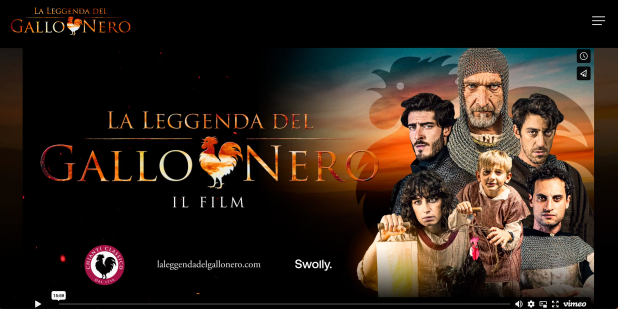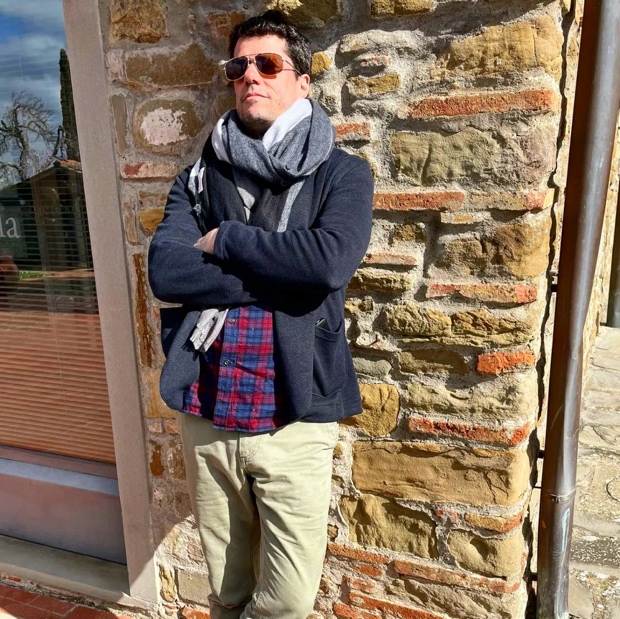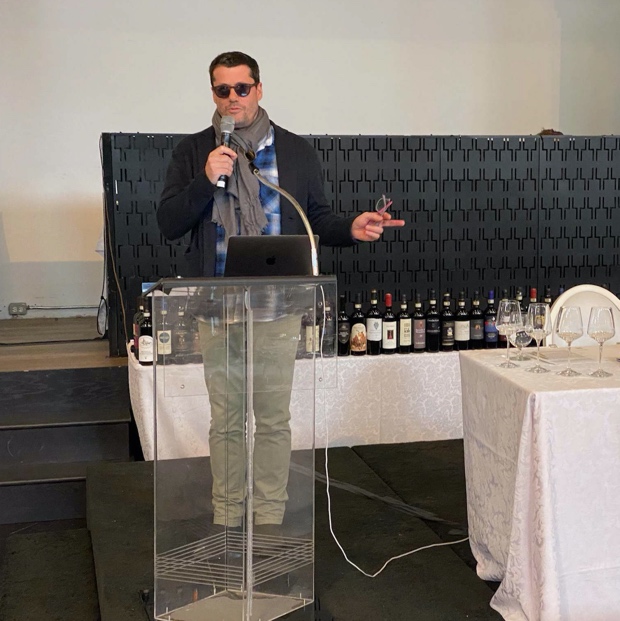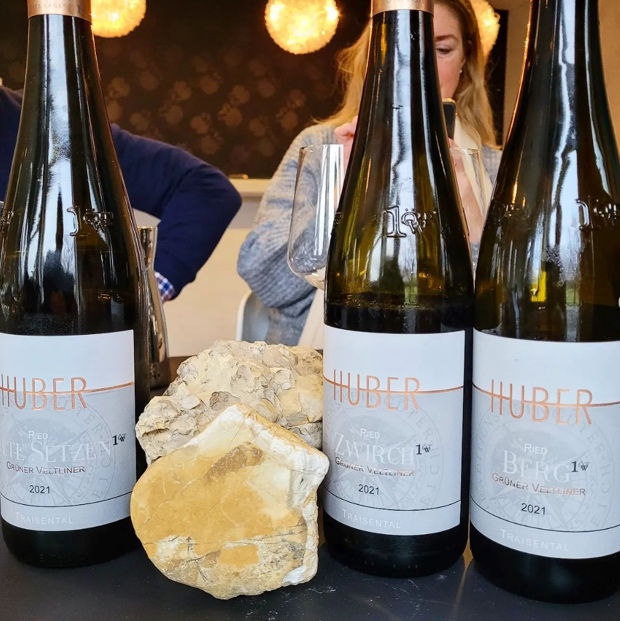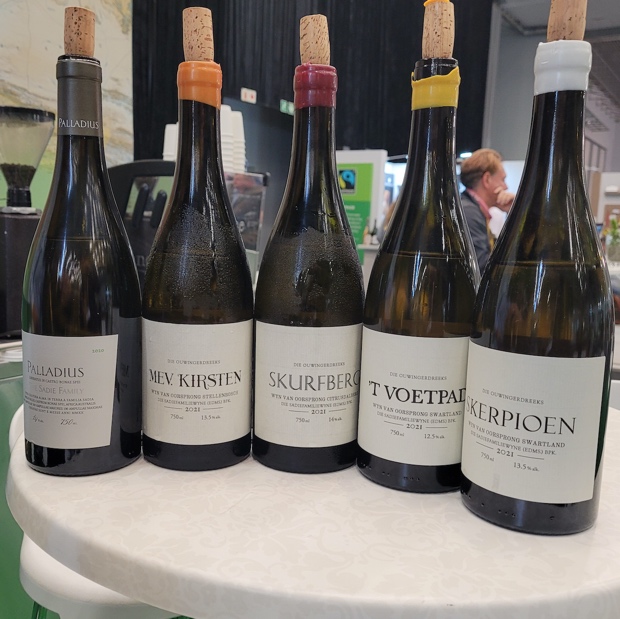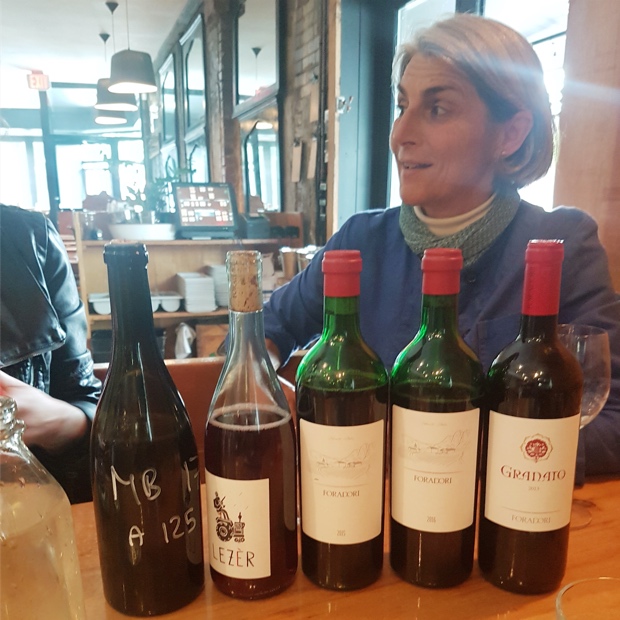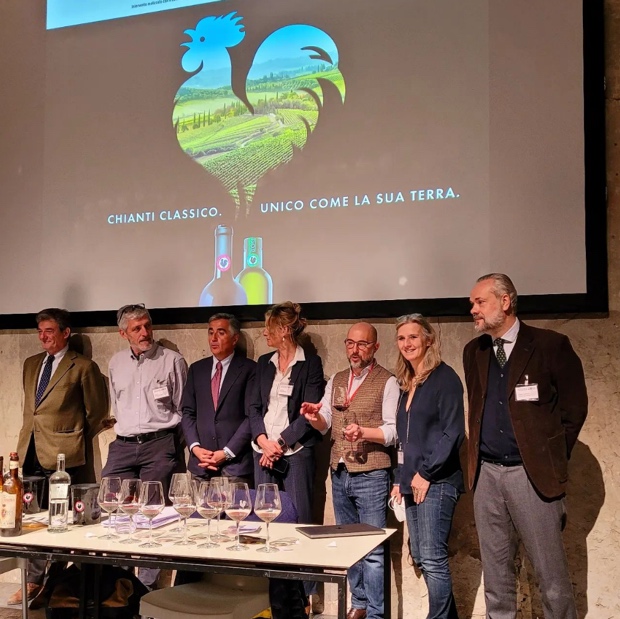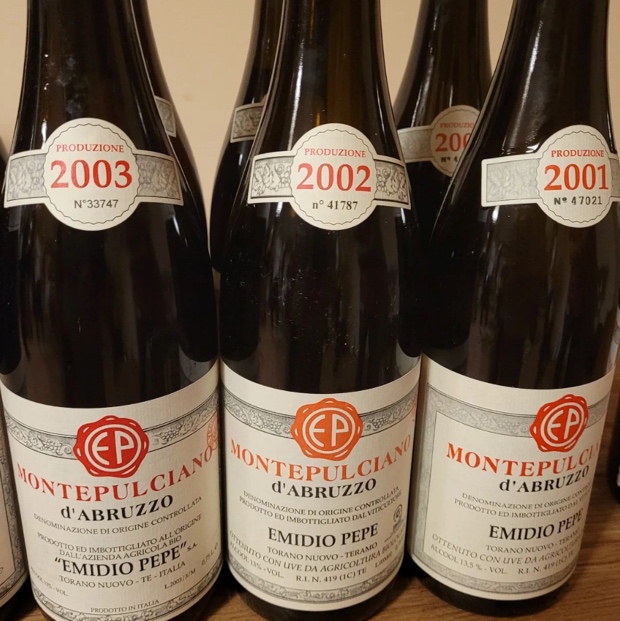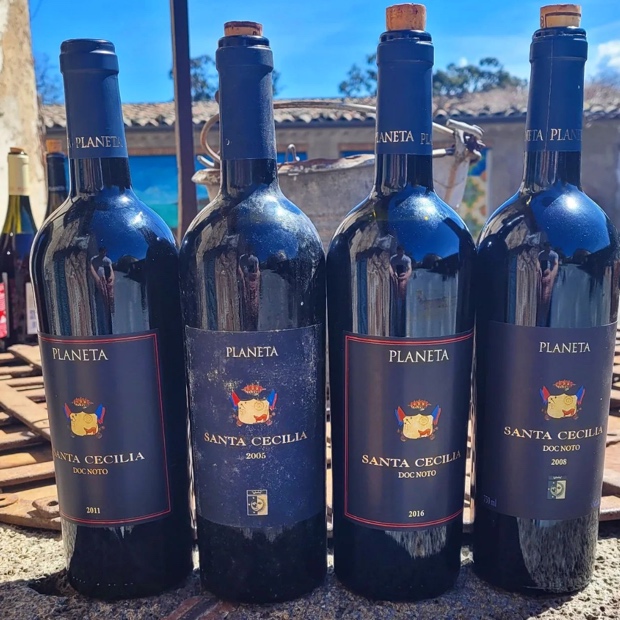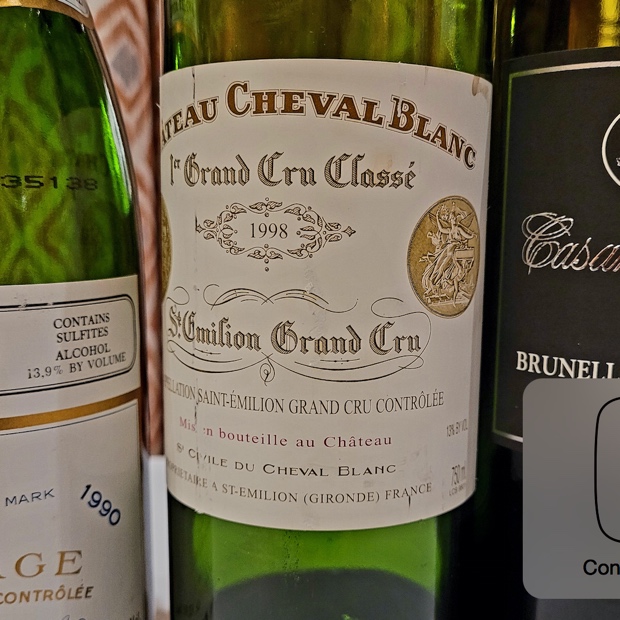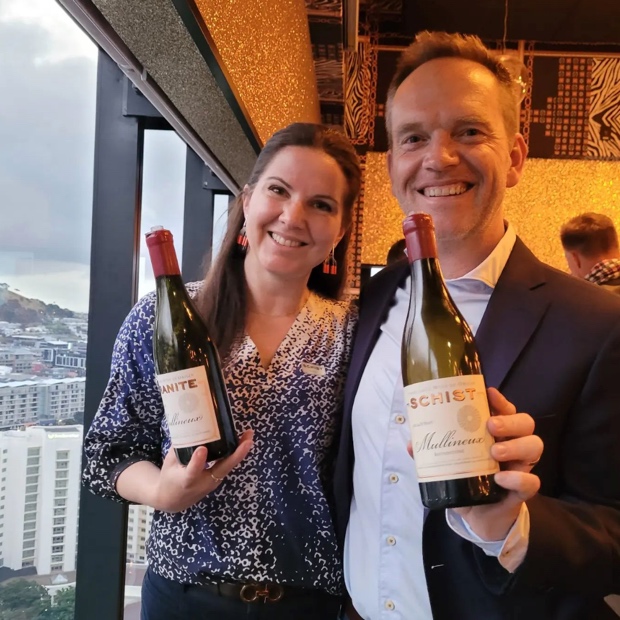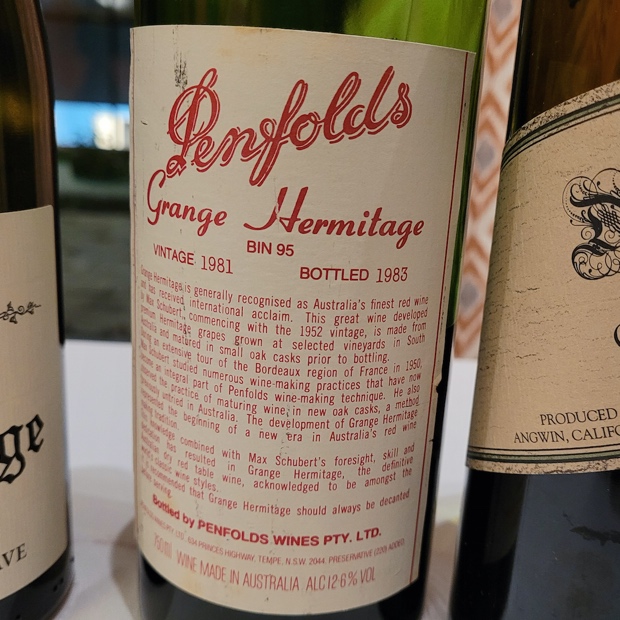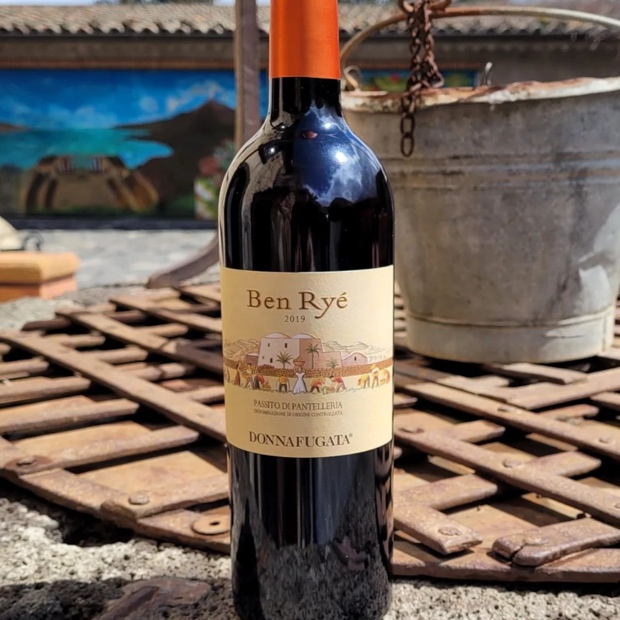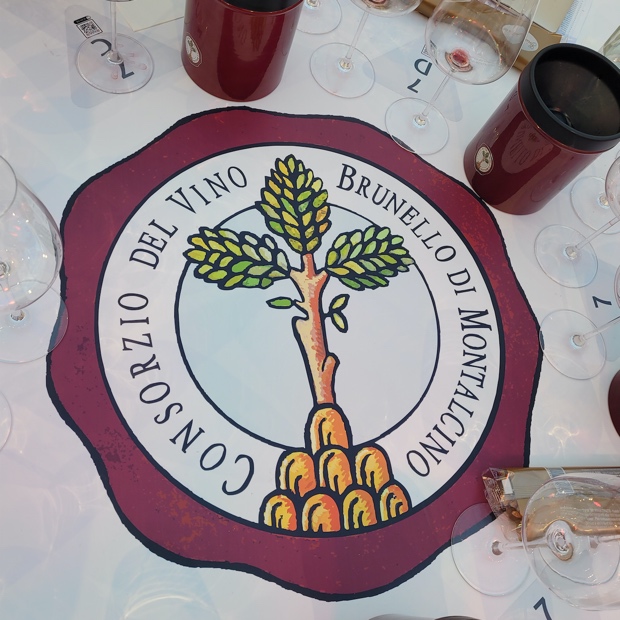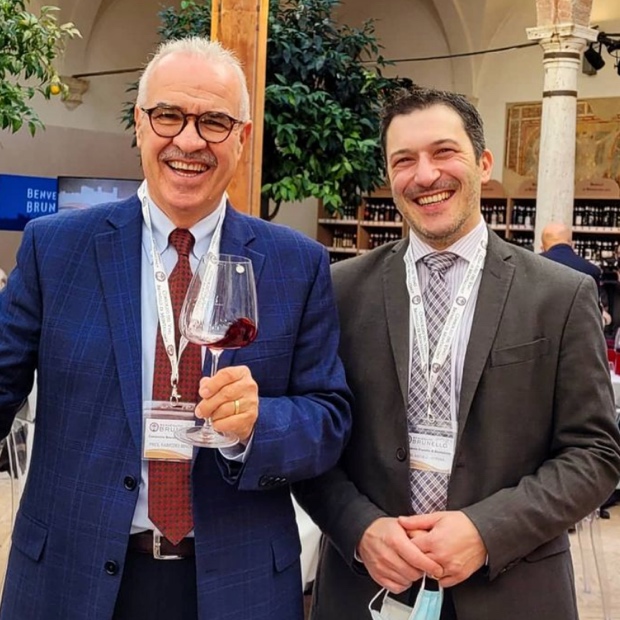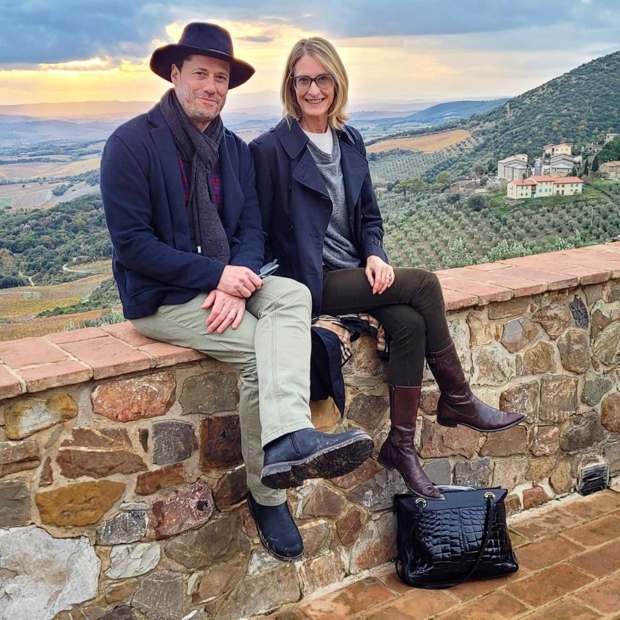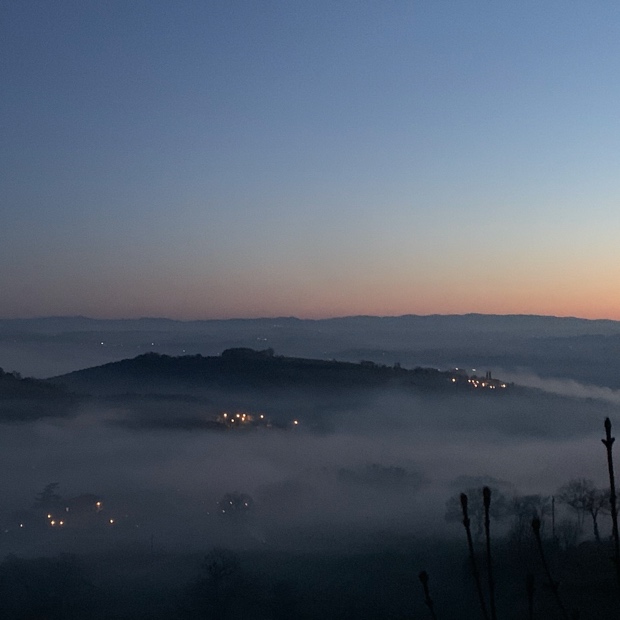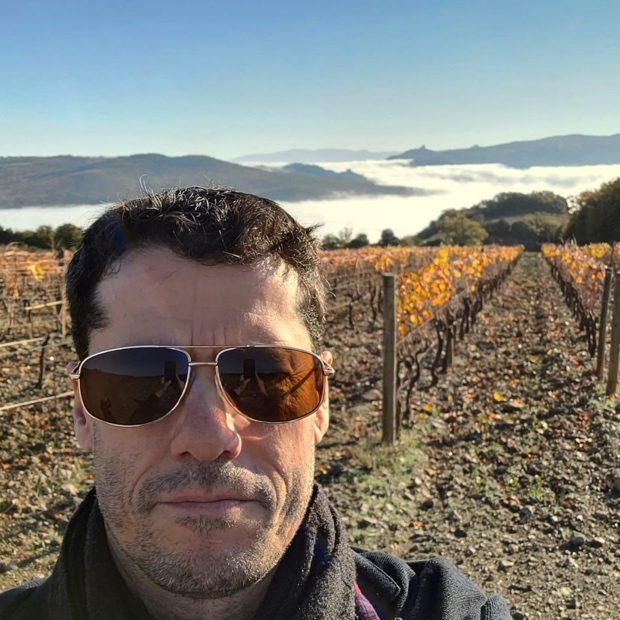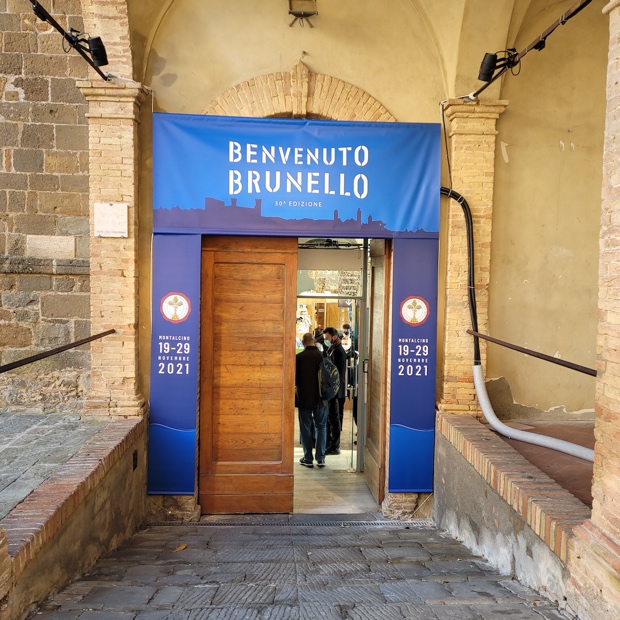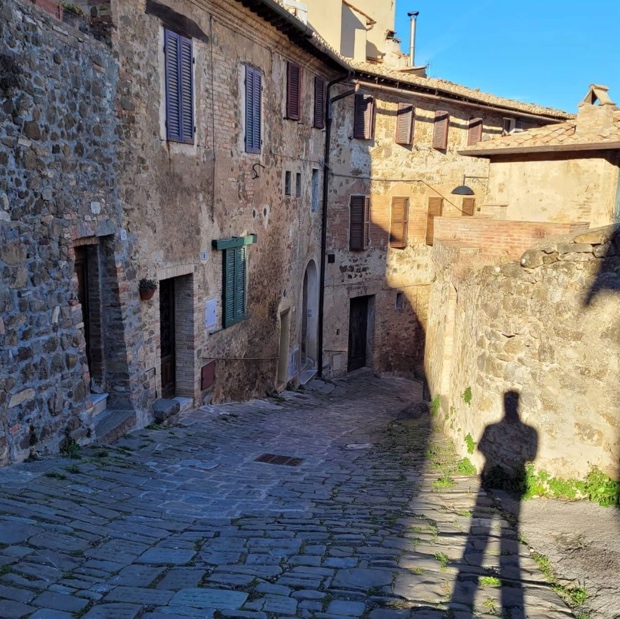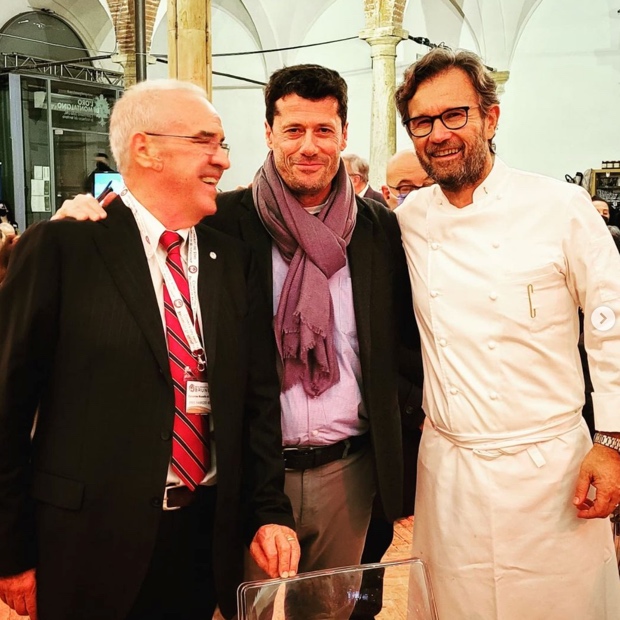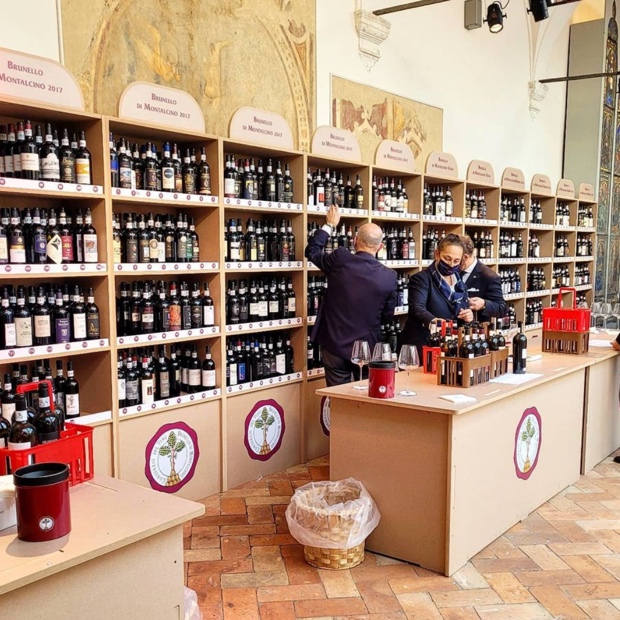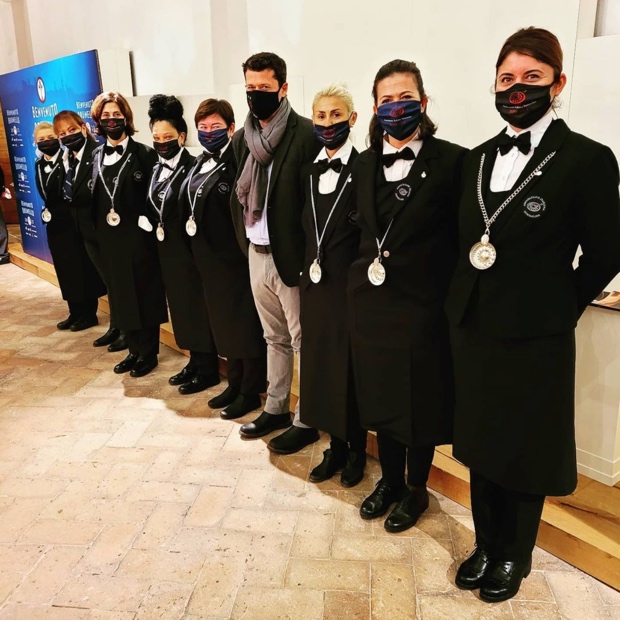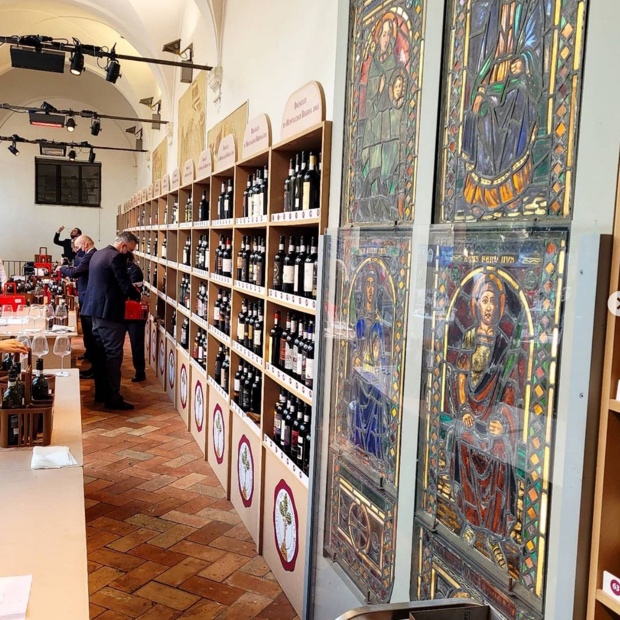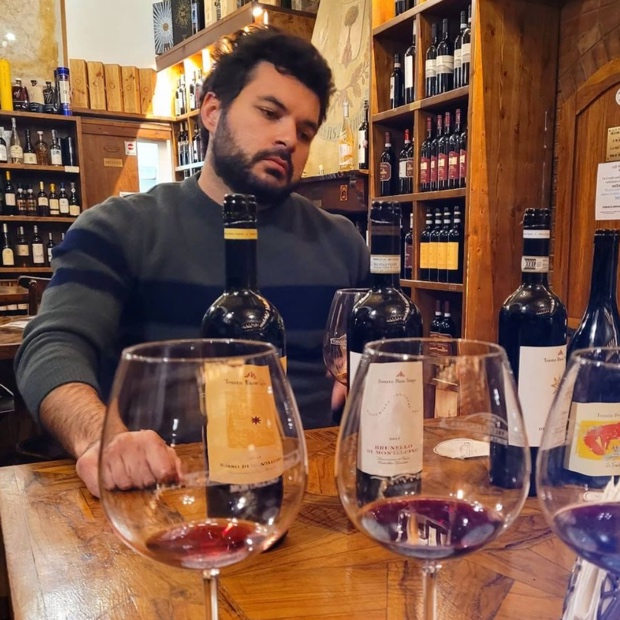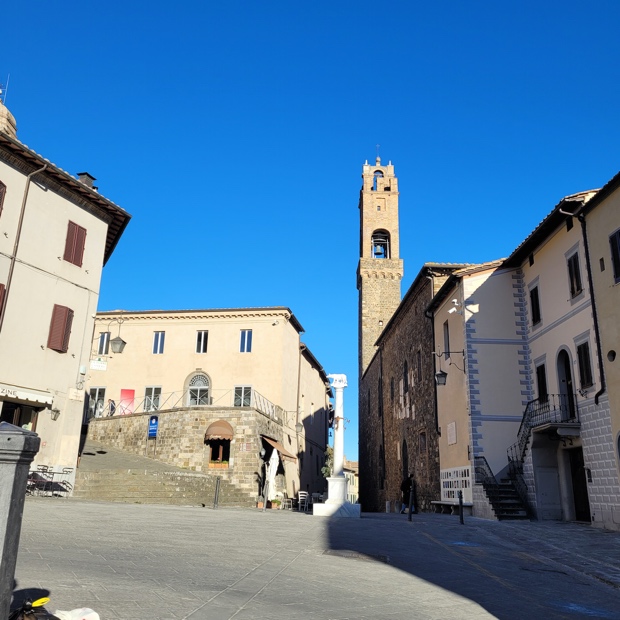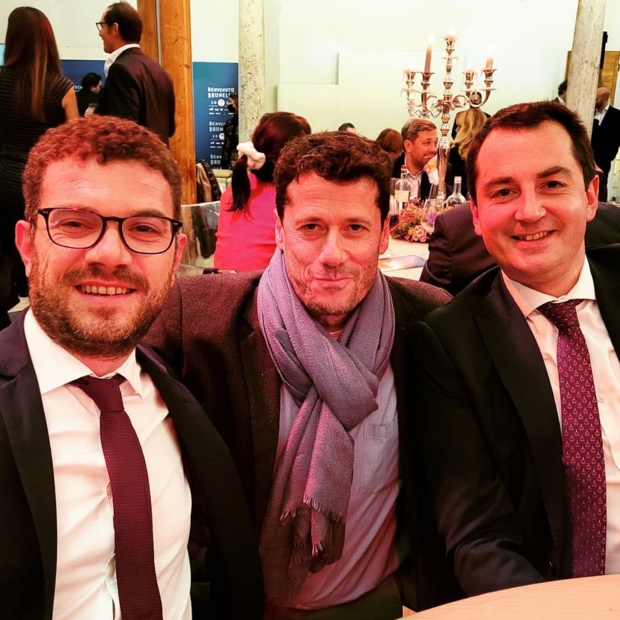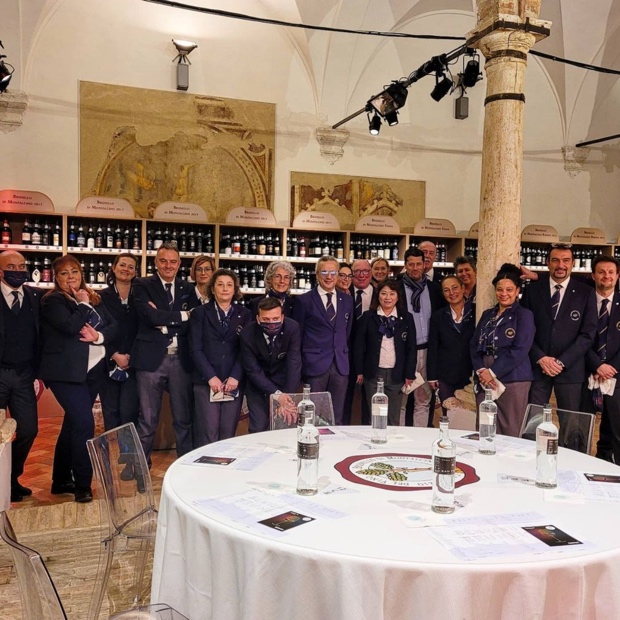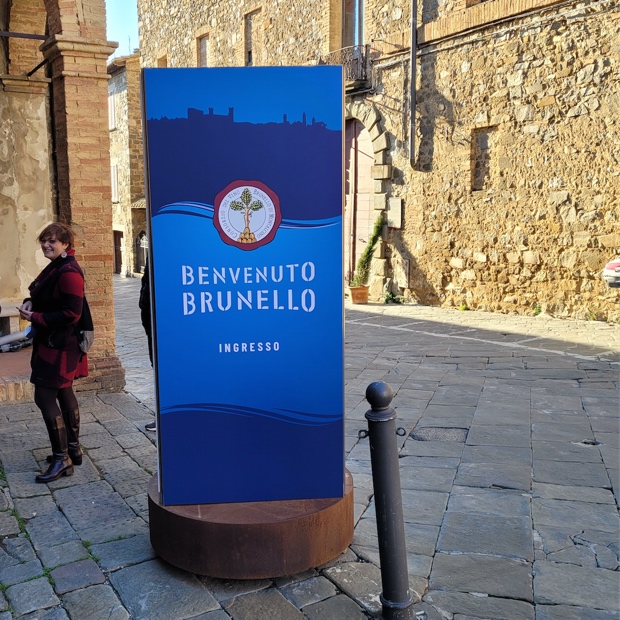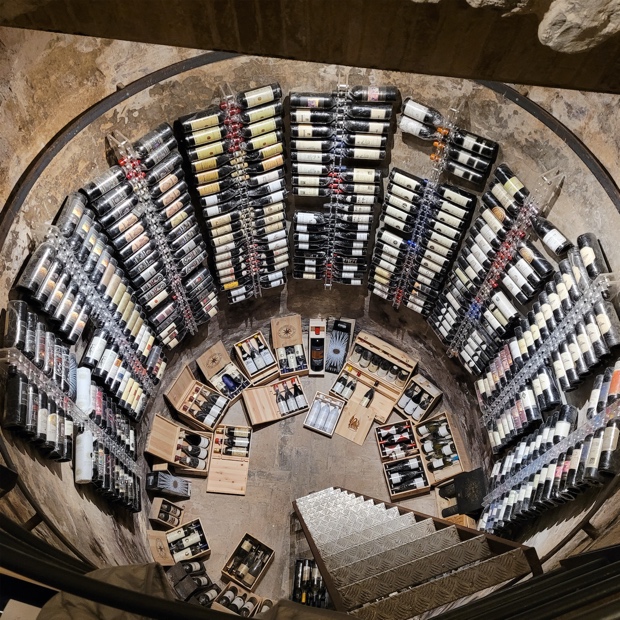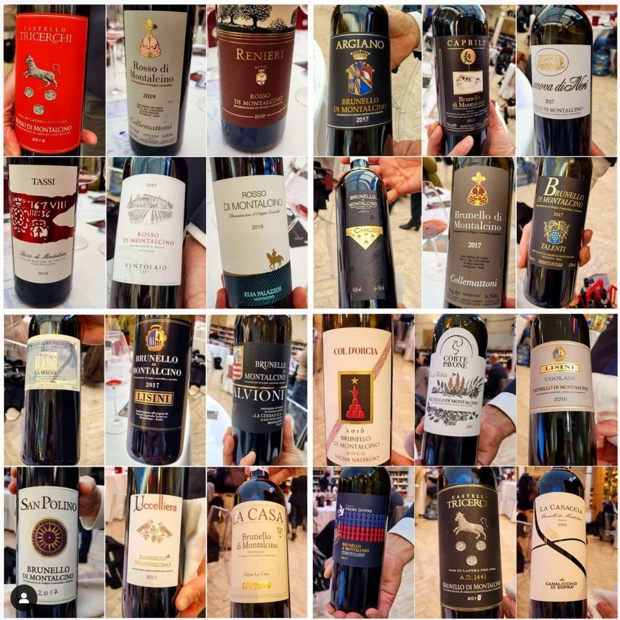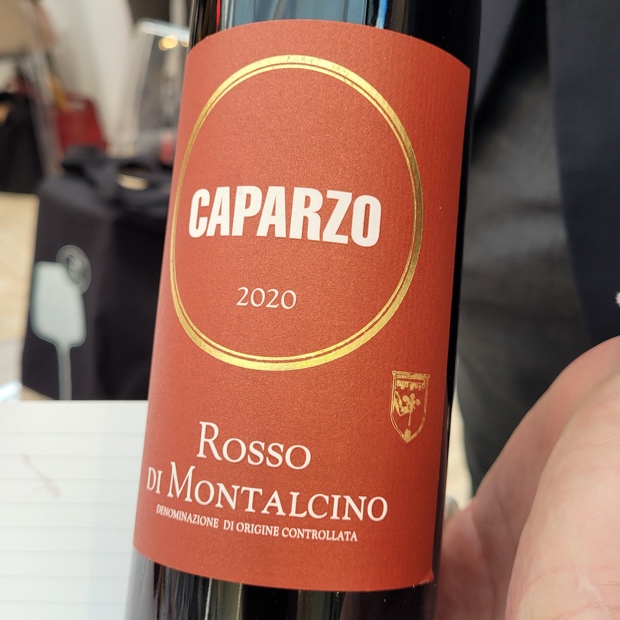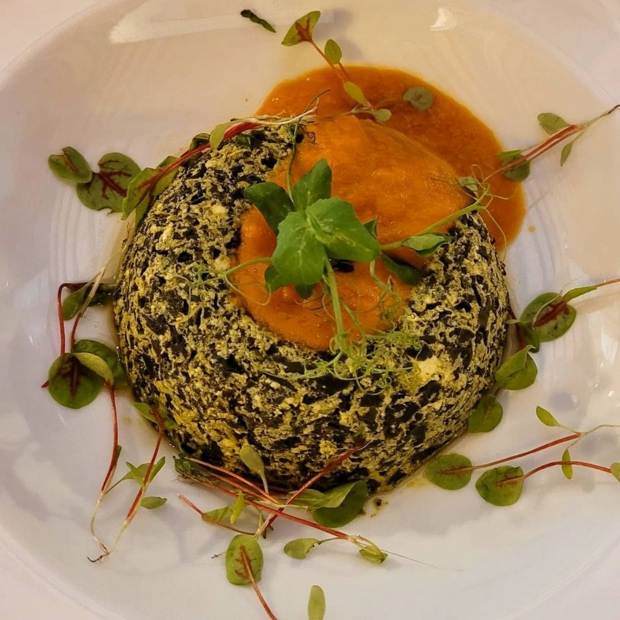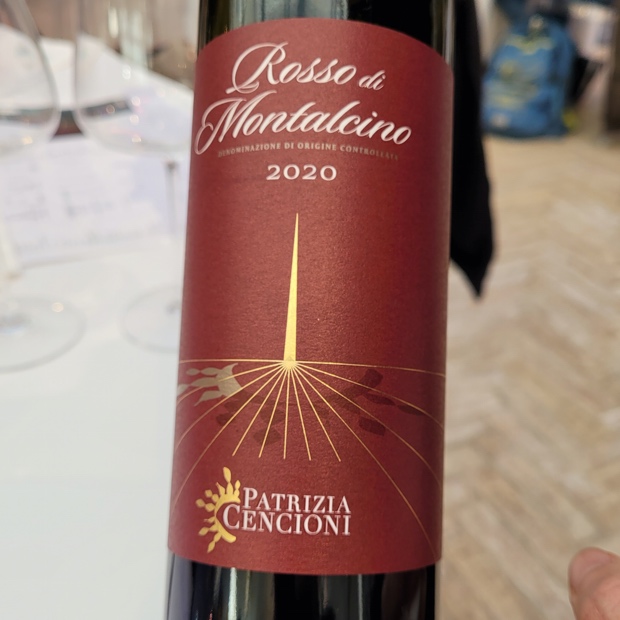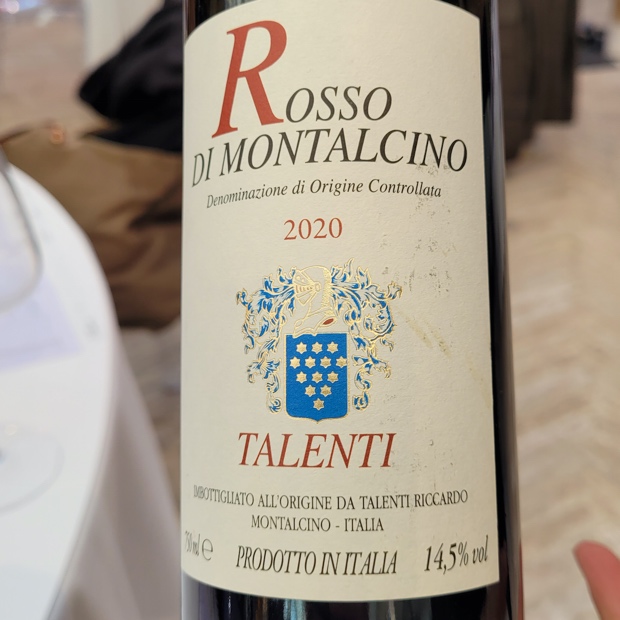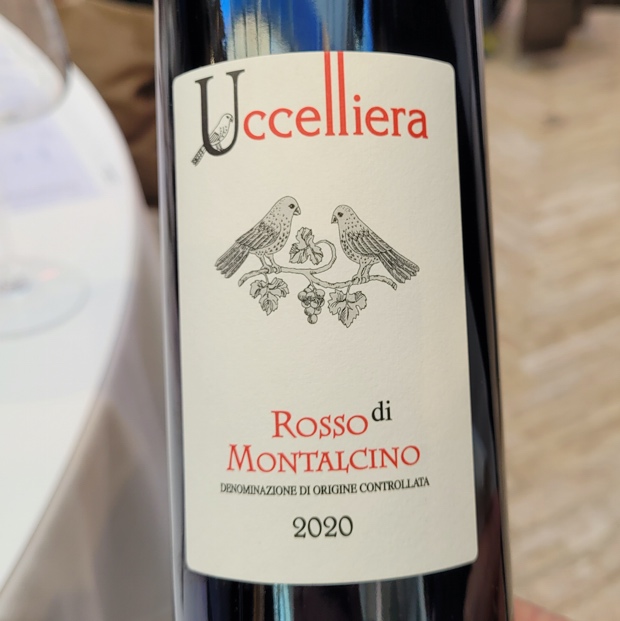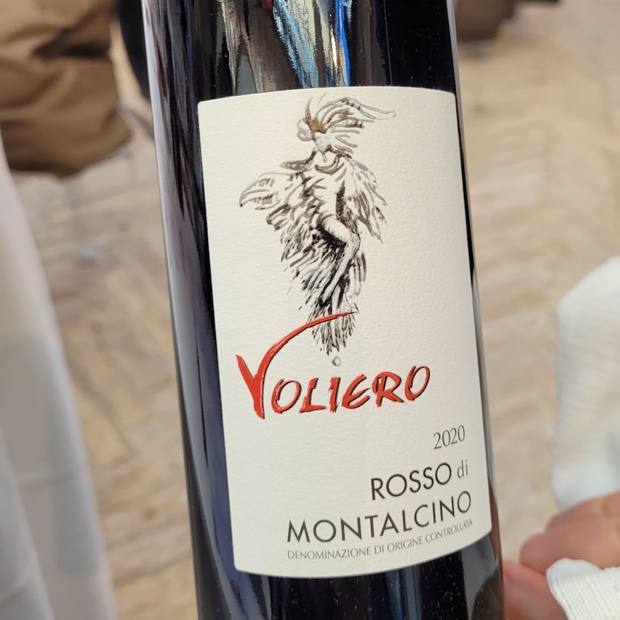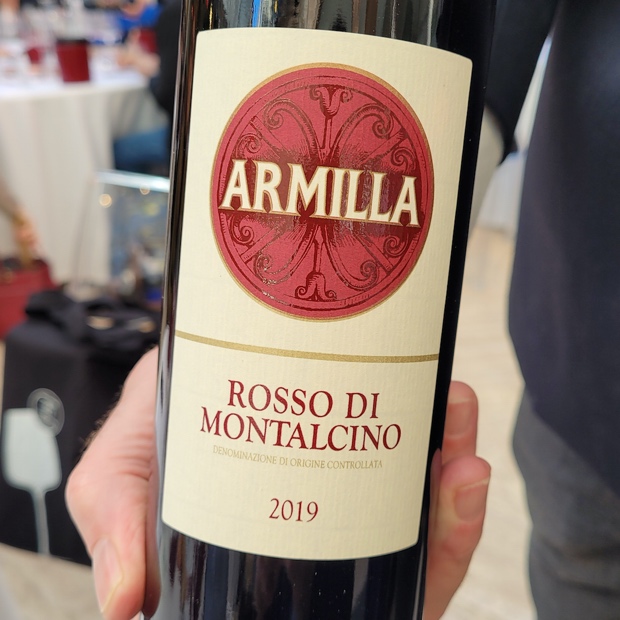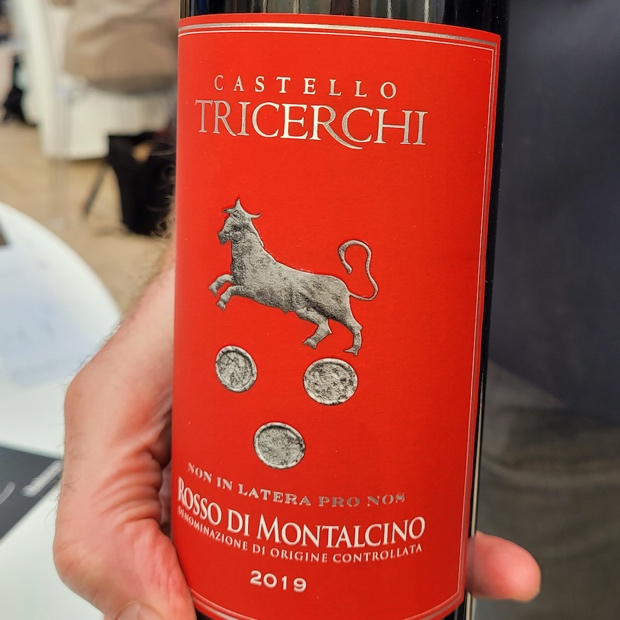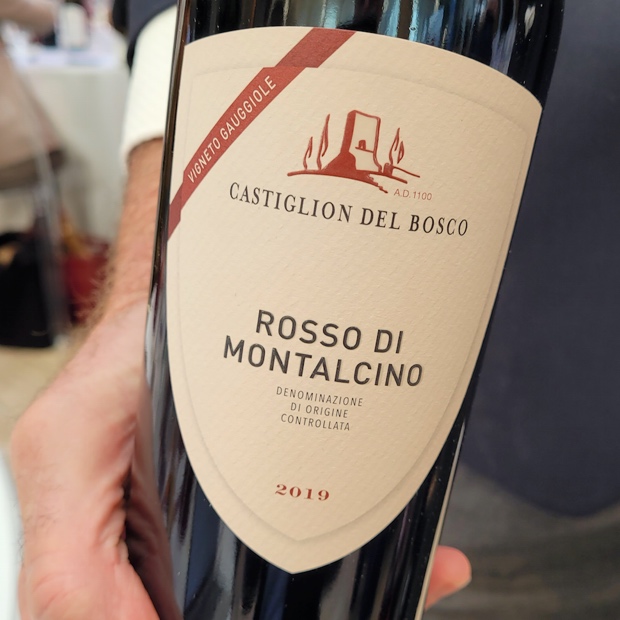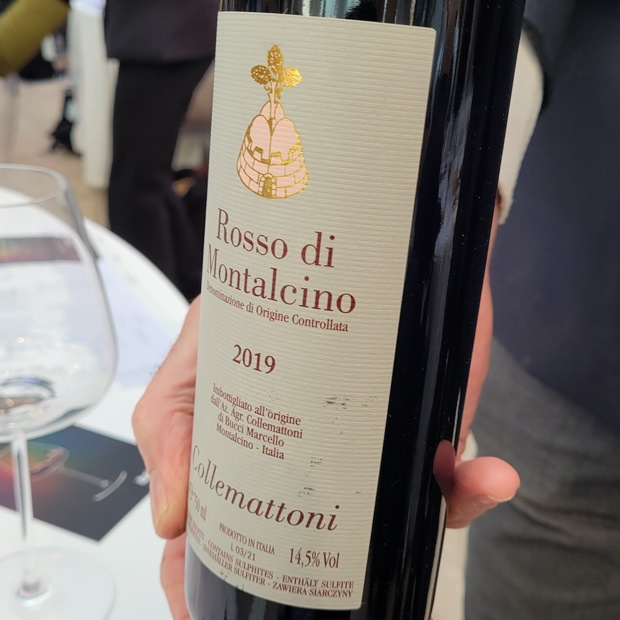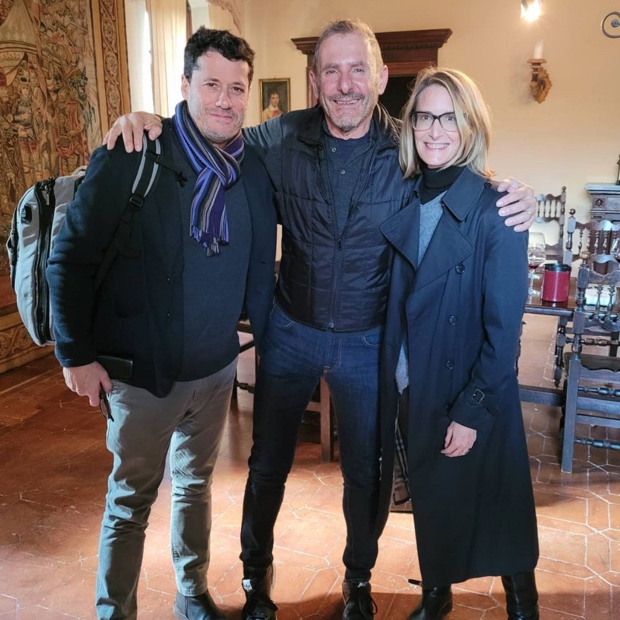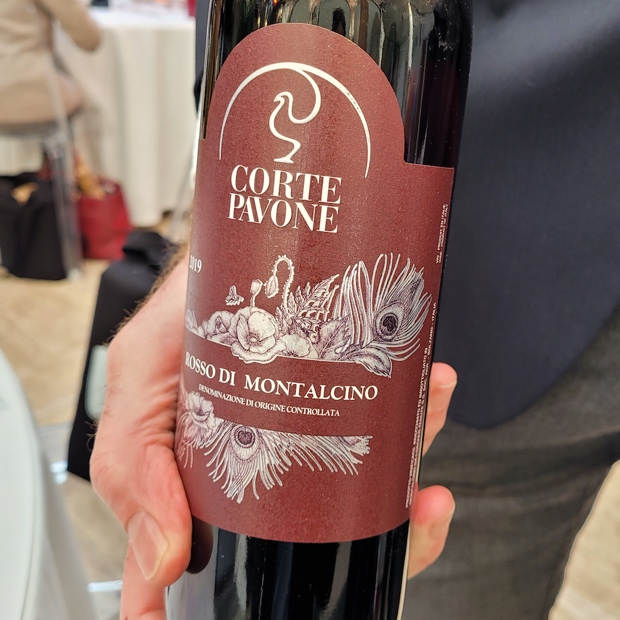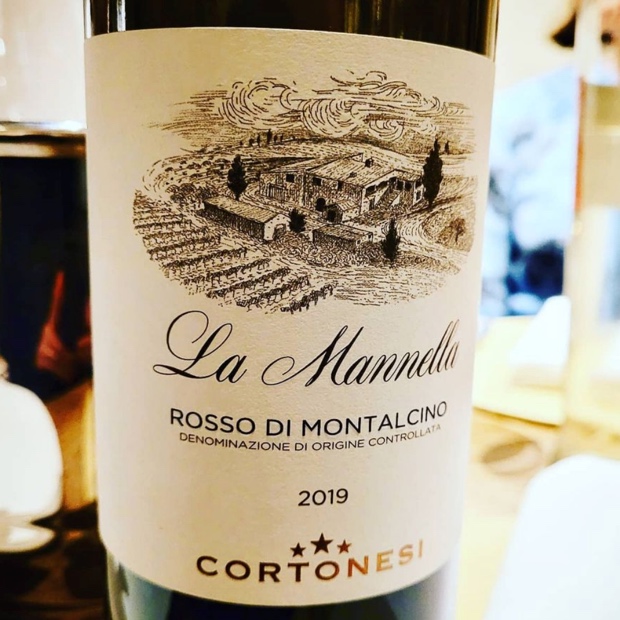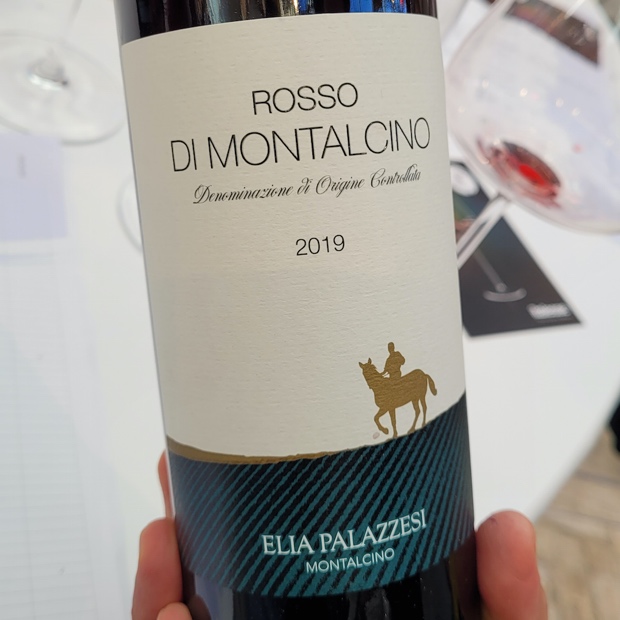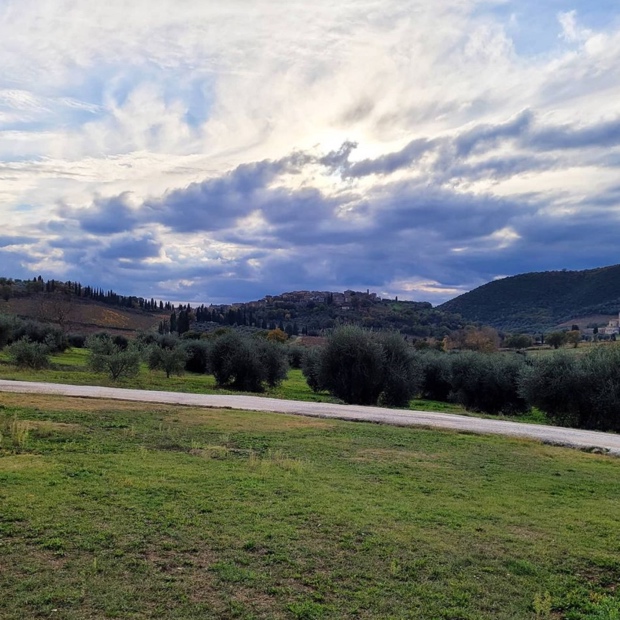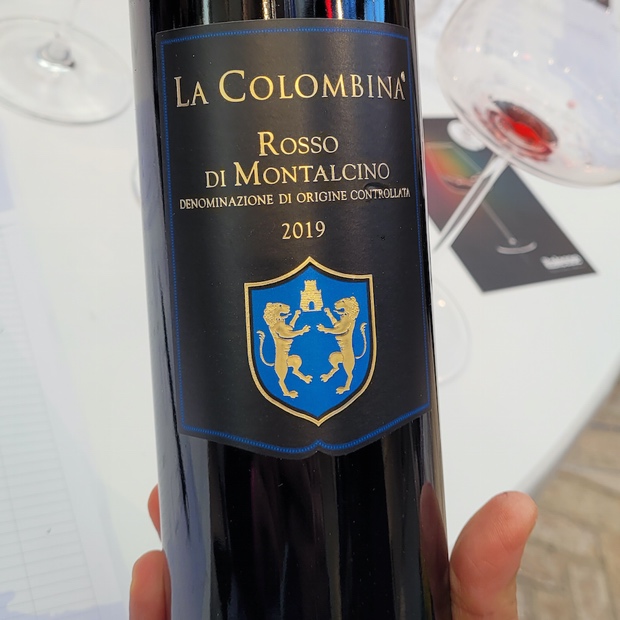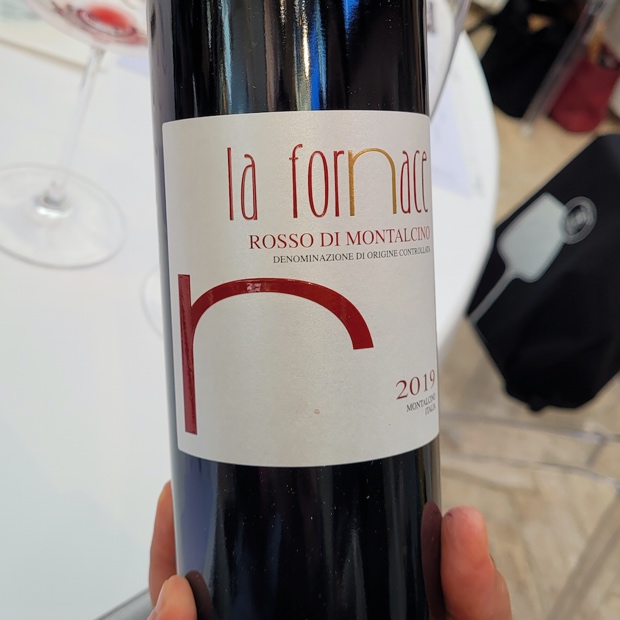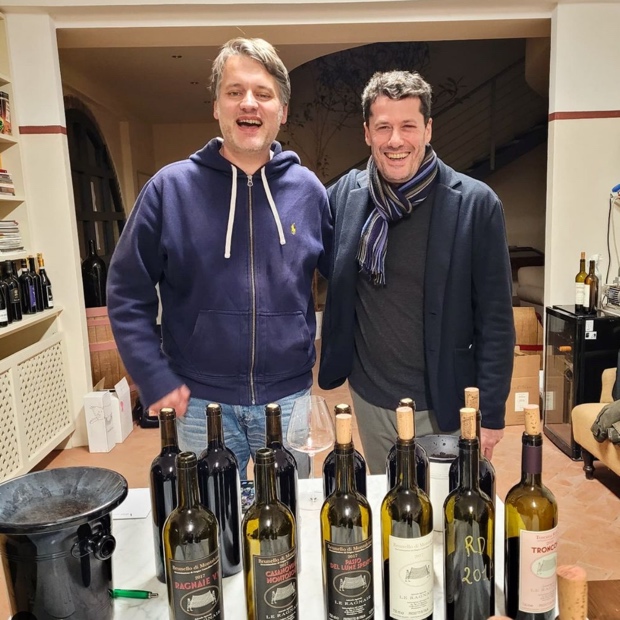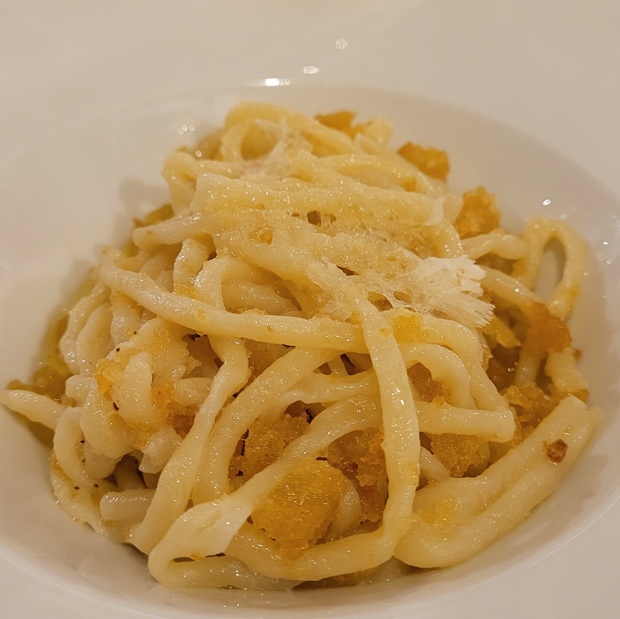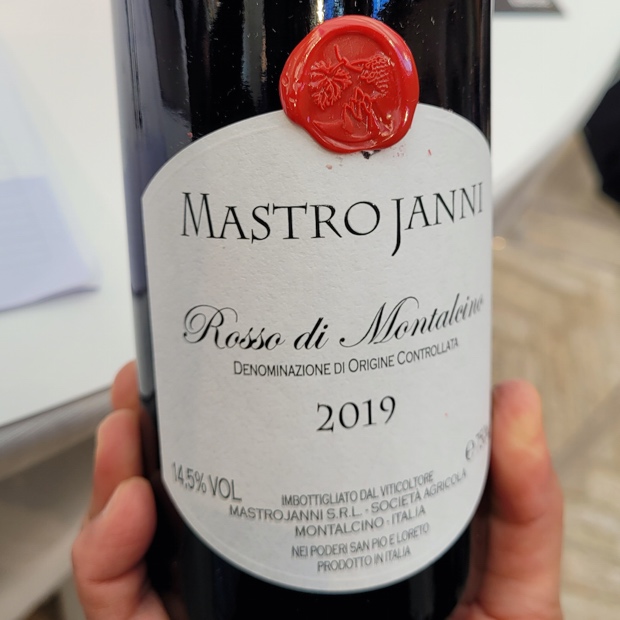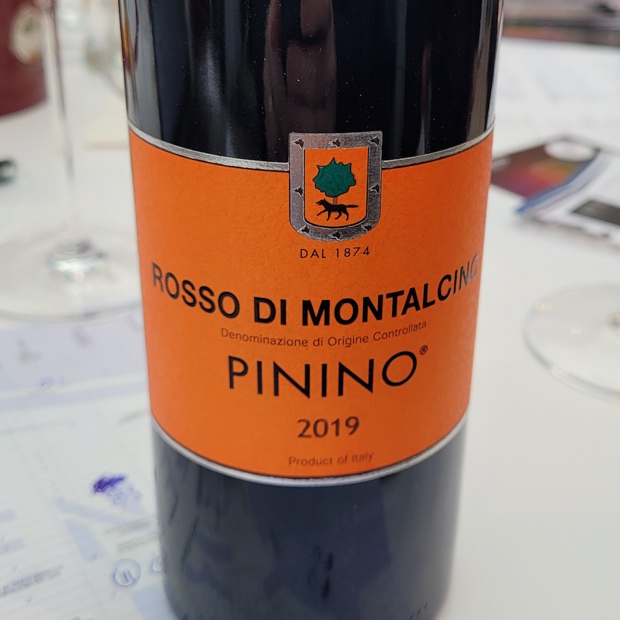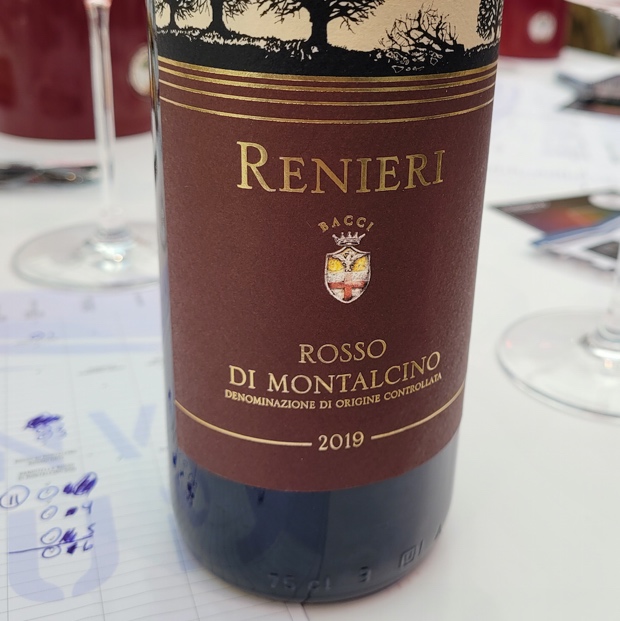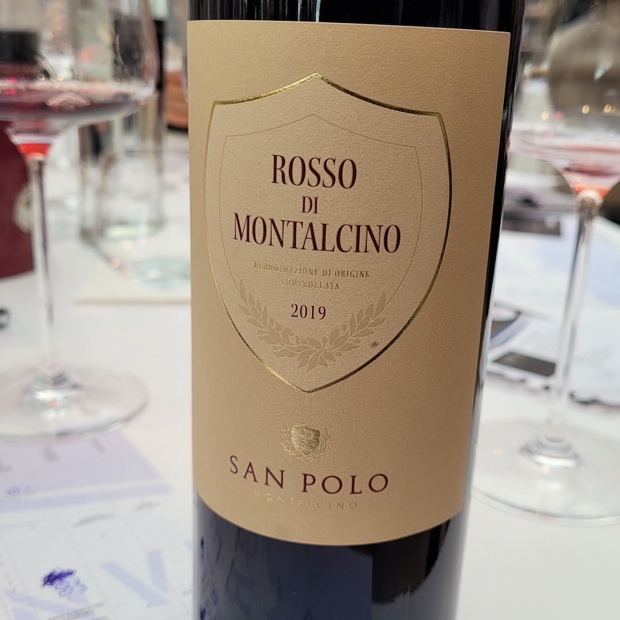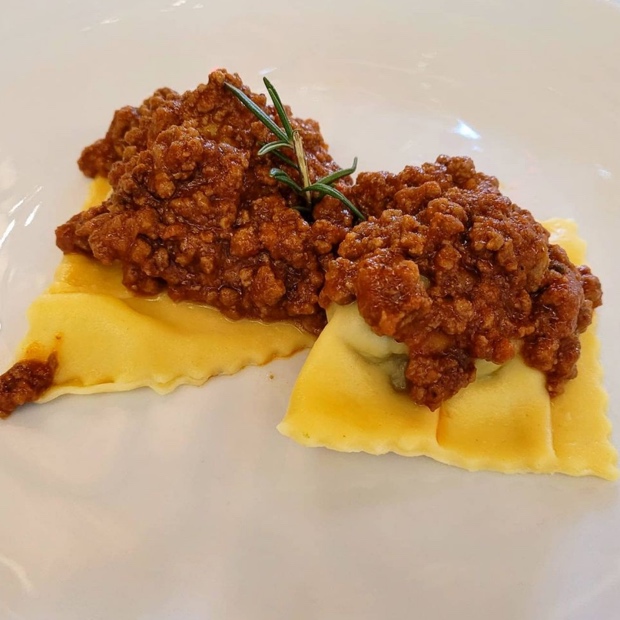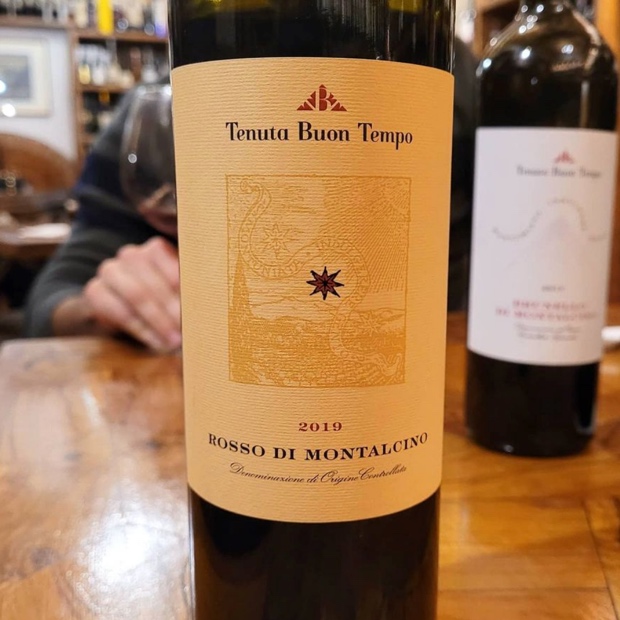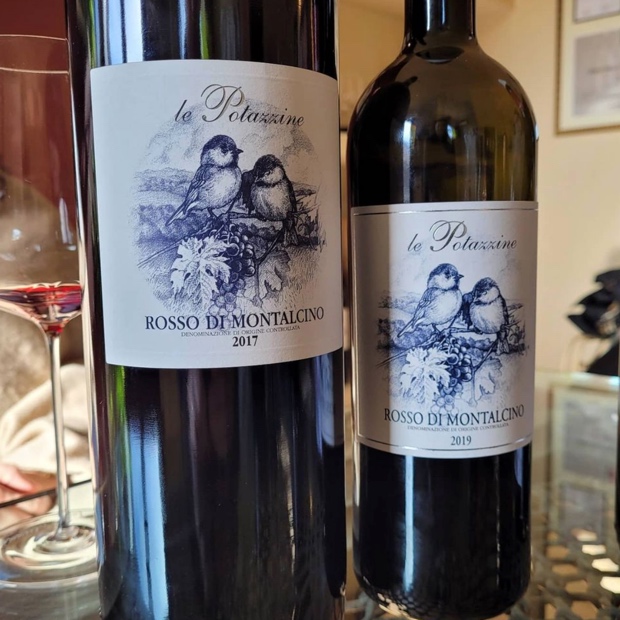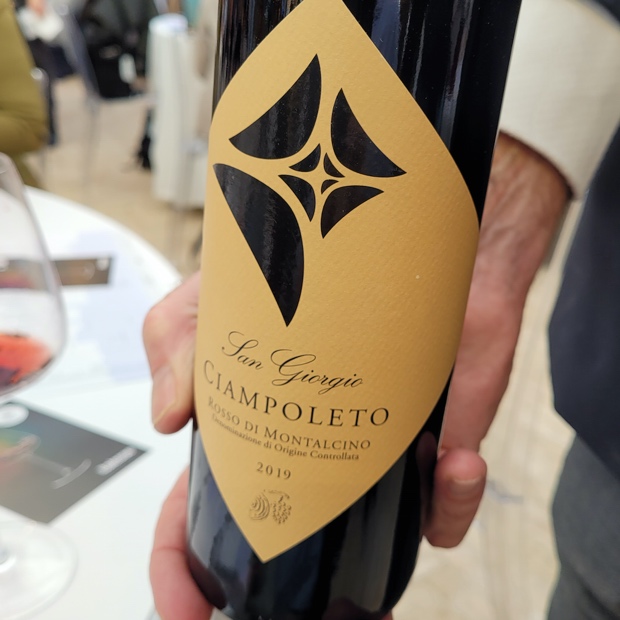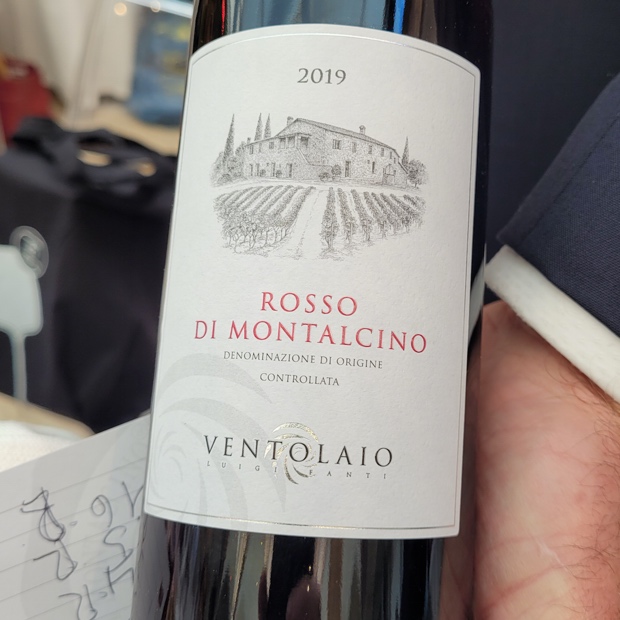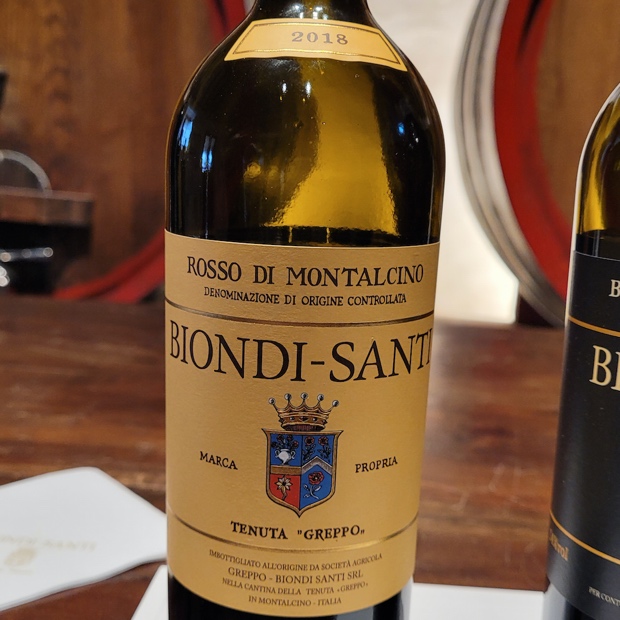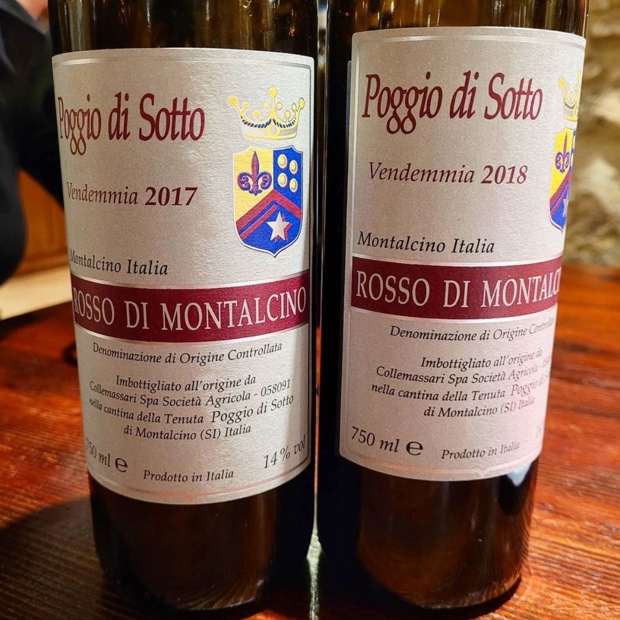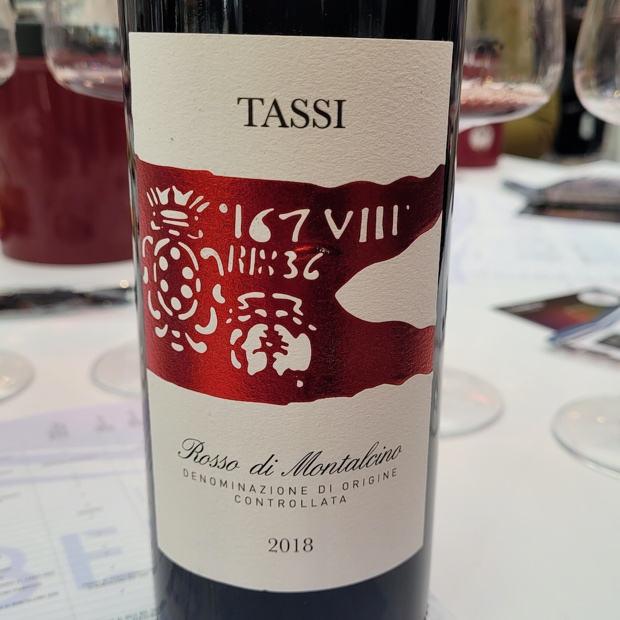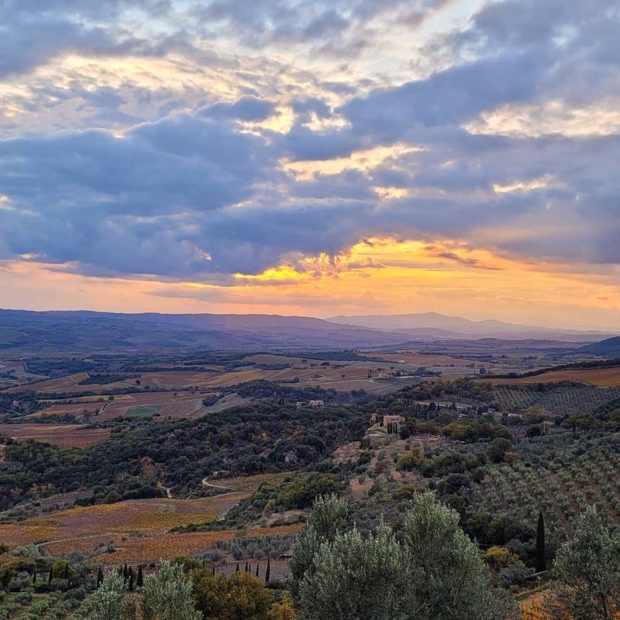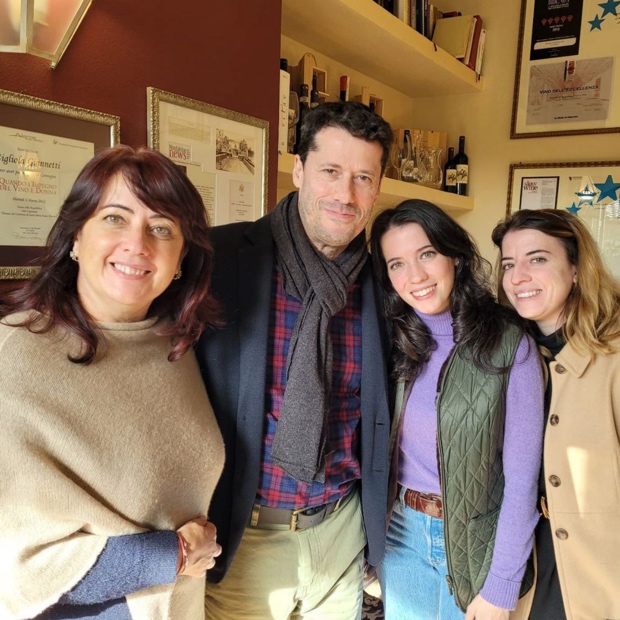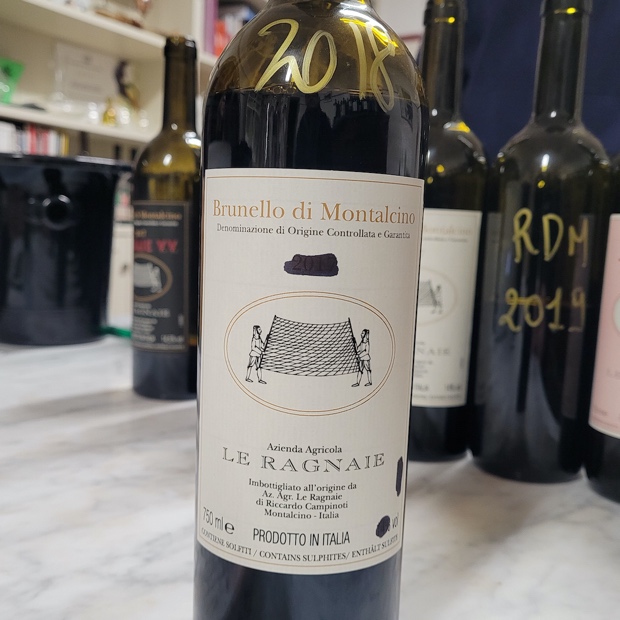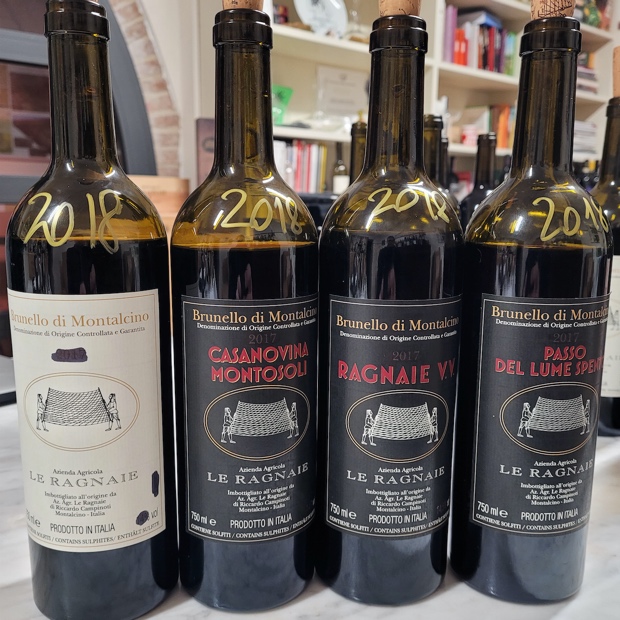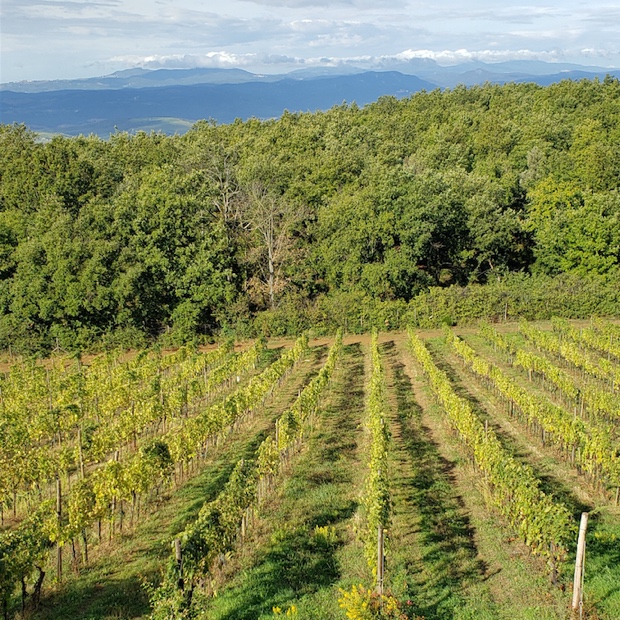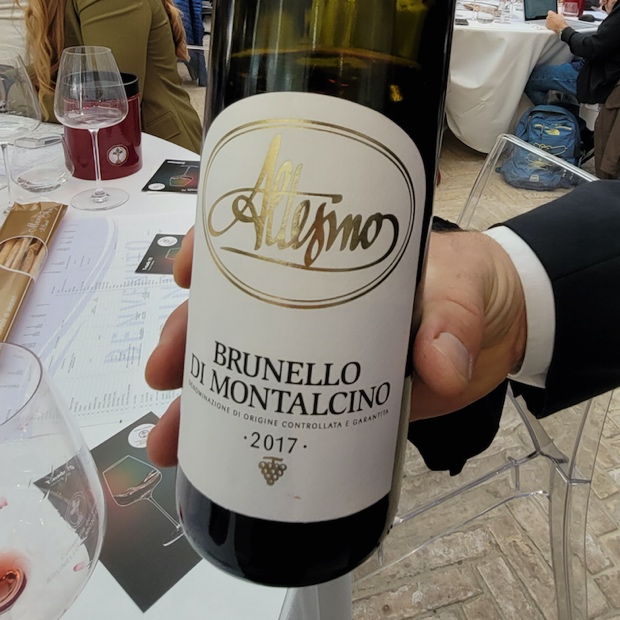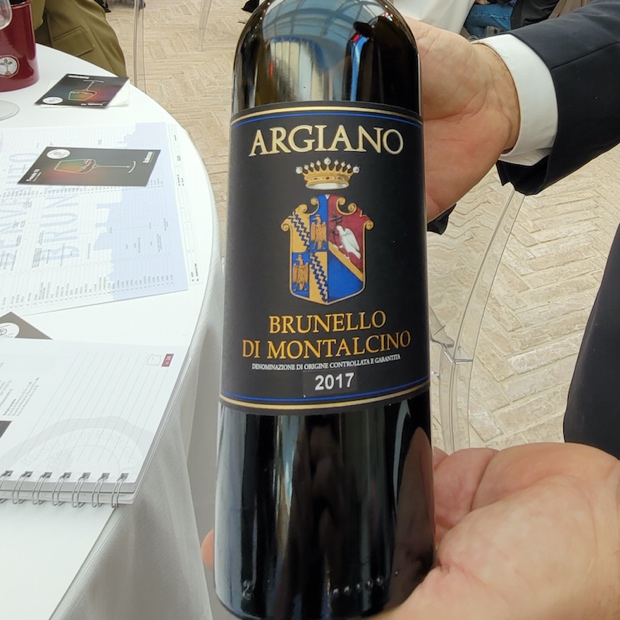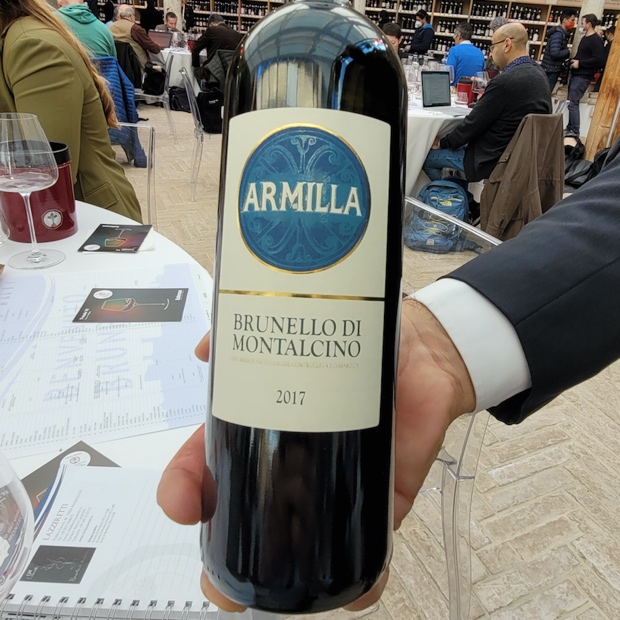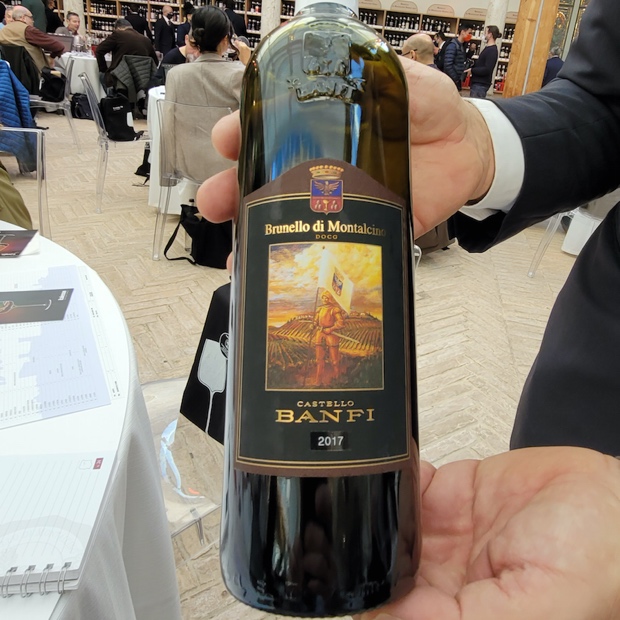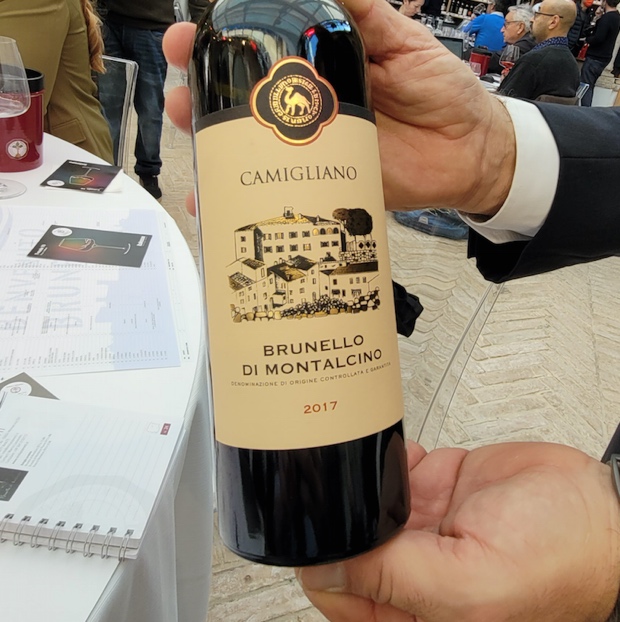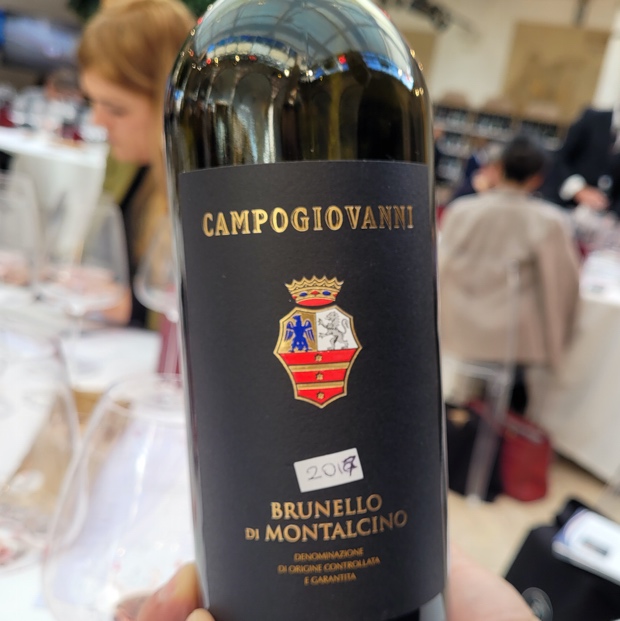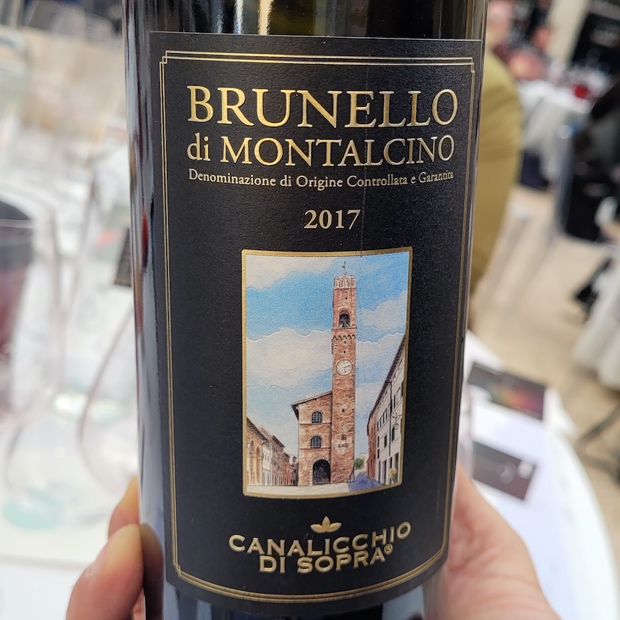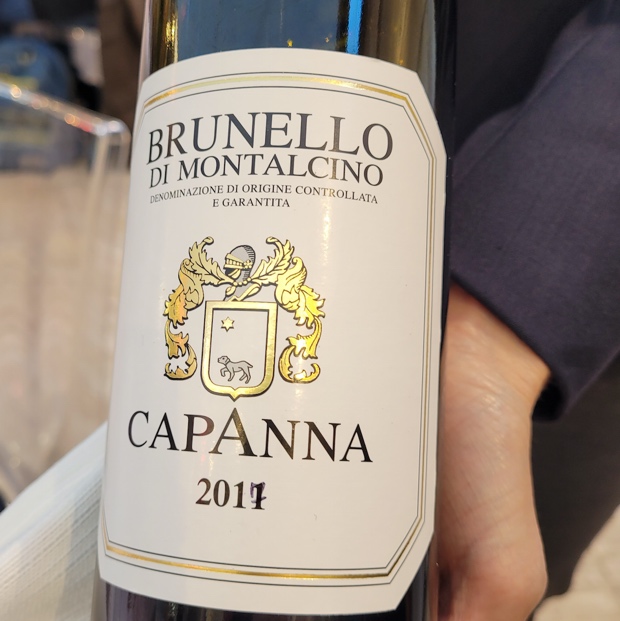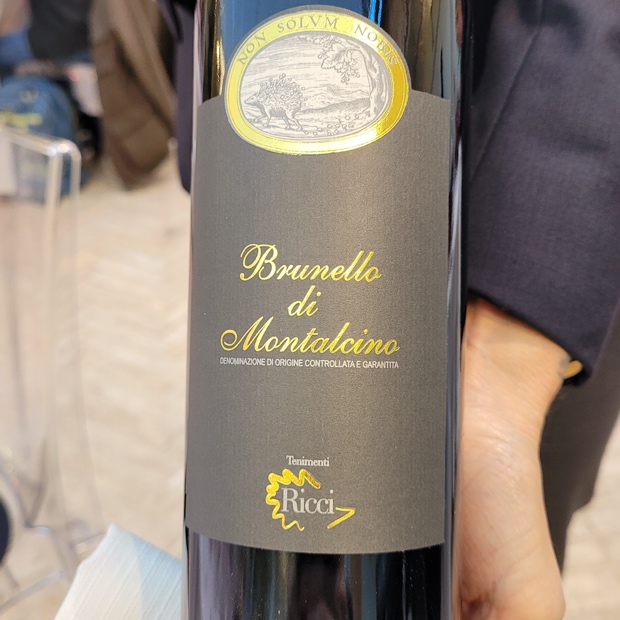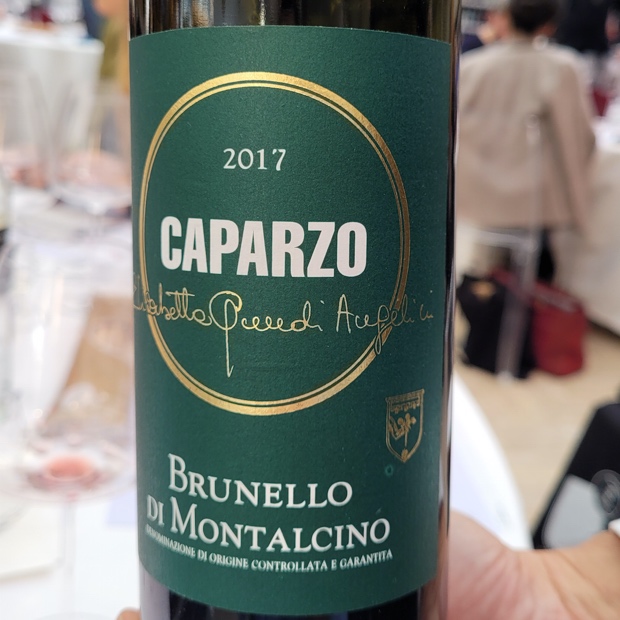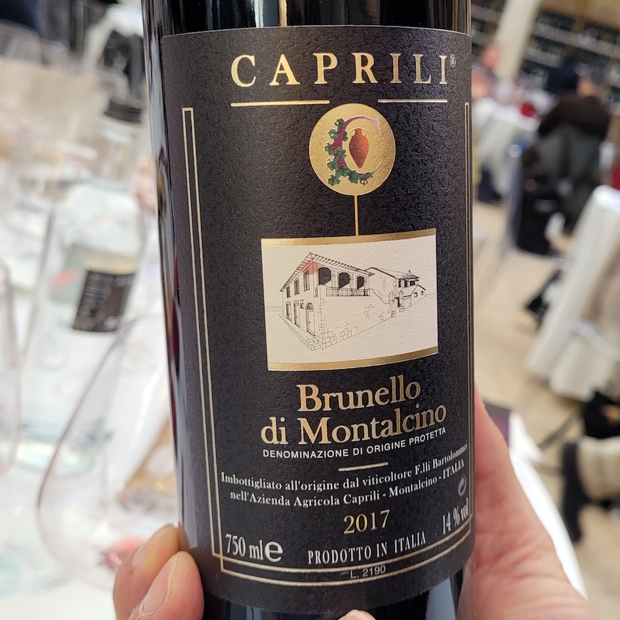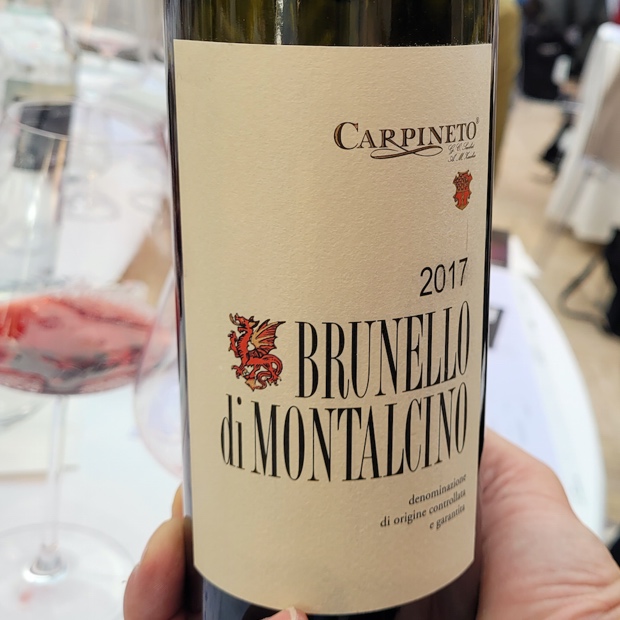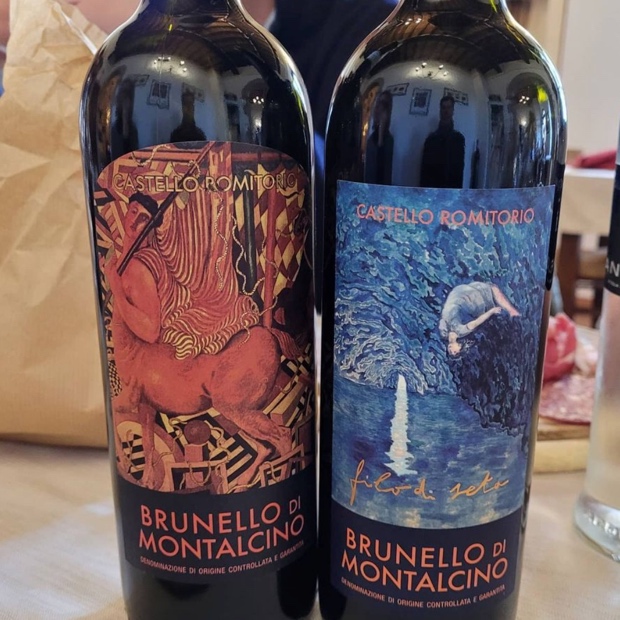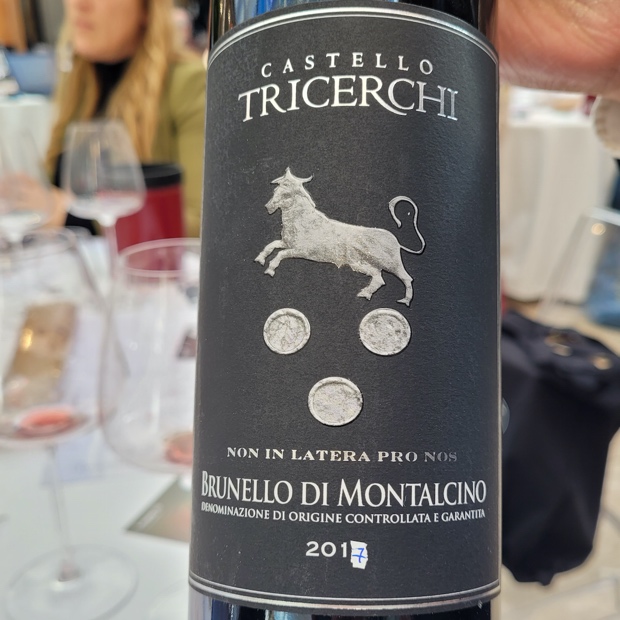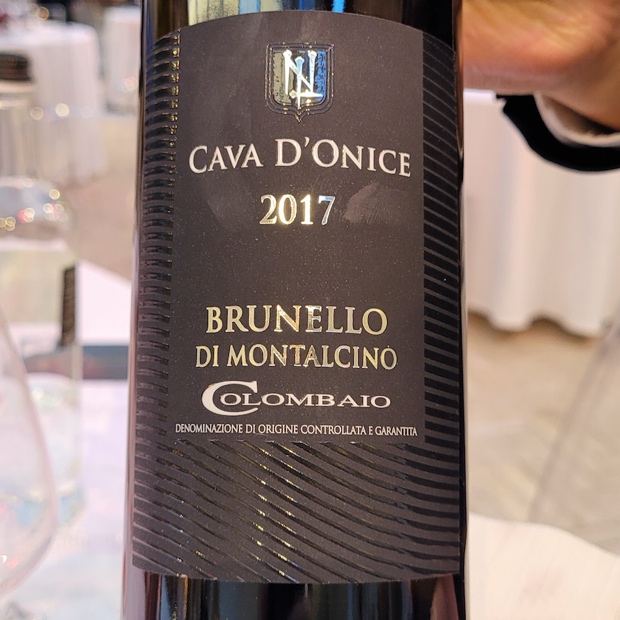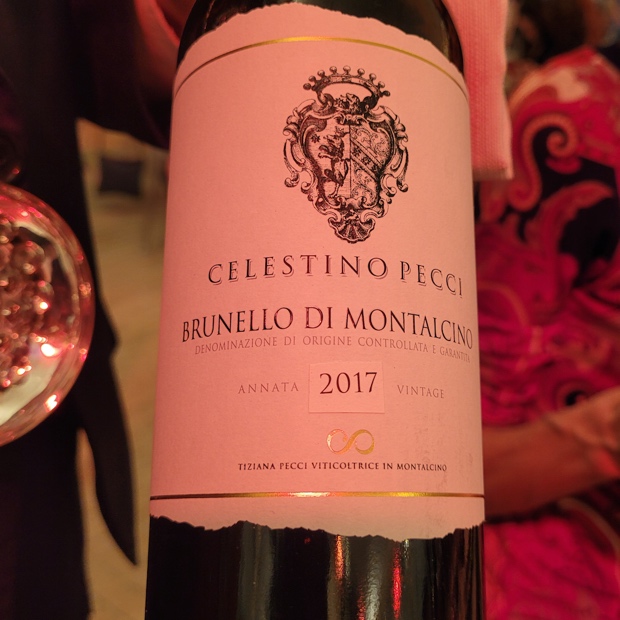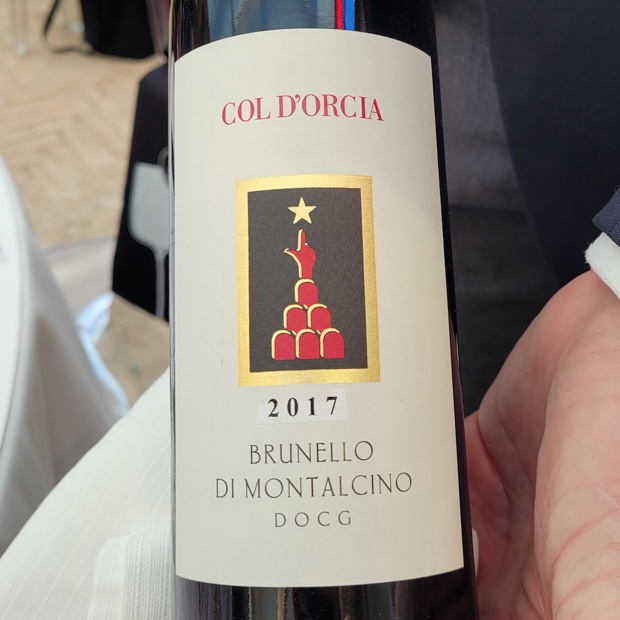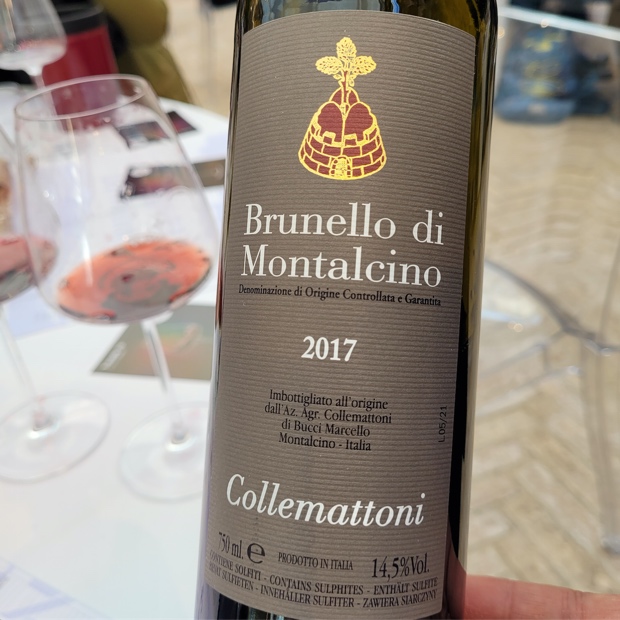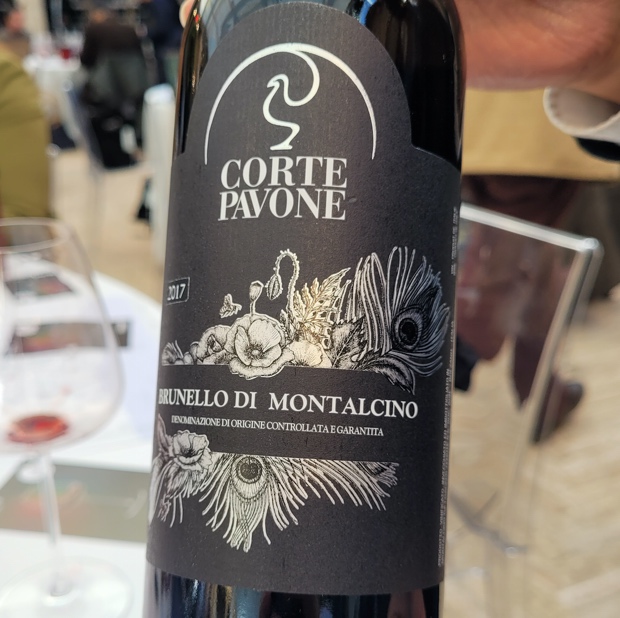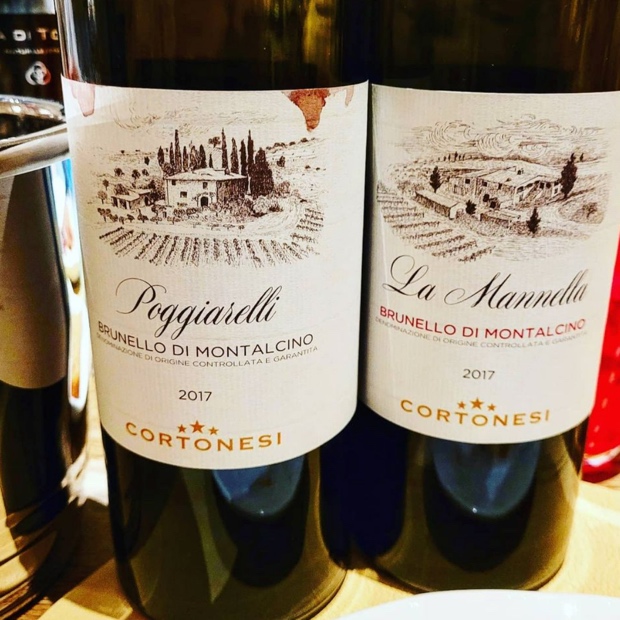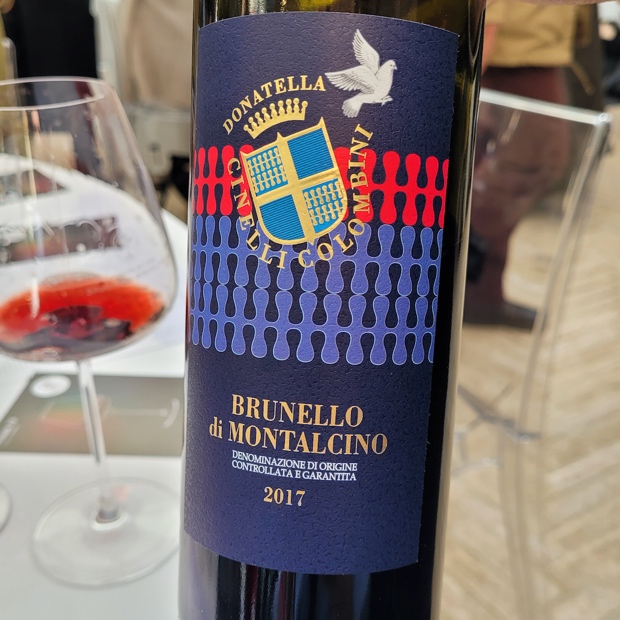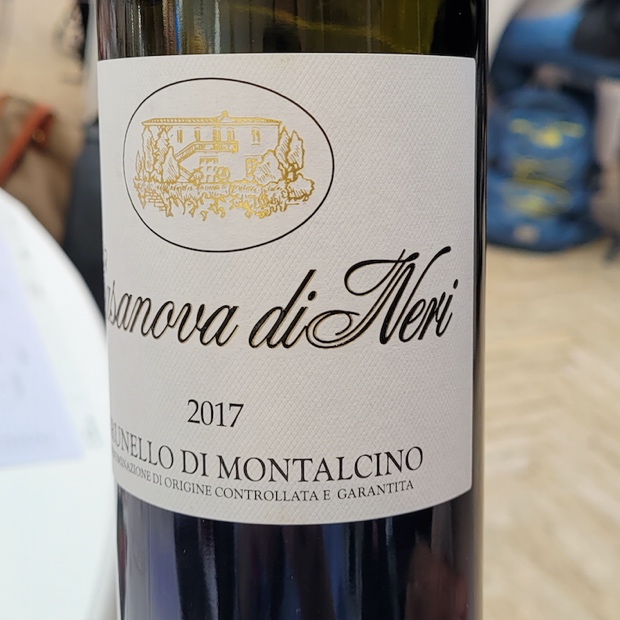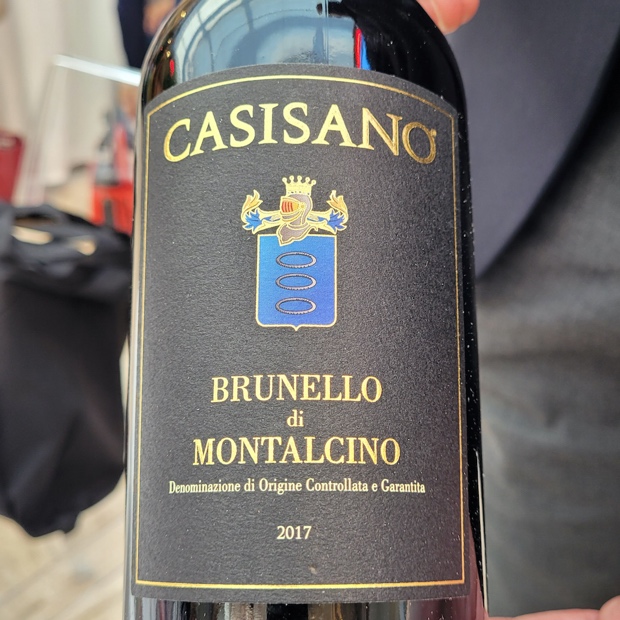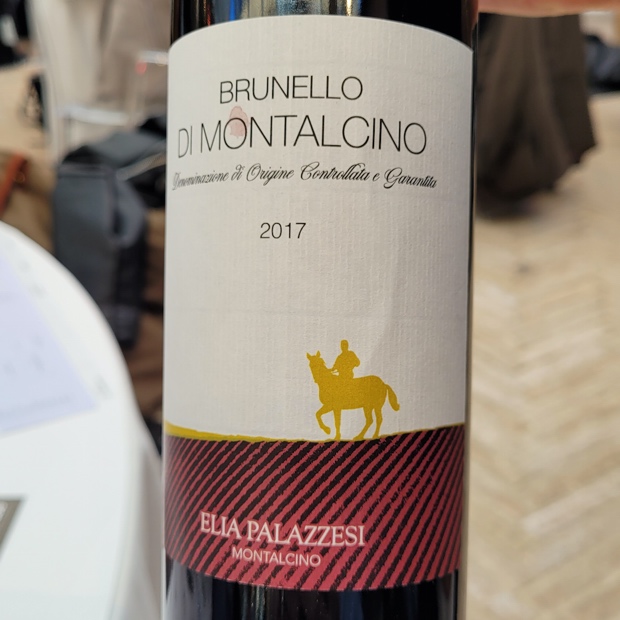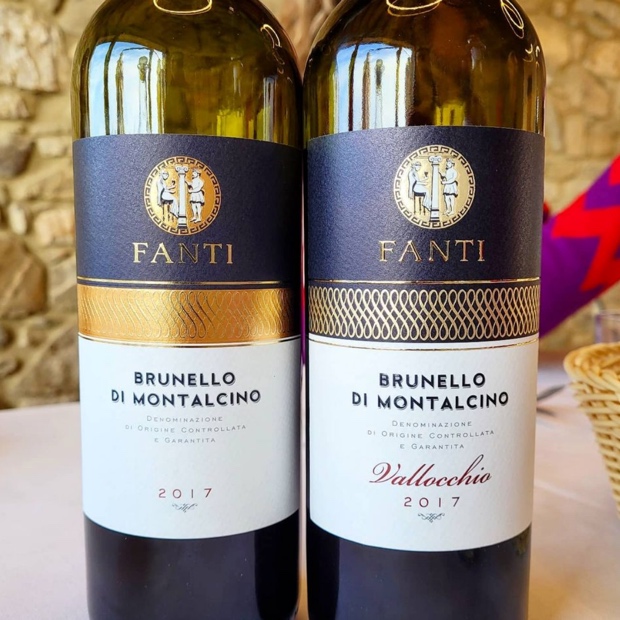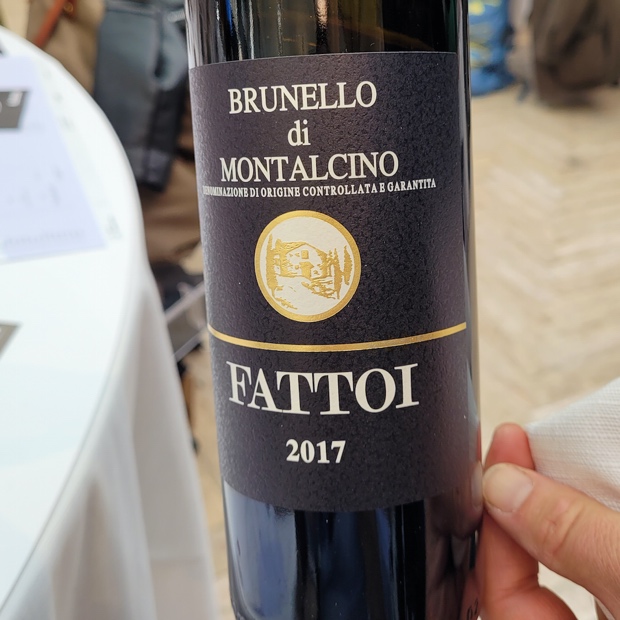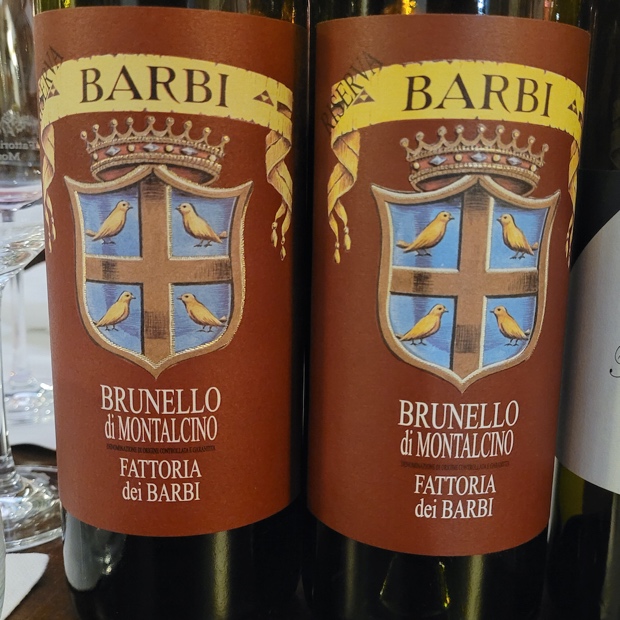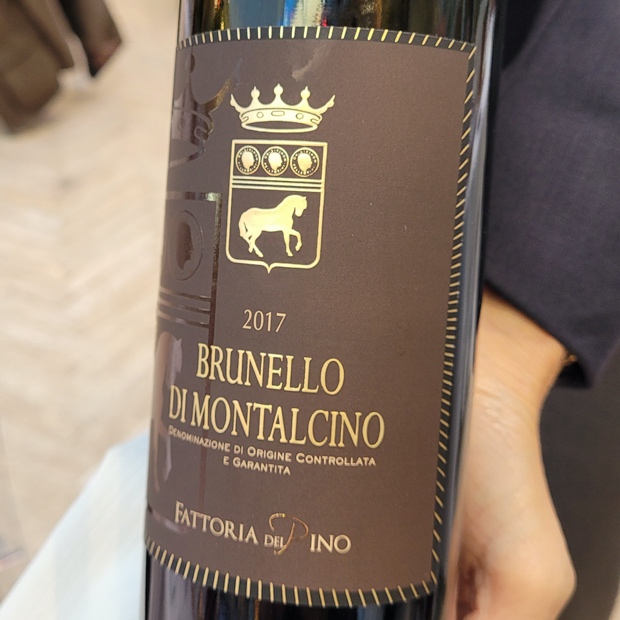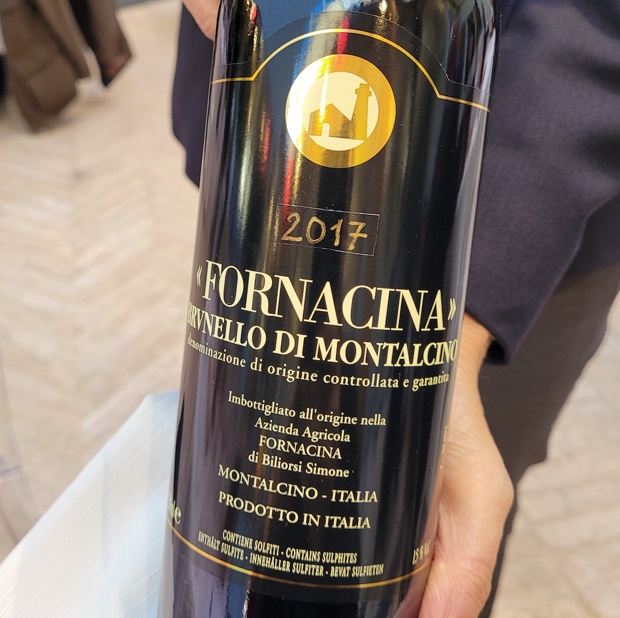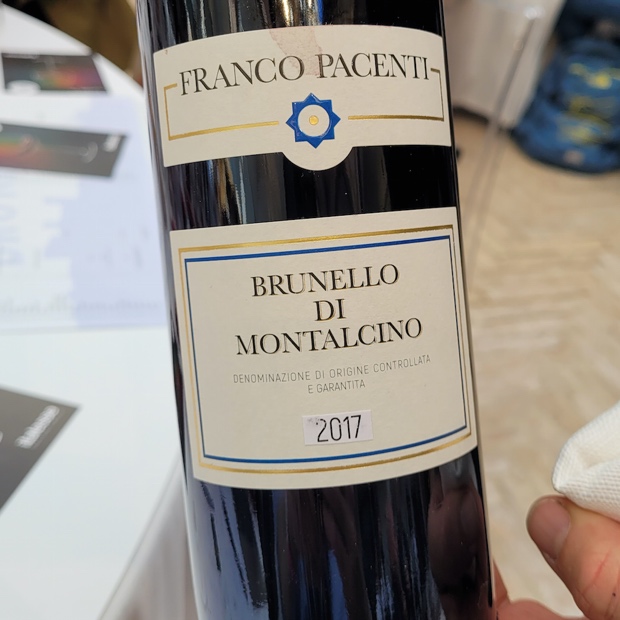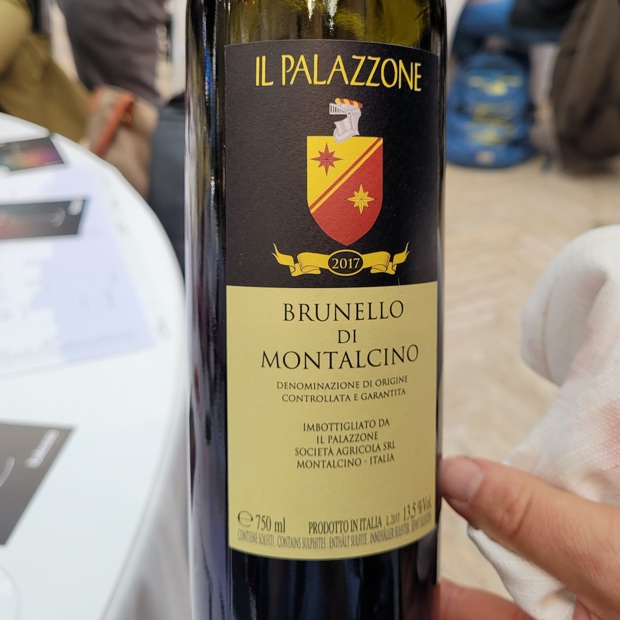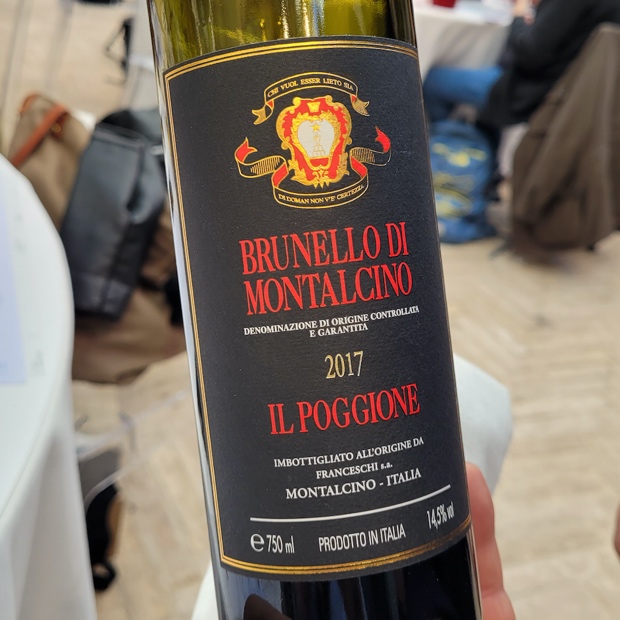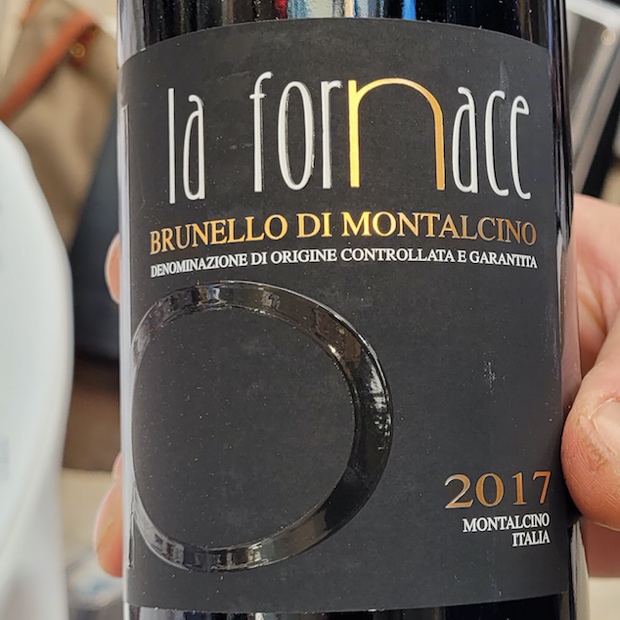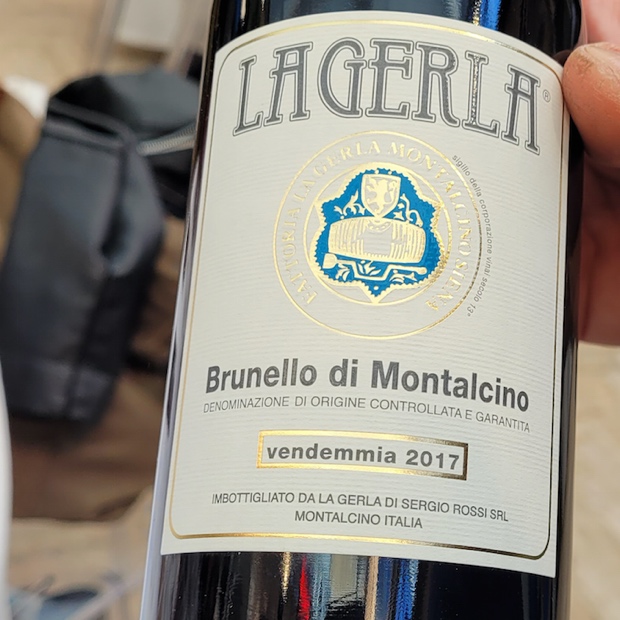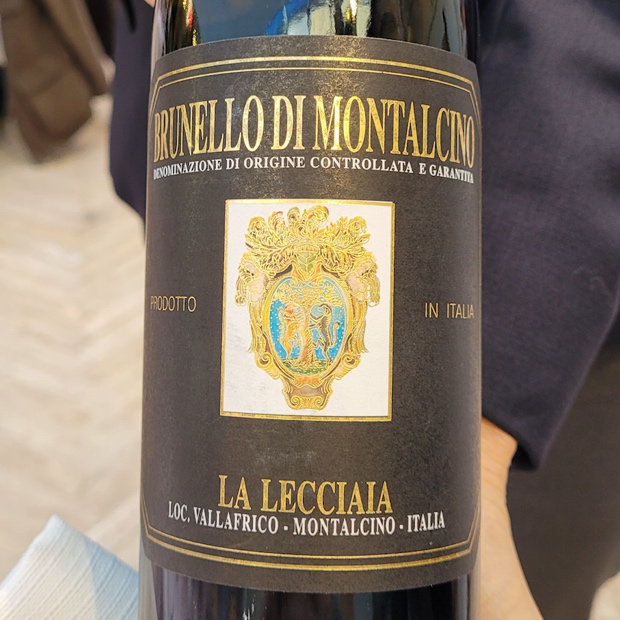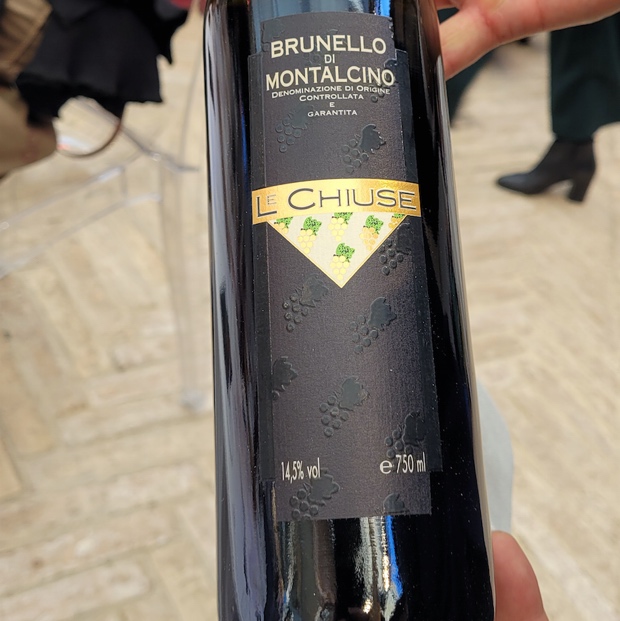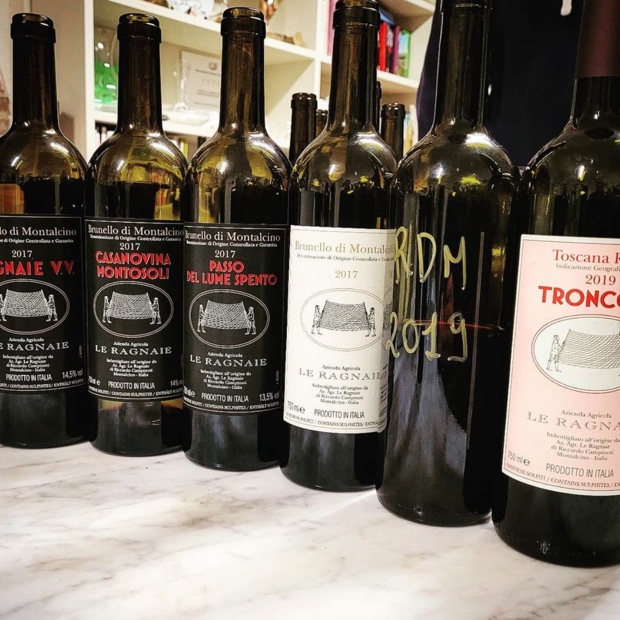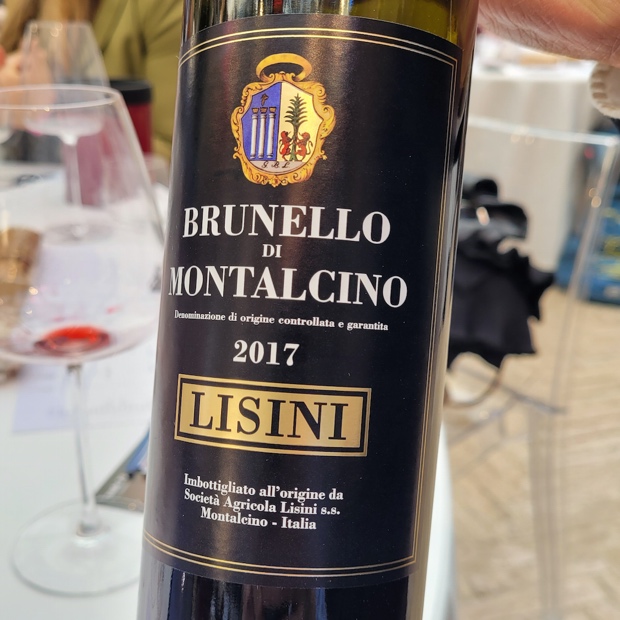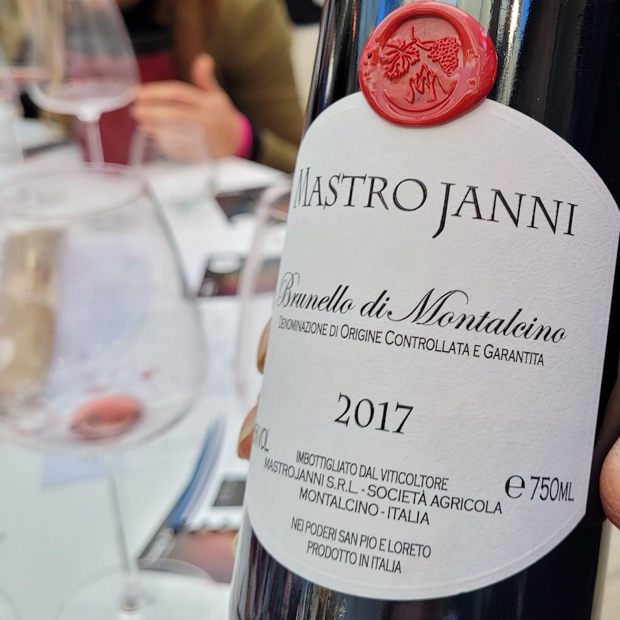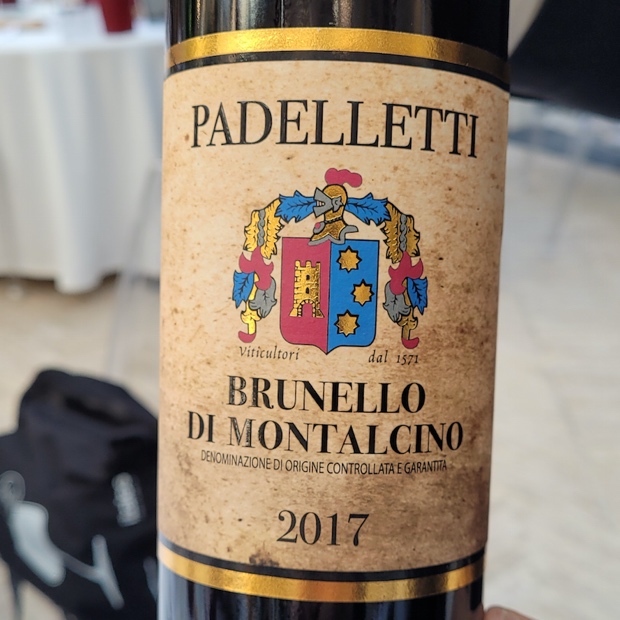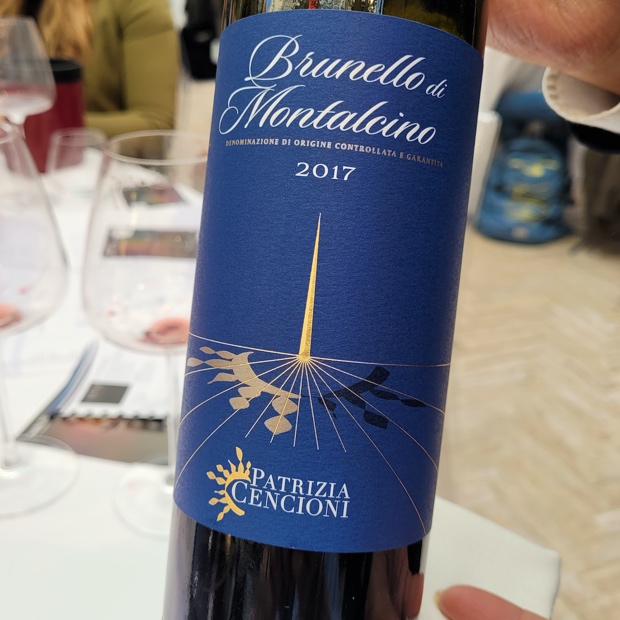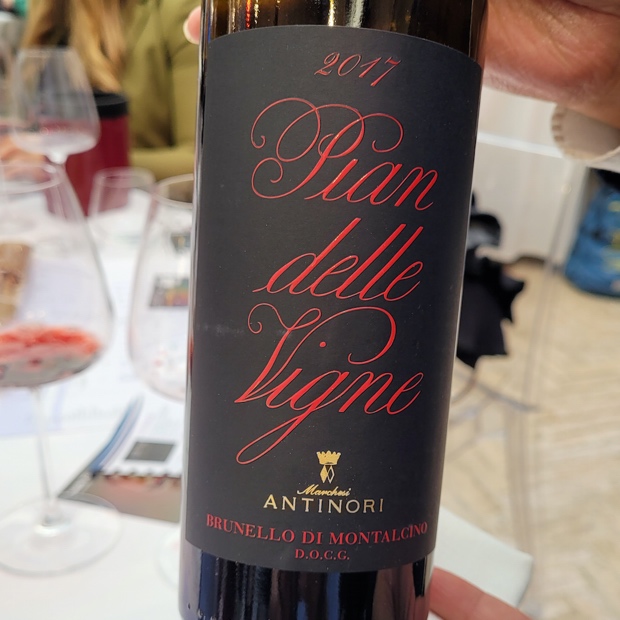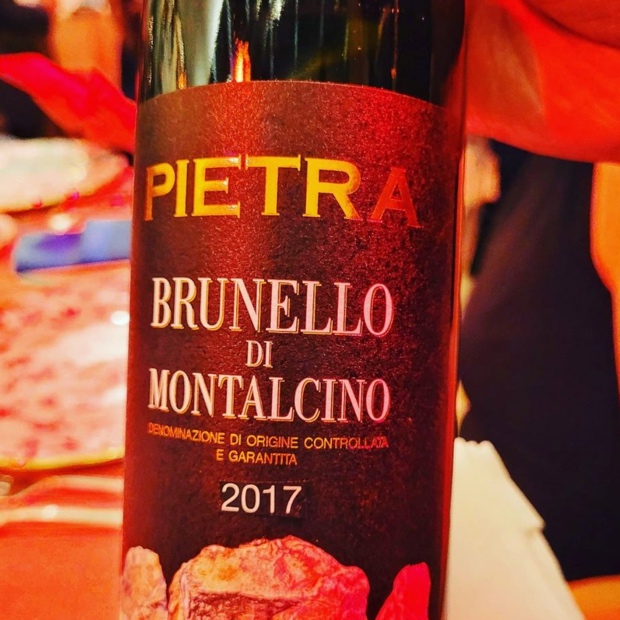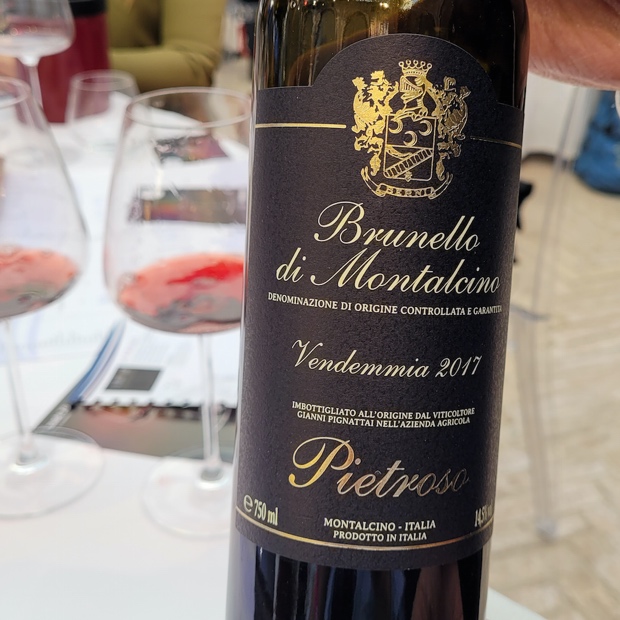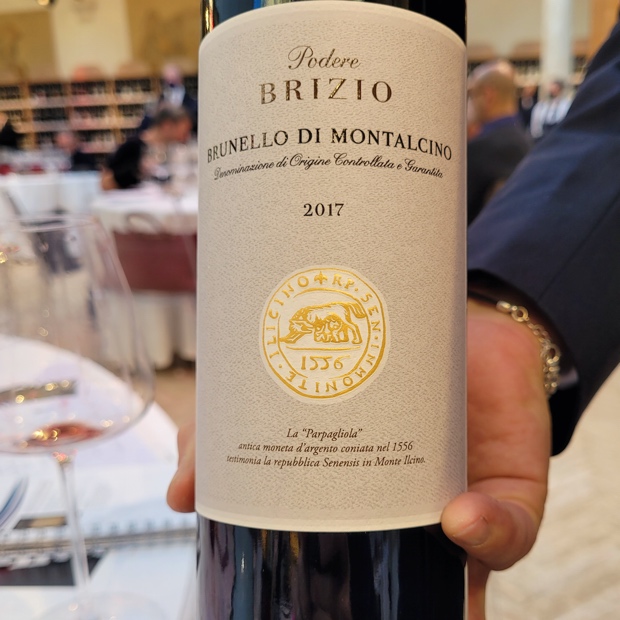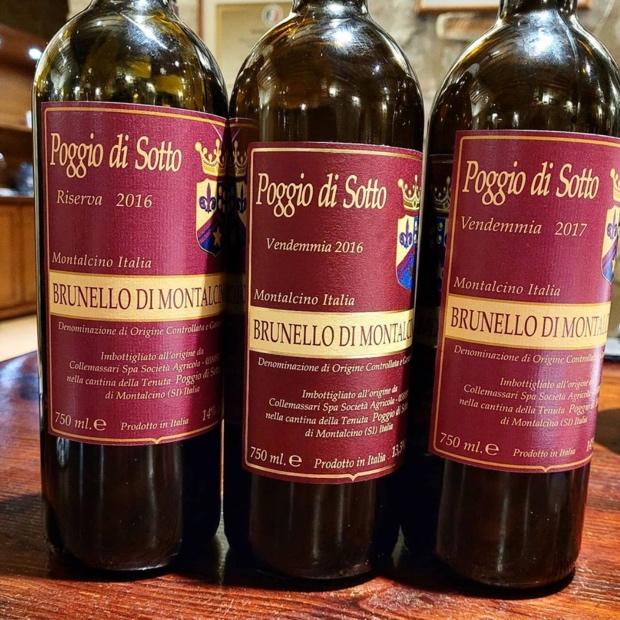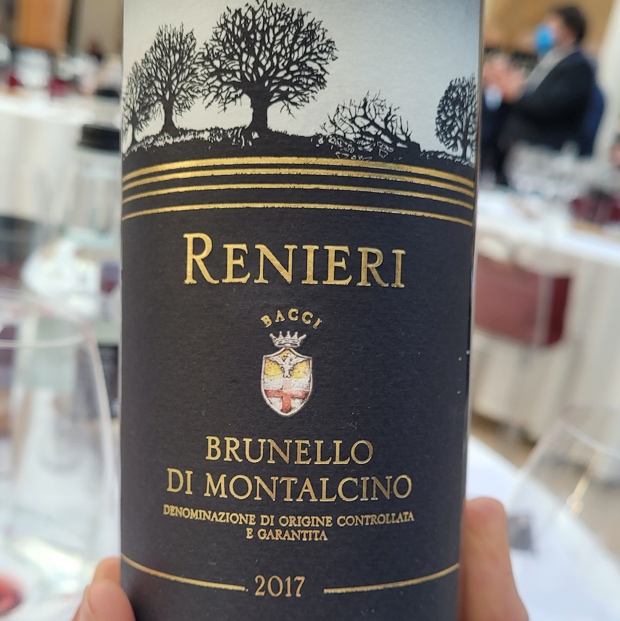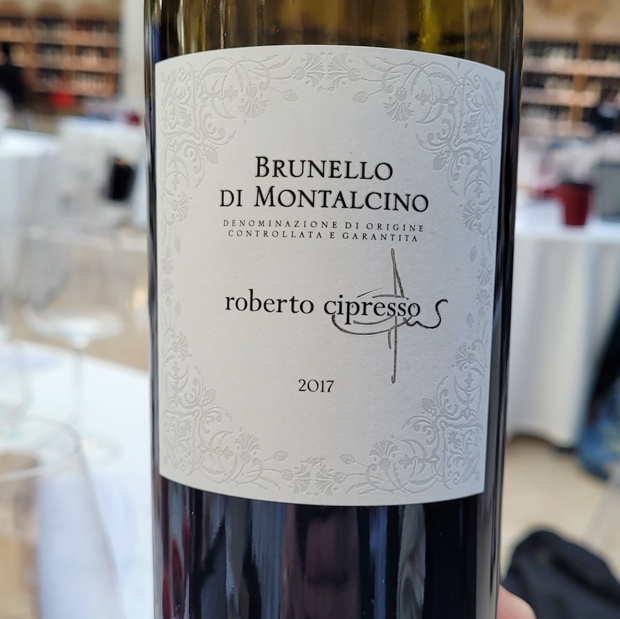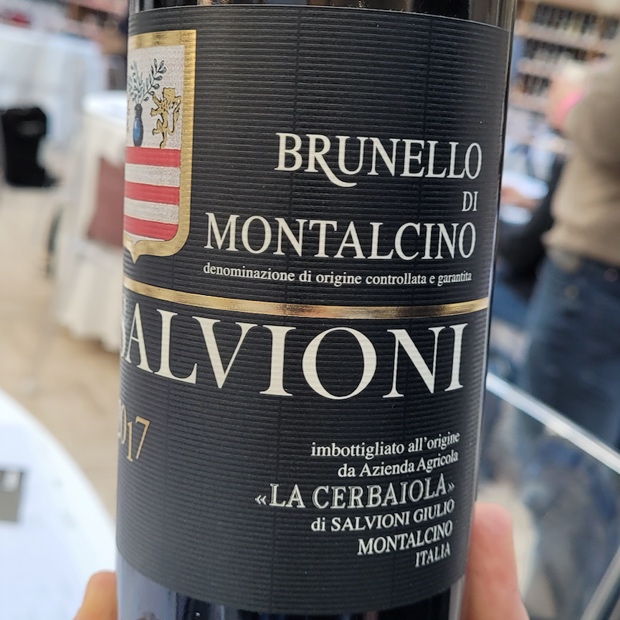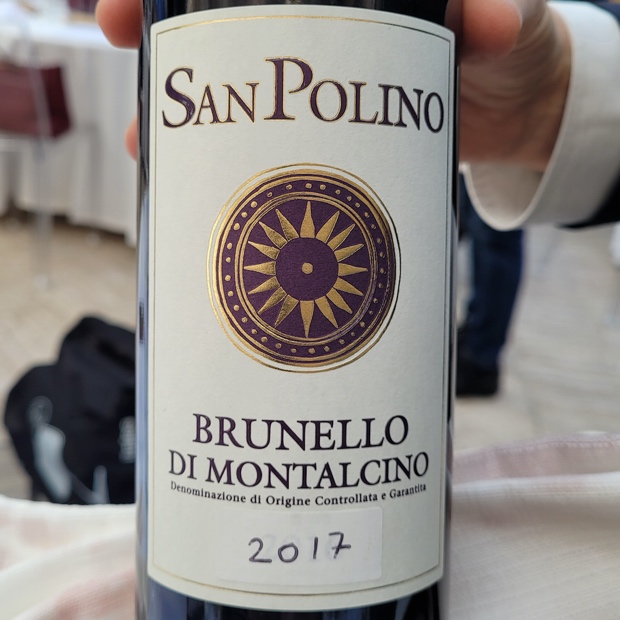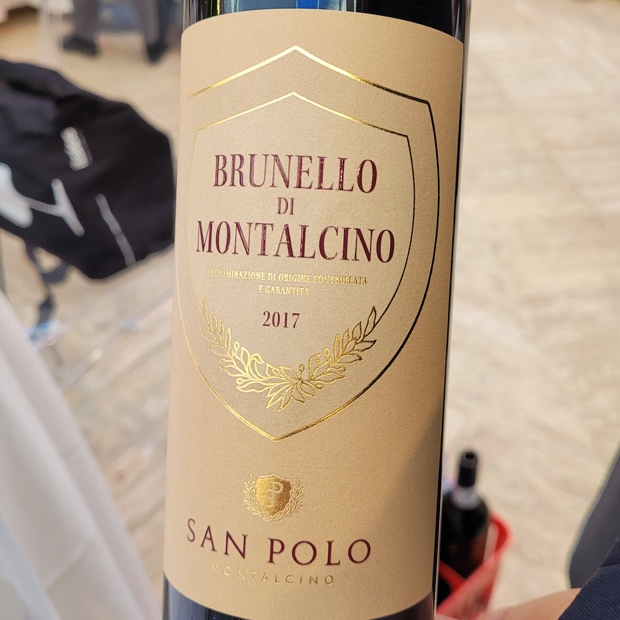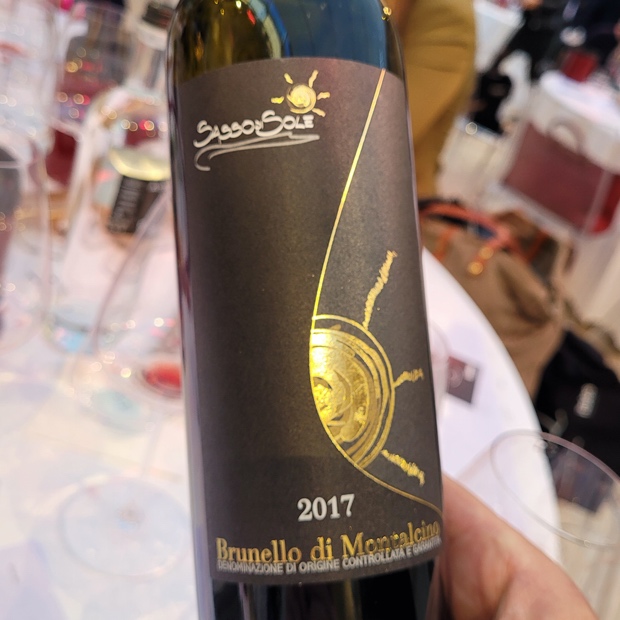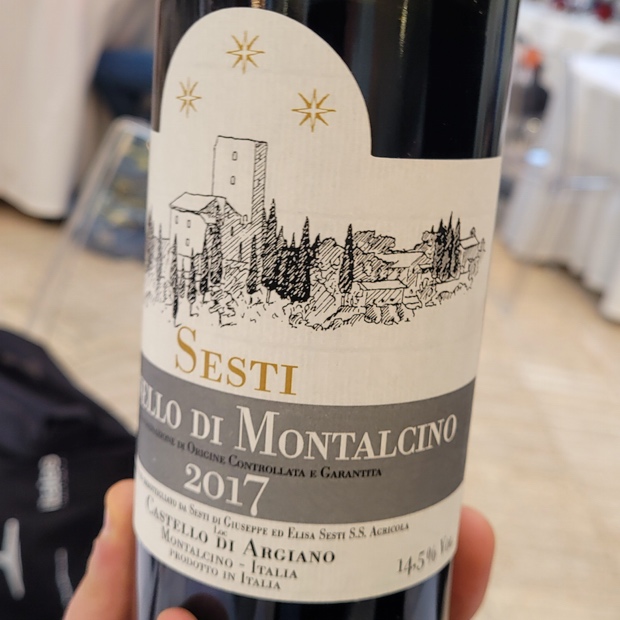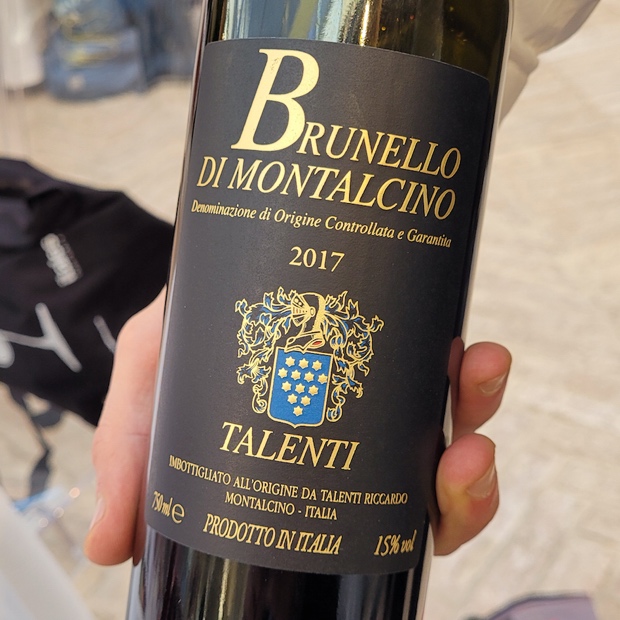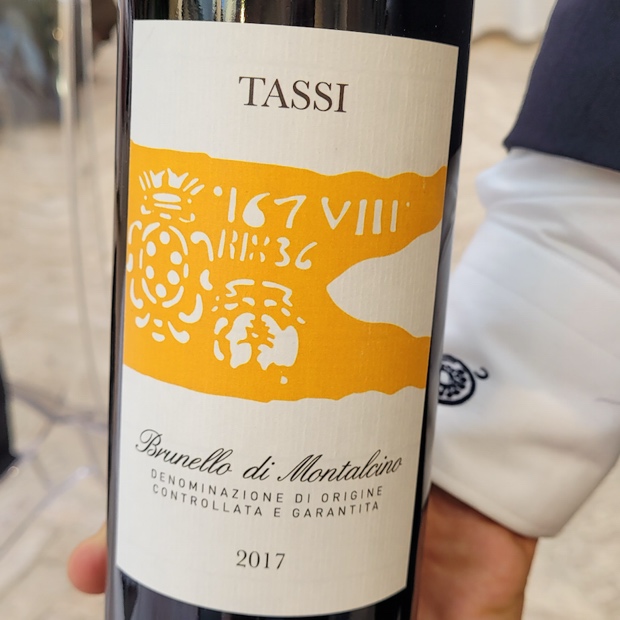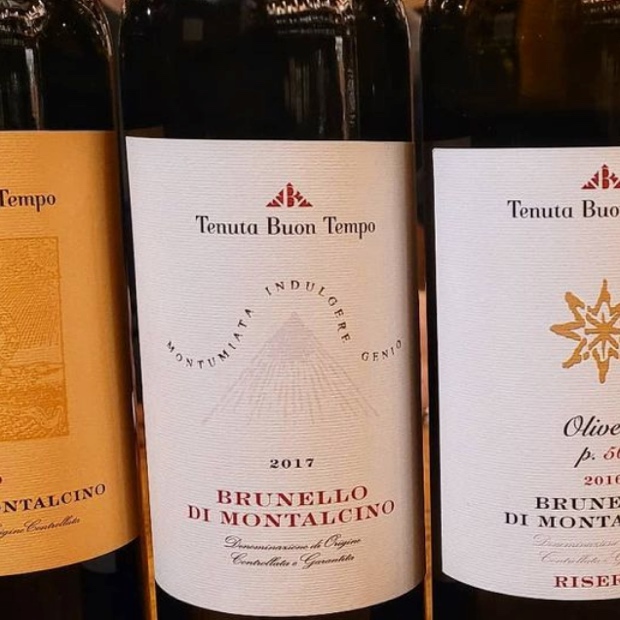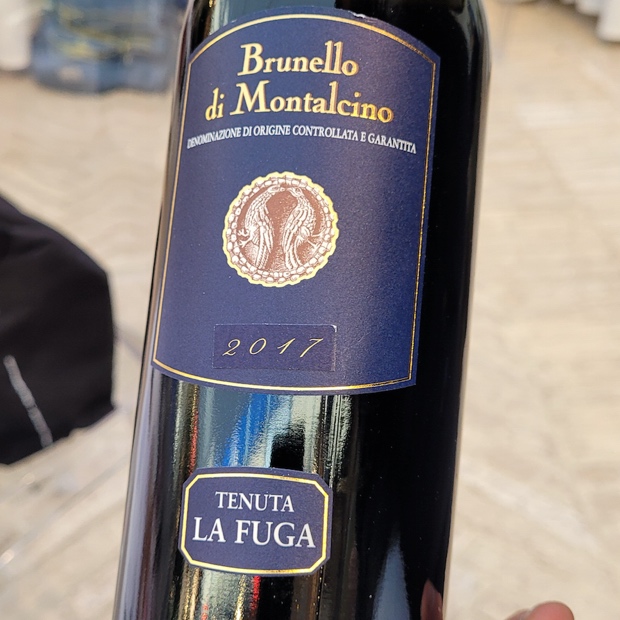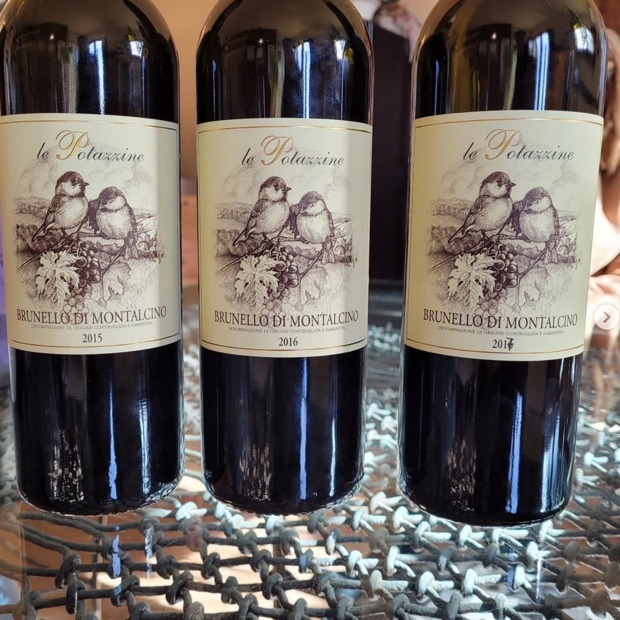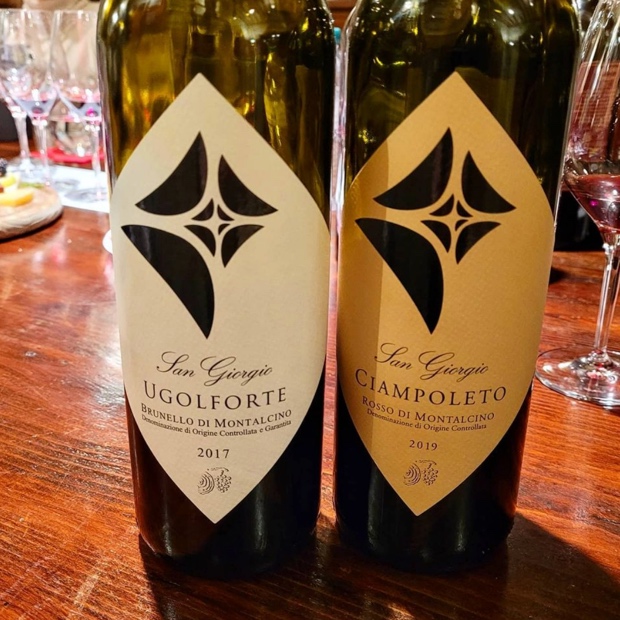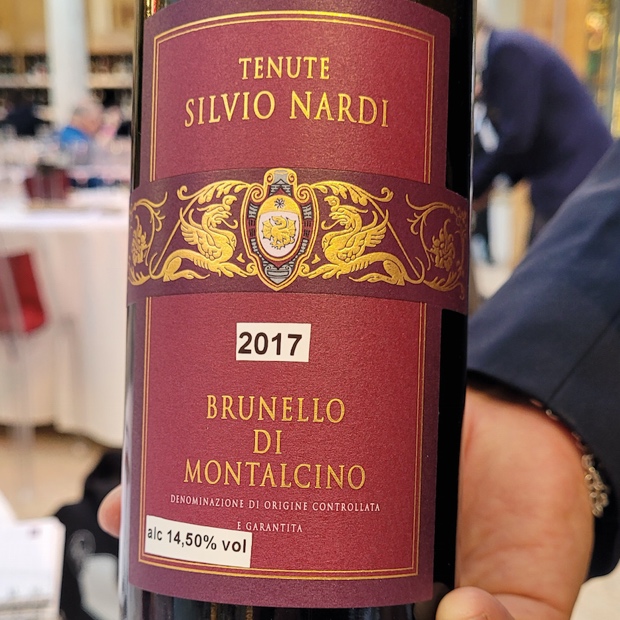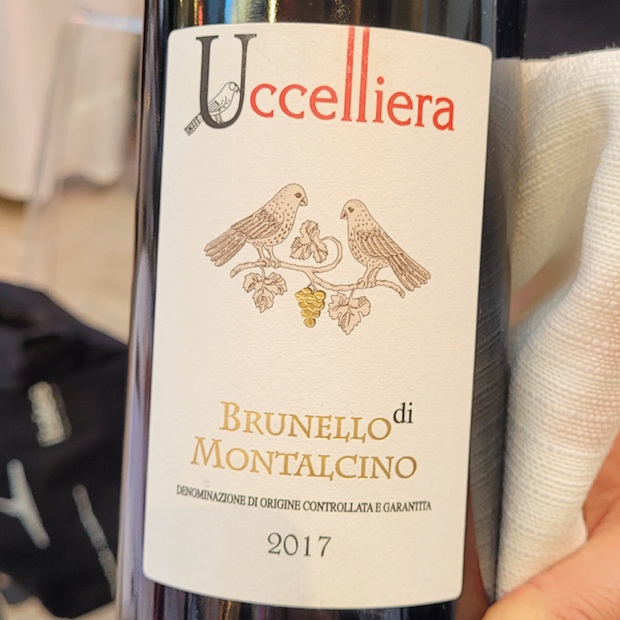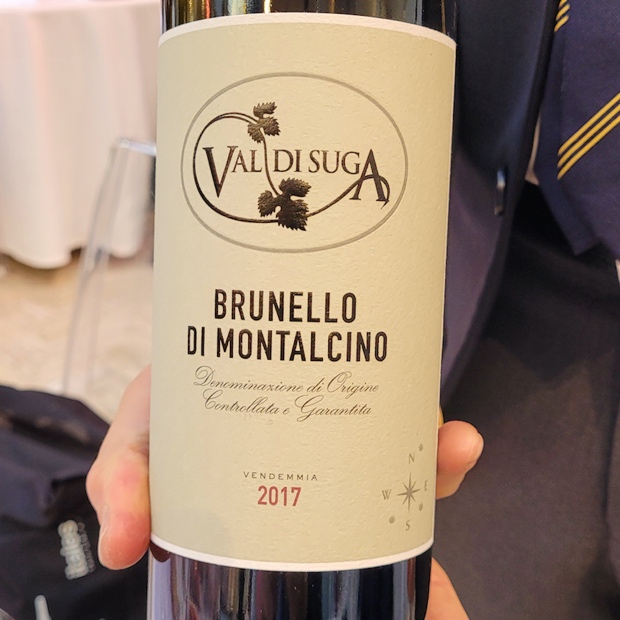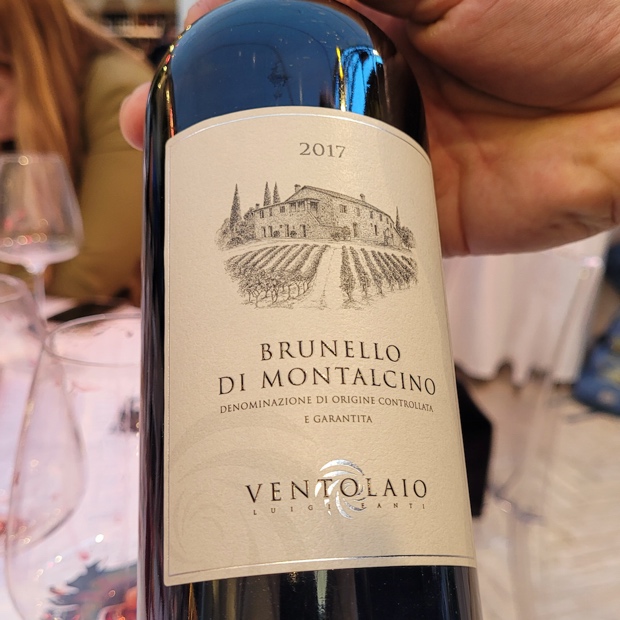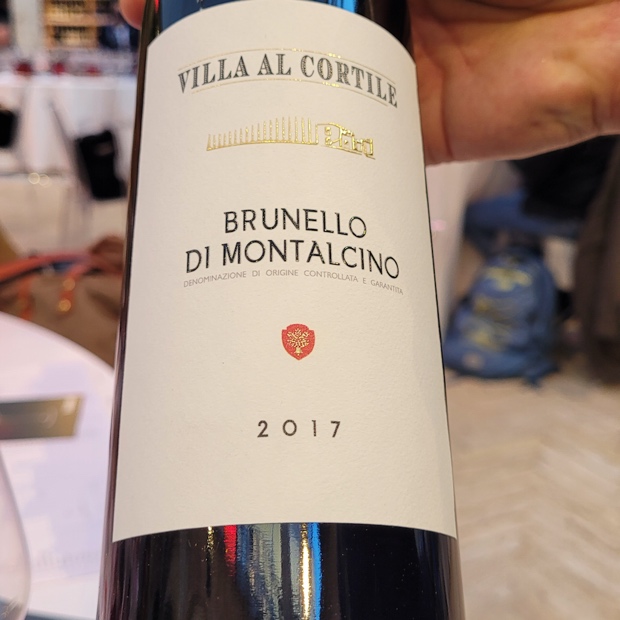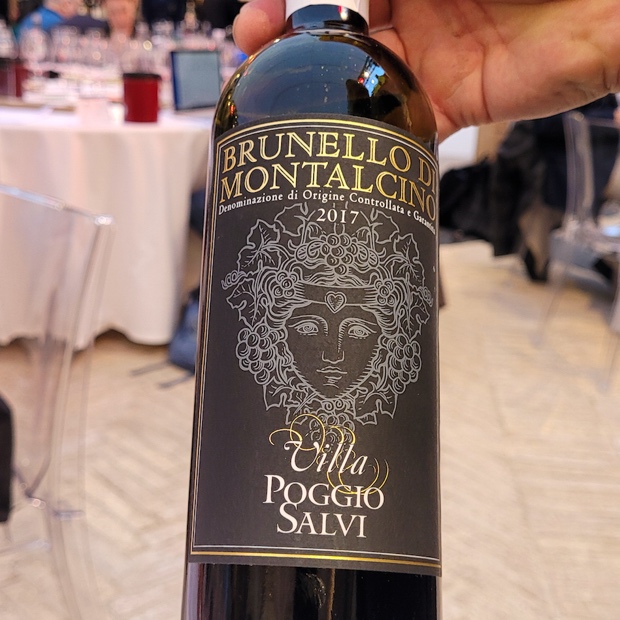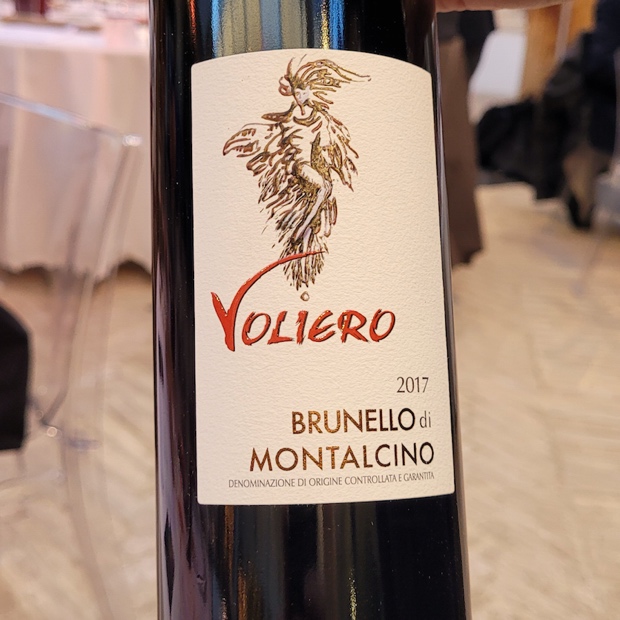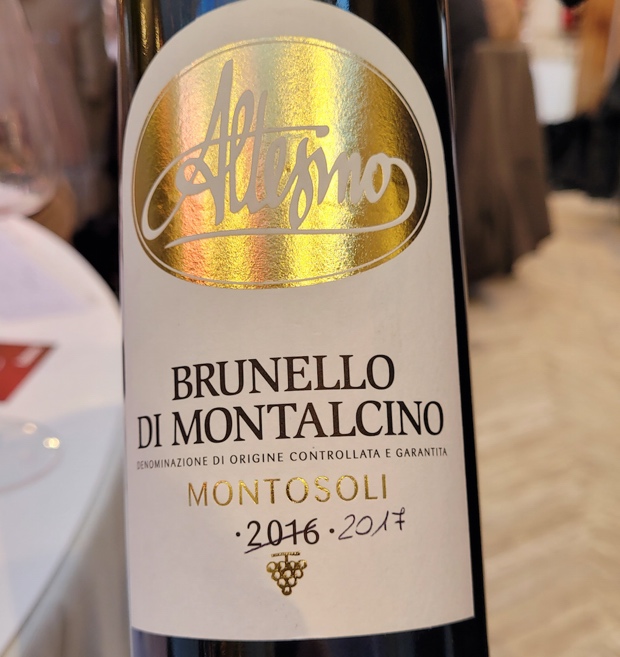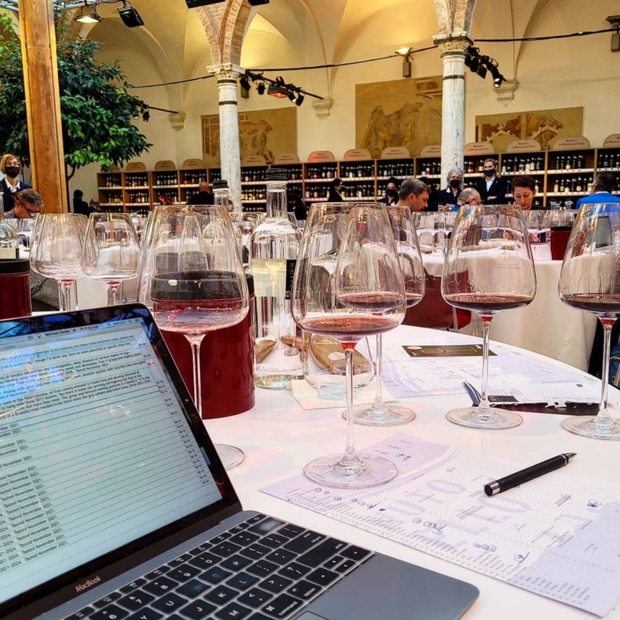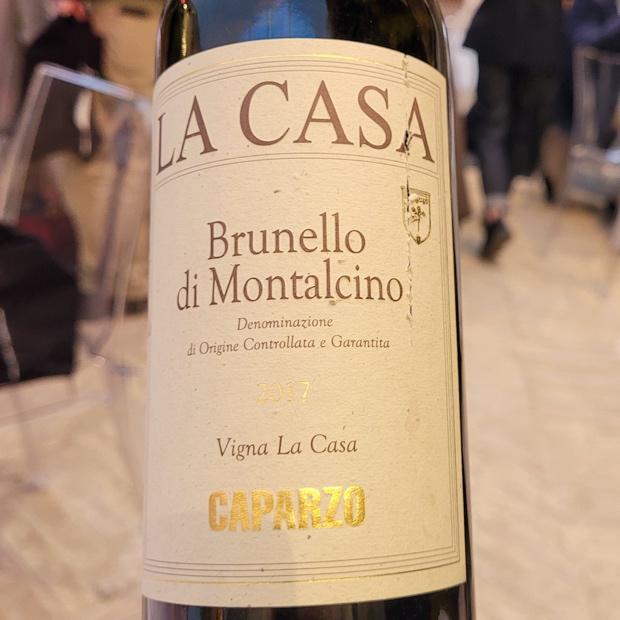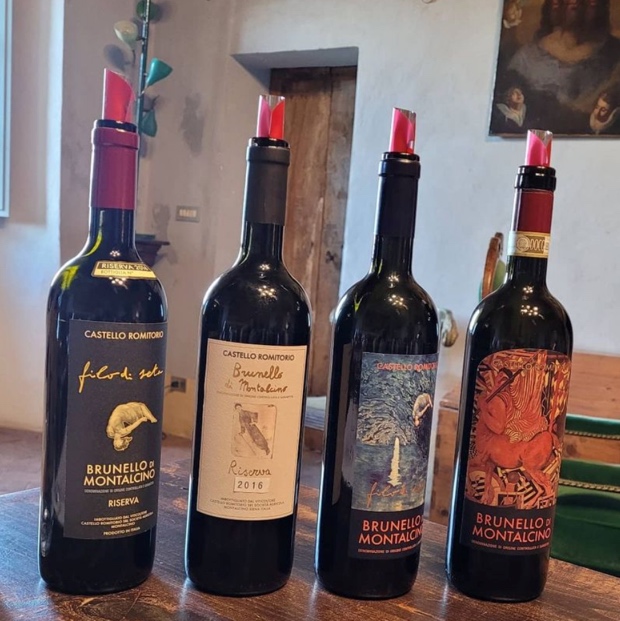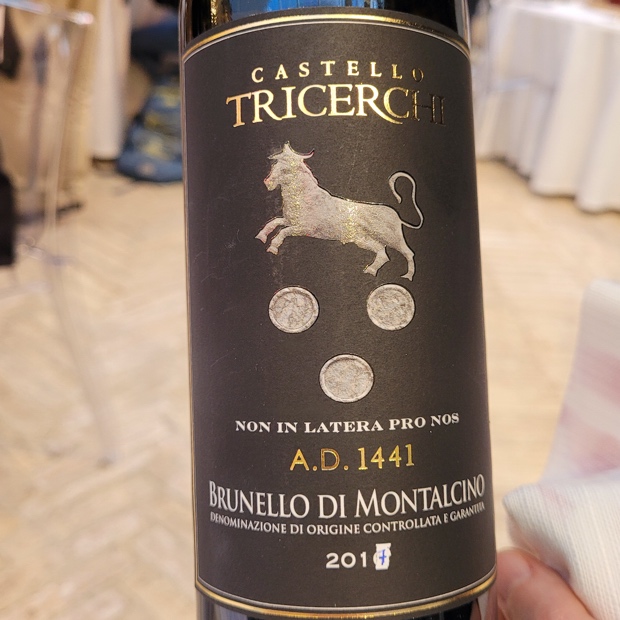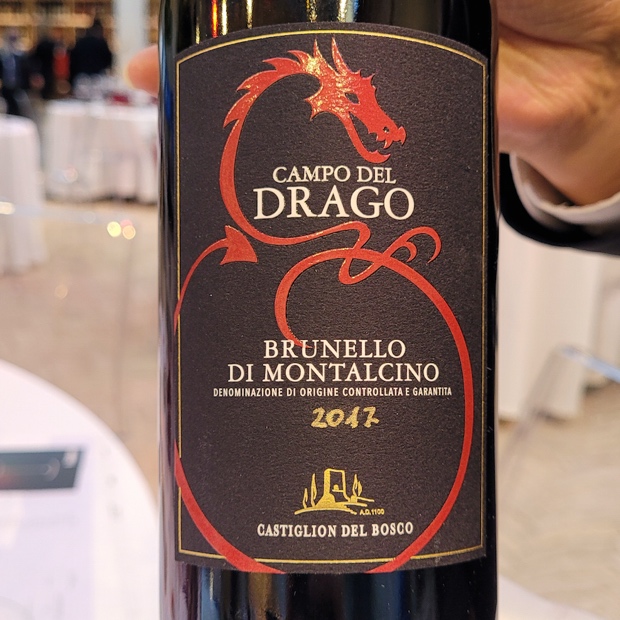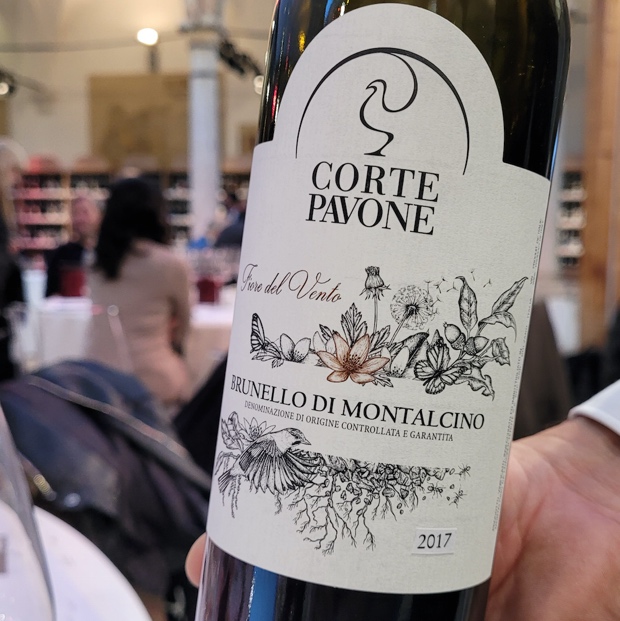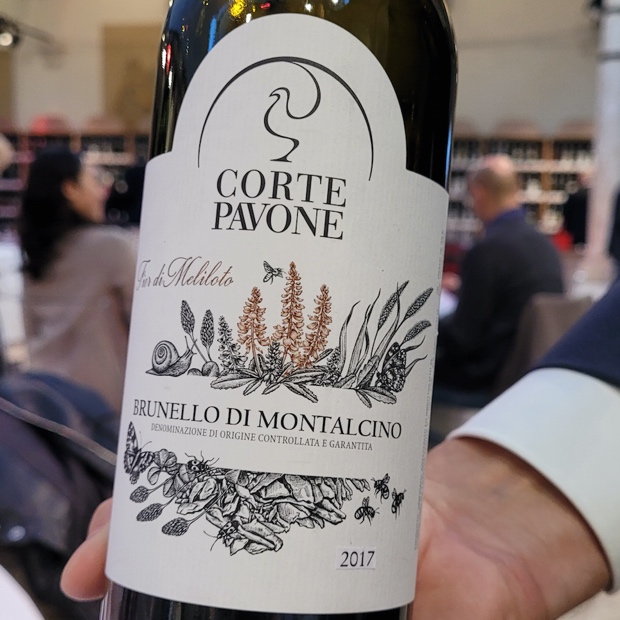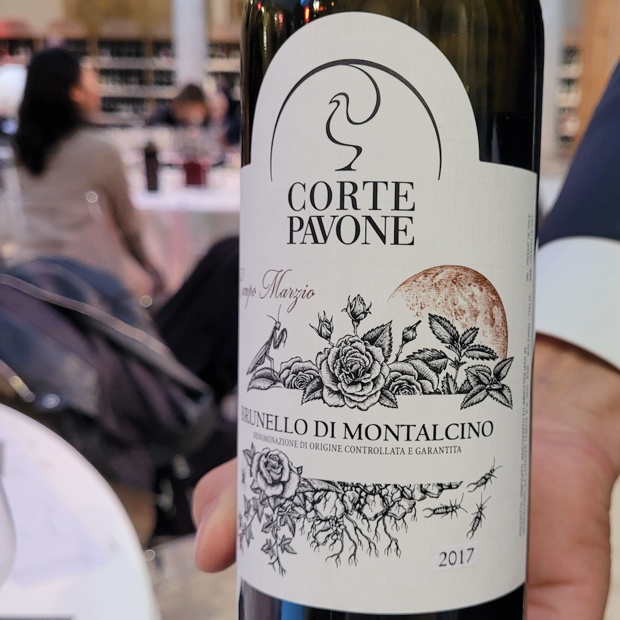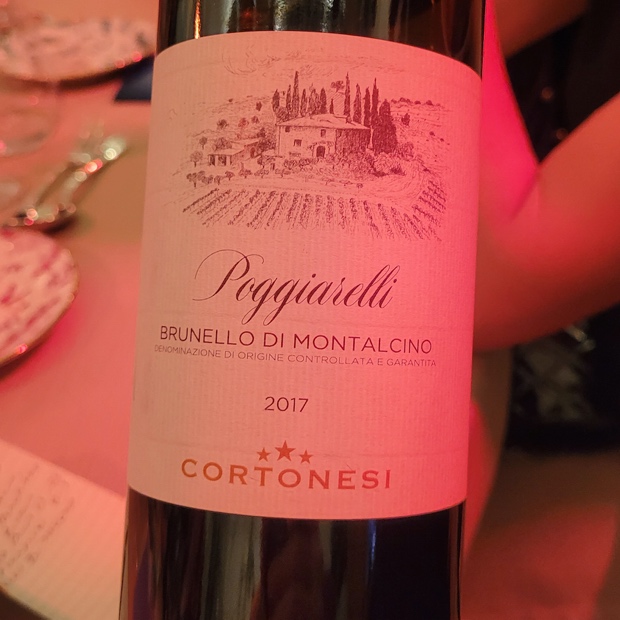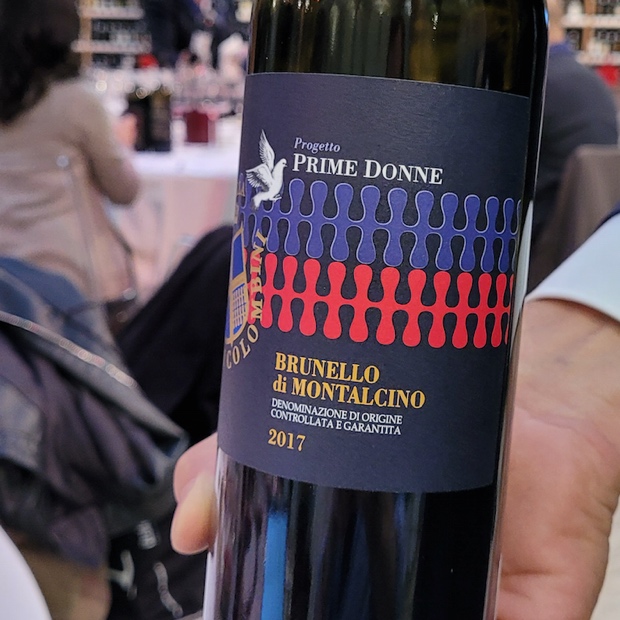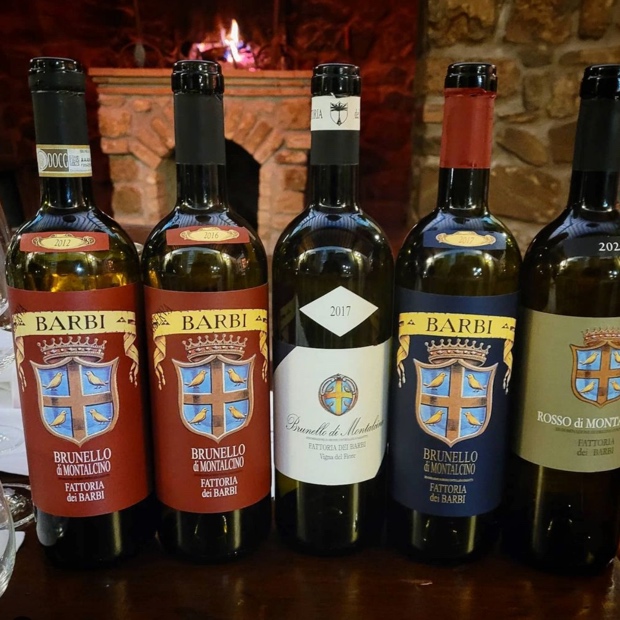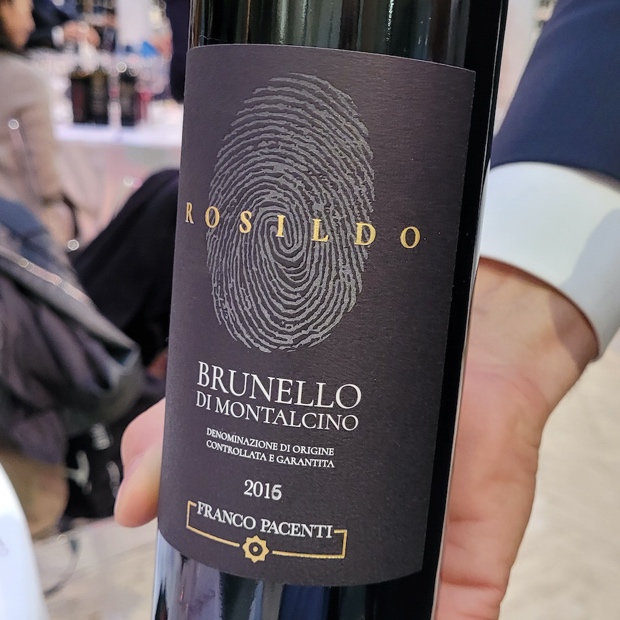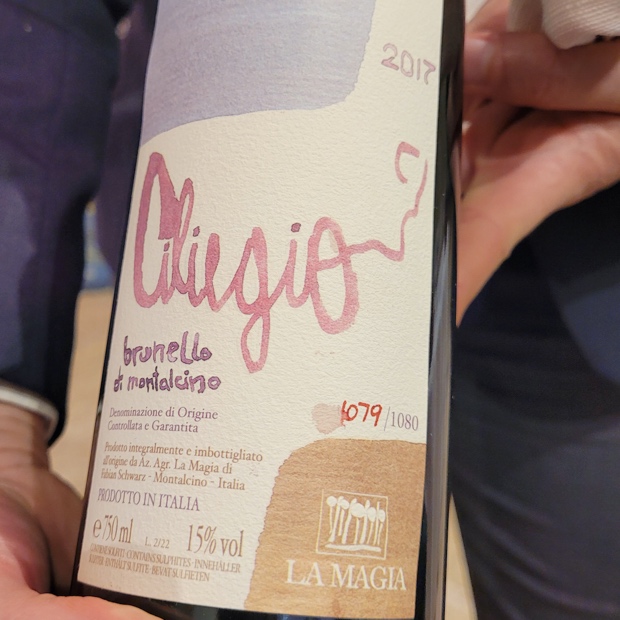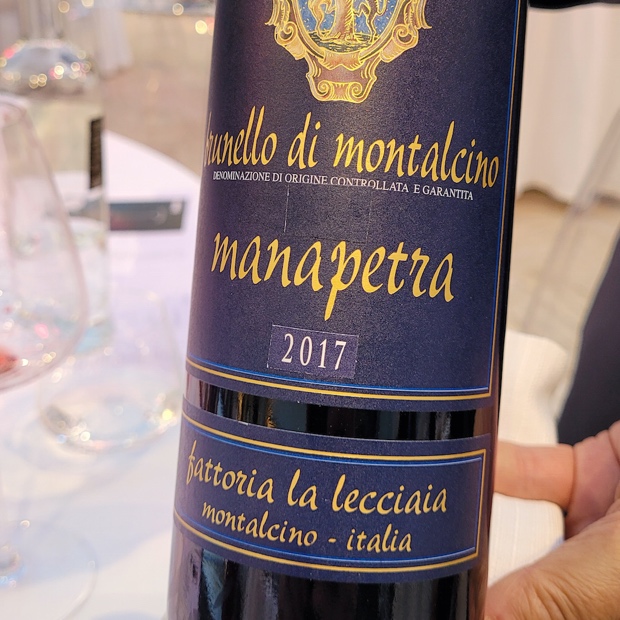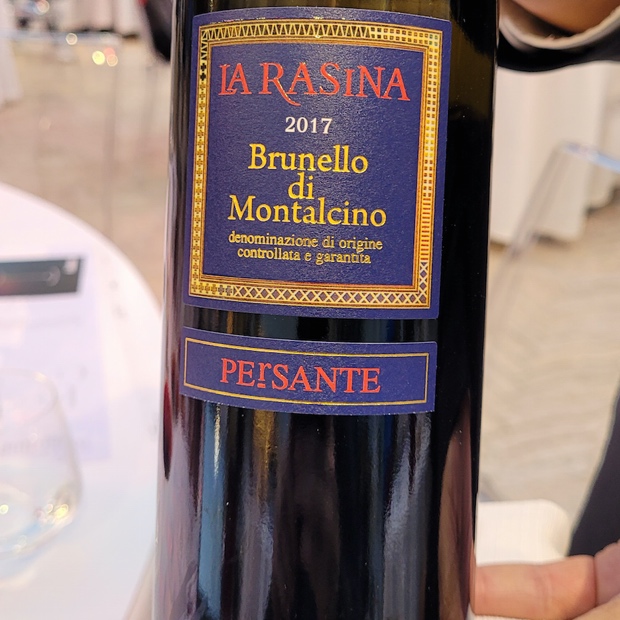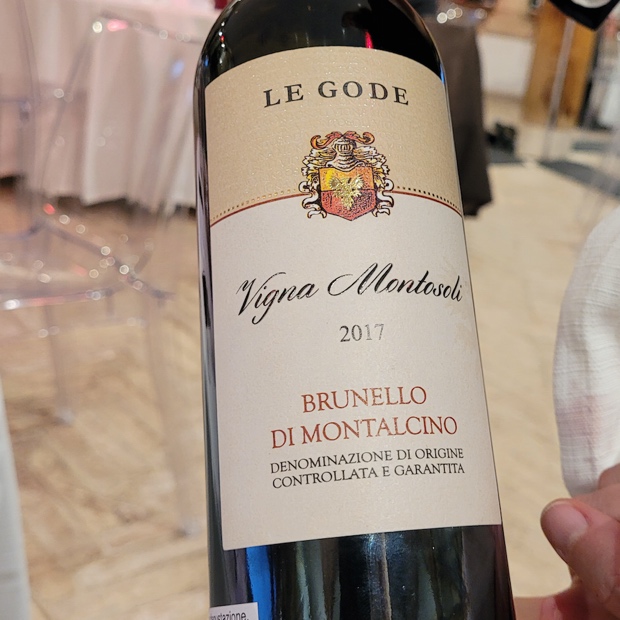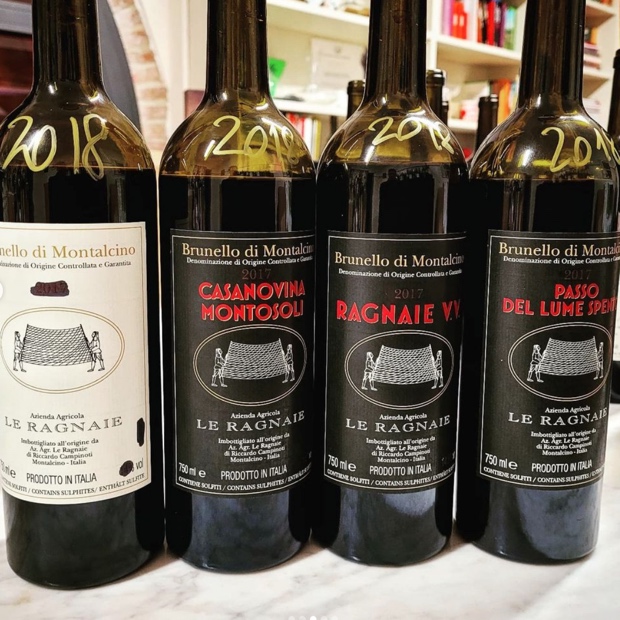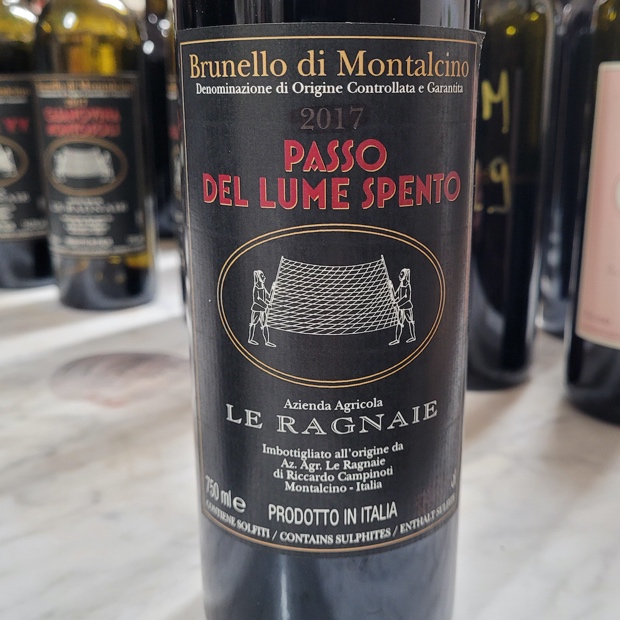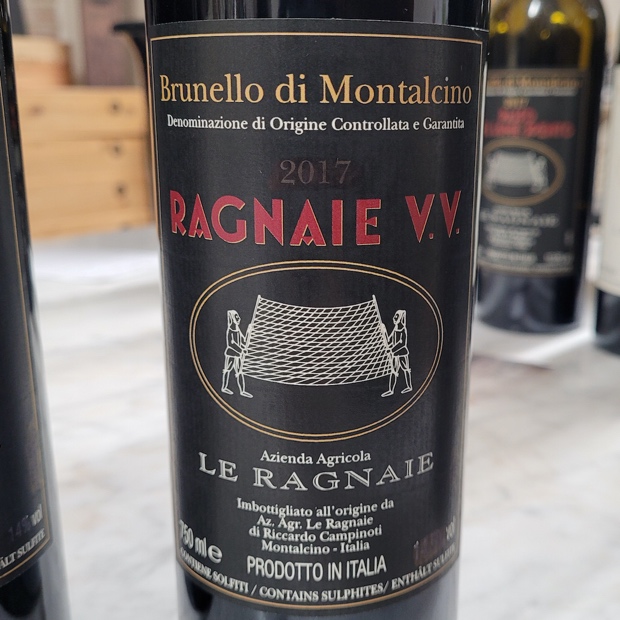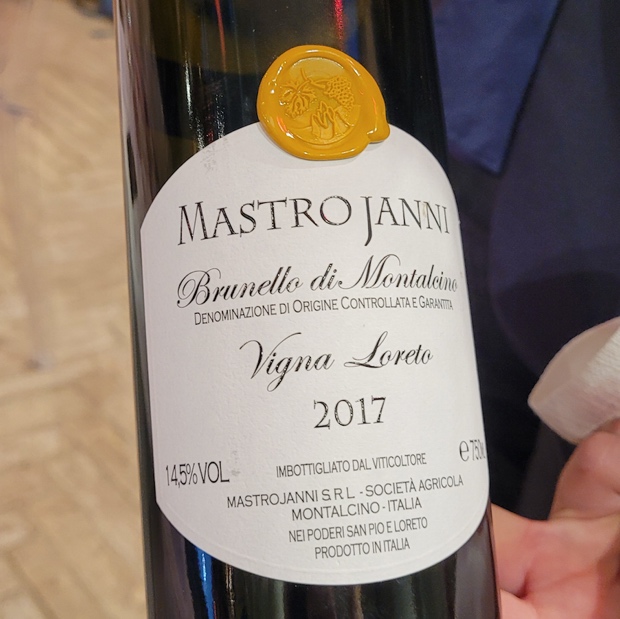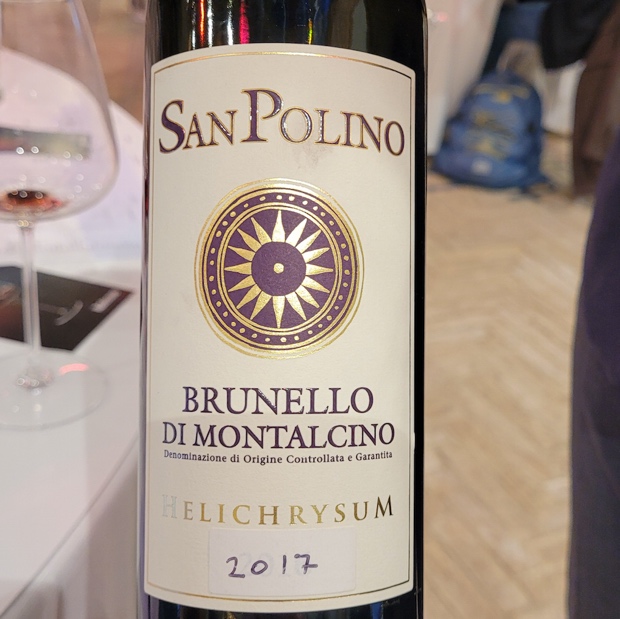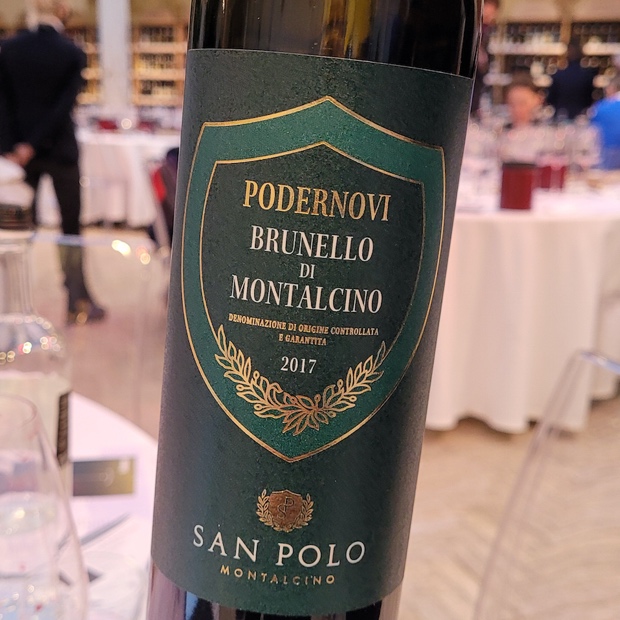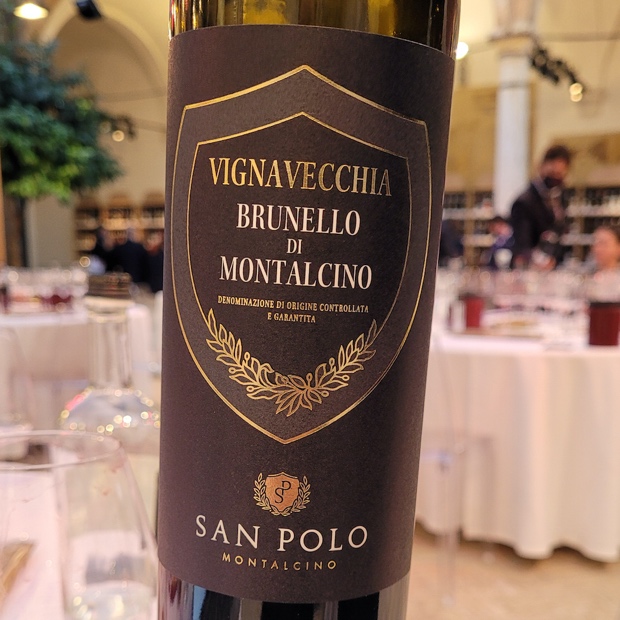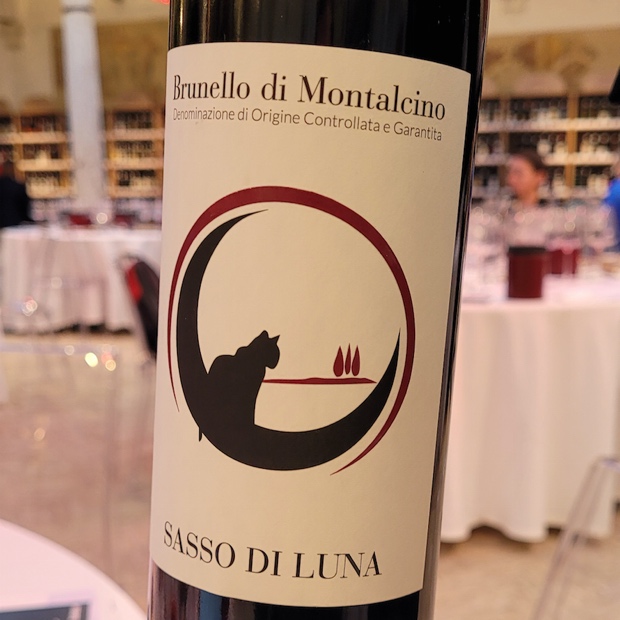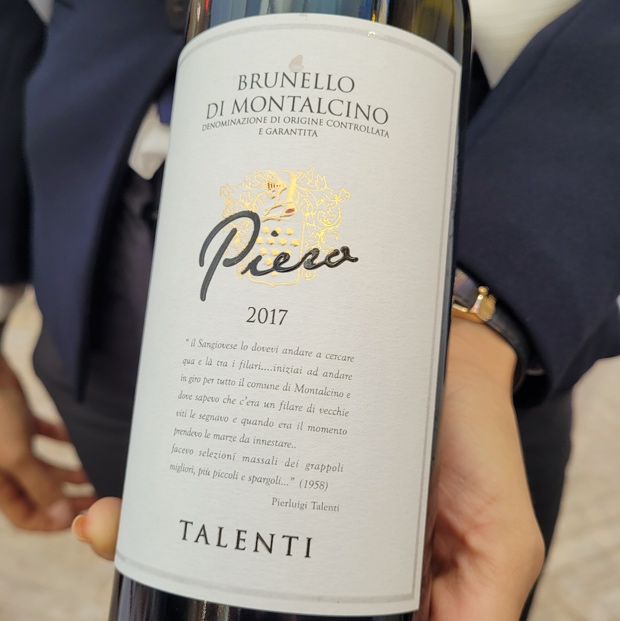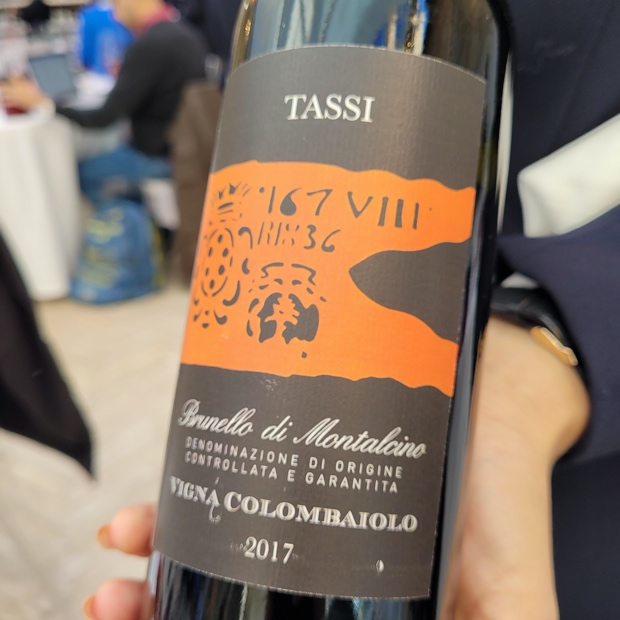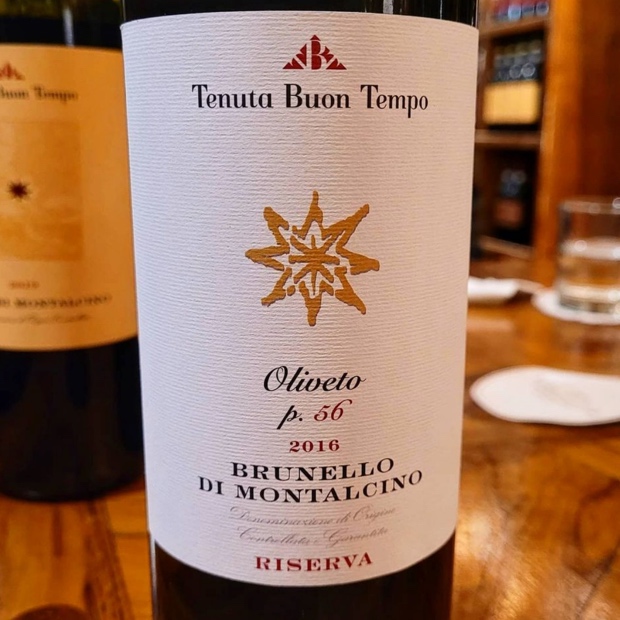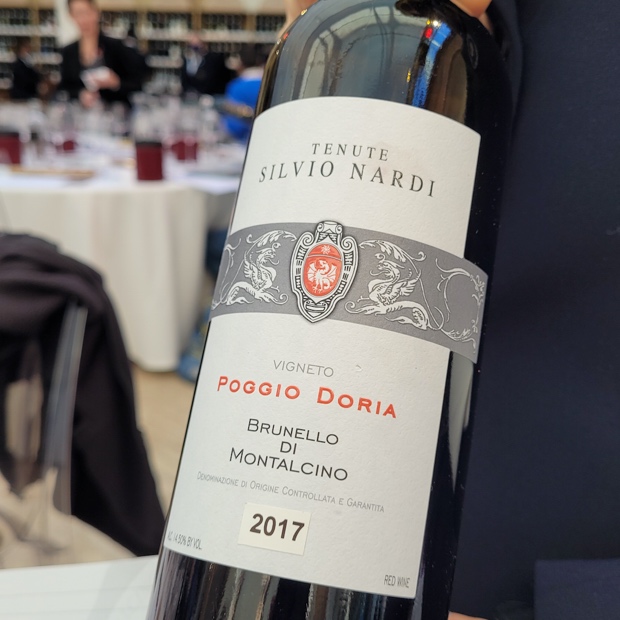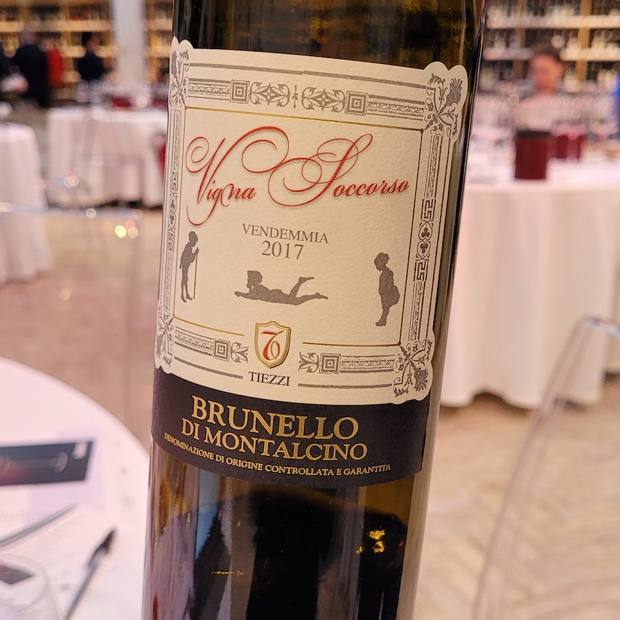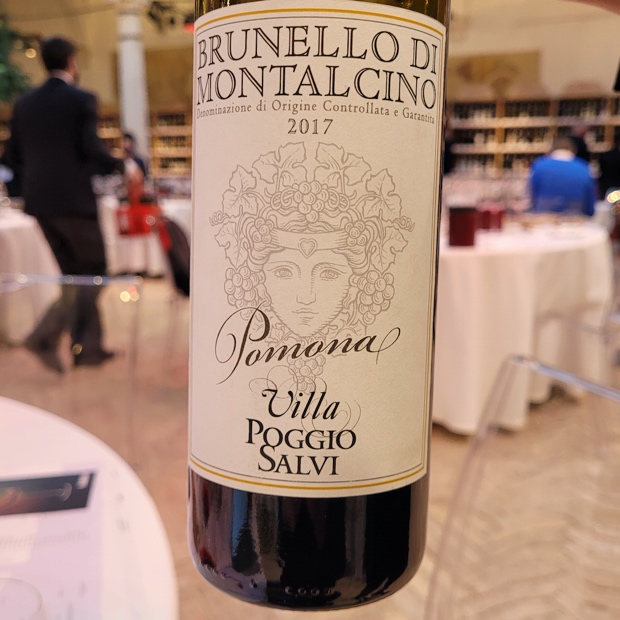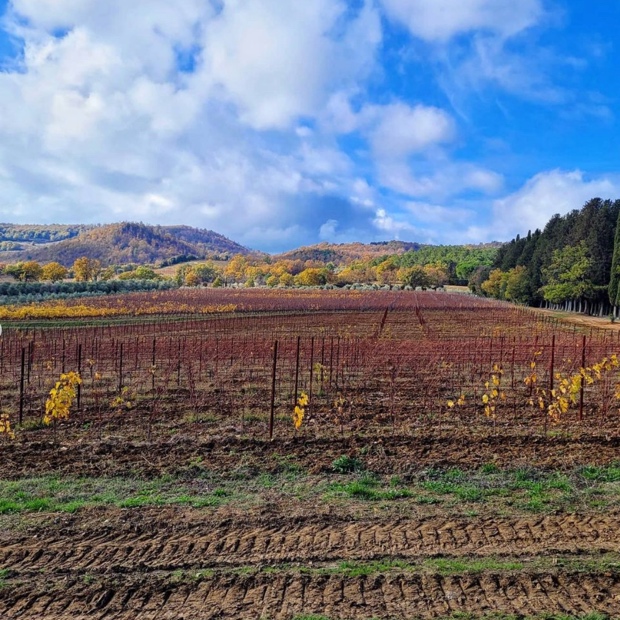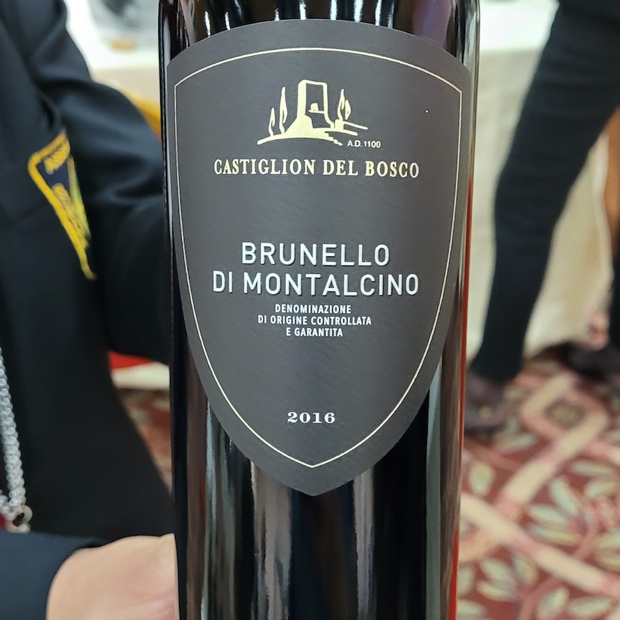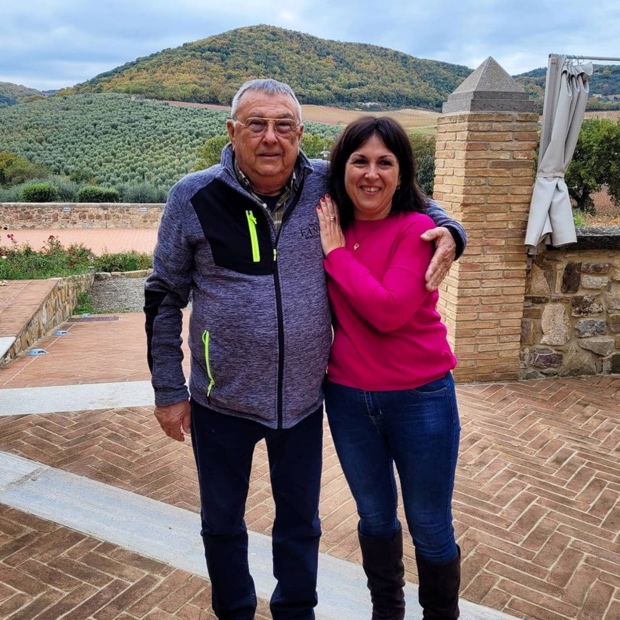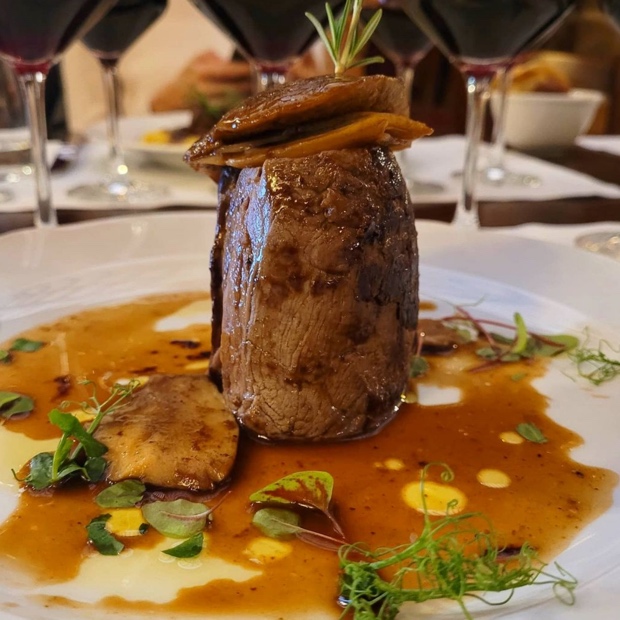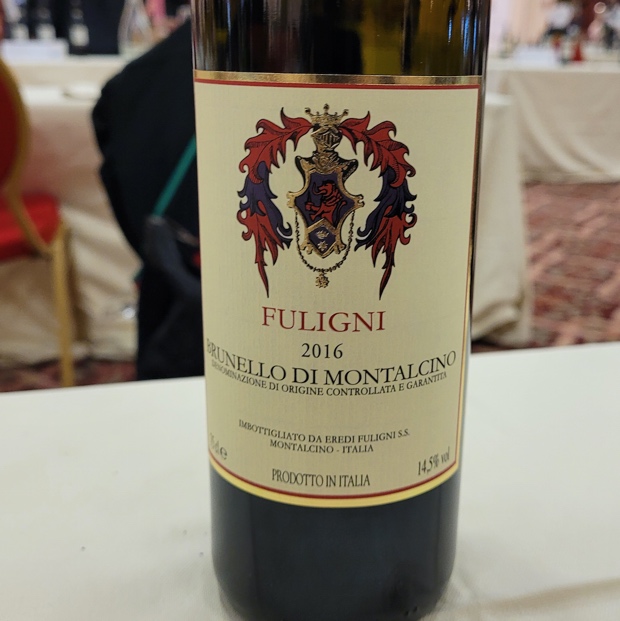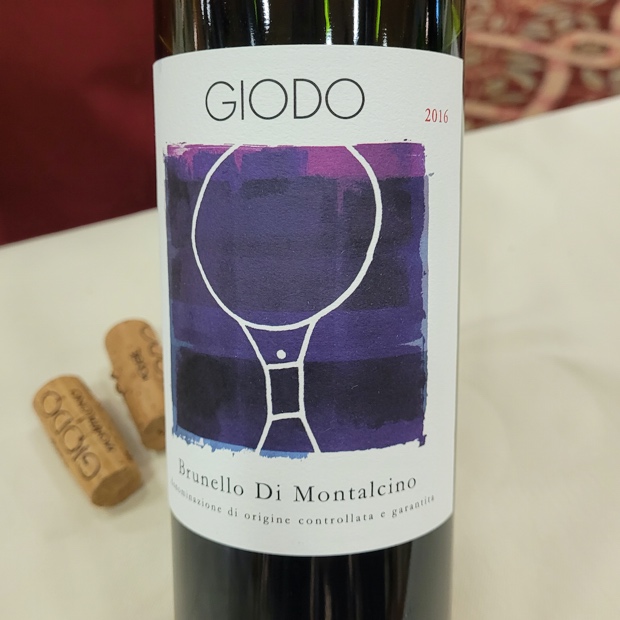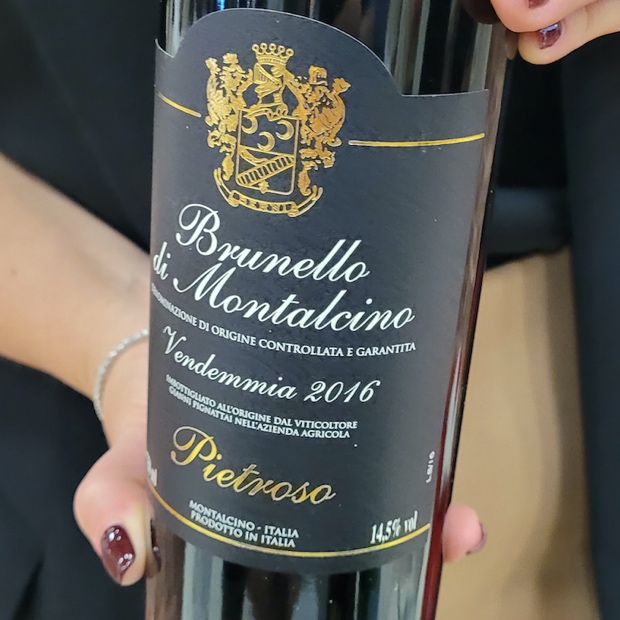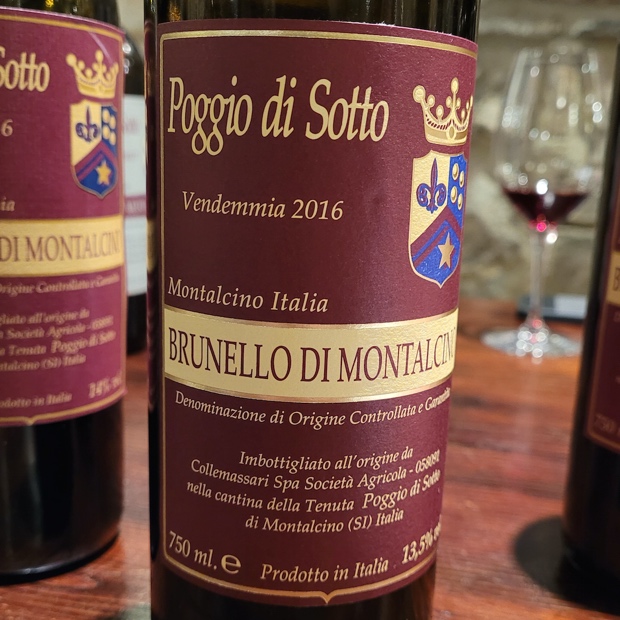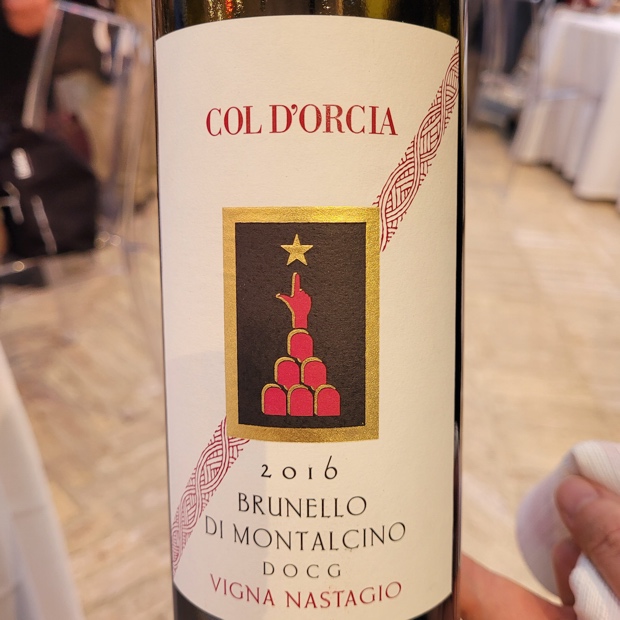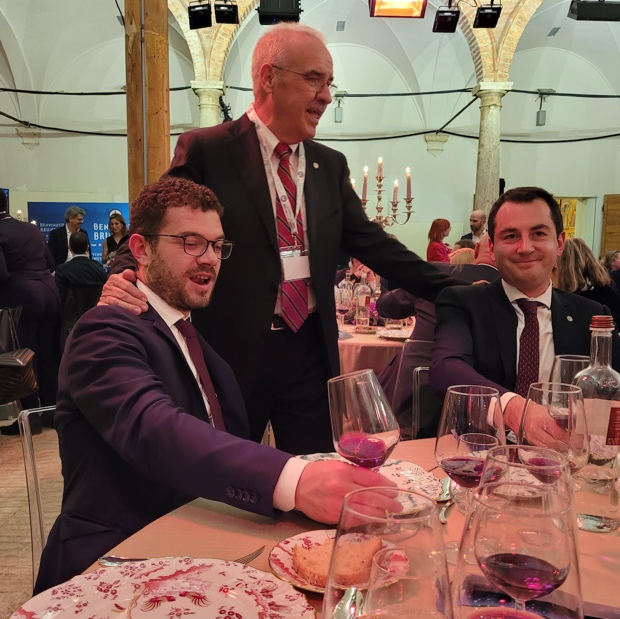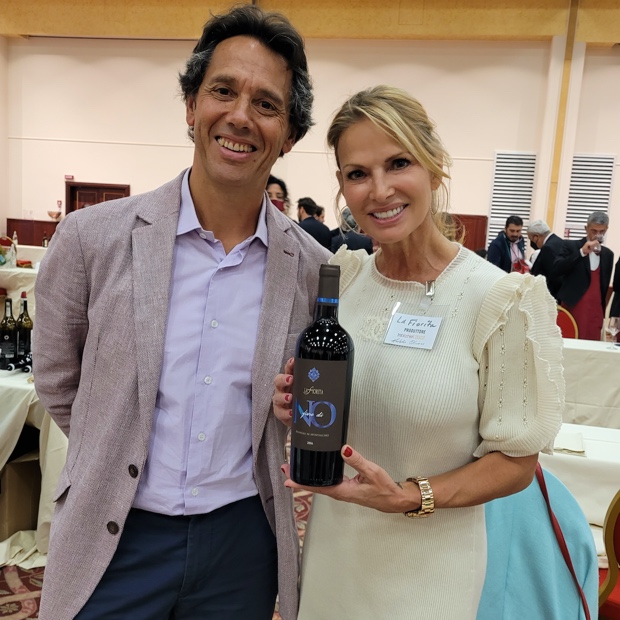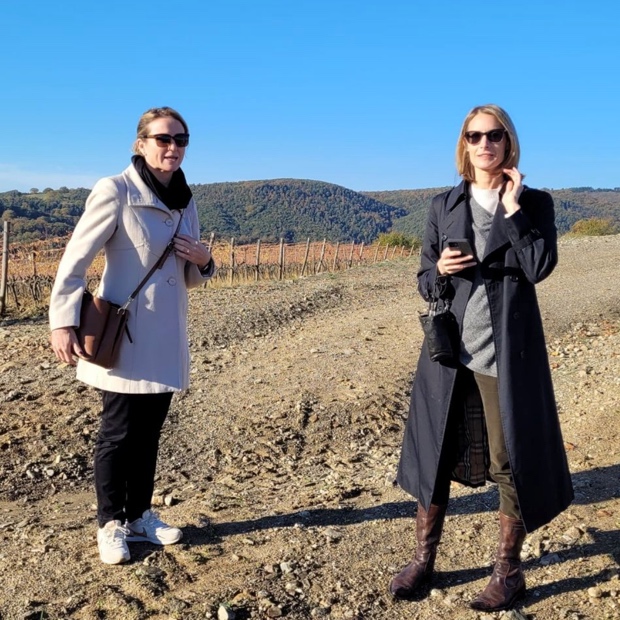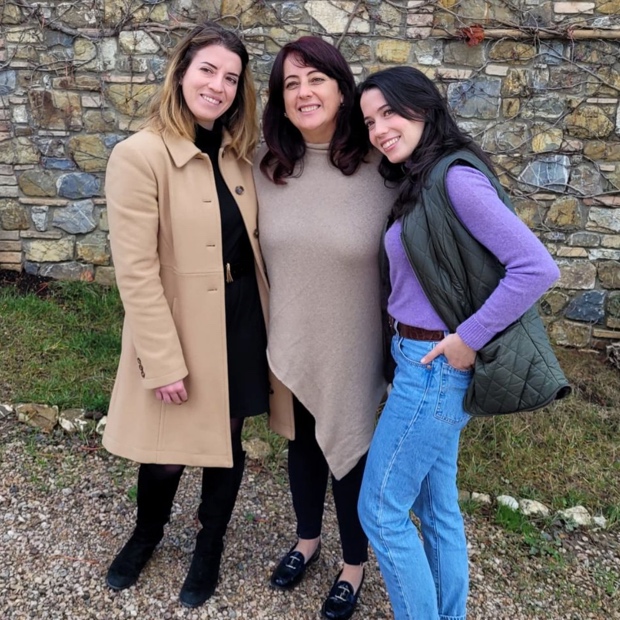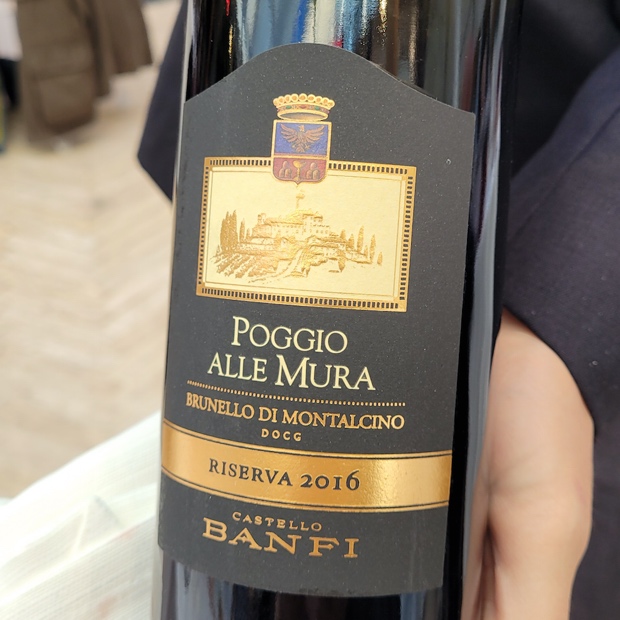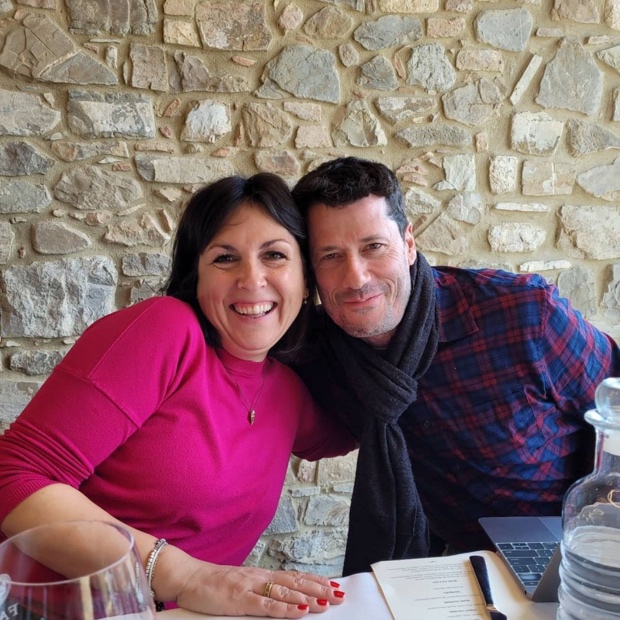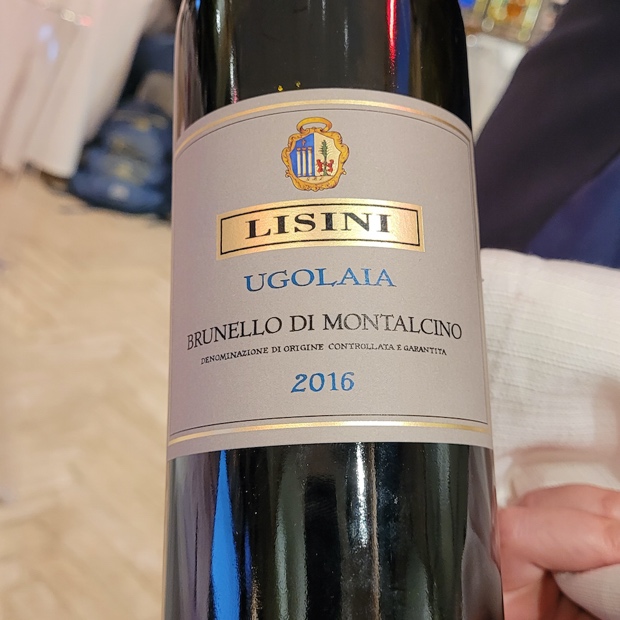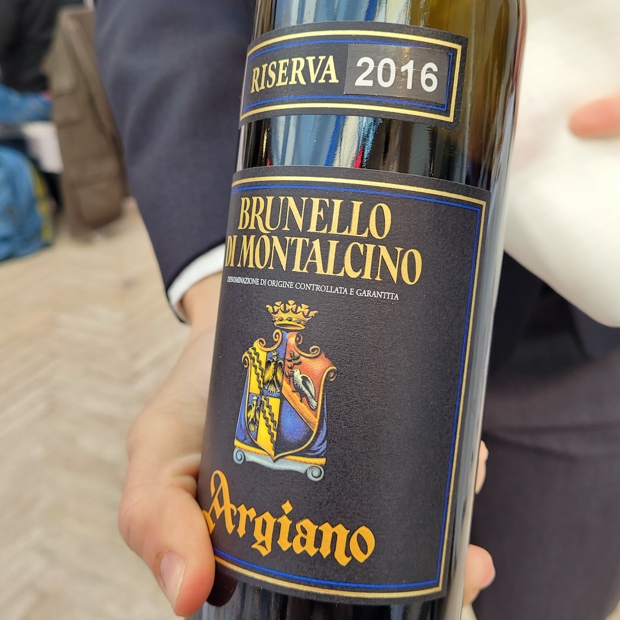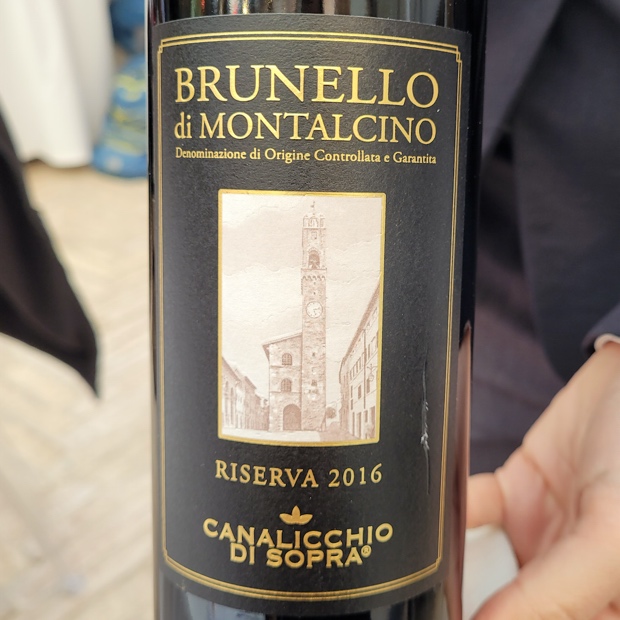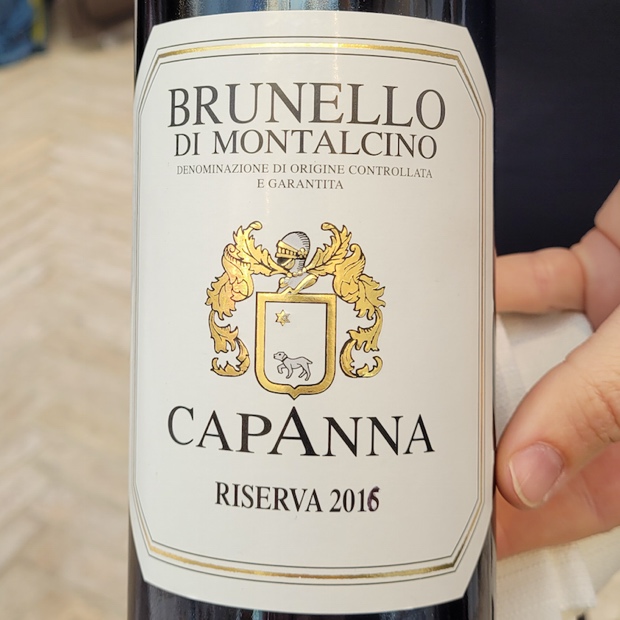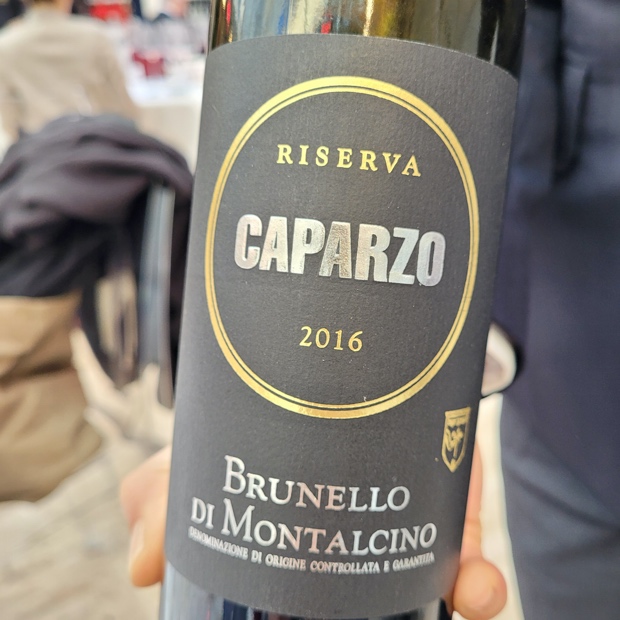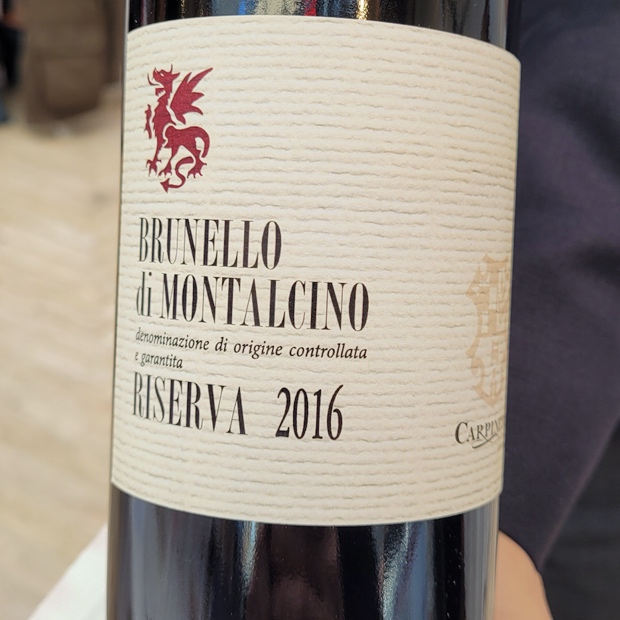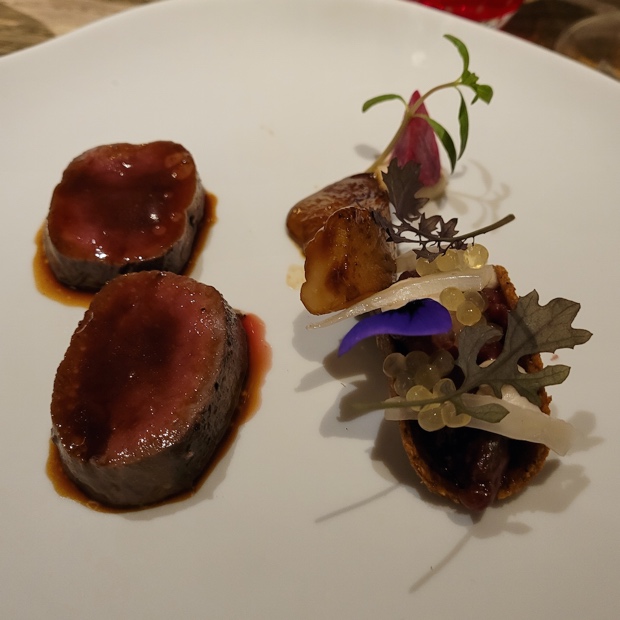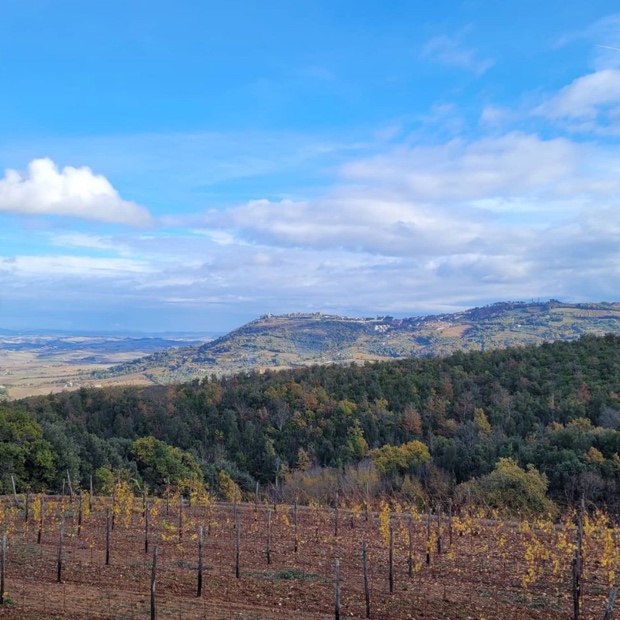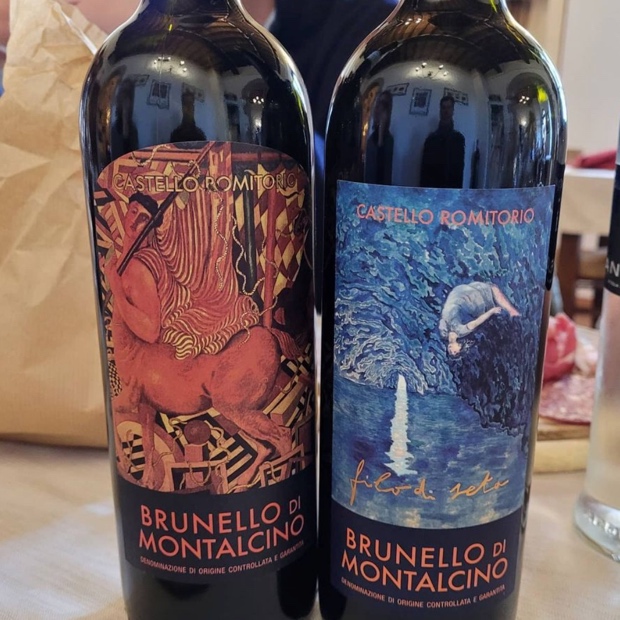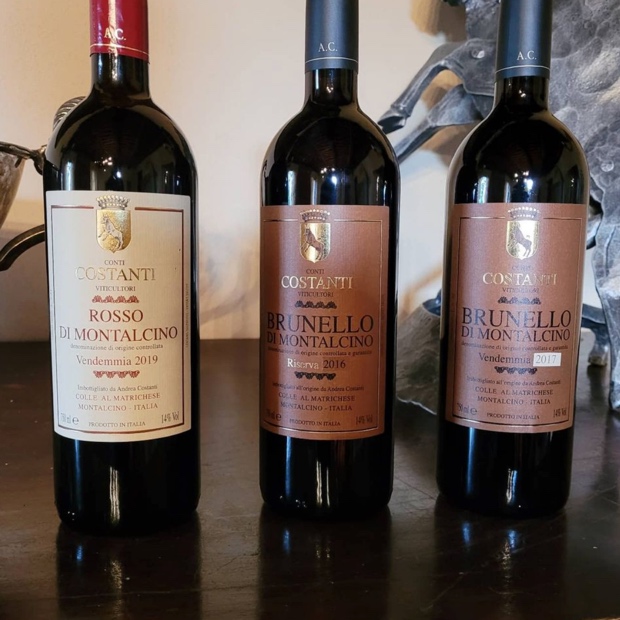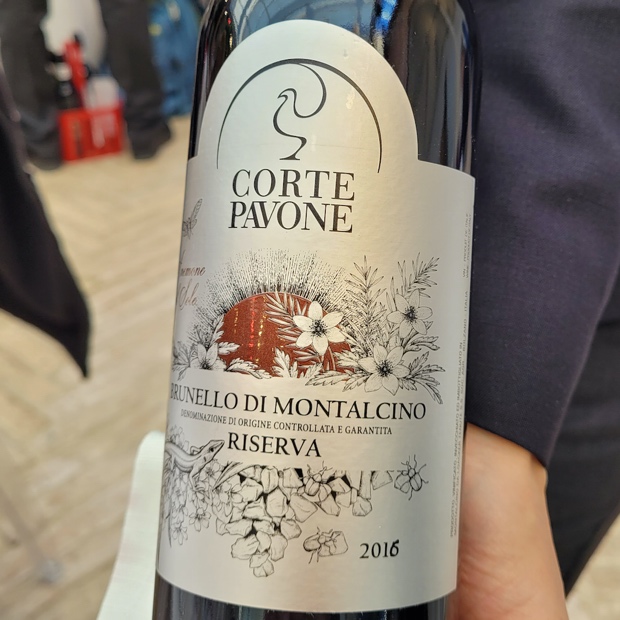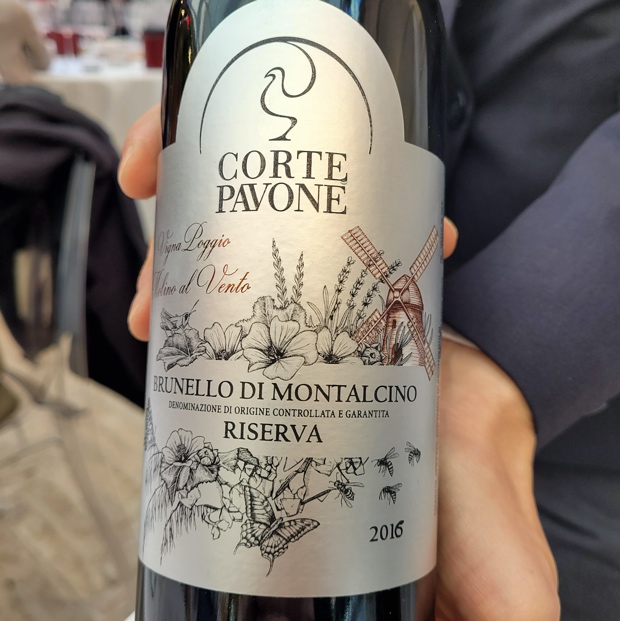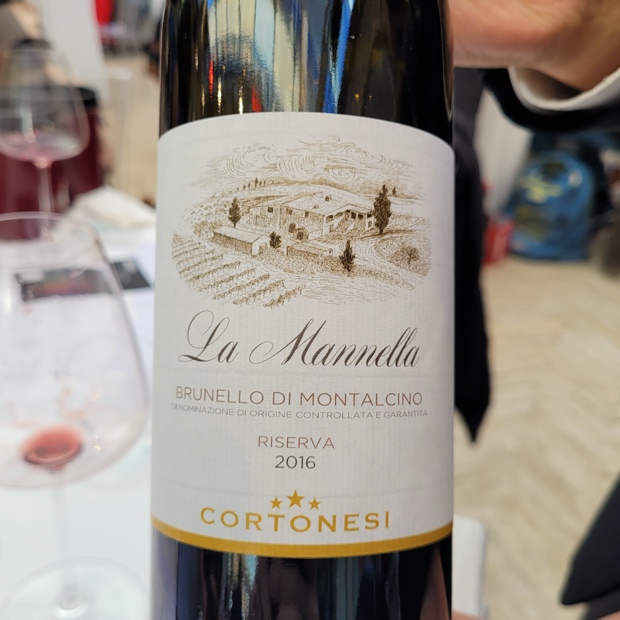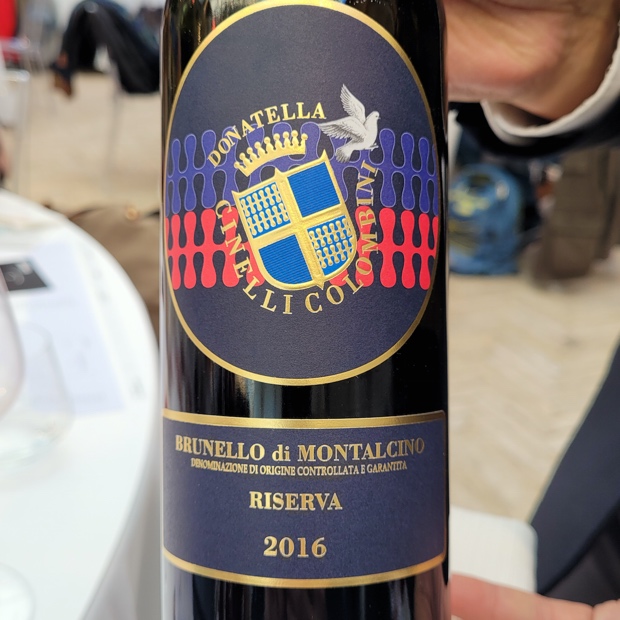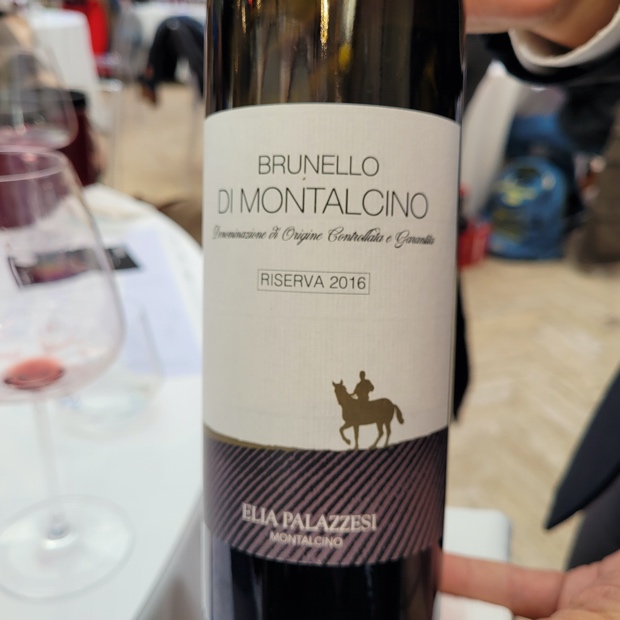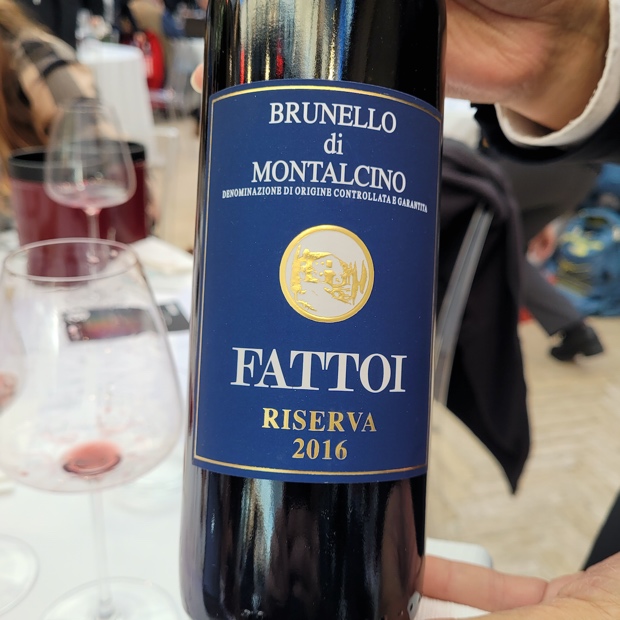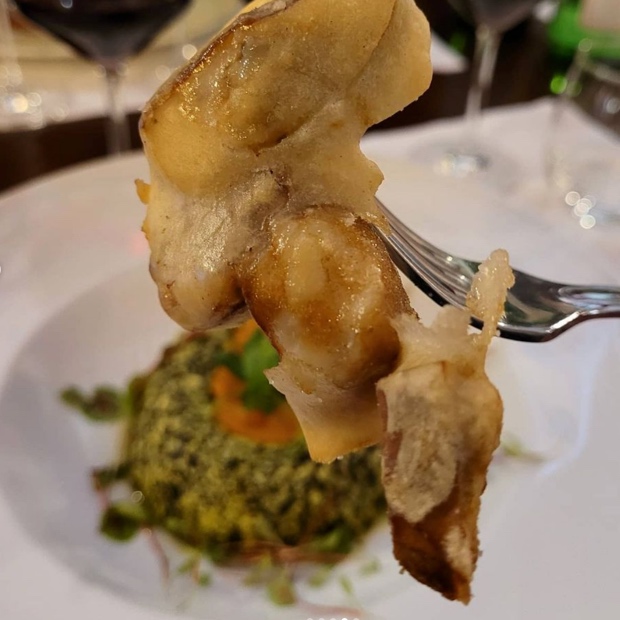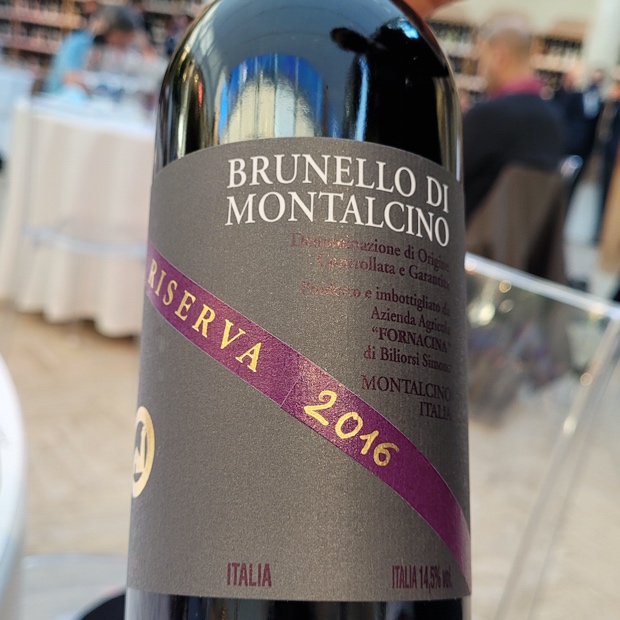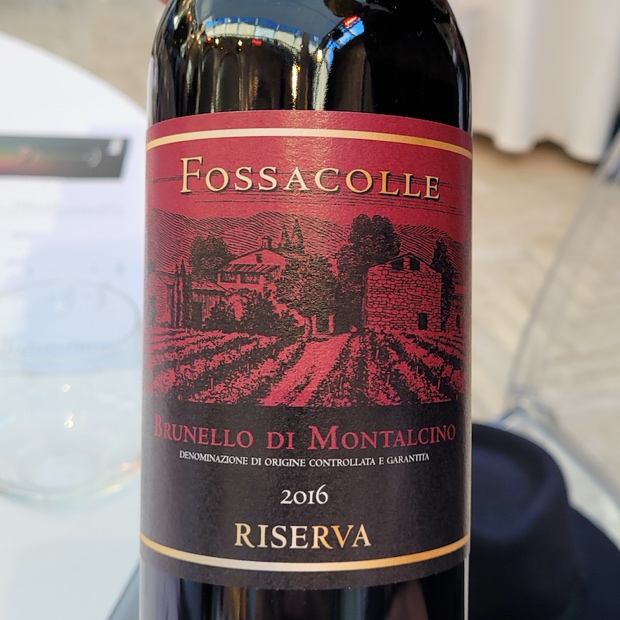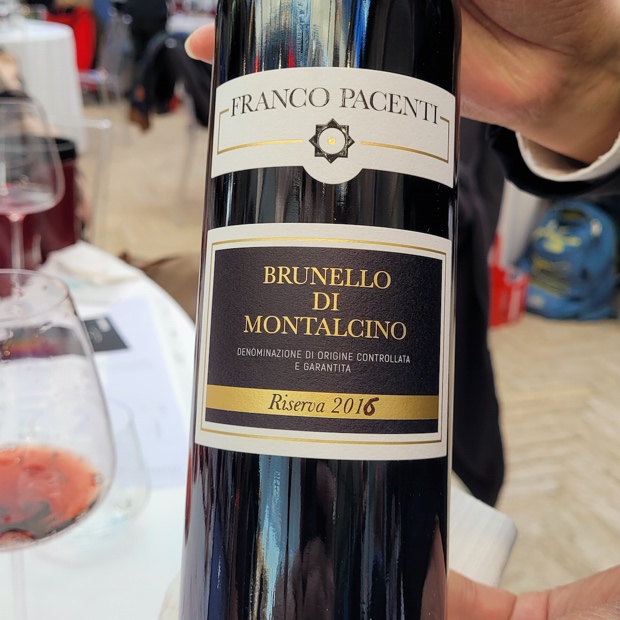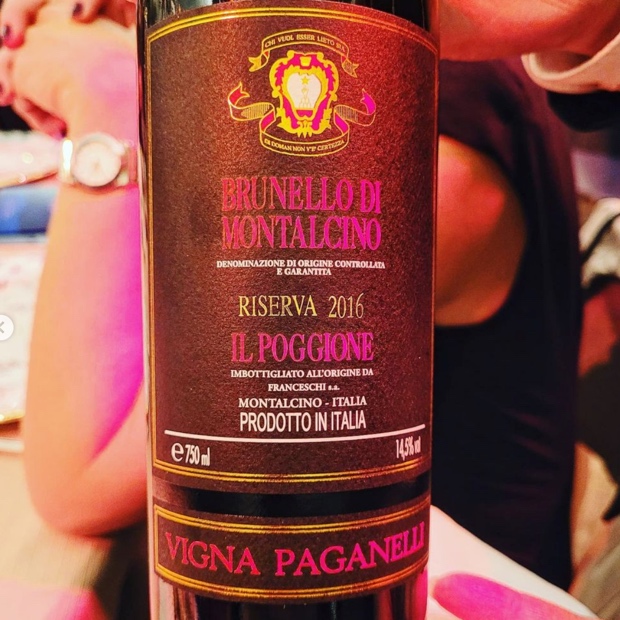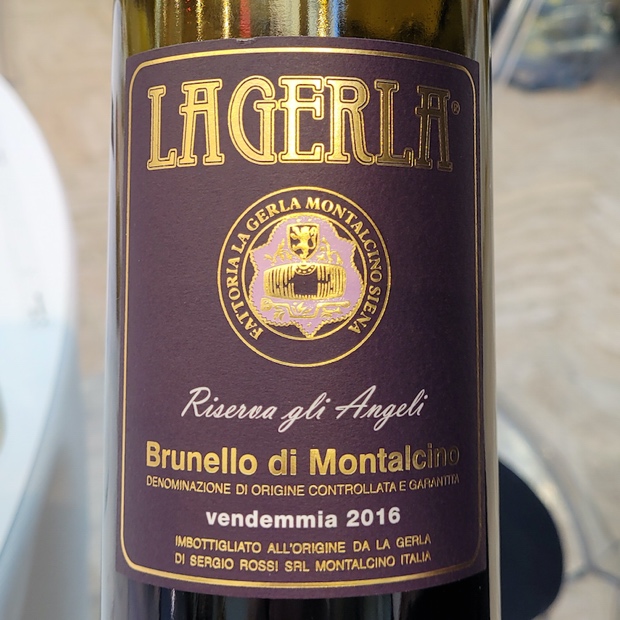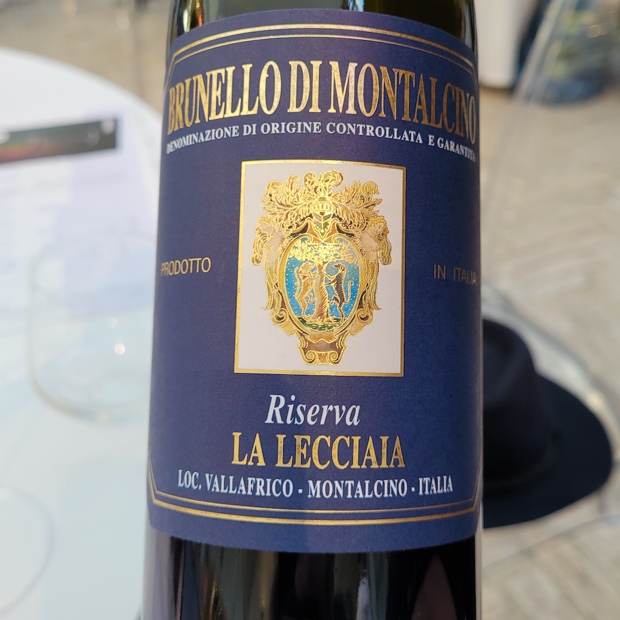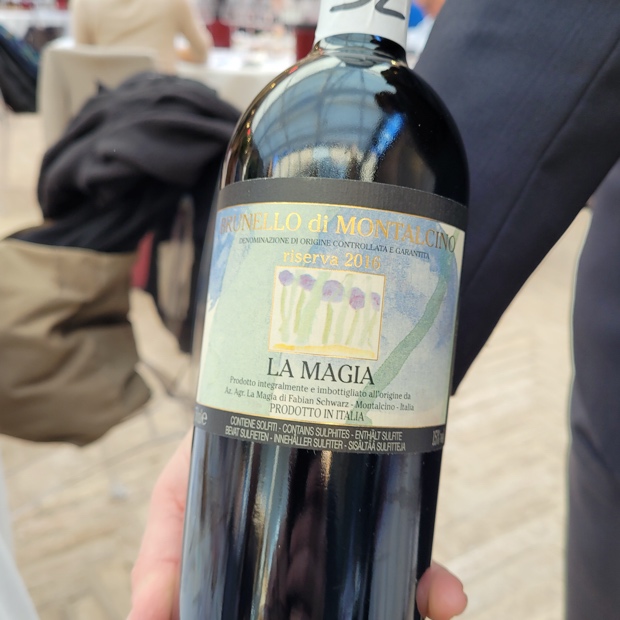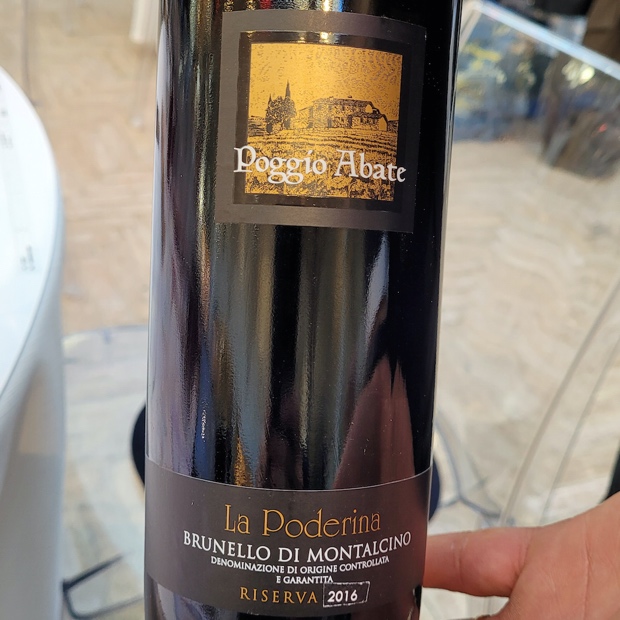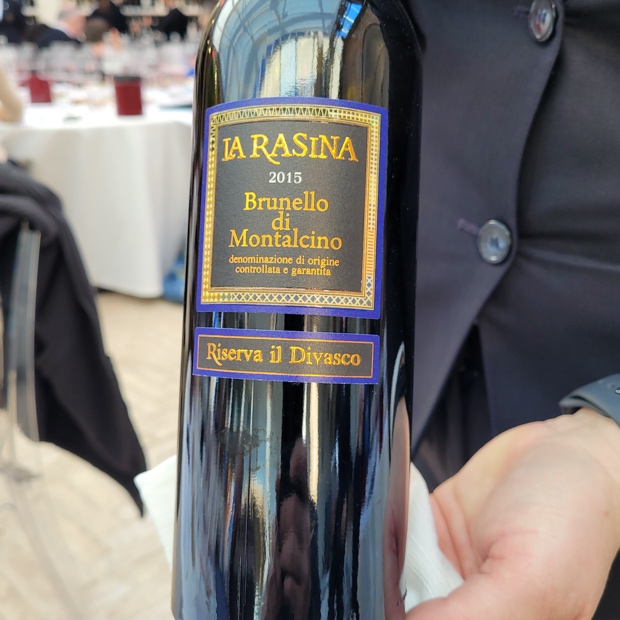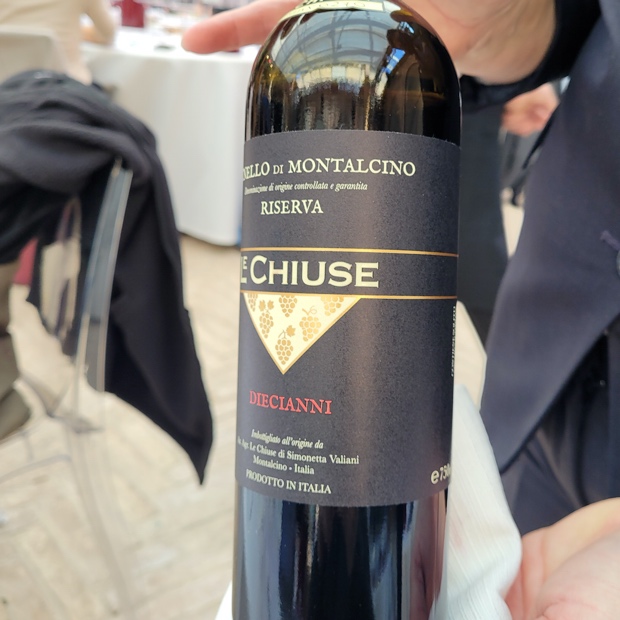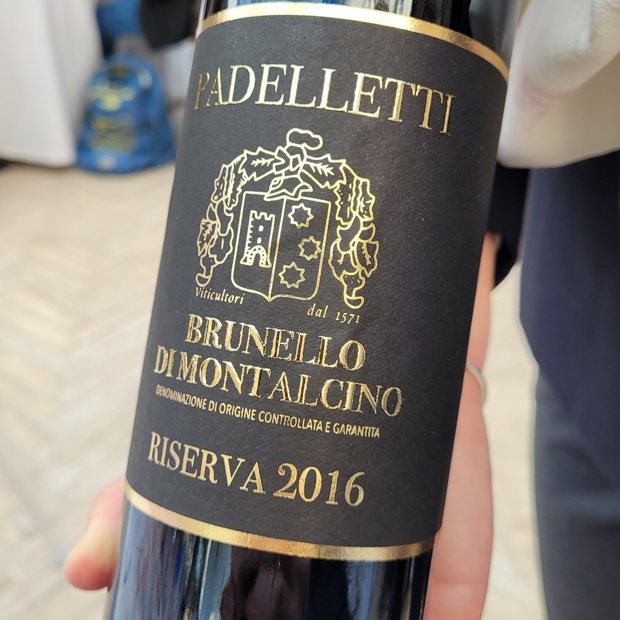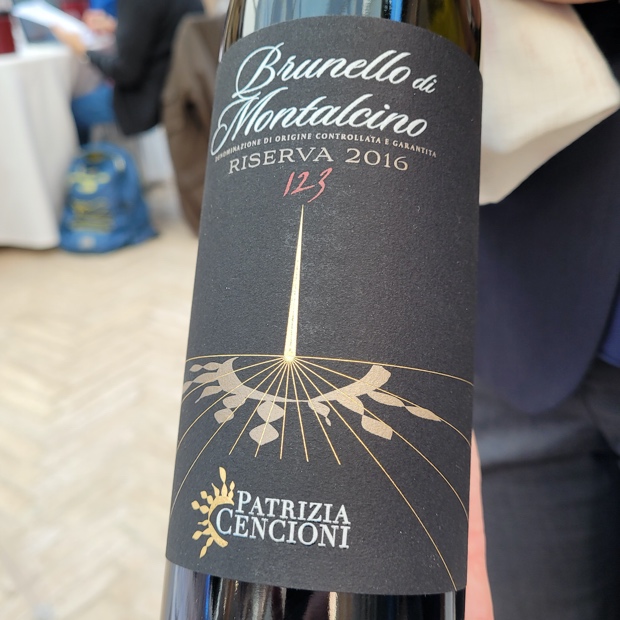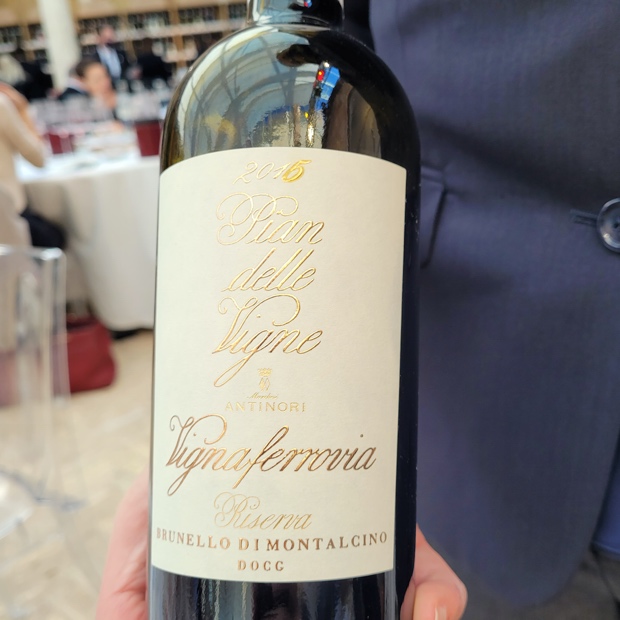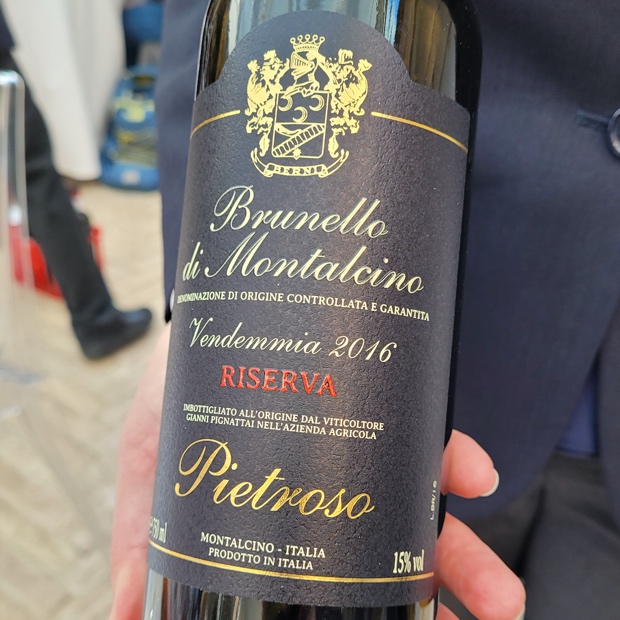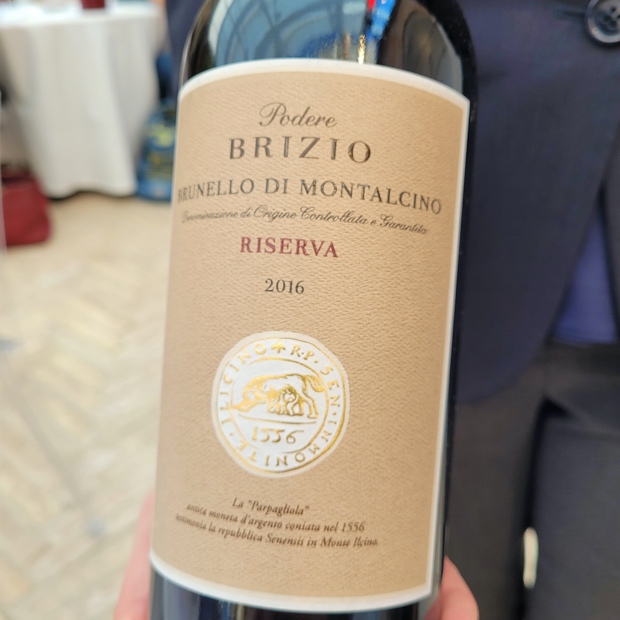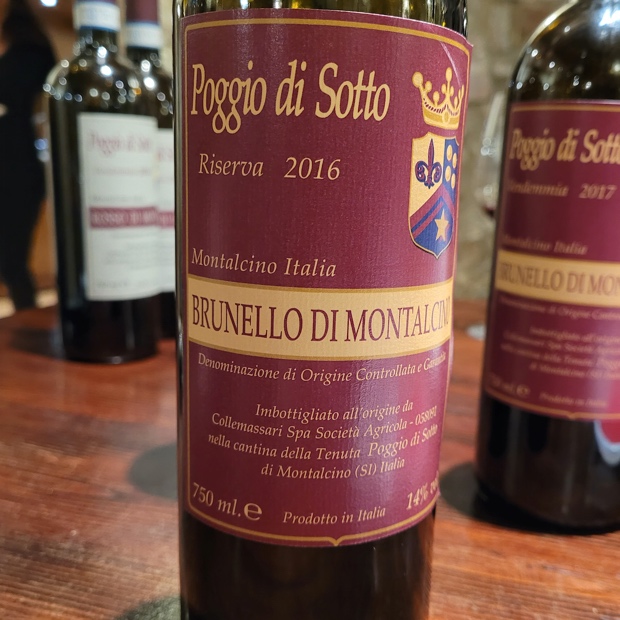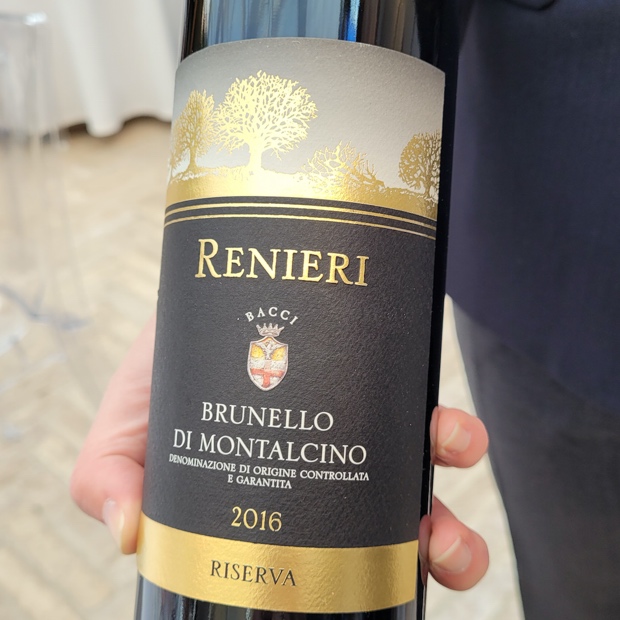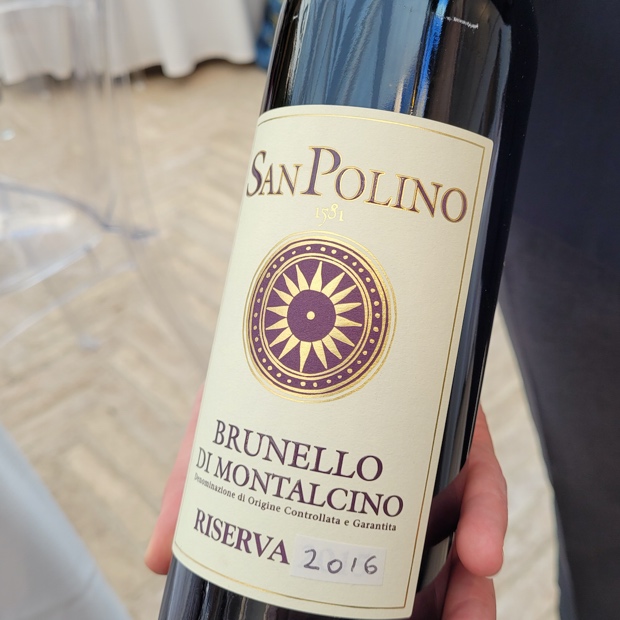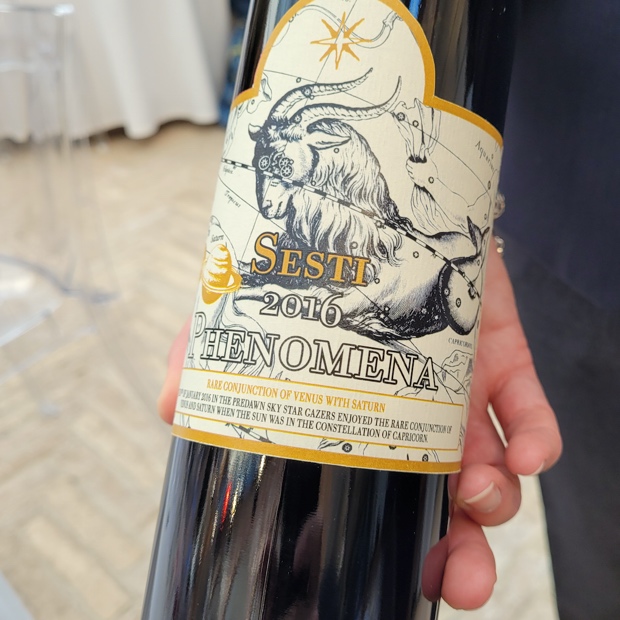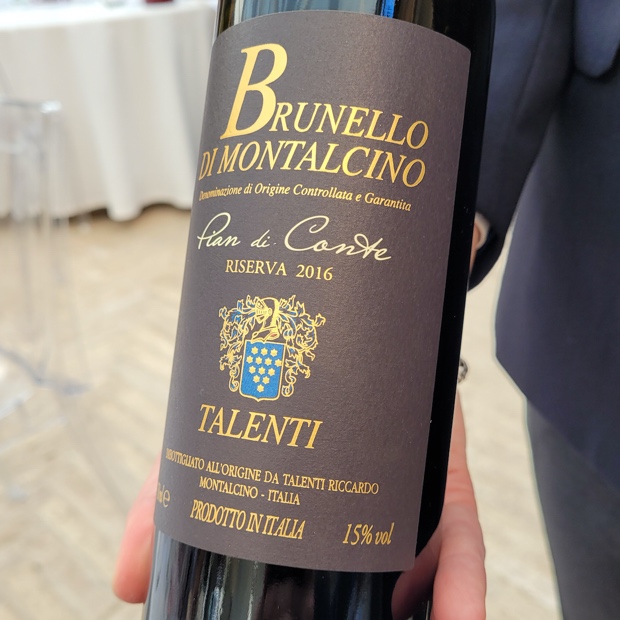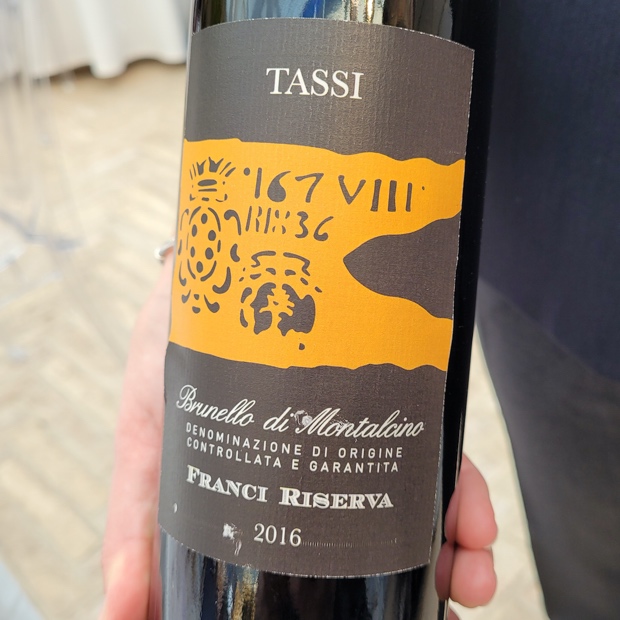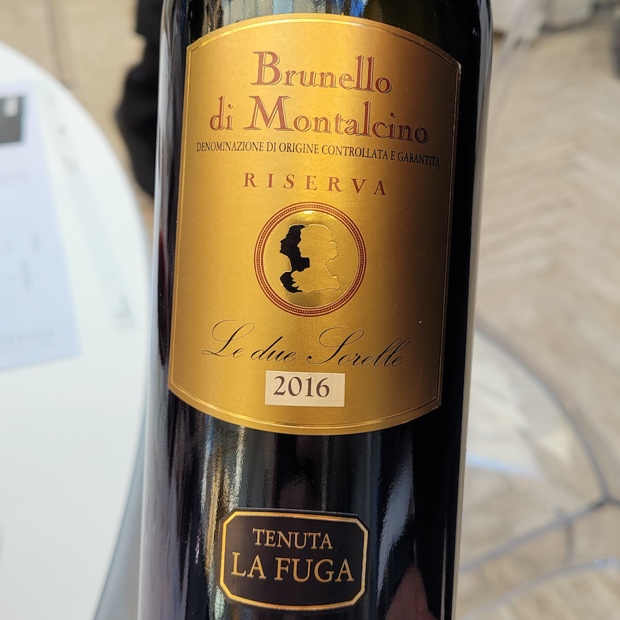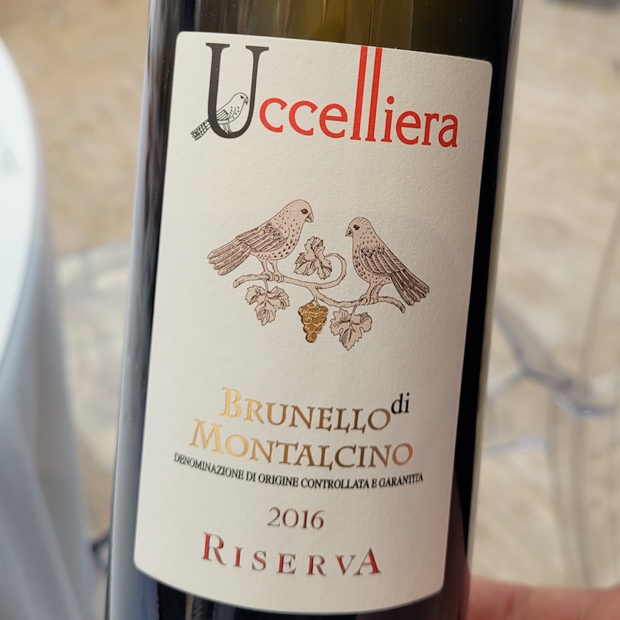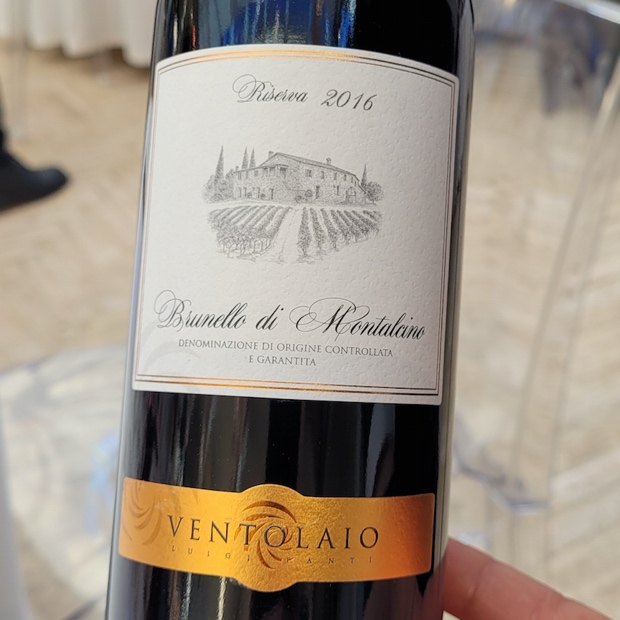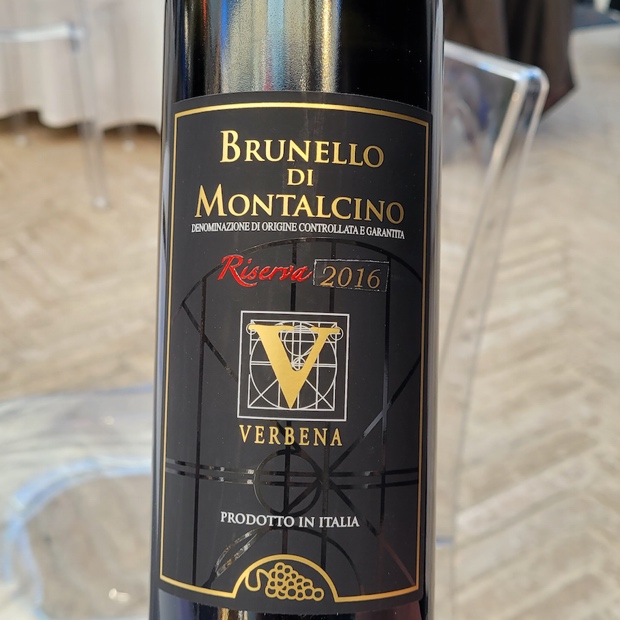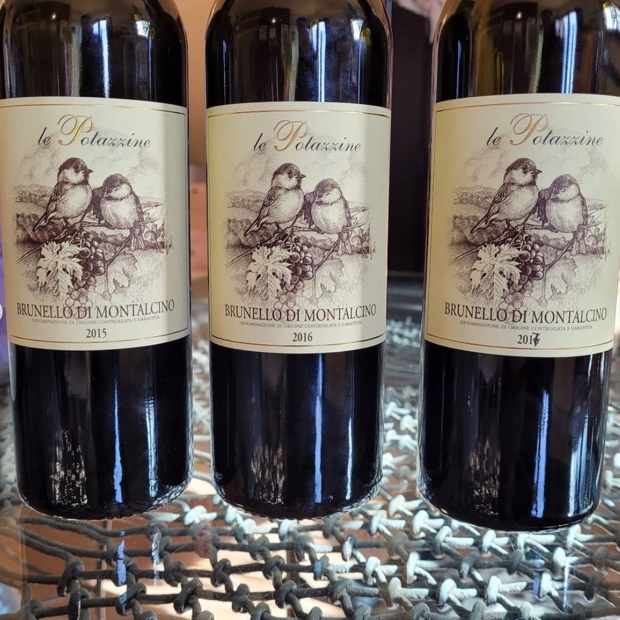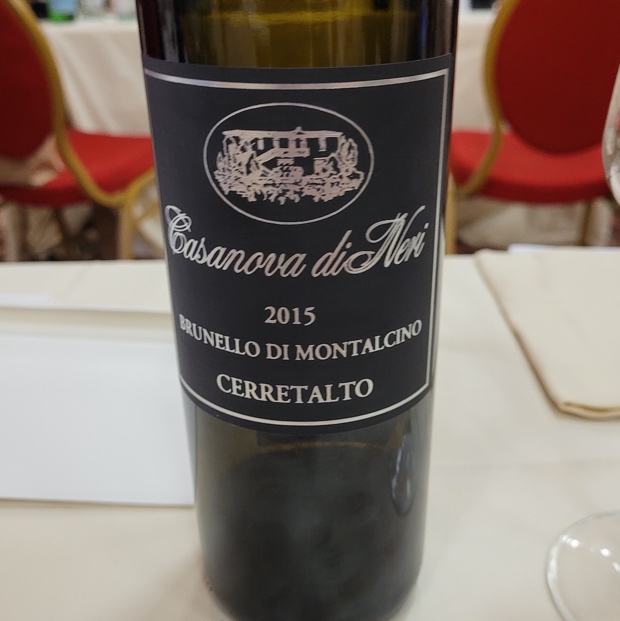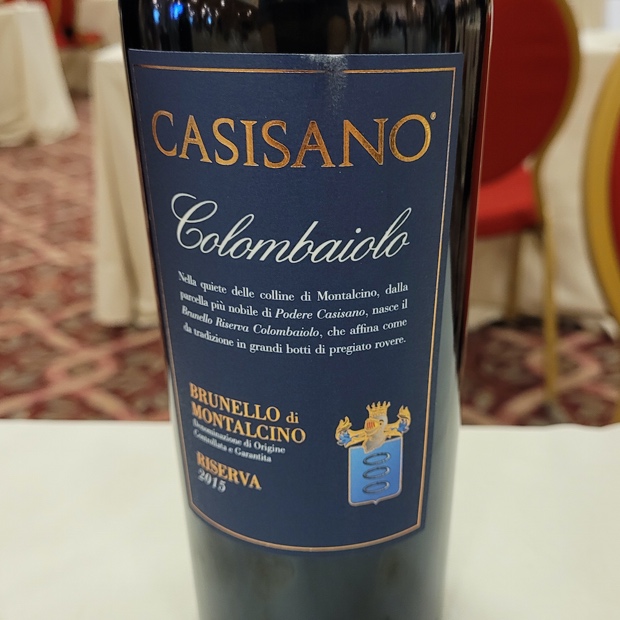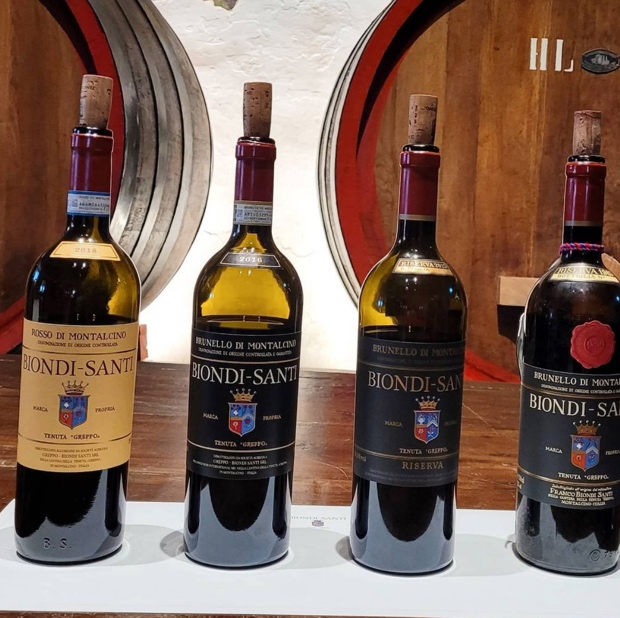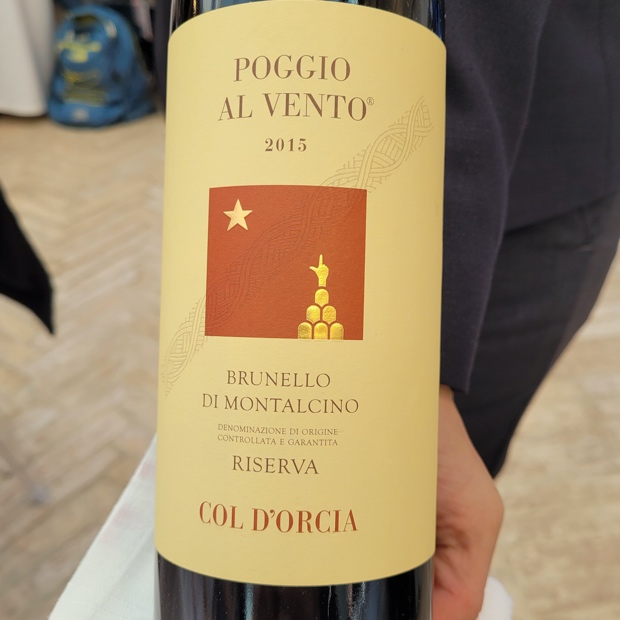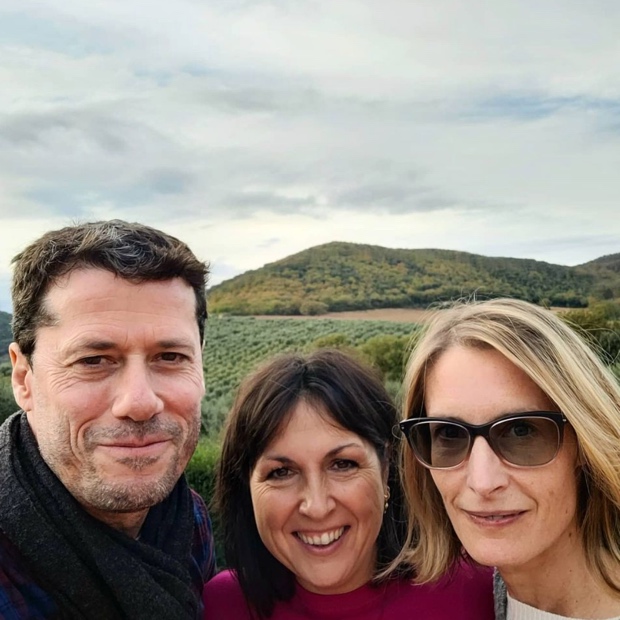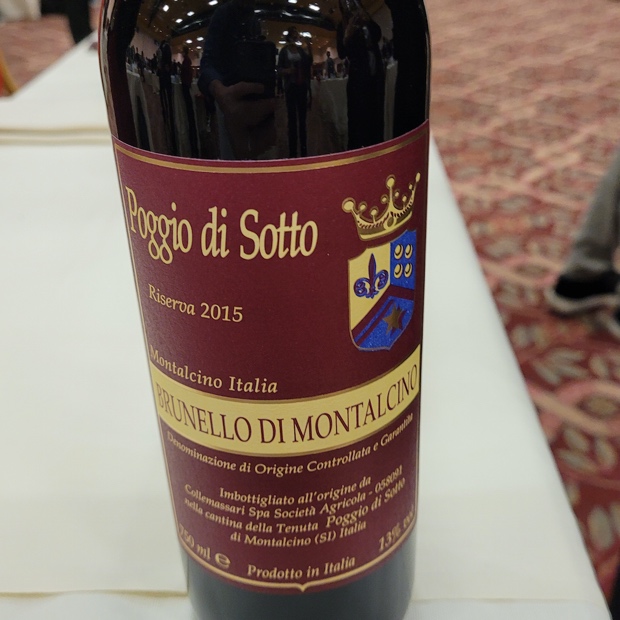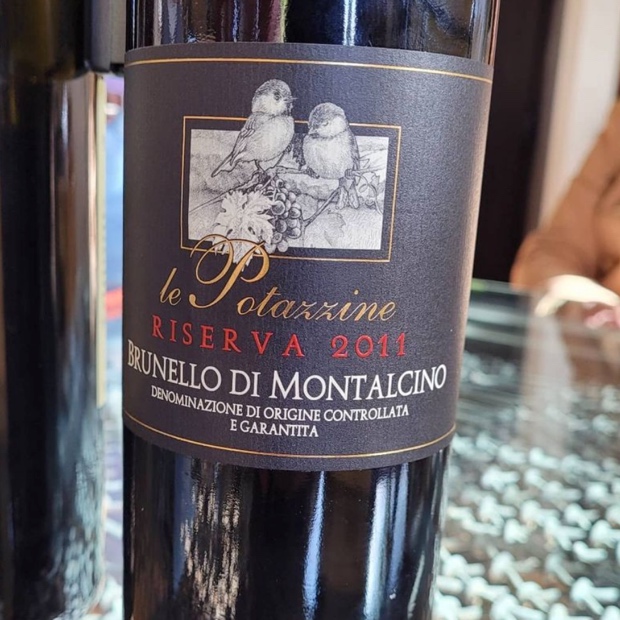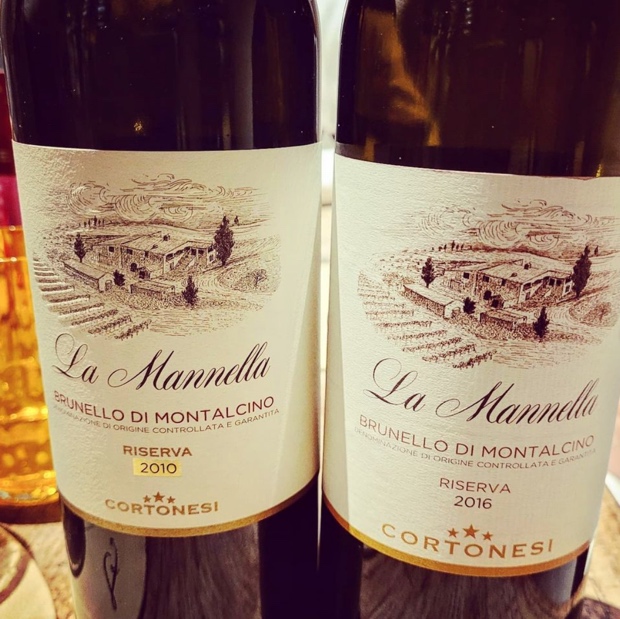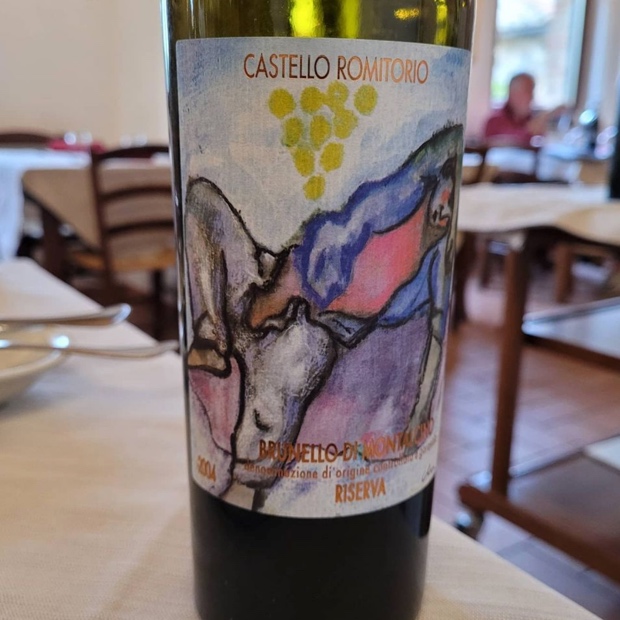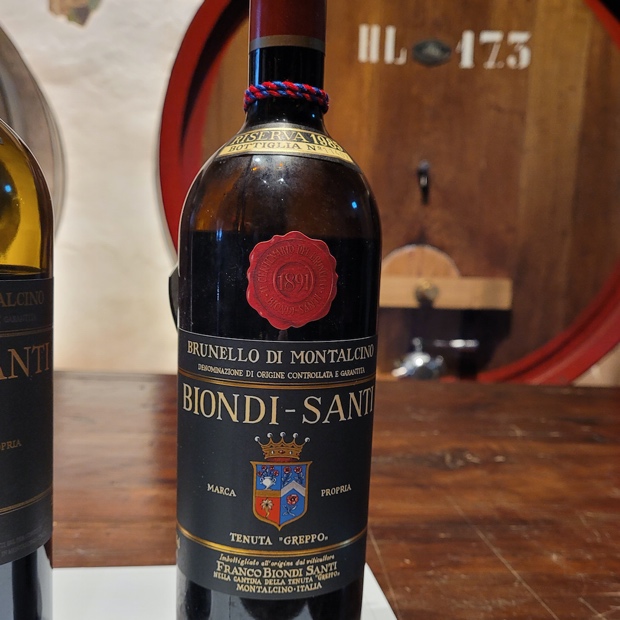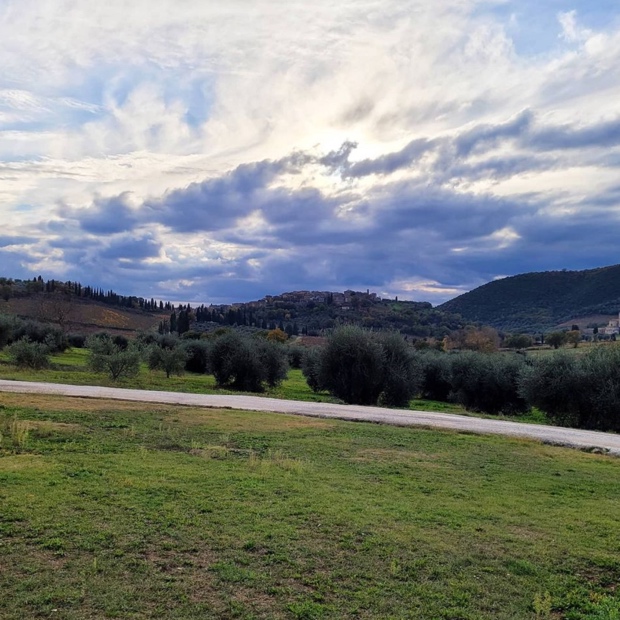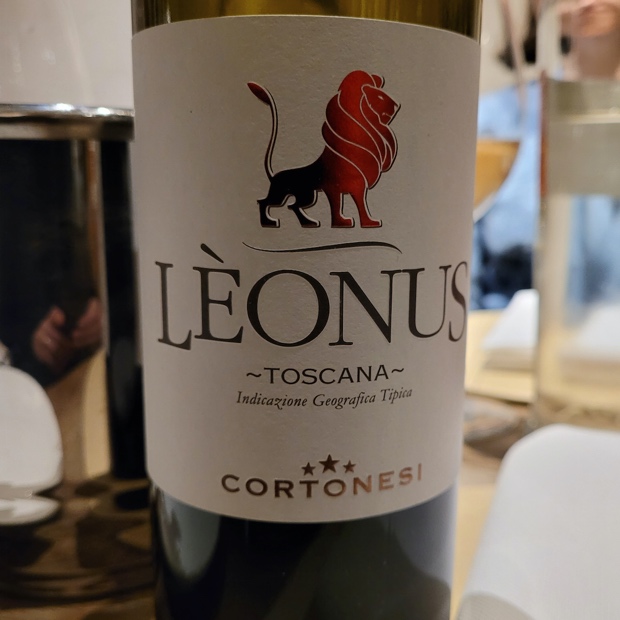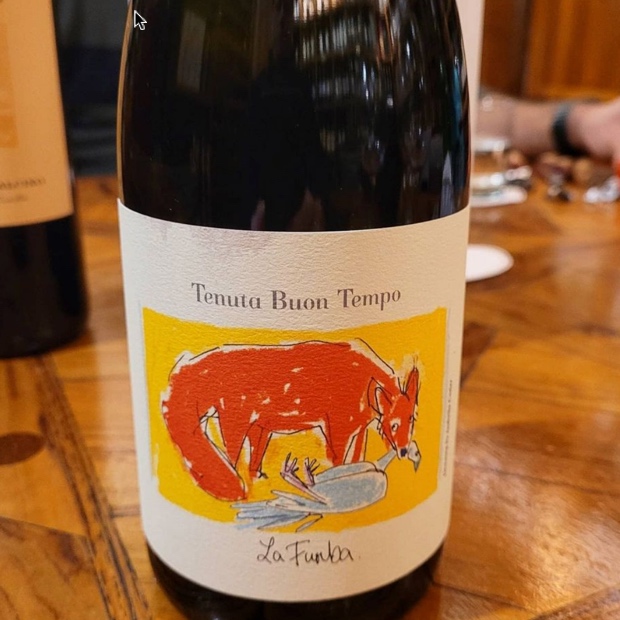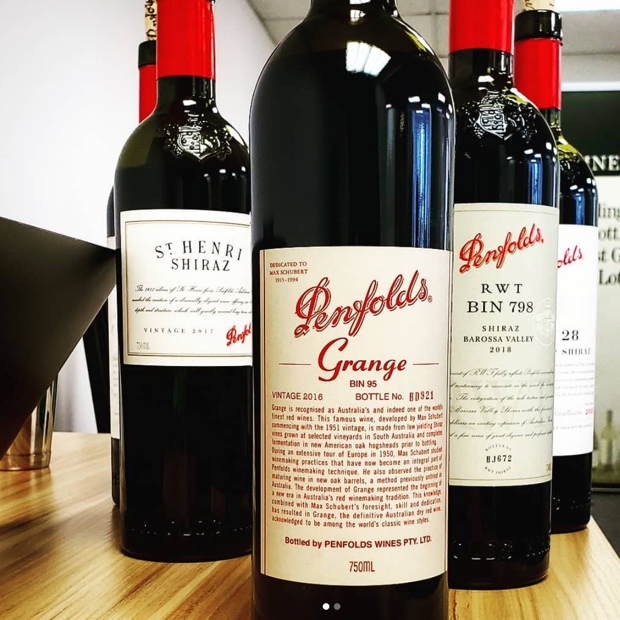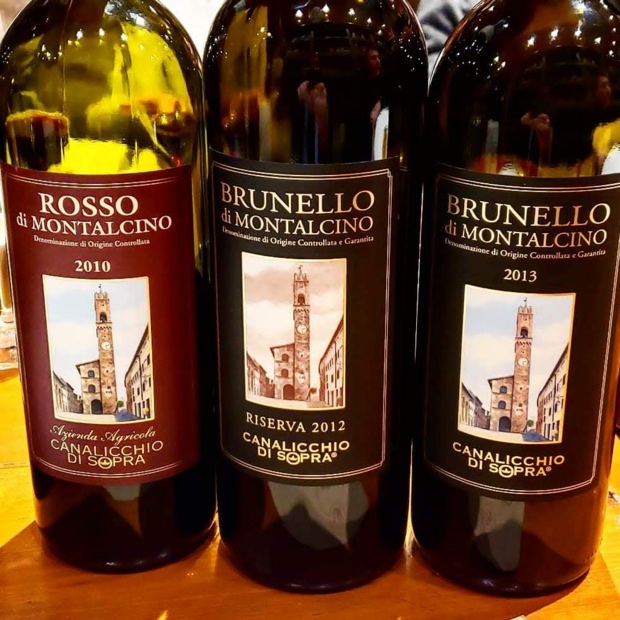
Gallo Nero at the Chianti Classico Collection 2022, Stazione Leopolda, Firenze
An ambassador’s return, Chianti Classico Collection 2022, 4 LCBO videos, 11 UGAs, 37 estate visits and 450 tasting notes
The story of two hats
The last pre-pandemic supper in Panzano takes place in the Officina della Bistecca at Dario Cecchini’s Antica Macelleria Restaurant on the 19th of February, 2020. Little could any one of the revelers that night have any inclination what lay ahead. Who could foresee less than a week later there would be a Casablanca-esque slipping out of Faenza in the middle of the night, heading to Firenze for a flight out of Italy before first light. A funny thing happens in between. Tutti Matti Chef Alida Solomon from Toronto is already feasting at the long Bistecca harvest table when the party Canadese arrives. A wonderful surprise save for the fact that Tuscany is actually her home. That night the writer surreptitiously leave his Sienese cappella in the officina and the next day no one at Cecchini is able locate it. Hat vanishing act. On route to Montalcino a necessary stop is made in Siena, specifically the Piazza del Campo, for a Spritz and the purchase of a new hat. Borsalino is closed so Cappelleria Bertacchi is the next best option and a brand new, similarly styled hat is procured. The following day, while sitting upstairs tasting Brunello on the terrazza of Caffè La Fortezza in Montalcino who walks in but Solomon, tosses up the aforementioned and abandoned hat, nothing is spoken and away Chef goes. This is the story of being the owner of two hats.

Tasting with Michaela Morris at Il Consorzio Vino Chianti Classico, March 2022
A prodigal ambasciatore‘s return
This may be considered an inflated way to refer to one’s self in the third person but truth is that third person recounts with the fondest of memories 10 pre-pandemic Tuscan excursions in four years before the world shuts down to travel. The restart launches in October 2021 with the first of four more over the course of six ’21-’22 abridging months. There are extroverts and introverts but there are also ambiverts, those who exhibit tendencies in roughly equal proportions. Some are in the middle or on the fence when it comes to Chianti Classico wines. If one is to refer to oneself as a proud ambassador for said wines then there must be synergistic feelings of belonging. There will be connectivity with the wines, territory and a most profound connection with the people. In October of 2021 a rebirth takes place in the guise of travel renascence, a re-entry for the first time in 20 months made available by the most erudite, generous and hospitable folks at Gambero Rosso. An ambassador who sits not on a fence has zero trepidation in making a decision to fly first to Firenze for three days of arranged visits in the Classico zone to precede the Tre Bicchieri’s festivities in Rome. When a month later a special edition of Benvenuto Brunello is organized it makes super sense to follow that up with three more days of visits in the territory shared by Firenze and Siena. To see great Consorzio friends and colleagues again restores faith in this world. Car rides, lunches, dinners, tank, barrel, latest release and archived tastings, caffès and chats in the sun. Grazie tantissimo to Giovanni Manetti, Carlotta Gori, Silvia Fiorentini, Christine Lechner and Caterina Mori, as always, sempre e per sempre.
Related – Chianti Classico goes to eleven

Chianti Classico Education in Toronto
The UGA designation, LCBO videos and continuing Chianti Classico education
In June of 2021 the Consorzio Vino Chianti Classico announces the shift to 11 additional units of geographical designation to carve out new parameters and progressiveness for the territory. These Ùnita Geografiche Aggiuntive allow producers to make mention on labels of Gran Selezione wines. A first step towards full disclosure across all Chianti Classico wine labels in the future. This information comes to the writer on the heels of keeping busy during lockdowns and pandemic restrictions that sees the proliferation of tastings and education via platforms like Zoom. Connecting producers with sommeliers and prospective agents is key to continuity and Godello obliges whenever the call to duty arrives. The return in person late in 2021 and through the first four months of 2022 sees restaurant education sessions reach dozens upon dozens of sommeliers, front of house and back of house staff, denizens of Toronto’s restaurant industry eager to resume their absorption of wine information, especially as it pertains to tasting sangiovese. The filming of four educational videos for the LCBO is particularly gratifying, capped by a win of an LCBO Elsie Award for said videos. In three weeks time the producers will arrive in Toronto to participate in the WineAlign critic and Ambasciatore‘s Masterclass. They will also pour their wines at both trade and consumer walk-around tastings. The Toronto Island Chianti Classico Cup happens on Tuesday, May 31, 2022 and “Experience the Wine, Olive Oil & Food of Chianti Classico,” Monday, May 30, 2022 at The Globe and Mail Centre.” Click on the link for more information. Forever in Chianti Classico, even while at home.

Filming Chianti Classico videos for the LCBO, at Praise Bottle Shop, Toronto
End of season reaction to the April frost of 2021
For Luca Martini di Cigala of San Giusto a Rentannano the first vintage when he realized something was not right was 1998, when the skin of the berries were burned by the sun. Climate change, events and extremes are not something that just popper up in the past few years.
Paolo de Marchi does not so much look at yields before high density but rather yields that are a quotient of each square metre as a function of bunches per plant. In a frost year like 2021 Guyot produces more fruit from secondary buds. Paolo makes use of a selection of clones but more importantly a massal vineyard. “This is how you get rid of vines that are not good and replicate those that are. Bud break is often so early and we will never escape the frost anymore. The real problem starts with earlier winter and Spring.”

UGA in reverse, Chianti Classico Collection 2022, Stazione Leopolda, Firenze
At Casa Emma Paolo Paffi admits to a 35 per cent loss in 2021 due to the April frosts, a vintage when even problems occurred even in the higher reaches. “You would have to go back to 1995 to find another vintage where this happened,” tells Paffi. At Villa Le Corti Principe Duccio Corisini and Oenologist Claudio Giglioni noted that in 2021 the single vineyard Guliae, nicknamed the Figo, produced seven tonnes per hectare. It remained safe from the frost, perhaps because of biodynamics, perhaps because of Guyot training, perhaps because of position. Maybe all three but regardless it was not caught in the April frost zone.
At Il Molino di Grace in Panzano their particular frost zone resulted in a 50 per cent reduction in yields. There was a good quantity of water in the winter, a cool spring, warm and ideal summer, rain in the second half of August. “A perfect situation for quality and quantity,” had the frosts not come. Says Iacopo Morganti, “we need to build artificial lakes.”
Related – When frost strikes, Chianti Classico responds

Chianti Classico Experience in Toronto
Fontodi and Consorzio President Giovanni Manetti owns over 20 hectares of over 40 years. He explains that even if there are 20-30 days separating the picking from start to finish in a vintage there is always a marker, especially with sangiovese. “And with old vines they are not nearly as susceptible to stressors,” says Manetti. “Vigna del Sorbo will succeed even with all of what is mentioned here.” At Bindi Sergardi I Colli is where Alessandra Casini Bindi Sergardi was born and grew up. Built in the 1400s for the family, lower in elevation (350m) as compared to Mocenni (500m), still rich in Alberese but also high in iron content across the road in the Chianti Colli Senesi. Some frost kill but not significant enough to mention. For Angela Fronti of Istine, “this year 20-25 per cent less, part frost and part cinghiale, qualcosa nell-aia.” Something in the yard.

Alone with Chianti Classico Sangiovese, rooftop terrace, Hotel Plaza Lucchesi, Firenze
Roberto Bianchi of Val delle Corti: “It’s been a difficult year and we’re very lucky to be in Radda. We did not fear the frost. Most Radda producers escaped loss due to frost but the animals are another matter all together. Drought pushes the animals (wild boar, deer the size of cows), out of the forest and grapes are there biggest resource recourse.” Bianchi is still looking higher and a few years ago planted Malpensa Vineyard upwards of 650m. As did Fedecrica Mascheroni of Volpaia. Their new vineyard is planted at 650m, using five clones of sangiovese from Il Puro with two chosen for planting as half of the small (one hectare vineyard) and also malvasia and trebbiano for Vinsanto. It was finished in the Spring of 2021.

Educating the LCBO Buyers, February 2022
What about Canaiolo?
“Canaiolo is an underestimated variety,” insists Isole e Olena’s Paolo de Marchi. “It ripened so early this (2021) season and was picked before the chardonnay. It just may be the future” While that may sound like sacrilege in a land where sangiovese is the (literal) life blood of the wines, de Marchi is not the only one focusing extra energy on the endemic variety. L’Erta di Radda’s Diego Finocchi sees canaiolo as essential to blending into sangiovese because of its higher level of pH, a catalyst for balancing not only the high acidity of sangiovese but also helping to temper and even hide alcohol in warm and dry vintages. Both Robin Mugnaini and Claudio Gozzi of Fattoria le Masse would surety agree. Their Timeo is a 100 per cent canaiolo from 60 year-old vines (planted in 1961), picked in late September but before the hottest final days. A wine that is truly a matter of pH waving over the palate.

Learning with Paolo de Marchi, Isole e Olena, San Donato in Poggio
Angela Fronti of Istine in Radda has planted some canaiolo and malvasia nera, the latter replacing cabernet to return to roots and grow what is meant for this part of the territory. Salt and pepper if you will also to have more diversity going forward into the ever-changing climate change unknown. Canaiolo is more vigorous and so can add some good balance, both more quantity and for freshness in warmer vintages. At San Giusto a Rentennano 15 of 30 hectares are on tufo soil, not exactly volcanic but the left over from a receding ocean that left a mix of sand and pebbles of six or so inches over a bank of clay. This plus many large fossil shells makes for sangiovese of medium hue, specific mineral saltiness and a very specific Chianti Classico profile. Canaiolo is not a factor here.

Estate Vineyard, Monte Bernardi, Panzano
Old is the new agriculture?
There was a profound and at time controversial but always enlightening discussion with Monte Bernardi’s Michael Schmelzer. Michael talked of green harvest, rootstocks, Pietraforte, whole bunch fermentation and instincts. Standing in his Retromarcia Vineyard on a cool but perfectly blue mid-November day I asked him about climate change and what needs to be done about it. Can’t say his answers were what I expected. He began with the concept of dropping fruit. “We haven’t dropped since 2007. We have to think like the old farmers thought. The new way was to have you reduce fruit to make better wine. It’s like losing nutrients in the ground. I look at the wine bunches as on a scale, they’re not unripe, they’re just less ripe. They help me come up to 55 quintali per hectare. I still get acidity and sapidity. For me the concept should be re-examined and re-thought. I look at everything as an asset. You should be using your fruit. What other industry drops 30 per cent of their produce? We should be seeing 30-35 year-old vineyards going to 50-55 years. Overall we’ve lost more than we have gained.”

New Fontodi vineyard, Lamole
Schmelzer continues onto the idea of choosing 110 Richter, instead of the commonly used 420A rootstock, showing how internodes should be the size of a fist and canes as pencil thinness or bigger. “People are compromising because they’ve chosen the wrong rootstocks,” he explains. “Granted we’re picking earlier than before but mid to late September is not extreme. We haven’t seen anything yet.”
“The only thing I don’t like is people telling me how to make my Riserva,” are the words of a winemaker who has seen his fair share of rejection. Perhaps I encourage the minor rant because there are two sides to every story. Maybe it’s the fault (or the advantage, depending on your perspective) of the rocks. “Brenna Quigley (Napa Geologist) came and made a study of all the famous soils of Chianti Classico and Monte Bernardi was identified as the plot with the hardest Pietraforte of all.” Sa’Etta Vineyard was planted in 1968, now 53 years old (similar to both Monte Bernardi and Tzingana) and trained in double (doppio) Guyot. For Castello di Monsanto’s Laura Bianchi the constant posit tug is Guyot vs Sperrone and both exist in a vacuum where necessity is the mother of invention.

Macigno di Marne, Lamole
In terms of stems Schmelzer’s decisions are essentially instinctual, like that of a cook. “I don’t look at numbers. I feel as a winemaker it’s important to free yourself from technicalities and use your instincts. If you follow numbers you will always make a mistake that has to be later corrected.” As for barrel use, “if there is wood in a wine I want it to be so subtle. (Again) thinking like a cook. I’ve more stems, for longer, in post and of course also during maceration. Natural tannins come from the stems in that post-maceration state.” The conclusion lies in how stems are catalysts for the polymerization of tannin, without a trace of humidity. Completely secco.

Wines of Lamole
Nowhere is the “old is the new agriculture” refrain spoken with greater clarity than in the Greve frazione and newly minted UGA of Lamole. The spectacular amphitheatre is home to high elevation vineyards of a particular geology where Macigno del Chianti, schist and marl gift a most specific perfume to the sangiovese. Lamole is home to I Fabbri, Lamole di Lamole, Podere Castellinuzza, Castellinuzza e Piuca, Le Masse Di Lamole and Castello di Lamole. The UGA also houses one of Chianti Classico’s most famous vineyards, Paolo Cocci’s Vigna Grospoli Antico Lamole, from which several producers have rented fruit to make über-Lamole scented wines. Still others are looking to the frazione to expand on their portfolios, including Podere Poggio Scalette (of Jurij Fiore) and Querciabella from the Ruffoli hill in Greve. It is well known that Fontodi’s Giovanni Manetti produces Filetta di Lamole from his cousin’s vineyard but the latest project will take Lamole to an entirely new and different level. Manetti’s new plantation on Macigno di Marne, a wholly singular marine sandstone geology, will be a game changer.

Conzorzio President Giovanni Manetti and Filippo Bartolotta presenting Il Chianti Classico in 9 Decadi at the Chianti Classico Collection 2022, Stazione Leopolda, Firenze
Estate visits, the Chianti Classico Collection and Il Chianti Classico in 9 Decadi
This is the author’s most comprehensive Chianti Classico report to date. Nearly half of the wines chosen to taste were Annata and this is because there were numerous opportunities during estate visits to recall “lost” vintages as a result of the pandemic, along with the newer 2020s and 2019s presented at the collection. In February 2020 the Ambassador Ad Honorem from Canada organizes and acts as chaperone to nine compatriots (plus one favolosa Americana) for five days of exploration throughout the 11 UGAs of the area. Casa Chianti Classico, President Manetti, the Consorzio and the producers host La Squadra Canadese of sommeliers; John Szabo MS, Nadia Fournier, Scott Zebarth, Kristi Linneboe, Joris Garcia, Caroline Beaulieu, Hannah Egan-Lee, Natalie Pope and Paige McIntyre. A memorable trip. A month later on day two of the Chianti Classico Collection a masterclass is presented by Italian wine expert Filippo Bartolotta and Consorzio President Giovanni Manetti titled Il Chianti Classico in 9 Decadi. Chianti Classico wines dating back to 1949 are poured during a most fascinating presentation and study, replete with historical images on screen depicting political, religious, cinematic, pop cultural, artistic and iconic scenes of Italian heritage, civilization and society. There are moments of white grapes mixing with their counterpart reds, old wines gifting scents and textures as if by Vin Santo and others so clearly a product of when they were made. That the wines show incredibly well owes to the longevity of sangiovese and its perseverance in the poise of Chianti Classico. More on this tasting will be shared through a separate article in the coming days.
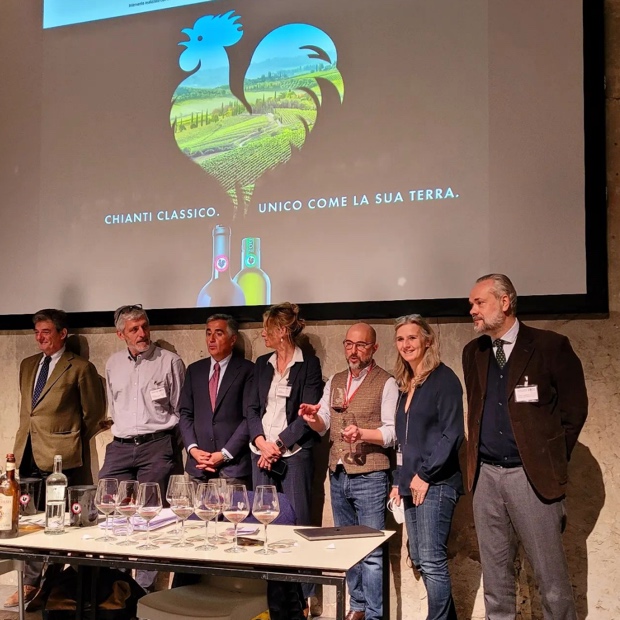
The producers with Filippo Bartolotta and Il Chianti Classico in 9 Decadi at the Chianti Classico Collection 2022, Stazione Leopolda, Firenze
Over the course of the four trips to the region in October, November, February and March, 34 estates are visited; Bindi Sergardi, Cantalici, Casa Emma, Carpineta Fontalpino, Castell’In Villa, Castello di Monsanto, Castello di Radda, Castello di Volpaia, Cigliano di Sopra, Fattoria dell’Aiola, Fattoria Le Masse, Fattoria di Pomona, Fattoria San Giusto A Rentennano, Fontodi, I Fabbri, Il Molino di Grace, Il Palagio di Panzano, Isole e Olena, Istine, La Sala, Le Fonti di Panzano, L’Erta di Radda, Monte Bernardi, Montecalvi, Podere Capaccia, Quercia al Poggio, Querciabella, Rocca delle Macìe, Rocca di Montegrossi, San Felice, Tenuta di Carleone, Val delle Corti, Villa Calcinaia – Conti Capponi and Villa Le Corti – Principe Corsini. During the coming weeks further reports in greater detail will appear on Godello concerning several of these visits.

Walk-around tasting at the Chianti Classico Collection 2022, Stazione Leopolda, Firenze
Over two days at the 2022 Chianti Classico Collection more than 650 different wines from 180 gallo nero estates are made available to journalists and trade; 364 Annata, 161 Riserva and 125 Gran Selezione, along with 39 barrel samples from the 2021 vintage. Sales of Chianti Classico wines continue on an upwards steady trend. In 2021 the growth is plus-21 per cent versus 2020 and plus-11 relative to 2019. Through February of 2022 the increase is plus-seven per cent over the same time period of 2021. Grape prices are up 20 per cent, the United States holds strong at 33 per cent sales while Canada sits in third place with their 10 per cent share. A prediction towards 11 per cent by the end of 2022 holds strong. The great emergence is South Korea where sales have doubled and quadrupled relative to 2020 and 2021. Not surprising Seoul-based journalist Jung Yong Cho becomes the latest appointee as Chianti Classico Ambassador for 2022.

Godello in Firenze
The structure of the tasting notes remains consistent in terms of running through the three appellative levels but here for the first time each listing includes a mention of the associated UGA. Without attempting to review wines that would result in equal footing there is a good level of equanimity in that all 11 UGAs are well documented. The following 450 tasting notes are broken down as follows: Castellina (48); Castelnuovo Berardenga (32); Gaiole (59); Greve (30); Lamole (18); Montefioralle (10); Panzano (39); Radda (55); San Casciano (28); San Donato in Poggio (34); Vagliagli (25) and IGTs (72). By appellation the number of reviews are: Chianti Classico (201); Chianti Classico Riserva (113) and Chianti Classico Gran Selezione (59). By vintage the breakdown is Chianti Classico 2020 (46); CC2019 (110); CC2018 (24); Older vintages (20). Chianti Classico Riserva 2019 (15); CCR2018 (45); CCR2017 (10); CCR2016 (10), Older vintages (33). Chianti Classico Gran Selezione 2019 (2); CCGS18 (24); CCGS17 (12); CCGS16 (13); Older vintages (9). Vin Santo del Chianti Classico (7). Finally there are sangiovese from 137 estates reviewed in this report, the largest number covered to date.

Chianti Classico Collection 2022, Stazione Leopolda, Firenze
Chianti Classico DOCG 2020
Arillo In Terrabianca Chianti Classico DOCG Sacello 2020
Radda
Open and fragrant, south Raddese acidity on display, light and breezy with no oak interference whatsoever. Sacello in località Terrabianca is a sangiovese joy to sip, so long as someone else is lifting the heavy bottle and pouring your glass. Drink 2022-2025. Tasted March 2022
Banfi Chianti Classico DOCG 2020
Castellina
Banfi is another semi-closed and reductive 2020, not uncommon for the vintage and also surely caused in part by just how little time the wine has been in bottle. Cherry fruit and the mild bitterness of the pit dominate the aromas (at this early stage) while texture is pectin and glycerin, strawberry smoothie and a few drops of blood orange bitters. Not getting a real sense of location, perhaps herbal like Gaiole and red fruit centric like Castellina though savoury as if by San Casciano. Take your pick. Regardless of vineyard place this is so very sangiovese, acids et al. Drink 2023-2025. Tasted March 2022
Bertinga Chianti Classico DOCG La Porta Di Vertine 2020
Gaiole
Gaiole savour in all its woods and brush comes clear into aromatics and view through this ’19 Annata, almost vividly so. Deep well of varietal fruit, über sangiovese but more so Gaiole. Good and sweet ’19 tannins are plentiful and there is some green astringency as they pass over the palate. Wait a year and then drink for two more after that. Drink 2023-2025. Tasted March 2022

Cacio e Pepe on a perfect February day in Firenze
Bibbiano Chianti Classico DOCG 2020
Castellina
Bibbiano’s is at the forefront of youthfulness in that there is a closed aromatic launch and some reduction needing to blow off before the hounds of charm can be released. Head straight to the palate to be graced with the interspersions of texture and structure, first liquid Castellina chalky, then wound around the body of this wine. Sangiovese needs the bottle and with eyes closed those words of Tommaso Marrocchesi Marzi play in refrain over and over again. Be patient and kind to his wine and in turn you will be kindly rewarded. Drink 2024-2028. Tasted March 2022
Brancaia Chianti Classico DOCG 2020
Radda and Castellina
Brancaia 2020 takes the torch from 2019 in so many ways and then again, not in every way. Same fruit exposition and multi-site expression but deep and soulful for 2020, as opposed to bright and airy. More texture and crunch in 2020 while also finest of fine acids. A bigger wine and yet things travel consistently from one vintage through to the next. The new era continues for Barbara Widmer and team. Drink 2022-2026. Tasted March 2022
Cantine Guidi Chianti Classico DOCG 2020
San Donato in Poggio
From Poggibonsi and a 2020 showing stewed fruit and oxidation. Tasted from two bottles, each showing the same problematic notes. Tasted March 2022

Artichokes, San Casciano
Carpineto Chianti Classico DOCG 2020
Greve
Carpineto’s Greve sangiovese is both unmistakable and akin to wines from another time, of thyme and incense, acids and innocence. You might swear this wine is wearing bell bottoms and preaching about peace and love. Love for the territory and especially the land underfoot. This smells like things that grow, of herbs and tea, resins and saps. Light and with a fluid glycerol feel. Lovely and herbal vintage for the Zaccheo team. Drink 2022-2025. Tasted March 2022
Casa Emma Chianti Classico DOCG 2020
San Donato in Poggio
Distinctly Casa Emma from their corner of San Donato in Poggio though a bit deeper and darker of a blood orange sanguinity in 2020. Not the lightest or brightest vintage interpretation and really quite smooth, round, even lower in acid. One bottle shows this calm quality and surprising ease but a second bottle exhibits more acid, sharpness and clarity. Still there is a density of fruit and settling that’s a bit inconsistent with previous vintages while the tannins do take charge at the finish. Drink 2023-2027. Tasted March 2022

Castagnoli, Castellina
Castagnoli Chianti Classico DOCG 2020
Castellina
A reminder that Jacopo di Battista is sitting on one of the most striking properties and vineyard at elevation in Castellina so proximate to both Radda and Panzano. Here a striking Annata, sharp and also weighty, reductive behind which florals clearly lurk. Rich, luxurious even and with sour acids that infiltrate the drupe. Lots going on here and surely needs tome to settle in. Strange perhaps, misunderstood to a degree and yet all will fall into place. Drink 2023-2026. Tasted March 2022
Castellare Di Castellina Chianti Classico DOCG Castellare 2020
Castellina
Dusty, high acid, crunchy and lightly acetic sangiovese, not unusual for Castellina and Castellare, especially when the wine is so young. Tart is the understatement and tight the over, while some sweetness in the structure indicates there will be some fine push pull moments not too far way. Drink 2023-2026. Tasted March 2022
Castelli Del Grevepesa Castelgreve Chianti Classico DOCG 2020
San Casciano
From the cooperative in San Casciano and their Castelgreve label, new and improved and a darker if more extracted version for the vintage. Not so much the light and bright example but one extracted, juicy, variegated of several points of acidities and really quite dense in texture. Gravity has a gain on Castelgreve and this will drink earlier than many. A touch of green and grey is already showing. Drink 2022-2024. Tasted March 2022
Castelli Del Grevepesa Clemente VII Chianti Classico DOCG 2020
San Casciano
The San Casciano cooperative’s knowable and most recognizable bottle is this Clemente VII, who incidentally was Giulio Zanobi di Giuliano de’ Medici, head of the Catholic Church and ruler of the Papal States from November 19, 1523 until his death on September 25, 1534. The wine has not been made quite that long but it is one of the territory’s elder sangiovese statesmen and the 2020 version is a heady and fulsome one indeed. Higher in alcohol than some, concentrated to the fullest extent of the year (and Papal law if you like) with silky texture and sour acids. Classic really. Drink 2022-2024. Tasted March 2022

UGAs of the Chianti Classico Collection 2022, Stazione Leopolda, Firenze
Castello Di Ama Ama Chianti Classico DOCG 2020
Gaiole
A sign of the vintage is at first the declared alcohol (13.5 per cent) but also more than that a dichotomous relationship between lightness of actionability and creeping structural accountability. Castello di Ama’s Gaiole sangiovese exhibits these push-pull traits with both dictionary and thesaurus reality. A chiaroscuro Chianti Classico if ever there was, dappling of light against a darker shaded background, fruit swelling in the foreground with chalky grains liquifying throughout and behind. Time is essential and this wine has plenty of time. Drink 2023-2028. Tasted March 2022
Castello Di Meleto Chianti Classico DOCG 2020
Gaiole
Moving from strength to strength here we arrive at 2020 with a fruit-centric Castello di Meleto although like many recently bottled of the vintage there is some reduction to blow through. That said there is a depth to Meleto’s ’20 that holds attention for quite a stretch of time. Full and with palpable intensity in a desirably structured sangiovese. Also recognizable as Gaiole in origin, in a nutshell and so exemplary for the UGA. The clarity and understanding of changes are more than evident. Drink 2023-2026. Tasted March 2022
Castello Di Querceto Chianti Classico DOCG 2020
Greve
No shocker that Castello di Querceto’s Dudda Valley location has produced a light and open-knit sangiovese from the less than round 2020 vintage. Like many others however there is a sly and crafty set of structural circumstances happening and running through this low alcohol (13 per cent declared) wine. Dare it be said old-school Chianti Classico but with modern clarity and charm. Could drink this every day of the week. Drink 2022-2026. Tasted March 2022
Castello di Vicchiomaggio Chianti Classico DOCG San Jacopo 2020
Greve
San Jacopo is a Vicchiomaggio understudy, staying at the ready to step in, an Annata that knows all the parts and lines of the estate with it’s range of lead wines. This is straightforward and sure as sangiovese Annata, sturdy, solid and playing a perfectly reasonable support role. Well seasoned but never a wood-driven wine, salt and pepper got just right. The appetizer. Drink 2022-2024. Tasted March 2022
Castello di Vicchiomaggio Chianti Clasico DOCG Guado Alto 2020
Greve
Guado and Alto, meaning “a shallow crossing-place in a river” and “high” which seems like an oxymoron but allow me to explain. This second and arguably more important of two Annata by Vicchiomaggio is an über fresh one, lightly carbonic and juicy as a medieval quench from the Greve River. Tart and pulsating, oddly reminding me of poulsard. All this to mean Guado Alto is high-toned while creating a horizontal stretch of Chianti Classico openness. Drink 2022-2024. Tasted March 2022

With Federica Mascheroni, Volpaia, Radda
Castello Di Volpaia Chianti Classico DOCG 2020
Radda
Freshness incarnate exudes from Volpaia’s 2020 Annata and in fact the wine seems like it has barely achieved its alcohol and malolactic fermentation. In fact at a realistically labeled 13.5 per cent this from Radda is as beautiful and honest as it gets. Modern as well, stylish, of great attitude and delicious. The Raddese acidity is of course present and accounted for but that fruit. My. Oh My. Drink 2022-2025. Tasted February 2022
Castello La Leccia Chianti Classico DOCG 2020
Castellina
Castello La Leccia’s Castellina location close to Macìe is northerly yet halfway between Lilliano and Fonterutoli. Certainly a Galestro soil happenstance and with 2020 that geology stands out. Classic and that is meant with the most complimentary commune and UGA commentary, blessed by perfectly local, parochial and conventional wisdom. Red to hematic blueing and blackening fruit, quite firm and grippy, tart, nearly searing and really driven. Needs time and when it arrives should persist for three to five proper drinking years. Drink 2023-2027. Tasted March 2022
Castello Monterinaldi Chianti Classico DOCG 2020
Radda
No other 2020 seems to scent like this from Monterinaldi and so it is more than worth commenting on the sense of place that is their southwestern Radda location. Herbal and dried flower potpourri but also something unknowable, intangible, even mysterious. Yes there is some early reduction but it can’t suppress the open-air meets underbrush perfume. Equanimity between maceration and fermentation makes this a candidate for top mid-term aging Annata, in other words begin drinking soon and make great use for three to four years thereafter. Drink 2023-2026. Tasted March 2022
Colombaio Di Cencio Chianti Classico DOCG Monticello 2020
Gaiole
Colombaio di Cencio presents a Gaiole herbology that’s always indicative and distinctive, sometimes by way of faintly sweet Amaro liqueur. That’s the first and then recurring feeling coming from this 2020, chalky and with acids that slide along with the red fruit speckled with fresh and also dried herbs. The tannins follow the latter with some pretty austere aridity. This will drink well in a few years, that much is certain, but unfortunately the bottle will not get any lighter. Drink 2024-2028. Tasted March 2022
Famiglia Nunzi Conti Chianti Classico DOCG 2020
San Casciano
So young and impressionable, hematic, red blood of sangiovese while fresh, nervy and exciting. Also deep and concerned, dusty brood of San Casciano fruit, sottosuolo and fully nuanced earthy flavours. Big, big wine that needs to be looked at again a year forward because the youthfulness distracts from the potential. Drink 2023-2027. Tasted February 2022

With Michaela Morris, Matteo Vaccari and Maddalena Fucile, Cigliano di Sopra, San Casciano
Fattoria Cigliano Di Sopra Chianti Classico DOCG 2020
San Casciano
The emergence of 2020 is real, right now and while who knows for how long going forward, perhaps with luck and fortuitous execution, the suiting could be seemingly forever. What transpires here is nothing short of an epiphany and even perhaps a Chianti Classico miracle. How the most precociousness and hard work can conspire to make such a beautiful wine is beyond comprehension. But it does not matter because it has happened. Grande Maddalena. Bravo Matteo. Last tasted March 2022
Will be bottled in December so essentially a finished wine. From 10 plots (of 11, one is merlot) facing southeast to southwest. Includes a small part of Vigneto Branca, the name of the fattoria and of who was working there. Here the fifth vintage for Matteo Vaccari and Maddalena Fucile is not only mature from a perspective of energy but also both succulence and sapidity that comes from changes, risks and learning what is possible. A bit oaky at this time but really showing what all these plots can effect, with solo sangiovese. No longer about precociousness but instead two winemakers who have arrived. “We don’t care about perfect phenolic maturity,” explains Vaccari, “when we feel the bitterness is gone, the tannins are good, then let’s extract.” Extract away young phenoms. Drink 2023-2027. Tasted November 2021

Viola Meacci and Alessandro Polombo, Luiano, San Casciano
Fattoria Di Luiano Chianti Classico DOCG 2020
San Casciano
Classico San Casciano as a notion of fresh and aromatic hillside reality, a purity of localized perpetuity through a glass of light and shadow, dappling, chiaroscuro. Wood creaming the red to black cherry, swirling, making it gelid. Stylish sangiovese in every respect, suave and instructive. Drink 2022-2026. Tasted March 2022
Fattoria Poggerino Chianti Classico DOCG Nuovo 2020
Radda
Piero Lanza’s 2020 is a bright, effusive and luminescent version of itself in that there seems to be a lightness of being and avoidance of rich density. Quite the aromatic lift this early and time around, floral, like roses, hibiscus and fresh tar, not unlike some Tortonian raised nebbiolo. As sangiovese there is sneaky structure in quantifiably knowable admonition and that is said in the most complimentary of ways. Radda chalk, sand and whole bunch verdancy bring complexities and the struggle is real. Disregard the appellative concept of Annata in part, because this should go long. Drink 2024-2029. Tasted March 2022
Fèlsina Berardenga Chianti Classico DOCG 2020
Castelnuovo Berardenga
Notably dusty and structured right of the top, feeling the wide open Castelnuovo airiness, sunshine and tart red fruit substantiality. Poised and restrained by extraction and pressing yet the Annata is a very taut and tight wine when assessed this young. Fèlsina always needs time and 2020 is far from the exception to that rule. Drink 2024-2028. Tasted March 2022
I Collazzi I Bastioni Chianti Classico DOCG 2020
San Casciano
Dark if high-toned sangiovese, not atypically San Casciano with first a musky note. Rich and filled with wood salve, creamy and textured, liquid chalky and sweetly tannic. Early signs of soy and tar so drink this early before the fruit turns to earth and mulch. Drink 2022-2024. Tasted March 2022

Angela Fronti, Istine, Radda
Istine Chianti Classico DOCG 2020
Radda and Gaiole
Just bottled last week, One hundred per cent sangiovese, “a wine to be drinkable,” insists Angela Fronti, “like my grandfather did in the past, at lunch.” A wine of freshness and acidity but also one that can age 10-12 years. Istine was planted in 2000, Cavarchione in 2010 and Casanova dell’Aia just a few years ago. All contribute to this Annata and all play a prominent role. If a bit (bottle) shocky no matter because Fronti, whether by purpose or promise manages to coax the best of all her fruit sources. What is showing early is this sort of herbaceous cabernet franc in sangiovese reality character, fleeting for sure and soon to come into a beautiful place. A reminder that 2020 was THE Covid vintage and so Angela was able to spend every waking moment with her vineyards and the season was neither hot nor cold but just perfectly somewhere in between. Drink 2023-2027. Tasted February 2022
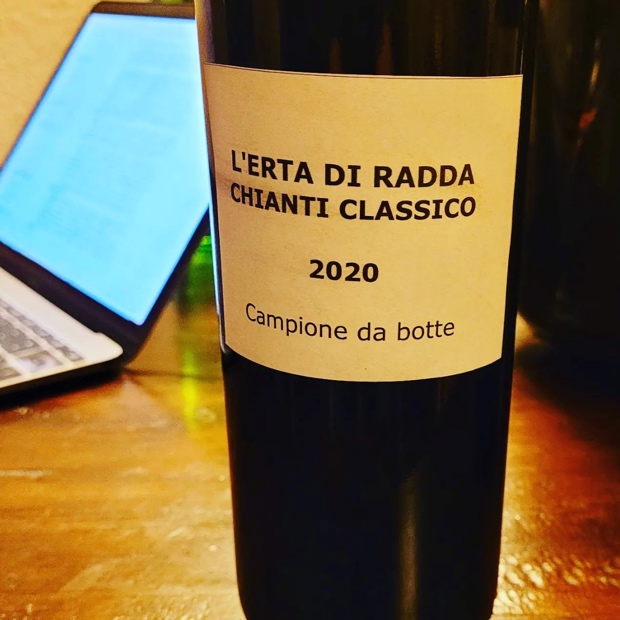
Campione da Botte, L’Erta di Radda
L’Erta Di Radda Chianti Classico DOCG 2020
Radda
From a sample labeled campione da botte, in other words a tank sample. Freshness abounds, Radda style, from the breath of the woods, the cool of the stones and the rise of the hills. Herbal like fresh Genovese basil, spicy that way with a hint of anise and cinnamon. A co-fermentation of sangiovese and canaiolo (five per cent), the latter adding le forma, volume and expansione, all of which are self-explanatory. An opposite of linearity, not roundness but a sapid expanse across the palate and in the mouth. This is the harmony pulled and coaxed from the ’20 Annata in a wine that makes you feel but more importantly exists by the dint of how it feels. Full. Not yet bottled but will be soon and truth is while the wine is tight the aromatics and mouthfeel are good to go. Worth a full review. Drink 2023-2027. Tasted March 2022
Maurizio Brogioni Chianti Classico DOCG H’Amorosa 2020
Greve
H’Amarosa as in “a love affair” or perhaps “I have a lover,” which could be sangiovese, perhaps Greve in Chianti or in a more broader sense, Chianti Classico. Can’t help but think about Jackson Browne, ballads, a splash of merlot and what’s happening these days. In 2020 that would be truth, openness and clarity with respect to the wines which are the storytelling by the producers. Brogioni’s is forthright, specific, real and for everyman. Juicy and in touch with both reality but also emotions. “I had a lover, I don’t think I’d risk another these days, these days.” Drink 2023-2027. Tasted March 2022
Monte Bernardi Chianti Classico DOCG Retromarcia 2020
Panzano
Michael Schmelzer’s 2020 takes up right where everything he had been working on and through in 2019 left off. That is to say full on agricultural indemnity with all fruit all the time in use and winemaking that is afraid of nothing. The silky swarthiness of his ’20 Retromarcia endorsement and structural surety combine for freedom, exception and security. This Retromarcia ushers fruit in waves, oscillations, acetic sweeps and swells, coming at the palate with the full force of laws provided by nature. What happens at Monte Bernardi stays at Monte Bernardi, where calculated inventiveness experiences living life on the edge. Drink 2023-2028. Tasted March 2022

Alessandra Deiana and Michele Braganti, Monteraponi, Radda
Monteraponi Chianti Classico DOCG 2020
Radda
Monteraponi from Michele Braganti breathes in the high elevation Radda air and exhales with clarity, not to mention exclusivity. Yet another reductive 2020, albeit mildly so and not difficult to coax out of its savoury candied shell. While tart and even intense there is something mysterious and shadowy in the recesses of this sangiovese’s temperament and intelligence. Something guarded and misunderstood but time will make it all work out right. Keep this away and allow it to soften as it slowly gets to know you. Drink 2024-2029. Tasted March 2022
Montesecondo Chianti Classico DOCG 2020
Gaiole
A baritone beginning, low held Gaiole notes below with red to black fruit above. Not closed yet not expressive or generous either, reticent even and holding out because the tannins are in charge. Fruit quality and fleshiness are substantial, as is the wood and so the malic, creamy and sheathing sensation will need to settle before integration opens up the wine. Drink 2023-2026. Tasted March 2022
Podere Castellinuzza Chianti Classico DOCG 2020
Lamole
Big but not dense and for Lamole a heady sangiovese from the not so magnanimous Chianti Classico vintage. More than anything it is essential and encouraged to concentrate on the floral aspects of this wine, perfumed to the hilt with that Lamole commodity. Like all the bushy herbs in bloom, of purples and pinks, scenting the air at dusk even if one fails to brush on by. Lovely texture in 2020, mildly glycerol and giving the impression of almost gelid but surely sweet sangiovese fruit. Drink 2023-2027. Tasted March 2022
Podere Poggio Scalette Chianti Classico DOCG 2020
Greve
There can be no surprise that Jurji Fiore’s 2020 is one of the more transparent and striking scintillants of sangiovese to emerge from out of the verifiable and veritably airy 2020 vintage. Sharp and pointed red limestone fruit off of the Ruffoli hill, rich undercurrent of currants red and also some black, intensity of right bank Greve acidity and tannins to carry this Annata longer than most. Drink 2024-2030. Tasted March 2022
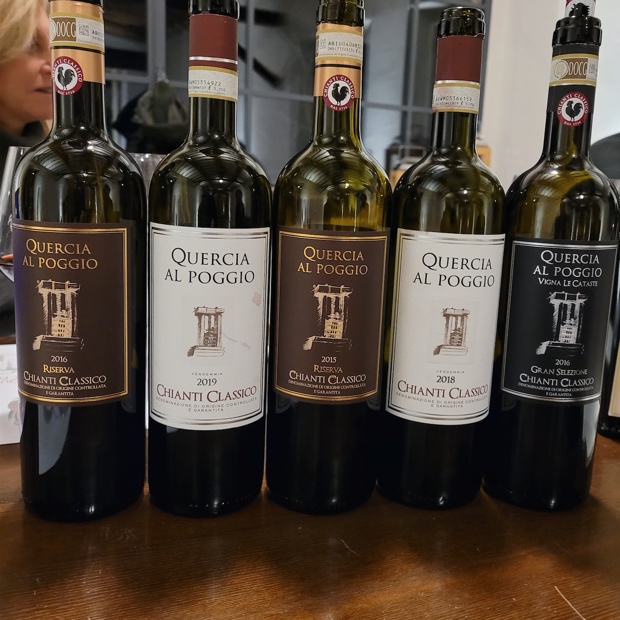
Quercia al Poggio, San Donato in Poggio
Quercia Al Poggio Chianti Classico DOCG 2020
San Donato in Poggio
The combination of definable and deliverable San Donato in Poggio terroir mixed with vintage compaction makes for this solid, chewy and fulsome Annata. Liquorice and blood orange, a deeper sentiment that for some reason seems to be a frazione thing for this vintage because this consistency of full emotive and textural sentiment runs through many of the wines. Look to San Donato in Poggio for more of everything in 2020. The wines are bigger than some of the other UGAs. Drink 2023-2026. Tasted March 2022
Querceto Di Castellina Chianti Classico DOCG L’Aura 2020
Castellina
This is not a Riserva, that is made quite clear from a 100 per cent sangiovese that used to include some merlot. Now a matter of picking and choosing plots from the steep and sloping vineyard starting from the bottom at 450m and rising up to 510. Sees 12 months in 3rd and 4th passage French wood. L’Aura is Iacopo Di Battista’s mother, as in the “aura of Laura” and a label produced since 1998. Not red but ochre-purple limestone literally begets and becomes this Annata, a.k.a fully completely Alberese soil. What comes from 2020 is a doubling down, regardless of appellative level, a wow factor of laser sharp stone cut by even sharper acidity. Edgy balsamic tannins increase the seriousness of this wine. Sell it now if you must but this Annata needs time. Drink 2024-2028. Tasted February 2022
Riecine Chianti Classico DOCG 2020
Gaiole
Riecine from Gaiole is the most radiant and glycerin version of itself, clean and concise, grippy yet available almost whenever you find yourself ready and in the sangiovese mood. Not a tart or intense Riecine by any stretch of the imagination, nor is there any real tannic demand. This is meant for now and should be embraced that way. Drink 2022-2025. Tasted March 2022
Rocca Delle Macìe Chianti Classico DOCG 2020
Castellina
Incorporates five per cent merlot into the sangiovese, the grapes coming from all four Rocca delle Macìe estates. Essential, consistent and knowable for Castellina and especially a style that is unwavering as Rocca delle Macìe. A wine of layered commune earth, deep and even a bit brooding, so very sangiovese and with real Annata depth. Drink 2022-2025. Tasted February 2022
Rocca Di Castagnoli Chianti Classico DOCG 2020
Gaiole
Young, taut, impressionable, high-toned and bright red fruit Gaiole Annata, rich in 2020 polyphenols and thiols, quite vibrant and intense. Less herbal than many of its locale and even past iterations of itself while the fruit concentrates and works through the earliest stages of its youth. Fine and meshing the way Annata should and offering beauty above all else. Will drink at peak next year and for four after that. Drink 2023-2027. Tasted March 2022

Marco Ricarosli Firidolfi, Rocca di Montegrossi, Gaiole
Rocca Di Montegrossi Chianti Classico DOCG 2020
Gaiole
Always 90 per cent sangiovese, here with (8) canaiolo and (2) colorino. “Quite a regular growing season, warm but never too much,” says Marco Ricasoli, “and very cool nights.” The main character is first colour in a Classico never stressed by heat and so fruit freshens, with acidity sure to follow. A crunchy Annata, not too hard and not too soft. Picked in the last week of September, late enough for full maturity. Monti (in Gaiole) is a warmer area and while the alcohol checks in at 14 per cent it’s a well-managed and balanced wine all the way through. Drink 2022-2026. Tasted March 2022
Ruffino Chianti Classico DOCG Santedame 2020
Castellina
Always a different and purposefully designed Annata from Ruffino, so very cherry liqueur, thickened by soil chalk in liquid varietal form. Here sangiovese with help from smoothing international varieties makes for a consistency of Chianti Classico to draw a crowd. Just a bit reductive and hypo-fresh, tart and sour-edged. Not edgy though and smooth as silk. Very professional wine and a good vintage from which to make that happen. Drink 2022-2025. Tasted March 2022
San Felice Chianti Classico DOCG 2020
Castelnuovo Berardenga
A blend of sangiovese, pugnitello and colorino, the same dating back to 2009. Yet another warm vintage though with great changes in agricultural practices this Annata now shows great juicy freshness, especially from 2019 and now through this 2020. The acidity is more than maintained, the wood kept well in the back and this is just up front, accessible and on point. Drink 2022-2025. Tasted February 2022
Tenuta Di Campomaggio Chianti Classico DOCG Campomaggio 2020
Radda
Raddese from the start, acids singing, zinging and slinging the lightning red fruit to the fore. In youth clearly dusty while a clarity and purity exists in a vacuum where lightness mixed with barrel make for a truly spirited Chianti Classico. Expressly and dutifully Radda sangiovese. Drink 2023-2027. Tasted March 2022
Terra Di Seta Chianti Classico DOCG 2020
Castelnuovo Beradenga
From Castelnuovo Beradenga and the Pellegrini farm where the wines are constructed with strict adherence to Glatt Kosher rules. Tart and chewy red fruit with a toasted and roasted quality, in other words cooked but with a light touch and sense of sangiovese gastronomy. As fas as Kosher for Passover wines are considered this Terra di Seta should reside at the top of anyone’s list. As for Chianti Classico it is real and exemplary of place albeit needing food alongside to tame the tannins and prepared food quality of the wine. Drink 2022-2024. Tasted March 2022
Tolaini Chianti Classico DOCG Vallenuova 2020
Castelnuovo Berardenga
Vallenuovo from Castelnuovo Berardenga’s Tolaini is an extracted, generously macerated and humorously concentrated 2020. There is just something about Tolaini, an aromatic potpourri specific to this wine in great hyperbole. A bit reductive as many are so early in this vessel and yet agitation really does release the charm. A really well constructed Chianti Classico that will appeal to those who look for fullness, especially through the texture and the finish. Drink 2023-2027. Tasted March 2022
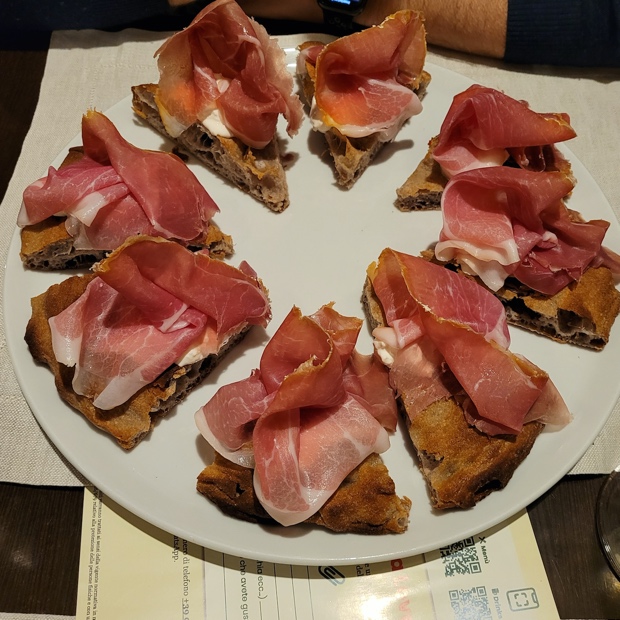
Pizzeria Lo Speso in Il Ferrone
Chianti Classico DOCG 2019
Azienda Agricola Mori Concetta Chianti Classico Morino DOCG 2019
San Casciano
Purely, expressly and properly San Casciano, structured woolly and snugly wrapped around fruit kept warm and nurtured in a blanket of care. Fragrant with fine tannins, “legno,” as it is said. A touch of green that is San Casciano because of the particular kind of savour and temper. Some minor austerity and demand in these tannins but mostly a sangiovese of land and air to express where it comes from. Drink 2023-2026. Tasted February 2022
Badia A Coltibuono Chianti Classico DOCG 2019
Gaiole
Immediate attention is paid to the herbs and resins in the aromas of Badia a Colibuono’s 2019. From the outset this is clear and present Gaiole sangiovese, local, parochial and a sign of the time. No question the fruit is healthy and substantial but the vinoso quality of all that surrounds is just too blatant to ignore. As are the crisp acids and finely austere tannins. Transparent clarity is a given, as is a structural belief that this Chianti Classico Annata will live long with the best of them. Last tasted March 2022
A distinctly herbal Annata from Badia a Coltibuono out of 2019, so very Monti with herbs and brush of all iterations. Notably rosemary with undertones of sage, cypress and gariga. The fruit keeps up with the greens but there is no mistaking the minty and pine forest behaviour of this wine. Super herbal, tart cherries and good fruit ripeness. Well managed tannins but those herbs! Drink 2023-2027. Tasted February 2022
Belvedere Campòli Conte Guicciardini Chianti Classico DOCG 2019
San Casciano
Again it is San Casciano that opens up the select savoury gates in an openly fragrant and knit sangiovese that is clearly and unequivocally 100 per cent just that. With thanks to a generous vintage and what is clearly a site that ripens ahead of many, the wine comes out smooth, itself also quite generous and even what could be called morbido. As easy as varietal Classico gets and ready to go. Drink 2022-2024. Tasted March 2022
Bibbiano Chianti Classico DOCG 2019
Castellina
Bibbiano’s Annata moves to the rhythm of infinite wisdom, coagulation, conjoining and come together, of dual terroirs, bright red fruit alighting with stern, edging to austerity tannin. The vintage rebelled against is one from which Tommaso Marocchesi Marzi sticks to his guns and creates an Annata of undeniable estate conviction. Needing time and yet smiling that Castellina smile, finishing with that spicy Bibbiano spice. Can’t think of more than three other Classico at this price that are equal in representation to pour by the glass. Drink 2023-2027. Tasted February 2022

Bindi Sergardi, Vagliagli
Bindi Sergardi Chianti Classico DOCG La Ghirlanda Tenuta Mocenni 2019
Vagliagli
Exuberant Mocenni perfume and one could not help but to be fully cognizant of how expressively floral and stone cool it is. For Annata it gets neither more concentrated nor more in tune with a vineyard than this. So transparent and connected to Mocenni which is how and why Annata’s naked character is so important to explain an estate’s riches and what is possible with the other elevated, concentrated and investigative appellations. Wood is ambitious and justified in such a case, even at this Annata level, for later on. As for now or just around the corner, well that works as well. Drink 2023-2028. Tasted October 2021
Bindi Sergardi Chianti Classico DOCG Ser Gardo 2019
Vagliagli
Taken solely from the I Colli Estate’s vineyards in the UGA zone of Vaglialgi at the western edge of Castelnuovo Berardenga commune, adjacent the Chianti Colli Senesi, 10 kilometres from Mocenni Estate, 15 minutes house to house. Makes for an antithetical Classico expression to what comes from the Mocenni amphitheatre. The difference is dramatic, higher in pH, lower in acidity, velvety, easier, readier. This 2019 vintage is a prime example, lush, 100 per cent sangiovese ripe, aged no more than six months in used barriques. Picked near to the last week of September, without exception, a week before Mocenni. Just a hint of phenolic chalkiness repeated on the back palate. Drink 2022-2025. Tasted October and November 2021
Borgo Salcetino Chianti Classico DOCG 2019
Radda
Radda in 100 per cent sangiovese kicks into high acid and elevated tones, lifted and placed in the air above. Quite tart and also tannic, drying over the palate, feeling arid, dusty and enervating. Not a tired wine per se but one that makes you feel this way. Drink 2022-2023. Tasted March 2022
Borgo Scopeto Chianti Classico DOCG 2019
Vagliagli
Vagliagli is the UGA and a 10 per cent combination of same-same colorino and merlot bring some colour and also softness to Borgo Scopeto’s sangiovese face. Crunchy sangiovese that is, well developed from the happy vintage though not without some austerity and grip in the tannin. More so than many vintages for this western Castelnuovo estate and the interest lies in how they will integrate and resolve. Drink 2023-2025. Tasted March 2022
Cafaggio Chianti Classico DOCG 2019
Panzano
Cafaggio so beautifully and comfortably represents Panzano from 2019, fruit at the front, mild structure settling in easily at the back. A pure frazione expression of sangiovese and from a vintage that laid such possibility out on a silver platter. Cafaggio clearly heeded the call and jumped on the opportunity. Finest Annata from the estate in quite some time. Drink 2022-2025. Tasted March 2022
Cantalici Chianti Classico DOCG Baruffo 2019
Gaiole
Full on Gaiole from Baruffo in 2019, unsurprising and in effect expected from an estate that looks for fullness, wellness and acceptance from their generous wines. All sangiovese and nothing but the great red hope in desire for Cantalici and Chianti Classico. Crisp in fact, well seasoned while noticeably tannic yet there is a feeling that you are requested to drink this as soon as possible. Find some Prosciutto di Parma, Fennocchiona and Pecorino for best results. Drink 2022-2025. Tasted March 2022

With Filippo and Gioia Cresti, Carpineta Fontalpino, Castelnuovo Berardenga
Carpineta Fontalpino Chianti Classico DOCG 2019
Castelnuovo Berardenga
“A wonderful harvest for us and for the farm” tells Gioia Cresti. In terms of UGA this is Castelnuovo and as a broad expression this Annata is a micro-version captured in bottle, of wide open space and air. There are three vineyard locations, 10 hectares in Castelnuovo near to the winery, seven in Dofana (Vagliagli) and three in Montaperti. So fresh, 20 (normal) days on skins and the sweetest tannins available, even for a Carpineta Annata. Linear and long, elastically fleshy and just well, perfect. Yes, Gioia Cresti is a very good winemaker. Drink 2022-2027. Tasted November 2021
Casa Emma Chianti Classico DOCG 2019
San Donato in Poggio
A ninety per cent sangiovese with five per cent each canaiolo and malvasia nera, fermented in stainless steel and concrete vats, aged one year in tonneaux (500ml), yet 40 per cent remains in barrel. An ideal and balanced vintage, slower to ripen than ’18 with no rush too fast to “fruitiness and complexity.” Also because the sub-zone of San Donato in Poggio performs better in warmer vintages. Great freshness, blood orange and intense red fruit but it’s just uncanny how this could be nothing but Casa Emma sangiovese. Tannins are denser, longer and impressive, the overall feel one that tells us this Annata can go deep. Drink 2023-2029. Tasted October 2021
Casaloste Chianti Classico DOCG 2019
Panzano
Notable ripe fruit and also a verdant austerity makes for a wine of two positions, angles and disparate emotions. A sangiovese of floral and also avian display while in delivery of liquorice and bitter herbs. Almost Riserva in style, glycerol and concentration at the fore, the rest waiting in the wings. Needs time. Drink 2023-2026. Tasted February 2022

Ristoro di Lamole
Castagnoli Chianti Classico DOCG 2019
Castellina
Castagnoli procures a deeply satisfying and fulsome Annata, ripe and at the ready through a coupling to acidity and a tripling because the tannin is fully engaged. Tripped and let loose more like it in a sangiovese of swirls, thrills and intensity. Feels like Castellina at elevation with serious Galestro effects for an eventual date with elegance. Five years down the road from vintage it would seem. Drink 2023-2028. Tasted February 2022
Castellinuzza E Piuca Chianti Classico DOCG 2019
Lamole
Clearly, unequivocally and unmistakably Lamole because that perfume jumps from the glass to gain your immediate attention. Part Macigno and part Calcari, so much vinous resin and a walk through a pine forest. Cool Lamole liqueur, fine capture of 2019 and really just an ideal vintage for e Piuca of Castellinuzza lineage in their native Lamole habitat. Drink 2023-2026. Tasted March 2022
Castello Dei Rampolla Chianti Classico DOCG 2019
Panzano
Highest level of Panzano richness, depth of fruit and Pietraforte infiltration, allowed to emanate in natural highlights throughout. All these elements are together exhibited in great co-conspiratorial desire. Full on push-pull of sliding scale piques and roundness in a sangiovese that wants to be both and have it all. Caky too with merlot plus cabernet sauvignon for surety and fruit explosiveness. Substantial and even if some vintages include petit verdot methinks not this one. A “clean” one for Rampolla, as it is said, international in the best possible way. Drink 2022-2025. Tasted March 2022

Castello della Paneretta, San Donato in Poggio
Castello Della Paneretta Chianti Classico DOCG 2019
San Donato in Poggio
From the San Donato in Poggio property with 404 years of experience behind this upstanding, generous, careful and thorough Annata from the 2019 vintage. The blood orange, red currant and chalky Galestro-Alberese chime can only be from this additional geographical unit, a frazione so distinctive, like the 11:30am Sunday bells that ring through Florence. A perfect time to taste by the way, refreshing, affirming and ready to set one on their way. Drink 2023-2027. Tasted February 2022
Castello Di Bossi Chianti Classico DOCG C. Berardenga 2019
Castelnuovo Berardenga
Clear, ernest and caressing fruit is captured from the open generosity of the 2019 vintage. This Castelnuovo Berardenga example shows what 100 per cent sangiovese of warmth and substance can effect for über drinkable Chianti Classico. Bossi’s is readier than many, seasoned by spice more than it exhibits qualities urged on by structure. A slight drying finish indicates a few years of life lay ahead. Drink 2022-2026. Tasted March 2022
Castello Di Cacchiano Chianti Classico DOCG 2019
Gaiole
Really parochial and specific, a Monti in Chianti Galestro gifted CC, aromatic yet wound quite tight. Sheds some perfumed Gaiole light on the state and possibility in this mainly sangiovese wine that receives minor support from endemic and pH supporting roles provided by canaiolo and malvasia nera. Good promise may just result in better fortune should you give this and the austere tannin some time. Drink 2023-2026. Tasted March 2022
Castello Di Gabbiano Chianti Classico DOCG Cavaliere d’Oro 2019
San Casciano
While Gabbiano produces large volumes of other denominational wines it needs reminding that their Chianti Classico numbers are significantly lower and the attention paid to these wines spares no emotion, attention or expense. Economies of scale allow for bargain pricing and the wines over deliver at all appellative levels. Case in point the Cavaliere d’Oro 2019, fragrant and graceful, salutary acids riding shotgun to promising fruit like a well orchestrated pack with Galestro-driven tannin. Everything together, delivering the goods and for the money. Almost unbeatable. Drink 2022-2026. Tasted March 2022
Castello Di Meleto Chianti Classico DOCG 2019
Gaiole
With 763 years existence and experience behind this 2019 Annata you just know someone has a distinct territorial advantage. Castello di Meleto’s is quite rich, luxe and creamy for Annata and especially Gaiol, but is comes replete with great and preserving parochial acidity. That and sweet herbs, brushy savour and long strides. Solid, fresh for the vintage and the estate. Drink 2023-2026. Tasted February 2022

With Laura Bianchi, Castello di Monsanto, San Donato in Poggio
Castello Di Monsanto Chianti Classico DOCG 2019
San Donato in Poggio
A vintage with more Riserva in a five to one ratio (to Annata) when usually the numbers are four to one. Of course more savour and grip than 2018 and long-chained tannins. The length is not merely outstanding in fact it resonates through all the senses, including there at which the quotidian and fantastic converge. Drink 2021-2024. Tasted October 2021 and February 2022
Castello Di Radda Chianti Classico DOCG 2019
Radda
Mainly sangiovese with 10 per cent colorino and canaiolo, from a diplomatic vintage, promising of quality and generous of quantity. For estate director Stefano Peruzzi it is harmonious and very much like 2016. Such a professionally composed and pragmatically styled Chianti Classico, not what could be called luxe or lush though clearly balanced in its fruit to acid compendium. Delivers a purity of citrus crunch and is surely a design of tradition and place. While you feel a slight malo creaminess this is not a question of texture but one that speaks in fresh sangiovese tones specific to these lower hills of Radda. Last tasted March 2022
A fine vintage here for Castello di Radda with their well-judged, sweetly sumptuous and succulent sangiovese. Shows a level of consistency in place that may have or would not have been possible just ten years ago. Warmer vintages and dedicated agricultural concern elevate the year after year game. In 2019 the acids and spices merge, unite and fixate on the fruit for a lovely circular swirl of freshness, vim and flavour. Really fine in nine. Drink 2022-2026. Tasted October 2021
Castello Di Verrazzano Chianti Classico DOCG 2019
Montefioralle
Really sweet perfumed Montefioralle entry from Verrazzano’s endemic and impartible Annata, mainly sangiovese with five per cent “other” autochthonous varieties. One of the most cherry red Chianti Classico in every respect; hue, aroma and flavour, then finishing with the slightest bitter pit. Just that touch of green in the tannin mixed with the purity of acidity makes this really sing. A song for Montefioralle. Drink 2023-2027. Tasted March 2022
Castello Di Volpaia Chianti Classico DOCG 2019
Radda
No doubt that Chianti Classico will always be fresh and spirited from Volpaia but it somehow finds a way in every vintage to become increasingly fluid, silky, clear and beautiful. The upper vineyards are helping more and more every year, plus a team working the vines and the wines together for more than 20 years. Yet this vintage still shows some backbone while overall much of the story remains to unfold and be told. Re-visit next year and the one after that for the emergence of the full story. Drink 2022-2027. Tasted October 2021

Filippo Bartolotta presents Il Chianti Classico in 9 Decadi at the Chianti Classico Collection 2022, Stazione Leopolda, Firenze
Castelvecchi Chianti Classico DOCG Capotondo 2019
Radda
Lovely textured vintage for the Capotondo in full capture of rich and ripe fruit. Some grip in tannin but mainly acidity that elevates and perches the substantial sangiovese up where it belongs in the Radda ether and with 2019 as the backdrop. Great work for the vintage. Drink 2022-2025. Tasted February 2022
Cinciano Chianti Classico DOCG 2019
San Donato in Poggio
An ancient sea salty and airy western Chianti Classico sangiovese from Cinciano does Poggibonsi/San Donato in Poggio proud if in just a bit of its owns speacial and ulterior way. Always that silky, glycerol and substantial fruit ahead of all else. Beauty and purity, ease and such drink-ability. At the height of that ideal from 2019. Drink 2022-2024. Tasted March 2022
Colle Bereto Chianti Classico DOCG 2019
Radda
So very Radda from Bernardo Bianchi’s ’19 Annata, fruit and acid structure in the arena of the cool while plenty of both preside. Only a small percentage of colorino shades the sangiovese from red to further red and the palate is simply sangiovese. There are parts iron and others blood orange out of 2019, fruit sorted to optimum purity and the least amount of bitters pressed into the hull of the wine. Quite structured and as always, impressive. Drink 2024-2028. Tasted March 2022
Concadoro Chianti Classico DOCG 2019
Castellina
Concadoro is Castellina on the western front, quietly aromatic and shilling the high toned, almost acetic style from the western edge of the central valley. Quite tart and astringent, more parts that make this tough and out of balance. Drink 2022. Tasted March 2022
Conti Capponi/Villa Calcinaia Chianti Classico DOCG 2019
Montefioralle
Fine and far from presumptuous Annata here from Il Conte, exemplary of a Greve, digging a bit deeper into Montefioralle sangiovese. Firm of dark and even dusty fruit, antsy and a bit racy while still this youthful, unsettled and needing time. Firm and grippy for the vintage, absolutely Calcinaia in style and a true representation of the multifarious estate soils. Drink 2024-2027. Tasted February 2022
Dievole Chianti Classico DOCG 2019
Vagliagli
From the geographical zone of Vagliagli in the western section of Castelnuovo Berardenga commune and a sangiovese augmented by seven per cent canaiolo plus (3) colorino grown at 335m. Spends 13 months in 41 hl (untoasted) French oak barrels. Classicism incarnate for the territory with a Vagliagli twist, über savoury, youthful and fuelled by stone-strewn Alberese (limestone) vineyards. Creates a tannic austerity and a request for allowing this sangiovese Annata time to flesh out and settle in. Two years minimum, after which the very cherry fruit will act more aromatically expressive. Drink 2023-2026. Tasted December 2021
Dievole Chianti Classico DOCG Petrignano 2019
Vagliagli
Petrignano is what Dievole assigns the lede of “a nuova voce del Chianti Classico,” a new voice, especially at the Annata level. The Gran Selezione is from Vigna Sessina and here 2019 is spoken through the younger vines and more precocious if not fully yet understood vineyard of Petrignano. Certainly a fresh and savoury Annata, sour citrus chalky and very primary. Almost nouveau but without the carbonic yet still this is as light and potentially sumptuous as it gets. Drink 2022-2023. Tasted February 2022
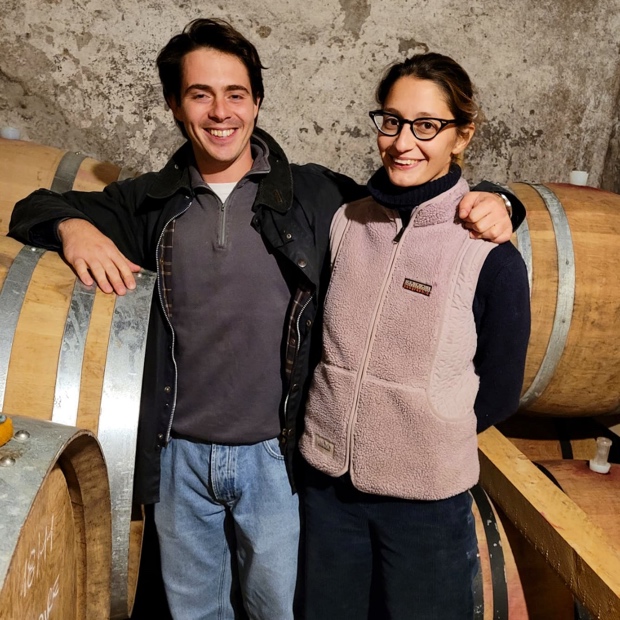
Matteo Vaccari and Maddalena Fucile, Cigliano di Sopra, San Casciano
Fattoria Cigliano Di Sopra Chianti Classico DOCG 2019
San Casciano
This the fourth vintage of Maddalena Fucile and Matteo Vaccari’s Chianti Classico takes the next step, with a level of sweet acidity that really moves your palate and also because decreased wood does less to distract as much as in ’17 and ’18. Also de-stemmed by hand (as opposed to a new machine that will do a much better job in 2020), so here there is also some crushing. While there is some efficacy and esculente essence in the tannins there is also a delicate nature about this San Casciano sangiovese. Very good energy, very river stone, sand-felt and also by a little bit of Galestro rolled into one fine and lengthy Chianti Classico. Good tannin management is executed with precocious acumen with help from adding the previous year’s lees in the bottle. Drink 2022-2026. Tasted November 2021
Fattoria della’Aiola Chianti Classico DOCG 2019
Vagliagli
Mainly sangiovese with 10 per cent merlot and colorino aged in large botti plus stainless steel. Pitchy purple, Galestro meeting Macigno silk, mid-weight compaction and concern. Tannins are equalizing with the wood making a textural statement in a Vagliagli with good linger. Not a flashy Chianti Classico but one entrenched in the UGA soil. Drink 2022-2025. Tasted February 2022
Fattoria Di Montecchio Chianti Classico DOCG 2019
San Donato in Poggio
The Annata of Montecchio always express a deeper San Donato in Poggio, classically citrus and red fruit meeting salumi cure, but there is always more. To the story and the point, Annata from 2019 gives earth, juice bled through stone and clay. If other UGAs are akin to Santenay than this Barberino Tavarnelle could be compared to say, Volnay. In sangiovese of course and Montecchio accedes to a Villages level, here in their suitably hyperbolic Annata. Drink 2023-2027. Tasted February 2022
Fattoria La Leccia Chianti Classico DOCG 2019
Castellina
Beautifully blood orange sangiovese from Castellina’s La Leccia, fully equipped with red citrus, even some pink grapefruit. Then the structure and the verdancy take charge, especially on the palate, with some tannin unresolved and yet other structural parts that will work overtime to make the grade. Wait a year or two in any case. Drink 2023-2025. Tasted February 2022

Claudio, Cristina and Sole, Fattoria Le Masse, San Donato in Poggio
Fattoria Le Masse Chianti Classico DOCG 2019
San Donato in Poggio
“To me, one of the best years for grapes,” tells winemaker Claudio Gozzi and the wood tank used for fermentation and now aging makes this noticeably a year wiser (than 2018) and so much more suitable to making this 100 per cent sangiovese. Even without tasting you can tell there’s a refinement, a calm and a settling that 2018 does not have. Cleaner, much more precision and seamless behaviour. Perfect volatility, sweet acidity and long, fine chains of tannin. Pure and honest, exacting, readier and will be just ideal with another year or so of time. Approximately 7,500 bottles produced. Drink 2022-2028. Tasted October 2021
Fattoria Poggerino Chianti Classico DOCG Nuovo 2019
Radda
Fulsome and so purposefully developed sangiovese from Piero Lanza’s roll and sway of a Radda vineyard. Gelid yet tumbling and even a bit cumbersome while this youthful but what Poggerino is given is what Poggerino gives back. Strength over power, headiness over density, reality over headlines. A full and satisfying Chianti Classico with so much integrity in correct alignment with this place. Drink 2023-2027. Tasted February 2022
Fattoria Pomona Chianti Classico DOCG 2019
Castellina
Yet another Pomona Annata pretty in pulchritude, handsome in heavenly sangiovese and grande by the goodness of grace. The blood orange by jove of sangiovese juiced for success. Trust when you hear that Monica Raspi’s cloudy ferments look like they will never clarify, purify and deliver the message of her Castellina vineyards but they have and they do. There is risk and leaps of faith in her work but she is a true scientist with artistic style and merit. She makes great Annata and more with 2019 being a new launching pad to prove the point. Last tasted February 2022
The flesh and full palate address continues where 2018 left off though there is an openness to ’19 that speaks to more warmth and a weightiness of developed tannin. Of comports in structural components, polymerizing commotions and long chains of conveyance. Bread as sustenance and life from a 100 per cent sangiovese Annata out of Monica Raspi’s Sant’Ilario and Vigna del Termine vineyards teaming up for caress and no distress. Oh sweet Chianti Classico surrender, “I’d be a fool to try to escape you.” Drink 2022-2027. Tasted October 2021
Fattoria Santo Stefano Chianti Classico DOCG 2019
Greve
Greve and 100 per cent sangiovese, super Greve in fact, heady, sturdy, red lightning cherry and volumetric in terms of substance, alcohol and structure. Linear, translucent, dusty-savoury with more texture and silky consistency than what may have first been ascertained. Quietly aromatic yet attractively informative. Not what should be considered or called a crushable wine because all the constituent parts are solid, in tact, tactful and together. Almost seamless and perhaps an estate en route to being (almost) famous. Drink 2024–2028. Tasted February and March 2022
Felciano Chianti Classico DOCG 2019
Panzano
Panzano and 100 per cent sangiovese, without a shadow of a doubt on either front, chewy and fulsome fruit, lots of sun and ripeness, chalky Galestro and perhaps even Pietraforte-induced structure. Acids are quite high for 2019 but then again it’s all sangiovese so why be surprised. Drink 2023-2026. Tasted March 2022

Giovanni and Bernardo Manetti, Fontodi, Panzano
Fontodi Chianti Classico DOCG 2019
Panzano
Giovanni Manetti explains “I have over 20 hectares of over 40 years. Even if there are 20-30 days separating the picking from start to finish in a vintage there is always a marker, especially with sangiovese. And with old vines they are not nearly as susceptible to stressors. This Vigna del Sorbo will succeed, even with all of the (climate events and vintage stressors) mentioned here.” Annata 2019 was bottled in July and is not yet released. “The vintage of balance, pleasant wines, very charming.” That said also toned musculature, grip, fineness of tannins. Plenty of acidity, here at 6.50 tA, chalky liquidity, round enough to offer an immensity of early pleasure. Don’t be fooled into thinking ’19 is simply for the here and now as longevity is a guarantee. This was known from the start when the wines were in tank, showing great perfume and tasting with Fontodi freshness and acidity. Not easy drinking but drinkable, with Panzano resin and parochial acidity. Drink 2022-2027. Tasted October 2021

Lamole di Fontodi
Fontodi Chianti Classico DOCG Filetta Di Lamole 2019
Lamole
Filetta waits its turn, always the last picked vineyard in Lamole and as with 2018 October 10th was the date for Fontodi’s fruit. Giovanni’s cousin owns the vineyard and records date back to 1045, rare and historic for Chianti Classico. A restrained, elastic and finessed vintage is 2019, blessed with the Lamole perfume, blood orange addendum and Fontodi body. Not a vintage of power or strength and so much more so Lamole which makes one wonder just how cool climate accentuated the other producers’ 2019s will be. Other vintages of Filetta have been fine, even caressing and reaching levels of deep understanding but 2019 is more of a pop and pour vintage with true frazione acids and a harmonizing palate creaminess. Drink this while ’18 continues to settle in. Drink 2022-2029. Tasted February 2022
Frescobaldi Tenuta Perano Chianti Classico DOCG 2019
Gaiole
Frescobaldi’s Tenuta Perano takes full advantage of the white calcareous soils to set upon a path for and with great vintage promise. The sangiovese in this bottle is smooth, suave and mineral, tart and full on gregarious of a specific Gaiole tang. A drinkable Annata, tried and true, delicious, accessible and yet nary a moment of flaccidity or softness abounds. Ideal for three years on without any concern for devolution or change. Drink 2022-2025. Tasted February 2022
Gagliole Chianti Classico DOCG Rubiolo 2019
Panzano
Panzano sangiovese does not get any more pure, transparent and fulsome than Rubiolo, all the while spoken in utmost clarity. Not full, nor heady, nigh density neither. Think sweetness, aromatically calling, fruit speaking. Seasoning, not salt and pepper necessarily but spices unnamed, unthought, undeclared. An old friend dressed so dapper, not perfectly pressed but characterful and timeless. Like music played as adagio with very slight dynamic change, aesthetics and script expressed in equally essential concentration. The Annata you want. Drink 2022-2027. Tasted March 2022
I Collazzi I Bastioni Chianti Classico DOCG 2019
San Casciano
Woody, savoury and sour-edged sangiovese, tart and oddly confected. Quick and if stylish in its own way the San Casciano aspect is covered by the wood and the work. Drink 2022-2024. Tasted February 2022

Susanna Grassi, I Fabbri, Lamole
I Fabbri Olinto Chianti Classico DOCG 2019
Lamole
Olinto, always from the highest elevation, Lamole perfume up to 11 where there is also some merlot planted, at 12 per cent part of the blend and again no barrel. Freshness at the highest premium and with the merlot so ripe with thanks to vine age and warmer climate conditions, a wine so drinkable you could hardly believe the truth. Beauty in florals incarnate, especially violets and candied iris, juicy if peppery pansy and nasturtium. Last tasted February 2022
Aside from the upfront, obvious and always beautiful I Fabbri as a function of Lamole perfume there is this incredulous ripeness and sweetness of fruit. Disbelieving because of the elevation and how it was once virtually impossible to achieve such sugar and phenolic ripeness in this part of Greve for Chianti Classico wines. The 20 per cent merlot is just so apropos for blending into sangiovese, from this most generous vintage and to tame the high level of acidity. While this classic normale from Susanna Grassi is about as crushable as any 2019 one can’t help but wonder if sangiovese needed no help this time around. No matter really. Just enjoy. Drink 2021-2024. Tasted October and November 2021
I Fabbri Chianti Classico DOCG Lamole Olinto Grassie E Figlio 2019
Lamole
Not that other vintages are lacking the clarity of Lamole perfume and terroir but 2019 brings the want and desire beyond the frazione’s intangibles. They being flesh and mid-palate, again not absent in other years though magnified, elastic and extra from 19’s warm generosity. Great thanks and aromatic response, more than this in the ways of accession, reach and scope. Purely Lamole plus, plus. Drink 2022-2027. Tasted February 2022

La Squadra Canadese at I Fabbri, Lamole
I Fabbri Chianti Classico DOCG Terra Di Lamole 2019
Lamole
The top “tier” Annata in Susanna Fabbri’s range is this main terroir sangiovese, the Terre di Lamole. Lamole at heights, in hyperbole, expressive and of course, so very perfumed. A veritable potpourri of Macigno del Chianti and all the florals imagined, tied up in one red petalled, native herb and mineral bouquet. Grace and understated charm, seamlessness and the sort of structure that build and builds but does so without mortar between the stones. Natural and beautiful. Drink 2023-2029. Tasted March 2022
Il Molino Di Grace Chianti Classico DOCG 2019
Panzano
The Solo Sangiovese Annata (and listed as such only on American labels), bottled just three weeks ago, über fresh, a picture perfect vintage for all appellative levels but beginning here with sangiovese. So easy to drink, very pure, balanced, all things “it has to be because this is Chianti Classico, not Gran Selezione,” explains and insists Iacopo Morganti. Less acidity than ’18 but more than ample amount to strike an accord with ideally reasoned and ripened fruit. Picked in October and you’d know but not know it. Really like the liquorice chew in this sangiovese, it sticks to and along with you. Drink 2023-2027. Tasted February 2022
Il Palagio Di Panzano Chianti Classico DOCG 2019
Panzano
More than promising and beautiful vintage for Monia Piccini’s Annata but a true Panzano expression of the swift and the sweet, patterned and handsome. Draws from vineyard blocks ever evolving and not from those one step short of necessary ripeness. Even keel and a knowledge meeting emotion just right for a wine like this. Drink 2023-2026. Tasted February 2022
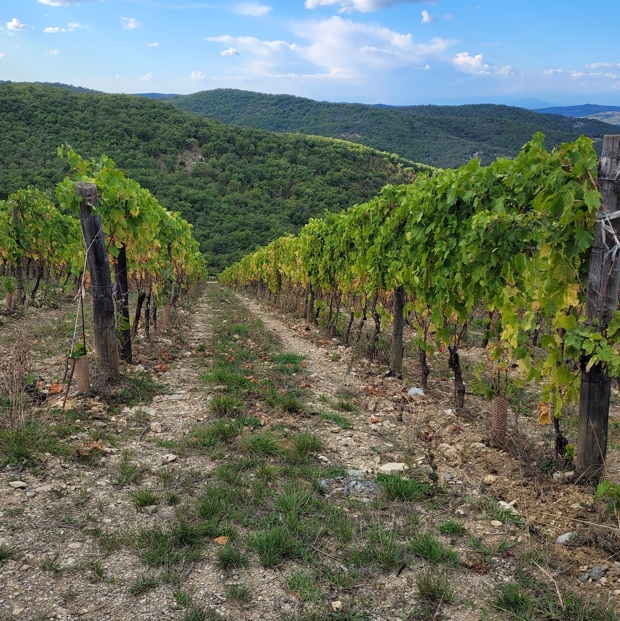
Istine Estate Vineyard, Radda
Istine Chianti Classico DOCG 2019
Radda and Gaiole
Made from the first pass in all of Angela Fronti’s vineyards, two in Radda and three in Gaiole, although the philosophy is to concentrate on Radda because that is the home-front and there is a prejudice provided by what happens through the vintage. That said Angela waits a full year before deciding where the grapes end up, as “the most objective approach.” A decent yielding vintage comparatively speaking and a Chianti Classico in 2019 as generous and round as Fronti has ever made. But in truth the Radda plus Gaiole freshness times savour multiplied by sapidity results in a quotient of great cumulative respect. Drink 2022-2025. Tasted October 2021
Istine Chianti Classico DOCG Vigna Istine 2019
Radda
One must have to look at, walk this and stand in awe of of this vineyard, the steepness at 30-50 per cent grade with a terrace in the middle to break it up. Heavy in Alberese inclusive of massive yellow calcareous boulders and also Galestro. In fact the medium stones removed were transferred to create terraces for olive trees on the other side of the cantina (by Angela Fronti’s father no less). The vineyard faces north so the freshness is off the charts, while the ripeness is so matter of purposeful vintage fact. The label represents the position of the vines in coordinates, echoed in the machicolations of a Fronti sangiovese that drops all the Radda stones on unsuspecting palates through fruit openings between supporting acid corbels of a projecting tannic parapet. Vigna Istine is at the forefront of Chianti Classico’s battle to win over the world. Follow this example. Drink 2023-2029. Tasted October 2021
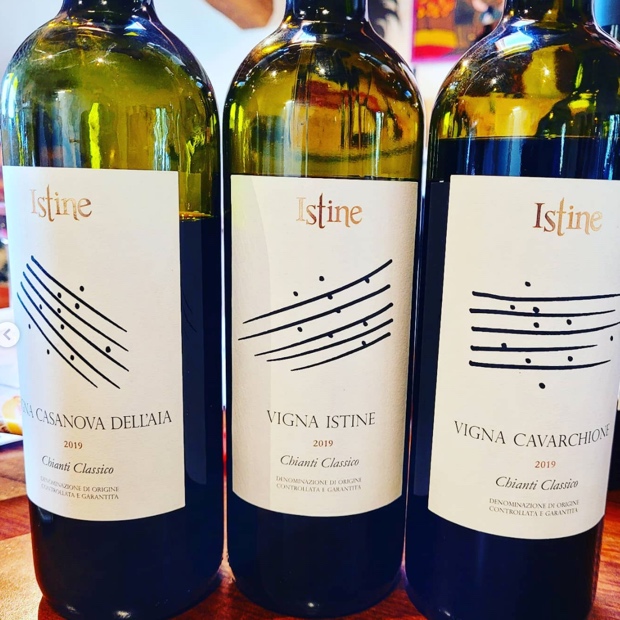
Istine, Radda
Istine Chianti Classico DOCG Vigna Casanova Dell’Aia 2019
Radda
Smaller stones in Alberese and Galestro soils, in Radda, a four hectare plot where trebbiano and malvasia bianca are also planted. The older plantings, their clones and density were not up to snuff so Angela restored and re-planted several years ago. The vines are just now coming into Raddese fruition. That zonal acidity is wholly unique and really shows through in this single-vineyard sangiovese, even if the breadth, complexity and power are not yet there, though elegance, charm and great possibility surely are. Look to 2021 for high end results. Drink 2022-2026. Tasted October 2021
Istine Chianti Classico DOCG Vigna Cavarchione 2019
Gaiole
Less rocky than the Radda vineyards, here a single steep block surrounded by forest everywhere and picked ahead of Casanova, therefore for 2019 in mid-September. The richest of the single vineyard Classico crus, a wine of texture, integration and qualcosa di Cavarchione, a fullness and a feeling of Gaiole woods, herbals, distillate and brush. The under, over and what’s growing all round. Drink 2022-2028. Tasted October 2021
Isole E Olena Chianti Classico DOCG 2019
San Donato in Poggio
The 2019 has some spice, that much is true and that is the result of selection, ideally suited sangioivese clones and the pH directive brought about by some of Chianti Classico’s finest canaiolo. Fermented in stainless, aged in medium sized oak barrels, but older ones. Has entered a more structured and tannic stage and it may be wondered if that is the norm. Yes tells Paolo, when first in bottle there is freshness and fruit, then after a few months it closes in before opening up again the following summer. Last tasted February 2022
Bottled only one month ago and a vintage that brings a pragmatic smile to Paolo de Marchi’s face, with thanks to good volume meeting even better quality. As a vintage “easier than 2015,” tells de Marchi, “which for Cepparello was a cabernet vintage.” Wink-wink. Here 15 per cent canaiolo intersects with sangiovese for a perfectly timed and executed balance between pH and acidity. “There’s always canaiolo in my Chianti Classico,” says Paolo and the truth lies in the generosity of both aromatics and structure. The 2018 was a more uneven season and the wine it produced is actually quite ready to drink, so why wait on it? The 2019 on the other hand has it all, from a growing period so facile and while more difficult to manage during fermentation (not to mention de Marchi’s battle with pneumonia) the end result is a Chianti Classico emblematic of Olena and one to see evolve slowly over a ten to 12 year stretch. Drink 2023-2030. Tasted October 2021

Casole, Lamole
Lamole Di Lamole Chianti Classico DOCG Duelame 2019
Lamole
The yellow to brown (or tan) label from Lamole di Lamole is the high-toned, highest of UGA acid sangiovese. Even a five per cent of pH balancing canaiolo does not seem to tame the acidity in this lightning red sangiovese. That said the wood brings a creaminess and an accentuation of malic meets morbido texture. Curious Lamole, characterful to be sure. Drink 2022-2024. Tasted March 2022
Lamole Di Lamole Chianti Classico DOCG Maggiolo 2019
Lamole
From 2019 the UGA’s estate coupling of nomenclature and doubling of additional geographic denominational vernacular finds beauty and silk road length. This sangiovese digs deep into the Macigno, Galestro and Alberese for a wide-ranging, multi-layered and form fitting Chianti Classico. Drink early. Drink 2022-2024. Tasted February 2022
La Sala Chianti Classico DOCG 2019
San Casciano
Mainly sangiovese (95 per cent) and merlot in large format wood, because tells oenologist Stefano di Blasi “in general in Chianti Classico we are moving away from small barrels and into large cask.” Gateway sangiovese drug in that there is a plushness, softness and accessibility but also a purity and a San Casciano honesty. If the intention is honourable then you can drink this right now but also five years forward for a most positive result. An exacting wine from La Sala nel Chianti Classico, a comment so suitable for an estate in territorial description. Drink 2022-2026. Tasted February 2022
Le Cinciole Chianti Classico 2019
Panzano
The Panzano work of Valeria Viganò and Luca Orsini travels from strength to strength and while this ’19 Annata was only bottled one month ago it shows the best freshness and right kind of crunchiness here at the Chianti Classico Collection. Indelibly stamped with Le Cinciole and Panzano terroir, a combination of earth and fruit showing as well as any these days. Can’t help but relish the level of tart and eye-popping flavours with an immediacy of early drinking possibility. Terrific Annata in every respect. Drink 2022-2025. Tasted March 2022

Le Miccine Chianti Classico DOCG 2019
Gaiole
Le Miccine is truly, ostensibly and unequivocally Gaiole sangiovese what with the herbs and brush coming straight out of the forests of the UGA’s hills. It is also an Annata of great vintage ripeness, generosity and flesh. Deliciously delivered, well crafted and perfectly suitable for now plus five years forward. Drink 2022-2027. Tasted February 2022
Le Muricce Chianti Classico DOCG Leccione 2019
Greve
Le Murrice is a producer from Greve in Chianti with wines also made from lands north of the territory. The Greve (100 per cent) sangiovese is this Leccione, tart and lactic, old-school yet with a young and promising heart. Lacking some fruit and relies on winemaking to create a Chianti Classico experience, mostly succeeding though not really delivering Greve. Drink 2022-2023. Tasted March 2022
L’erta Di Radda Chianti Classico DOCG 2019
Radda
Same work as is done in 2020 with five per cent canaiolo in a vintage of more body and yet similar soul to the year that will follow. Definitely fuller and just as expansive but a touch rounder in 2019. Was a 25-27 day maceration, a week longer than L’Erta di Radda norm. Was released in September 2021 and will soon be sold through to allow the ’20 Annata to hit the market, likely in June. Last tasted March 2022
Grown together so essentially a field blend and Diego Finocchi likes to use some canaiolo (five per cent) because it adds more pH to the wine, up to 3.5-3.65 compared to the 3.0-3.1 of sangiovese. But just the five per cent because it brings up that pH so that there is a salty sensation on the palate while the sapidity and freshness are guaranteed as well. Diego has also figured out over the last five years to allow his fruit to hang for seven to 10 more days, finding balance and with that extra pH, total harmony in his Chianti Classico. Alcohol is not considered and need not be because balance is everything, as witnessed by this pitch perfect Annata. Co-fermented and in terms of next up for Chianti Classico this is the one you have to try, taste and understand. Of structure that suspends for so long. A Classico epiphany. Only 14,000 bottles made. Drink 2022-2028. Tasted November 2021
Mazzei Fonterutoli Chianti Classico DOCG 2019
Castellina
Fleshy and refreshing will best describe the Mazzei Annata from 2019, a sangiovese-plus example from Castellina well heeded of fruit and looking to be given immediate attention. In return it will offer immediate gratification. Drink now and tomorrow, and tomorrow. Drink 2022-2024. Tasted February 2022

Michael Schmelzer, Monte Bernardi, Panzano
Monte Bernardi Chianti Classico DOCG Sangió 2019
Panzano
Panzano vineyard purchased in December of 2018, of Pietraforte and Galestro. Sala is the name of the property, in conversion to organics and biodynamics, this being the first vintage of this wine from that property. Ripens at or earlier than Monte Bernardi, a place of higher winds and also sun. No stem usage yet in the first year because Michael Schmelzer feels that he needs to get a grip on the place but starting from 2020 stems are in the mix. Comes across like blood orange, a factor of heat and wind, with ripe tannins as a brightness from a young vineyard’s fruit. A sangiovese moving towards complex dynamism yet for now the opposite of cyclical viscous movement, angles rounded and such a crunchy wine. Brightness incarnate. Drink 2021-2025. Tasted November 2021
Monte Bernardi Chianti Classico DOCG Retromarcia 2019
Panzano
A vintage of great fruit and acidity so heavy stem usage and also because Michael Schmelzer learned from a minor mistake in 2017. That vintage had better acidity then anticipated and so more stem use should have been employed. “I love the vintage, though I like the classic vintages more, like ’16 and ’18.” Here the high tannin quality and that acidity is really about as good as it gets. “I want people to think I make great wines but then find out they happen to be natural. It’s not a goal.” Everything is in check and all the edginess is just right there, lift, animal, swarthiness and grip. “Anaerobic winemaking is to me a broken idea. We see this in wines that preserve oxidative character.” And so this is a wine that will not fall apart as it ages. Here an Annata that will go well into ten-plus years. Drink 2022-2028. Tasted November 2021
Montecalvi Chianti Classico DOCG 2019
Greve
A portion is whole cluster somewhere in the 20-25 per cent range, at once a precise number and yet vague enough to not be held accountable. Also a portion left on skins for more than two months time. Clearly a wine in which the winemaker (Tim Manning) held no fear of volatile acidity and this sits well under the threshold. Not exactly a 100 per cent sangiovese because there are some rows of canaiolo and also canina nera but not enough to quantify a percentage. Surely a wine of texture and what feels like a “thickened” acidity meaning there is no sear, certainly not out of fear and as a sangiovese is really quite near and dear. Darker cherry incidentally in a Chianti Classico that feels like tradition albeit new and in a very tactile way. I feel the touch. Last tasted March 2022
Just a lovely, calm and inviting entry into Classico Annata, equalized by a harmoniously seasoned palate w,ell-integrated and equanimous set of sweet acidity and fine tannin. Modern and beautiful, fresh and refreshing, wood a player while also serving to make things whole. Drink early and often. Drink 2022-2024. Tasted February 2022
Montefioralle Chianti Classico DOCG 2019
Montefioralle
Getting to know the eponymous producer Montefioralle’s arch classic and definitive Montefioralle Classico is not easy because when you make so few bottles only a select number of people can actually access to taste. They are now in Ontario and if fortune smiles you will note the stealth savoury character and lithe swarthiness, the candid accessibility and clean groove running throughout. If 2019 is a perfect vintage for this Annata I cannot say but it naturally fits the Montefioralle UGA’s vernacular, softly spoken, in clarity and also humility. What may be referred to athletically as a natural. Drink 2023-2029. Tasted February 2022
Monterotondo Chianti Classico DOCG Vigna Vaggiolata 2019
Gaiole
Dusty in youthful tonality for this 85 per cent Gaiole sangiovese in which canaiolo and malvasia nera bring the extra added seasoning into the multi-endemic varietal mix. Baking spice, of cinnamon and nutmeg, then savouries, by cumin and coriander, finishing with grasses, of stem and hay. Liquid wood salve texture changes the gears, adds to the credibility and creativity, even the complexity. Needs time to try and come together. Drink 2023-2026. Tasted March 2022

Chianti Classico Education in Toronto
Nittardi Chianti Classico DOCG Casanuova Di Nittardi La Doghessa 2019
Castellina
Full juiced, pressed and throttled Annata here from 2019, deep, toasty and firm. All the fruit and more, berries, cherries and plum, tart and dependent on acids for support. That they receive and then some, especially with the level of tannic thrush so purposefully aligned. This is sangiovese that needs the bottle as much as any so oblige and set what bottles you own aside. Drink 2024-2028. Tasted February 2022
Ormanni Chianti Classico DOCG 2019
San Donato in Poggio
Talk about the passion and sangiovese needing the bottle. Thankfully Ormanni and so many Chianti Classico have time. Thankfully the world is opening to a deeper understanding that sangiovese must be given respect and an open-ended line. The dust and the cries in this wine need to settle, the tannins calm down and the fruit be allowed to shine. It is there, all red leathery, juicy and tart, finishing on a quivering astringent string note. Bof Compte A Rebours. Drink 2024-2029. Tasted March 2022
Panzanello Chianti Classico DOCG 2019
Panzano
High level of volatility surrounds and distracts from quality richness in fruit aching to be heard. Panzano does not often exhibit this high level of VA and so the maceration here went on just a bit long, followed by a pressing off that brought some angst along for the ride. Drink 2022-2023. Tasted March 2022
Pasolini Dall’onda Chianti Classico DOCG Pio 7 2019
San Donato in Poggio
Here from San Donato in Poggio comes a lovely if modern sangiovese augmented by “other varieties” but the push-pull, acid-pH balance seems to be a blessing of canaiolo in disguise. Merlot likely, as well if in addition to another international party due to the verdant and creamy swirl running through the blood orange and sanguine expression of this wine. Either way this is strawberry-cherry San Donato in Poggio as filling in a savoury polenta cake. Drink 2022-2025. Tasted March 2022
Pensieri Di Cavatina Chianti Classico DOCG 2019
Castelnuovo Berardenga
The sangiovese from Castelnuovo Berardenga is always another animal, openly fragrant, expansive and then deep on the palate. Just look at the place and then it would be impossible to wonder why. Pensieri di Cavatina’s is just this, full of air, sandy-salty and then fruit that layers in leathery roll-up style. Thought the tannins were just a bit gritty but they roll along and cover the fruit with equally proper style. Good work here and one to really consider. Drink 2024-2028. Tasted March 2022
Poci Chianti Classico DOCG 2019
Radda
Poci is located in the southwest corner of Radda in close proximity to parts of Castellina, Castelnuovo (Vagliagli) and also Gaiole. A unique location and one to inspire characterful if singular sangiovese. There is a warmth and a depth to this ’19 Annata, and an affinity with Brancaia in the way it combines freshness with that depth. There is a good amount of chew here in a wine to really sink your teeth into. Seems a bit toasty now but that should settle down before too long. Drink 2023-2027. Tasted March 2022

Winemaker Alyson Morgan, Podere Capaccia, Radda
Podere Capaccia Chianti Classico DOCG 2019
Radda
Not only is 2019 an über fresh Annata vintage but see where is lands when tasting it side by side and each with the previous ’18 and before that ’17, both of which remain just about as fresh as they were last year and the one before. The level of aromatic concentration here is simply off the charts, olfactory opening and mind expanding. That said you feel the botti still, something that has melted away from the others even while their fruit remains fully intact. Part early life and part bigger vintage but ultimately the bar is raised and the 2019 is just a gorgeous wine. Flavour and texture work in cahoots to carry the load and allow this Annata to exhale and then inhale for several years of confidence and pleasure. Drink 2023-2027. Tasted March 2022
Podere Castellinuzza Chianti Classico DOCG 2019
Lamole
Lamole perfume straight away, up front and knowable, floral but more so a matter of herbs and fungi, legumes and grasses all mulched into an aromatic potpourri. Silky and savoury, a sangiovese of clarity with thanks to vintage mainly, serving to accentuate but also openly calculate a sense of place. Drink 2022-2025. Tasted February 2022
Podere Cianfanelli Chianti Classico DOCG Cianfanello 2019
Greve
From Greve and understandably so, fruit well developed, ripe and full, good depth overall. Not overtly aromatic yet a broad potpourri emits. Quite concentrated, pressed and tannic. Traditional and knowable. Drink 2023-2025. Tasted March 2022
Podere La Cappella Chianti Classico DOCG 2019
San Donato in Poggio
Ah the beauty and grace of San Donato in Poggio and in these Rossini hands a stunning 2019 Annata. Aromatic elation, exultant floral lift and mineral euphoria. Fruit so stylish and defined, a dignity of stone and elements run through, nothing out of place, all following a line as if on a circle. A wine that always comes back to where it started while fleshing and gaining traction, picking up subtleties but most of all concentrating in succulence. While the expression is clearly San Donato in Poggio, Podere La Cappella’s particular limestone terroir just can’t be missed, especially in an open and generous vintage such as this from 2019. Juiced orange, bloody, tart and health affirming, bled white stone and a soil gifting purity speak pure Colombino. There is so much to love and appreciate about the grace in this sangiovese. This is Bruno and Natascia Rossini’s land and style. Drink now and whenever, even forever. Drink 2022-2029. Tasted February and March 2022
Podere Lecci E Brocchi Chianti Classico DOCG 2019
Castelnuovo Berardenga
From Castelnuovo Berardenga and dramatically so, big and open hearted, well filled with red fruit syrup of sangiovese liqueur. Lots of pressing here, concentration and some heavy, weighty and full tannins are the result. Drink 2023-2026. Tasted March 2022

La Locanda Di Pietracupa, San Donato in Poggio
Poggio Al Sole Chianti Classico DOCG 2019
San Donato in Poggio
From San Donato in Poggio and a sanguine mix of iron and orange, mixed soil sensations and really quite classic frazione feels. Builds tannins, climbs, develops and shows off its range. Plenty of wine her, quite exemplary and designed to hold steadfast for up to five years. Drink 2023-2026. Tasted March 2022
Poggio Bonelli Chianti Classico DOCG 2019
Castelnuovo Berardenga
Poggio Bonelli’s Annata from 2019 is quite advanced and so ready to drink as if a three or four year-old sangioivese were in your glass. Earth and musky animale lead the aromatic front with a minor amount of Brett to naturalize and synthesize with the chewy red fruit. Acids are sour-edged and follow right in line. Drink 2022-2023. Tasted February 2022
Pratale Chianti Classico DOCG 2019
San Casciano
Gets neither brighter nor further blessed of red fruit than this star of San Casciano. No missing the mineral element neither, in fact there is a schist, marl and river stone stream running through the plush and succulent fruit in this stellar example of Classico sangiovese. Good tannic delivery at the end is tart and drying yet properly austere. Drink 2023-2027. Tasted March 2022

Principe Duccio Corsini, Villa Le Corti, San Casciano
Principe Corsini Le Corti Chianti Classico DOCG 2019
San Casciano
A “complicated spring,” tells Duccio Corsini, not an overheated summer and good harvest, done before the end of the first week of October. Good yielding though for Le Corti it rests at just under six tonnes per hectare, well below the appellative “disciplinare,” i.e. production code. Sealed under Diam #5, classically Le Corti river stone savoury, with five per cent colorino. Full textured while maintaining the Corsini seasoning and San Casciano vim. Succulent acids, lengthy tannins and early integration. Especially for 2019, urged on by aging in concrete tanks. Drink 2021-2025. Tasted October 2021
Pruneto Chianti Classico DOCG 2019
Radda
Seems to be the Pruneto Annata vintage we’ve all been waiting for. Such sangiovese air and breaths of freshness are welcome with arms and palates open wide. Great fruit man, pure cherries and then this feeling of distillate. Crisp and fresh with Raddese acidity and also herbology safely tucked within. Approach with naïveté and also know that aging is within the communal cards. Drink 2023-2027. Tasted February 2022
Querceto Di Castellina Chianti Classico DOCG L’Aura 2019
Castellina
Similar to the upcoming 2020 in that the heavy prevalence of Alberese soil wants to take control, even at the Annata level. A 2019 of wild berry, balsam and full peppery piqued sangiovese seasoning and enough freshness if rounded in ways that make for a most accessible Annata. Already evolving ever so slightly this way and it is said that L’Aura rounds by wood, if on a scale so incrementally minor as compared to 2020. Truth be told this is as much like Radda than it is Castellina. Border proximity and elevation are responsible for this very fact. Drink 2023-2027. Tasted February 2022

Winemaker Manfred Ing, Querciabella, Greve
Querciabella Chianti Classico DOCG 2019
Greve, Gaiole and Radda
Changes are in the air as always in perpetual and forward thinking motion and felt with most palpable readiness of promising concern in the Querciabella Annata. A wine of amalgamation, a triad of territorial delivery, each contribution as valid and poignant as the next. More to the point is how the grapes arrive and are poised to compliment, layer and celebrate each other. A wine of balance but understanding is a deep and wonderful thing. Note the brush with places, the layers of elevation and fluidity from red fruit flavours through textural tranquility. Seriously, serious and not so much. Just knowing, ready and willing to please. Last tasted February 2022
As always 100 per cent sangiovese from Radda, Greve and Gaiole, most of its life spent in larger format casks. At this point 25-30 hL with what would be even more purity extracted were there 50-70hL sizes involved. The level of transparent concentration is at what feels like the peak of Querciabella Annata. Every vintage is different and requires so much attention and that detail for fine tuning is so indelibly and intensely pitch elegant captured in the generosity of this wine. Clearly a balance in the vineyards but also in how here they layer and come together. Really young, tannins wound and yet not so compact, fruit singing with sliding scale through three communes in succession. Drink 2023-2033. Tasted November 2021
Quercia Al Poggio Chianti Classico DOCG 2019
San Donato in Poggio
From 2019 the Annata is über savoury, of pine forest and a sangiovese with 20 per cent other endemic grapes that take turns delivering herbs, underbrush, wild herbs and forest mulch. Finer tannins even if the wine is tight after all those aromatics emitting from the wine. This is the epitome of a sangiovese in Chianti Classico form needing time, not just in elévage but also in the bottle. Drink 2024-2028. Tasted November 2021
Ricasoli 1141 Brolio Chianti Classico DOCG 2019
Gaiole
Like the ’19 Riserva tasted last month in Firenze there is a rounded and getable nature about the Brolio Annata that just speaks to a combination of vintage and place. That being 270 hectares of well thought out Gaiole intendment, including in Monti where the grapes should help create harmony in Ricasoli’s biggest volume Chianti Classico wine. Can’t miss the Gaiole savour, herbals dried and also sweet, fruit layered from five distinct soils, each contributing and forming the basis for a pentangle of sangiovese righteousness. All in all a great modern era formula that would make the Iron Baron Bettino Ricasoli proud. Last tasted April 2022
Ricasoli’s ’19 is really quite open, gregarious, sumptuous and available. A magical blend of five terroirs and one to enjoy with just about anything in the here and now. Certainly shows a sour cherry and red citrus angle caused by elevated volatility but that’s where the food will come in. Drink 2022-2025. Tasted February 2022
Riecine Chianti Classico DOCG 2019
Gaiole
Grande Gaiole compass, cinch and girth in naturally swarthy sangiovese from Riecine in 2019, crunchy and tart. Inching up towards the volatile but such is the word in pace for the vintage. The fruit can handle the stark reality and veritable truth, equipped with grip and ready for the inevitable circumstance. Maybe wait a year for further resolution. Drink 2023-2027. Tasted February 2022

Rocca delle Macìe, Castellina
Rocca Delle Macìe Chianti Classico DOCG Tenuta Sant’Alfonso 2019
Castellina
From the second property purchased by Sergio Zingarelli’s father Italo in 1973, the largest of the four estates, a place of clay and at times wet soil. Much higher tones and acidities than the Famiglia Zingarelli, in the Castellina air as opposed to mulched in the sottosuolo below. More specific, 100 per cent sangiovese and rounded out by fruits of all ilk; fresh, dried and everywhere in between. Drink 2023-2026. Tasted February 2022
Rocca Di Montegrossi Chianti Classico DOCG 2019
Gaiole
As calcareously tight and wound like a wire around a steel coil this Annata 2019 may be there is something other here, a feeling immediate, insightful and profound. Not just any sangiovese from Montegrossi and perhaps the vintage to explain a Gaiole notion for appellative Chianti Classico DOCG wines. A blend of 88 per cent sangiovese, (10) colorino and (2) canaiolo. A reminder that Marco Ricasoli makes this and he makes Gran Selezione with no Riserva bridge and so at the Annata level there is great fruit, observation and intent. Yes it’s true that three years minimum in bottle are required to release the hounds of charm, but the sangiovese here has done its work silently and the result is a ’19 we can depend upon. Domestic and secure, a wine of warm diplomacy that will certainly bring people together, even those of differing philosophies. Brilliant harbinger for the vintage and what’s to come from the community at large. Grande, once again. Drink 2024-2032. Tasted July and November 2021
San Fabiano Calcinaia Chianti Classico DOCG 2019
Castellina
Rich and chalky, red fruit glare in the classic Castellina way and quite structured for a 2019 Annata. Drink now if you must and with some air this will open, release and please but two years will do well to soften the edges and also integrate the wood spice. Drink 2023-2026. Tasted February 2022
San Giorgio A Lapi Chianti Classico DOCG 2019
Castelnuovo Berardenga
Flawed. Acetic well above 1.0, in fact this is acetic 1.0, likely upwards of 1.5 in volatile acidity. Hard to find any fruit or nuance as a result. Certainly no sense of Castelnuovo Berardenga. Drink 2022. Tasted March 2022

Tasting with Luca Martini di Cigala and Silvia Fiorentini at San Giusto a Rentennano, Gaiole
San Giusto A Rentennano Chianti Classico DOCG 2019
Gaiole
“For us it was a bit different than the rest of Chianti Classico,” explains Luca Martini di Cigala. “There was a big hail in July, delaying ripeness and three layers of green harvest was necessary, to reduce yields and allow the plants to regenerate.” Meant for a late pick that finished on the 16th of October. The final count was 20-25 per cent down yet there are very few Chianti Classico that combine aromatic concentration, flavour complexity, textural glycerin and compaction of tannin like this. Every part of the cherry and cool herbals persist throughout. Prompts the question as to when Luca first saw signs of climate change, events and extremes. Luca’s response is that he realized something was not right in 1998, when the skin of the berries were burned by the sun. In 2017 the vintage brought early frost and then dry heat, with the coming 2021 being another frost year yet again. Drink 2022-2027. Tasted November 2021 and February 2022
San Leonino Chianti Classico DOCG Al Limite 2019
Castellina
Direct spike of red lightning Castellina fruit in a right proper and openly fragrant, upright, generous and perfectly seasoned ’19 Annata. The fruit soars like an eagle, takes it as far as Annata will go. Lovely texture and generous mouthfeel. A wine senza limite. “So put me on a highway, and show me a sign. And take it to the limit, one more time.” Drink 2022-2025. Tasted March 2022
Stomennano Chianti Classico DOCG 2019
Castellina
Stomennano’s western Castellina sangiovese is not merely one that delivers a juicy, fleshy and red citrus bleed but even more the kind that speaks to terroir as much as any in the UGA. This Annata screams Galestro, clay accessibility mixed with grippy schist. Literally smells and tastes like calcareous clay, wet and stony, like Villages pinot noir from Santenay, in a way, but sangiovese is sangiovese and yet this can be consumed just about any day. Drink 2022-2025. Tasted February 2022
Tenuta Di Campomaggio Chianti Classico DOCG Campomaggio 2019
Radda
Herbal and tight, creamy and yet austere. A wine of disparate parts, true Raddese acids and a true altitude crunch. Fruit is substantial and invigorating, overall emotion kept in relative check. Bounces around and about so it will interesting to see where this will land. Drink 2023-2026. Tasted February 2022

A winemaker, an angel and two ambasciatori walk out of a bar ~ Il più grande piacere to taste, talk, break bread and resurrect with these heroes amongst us, @seanilguercio and the King. Sangiovese, maneuvers and the Lucarelli cuisine.
Tenuta Di Carleone Chianti Classico DOCG 2019
Radda
In 2016 the two entities of Karl Egger’s Tenuta di Carleone and Brit Séan O’Callaghan’s Il Guercio combined and they took over Podere L’Aja’s Radda vineyards, opposite Vertine. Retroactively it was 2015 that was the first vintage of Chianti Classico (made by Istine’s Angela Fronti) and then in 2016 O’Callaghan made his first as oenologist and winemaker for the project. “I make one Chianti Classico because I have to and I want to,” tells Séan. That said it is a sangiovese that does not pass the tasting panel at first try but eventually the slightly elevated volatility gets under the skin and lifts the spirit. Light? Not really but luminescent and a true scintillant of sangiovese. “The most important wine we make,” he adds, “because it’s the one that needs to grab your attention.” My goodness this is Niagara bench-land Bachelder pinot noir/gamay but in Radda! Crunchy and perfectly stemmy from 30-35 per cent whole bunch and two to three months maceration, depending on the vineyard. The lightest and elegant and fresh go into (the 100 per cent sangiovese IGT) Uno and everything remaining from Radda goes into the Chianti Classico. And yet this is light so Uno will be even lighter! Approximately 42,000 bottles are produced. Drink 2022-2026. Tasted March 2022
Tenuta Di Lilliano Chianti Classico DOCG 2019
Castellina
Nine months later and full confirmation guaranteed. Pretty and red fruit fleshy in a 2019 Annata with full compliment and support by those sweet lightning Castellina sangiovese acids. Just what to except, appreciate and even adore in straightforward, linear and crispy Chianti Classico for now and up to five years. Perfectly executed in lithe style by Lilliano. Last tasted February 2022
The just released Ruspoli 2019 from western Castellina in Chianti’s Tenuta Di Lilliano takes off where the most amenable 2018 sangiovese left off and runs with the great vintage vibe. A traditionally blended Annata with five per cent each colorino and merlot, for old and newer school bookending and with this stacked vintage in pocket there will be some drawing upon the state’s track record for aging Annata level Chianti Classico. Ruspoli is an aristocratic family from Rome (and palace of the same name), but is originally from Florence. Giulio and Pietro Ruspoli are the proprietors of Lilliano and it was Princess Eleonora Ruspoli Berlingieri who first bottled Lilliano’s wines in 1958. This is just beautiful appellative sangiovese, full of ripe Castellina fruit balanced against a backdrop of inviting territorial acidity and sweet, sweet tannins. The essence of sangiovese is brought straight to the surface with immediate gratification available in a wondrous example that may not need any further development time in the bottle. Drink 2021-2025. Tasted May 2021
Tenuta Di Nozzole Chianti Classico DOCG Nozzole 2019
Greve
Quite the herbal hyperbole here from Greve, pine forest and the resin oozing off the trees. Syrupy in the mouth, thick red liquidity in sangiovese that draws the aura of the land, lends it sweetness and thickness its plot. It’s a soup metaphor for a reason. Drink 2022-2024. Tasted March 2022
Tenuta Orsumella Chianti Classico DOCG 2019
San Casciano
Really firm San Casciano sangiovese from Orsumella though the grip and also depth are in cohorts with quite the impressive vintage gather of fruit. You sense realism and intention in this wine, nothing overdone or gone too far. There is something strong and in charge for sure though everything is about structure and controlled longing. Impressive across the board. Drink 2022-2025. Tasted March 2022
Tenute Squarcialupi La Castellina Chianti Classico DOCG Squarcialupi 2019
Castellina
For the record The Squarcialupi Codex (housed in the Biblioteca Medicea Laurenziana) is an illuminated manuscript compiled in Florence in the early 15th century. It is the single largest primary source of music of the 14th-century Italian Trecento (also known as the “Italian ars nova”).The first of two Tenute Squarcialupi Annata out of Castellina is the one more textured, of glycerol and subjected to pectinization. A hematic and ferric depth is noted in the way a sanguine current runs through this sangiovese and it just feels like it comes from red earth. Fluid and structured, serious in a way but surely composed. Really well made wine. Drink 2024-2028. Tasted March 2022
Tenute Squarcialupi La Castellina Chianti Classico DOCG Cosimo Bojola 2019
Castellina
Further to what must be a connection with the Squarcialupi Codex, the first folio in the codex states: “This book is owned by Antonio di Bartolomeo Squarcialupi, organist of Santa Maria del Fiore.” On the following pages, added later, are humanistic poems in praise of Squarcialupi.” The second of two Tenute Squarcialupi Annata out of Castellina is this Cosimo Bojola, lighter, brighter and less texturized as compared to the Squarcialupi. Also more serious in the intensity of the elements, minerals and currents that run through, while also grippier, compact, linear and streamlined. This is the one that reminds of Bourgogne of a high-caste village and if any Castellina wine indicates where it comes from, this focused Cosimo Bojola is that one. My goodness. Drink 2024-2029. Tasted March 2022
Terreno Chianti Classico DOCG 2019
Greve
A very specific quadrant of Greve is accessed and acquiesced in Terreno’s Classico Annata, not shy but yes restrained, upwardly mobile and with an understanding of how to reach markets old and new, young and old. A great family member this Terreno, hospitable and generous, open and yet respectful of traditions, acquired and also introduced. Best Annata ever for the house. Drink 2022-2026. Tasted February 2022

Chianti Classico rocks
Tolaini Chianti Classico DOCG Vallenuova 2019
Castelnuovo Berardenga
Some merlot augments the sangiovese in this Castelnuovo Berardenga Annata and it shows in the lithely verdant plus creamy smoothness noted, from nose to palate. Also a 2019 of more tannin than many, felt and understood as the wine dries away with classic sangiovese austerity. Savour, acidity and brushy flora are all there, up front and at the finish. Drink 2023-2027. Tasted February 2022
Triacca La Madonnina Chianti Classico DOCG Bello Stento 2019
Greve
Bello Stento, literally “hardly beautiful” is just a perfectly traditional example of Chianti Classico, especially in Annata form, finding a modernity of freshness, accessibility and beauty without compromise or giving in to trend. Aromatically brushy and Amaro herbal while also in delivery of real glycerol and sap running texture. Neither crunch nor chew but something in between. Drink 2022-2024. Tasted February 2022
Vallepicciola Chianti Classico DOCG 2019
Vagliagli
Always fulsome, concentrated and so well developed, texture in sangiovese defined, climbing to syrup and jam but staying just shy of that consistency. Concurrently and expressly Vagliagli, hinting at the volatile and again remaining comfortably in check. Very blood orange and red currant with mineral earth running through the wood flavours. Drink 2022-2025. Tasted March 2022
Vignamaggio Chianti Classico DOCG Terre Di Prenzano 2019
Greve
Perfect medium weight and sweetly initiated entry into Classico is just this from Vignamaggio’s multi-terraced, tiered and controlled Annata 2019. A sangiovese plus parts thereof in varietal addendum to squeeze ripenesses and pack them in like punch. Fills by barrel and parts equalized amount to an easy CC that knows just what to do. Simple and forthright. Drink 2022-2024. Tasted February 2022
Viticcio Chianti Classico DOCG Vendemmia 54 2019
Greve
Not on the lighter side of Greve so near to Monterioralle per se but surely a Classico picked and rendered in a fresh, come and get it style. That said there is some mild peppery jolts mixed with spiciness that shows up both on the nose and also the palate. Continues into some sangiovese austerity with dried herbs and drying tannin at the finish. Drink 2022-2024. Tasted February 2022

Chianti Classico Experience, Restaurant Education
Chianti Classico DOCG 2018
Bindi Sergardi Chianti Classico DOCG La Ghirlanda 2018
Vagliagli
A beautiful and open-knit Mocenni Annata from 2018, not exactly lithe or shrinking but already quite available at this time. That said the acidity is in full control and while the tannins are ones of grip and fortitude they sidle in and connect with the other constituent parts. Further to that this is a wine that continues to roll forward, collecting matter and growing in stature and as a result complexities. Ok enough about that. Last tasted October 2021
La Ghirlanda is the Bindi Sergardi Annata from the Tenuta Mocenni (estate) in Castelnuovo Berardenga and if any one single bottling from Alessandra Casini Bindi Sergardi should act as the spokes-wine, this would have to be it. The authentic and exacting sangiovese of full regale and ornamentation, the ”garland,” celebratory Chianti Classico of purpose for proprietors and place. Pulls from Mocenni’s Alberese and Galestro, managing structure while exulting succulence of fruit. The most getable and beautiful Chianti Classico Annata is here, bright and balanced. So ready to be taken advantage of which might act contrary to sangiovese messaging but do not fear because enough Alberese meddling equips this 2018 to offer its best through the middle of the decade. Drink 2021-2026. Tasted May 2021

Ser Gardo, Bindi Sergardi, Vagliagli
Bindi Sergardi Chianti Classico DOCG Ser Gardo 2018
Vagliagli
I Colli Estate’s Vagliagli vineyards abutting the Chianti Colli Senesi are the source and so different to that of the Mocenni amphitheatre. A higher pH and a lessening of acidity make for a silky smooth and lush Classico. The 2018 is a perfumed vintage, with brushy herbs and local flora. So much more perfume, lovely florals and a resolution of the tannins into the middle points and parts of the wine. Beautiful work with one hundred per cent sangiovese to express this southwestern corner of the Vagliagli sub-zone. Lastt asted October 2021
Ser Gardo, sibling to La Ghirlanda, both Annata wines but here from Bindi Sergardi’s I Colli estate. Same Castelnuovo Berardenga zone but slight alteration in soil. Still the Alberese but less Galestro. Not as glycerin and luxe as Ghirlanda and even with a lighter to easy vintage like 2018 there is little doubt that sangiovese like this will need some time. The sensation taken here is lime-chalky, sapid in nature, less give and more demand. Not seriously tense but a year would assist in softening the grip and integrating the lighter 2018 fruit. Seemingly more traditional, herbal and savoury sangiovese to be sure and yet always with that post-modernist’s Bindi Sergardi thick brushstroke of style. Drink 2022-2027. Tasted May 2021
Cantalici Chianti Classico DOCG Baruffo 2018
Gaiole
Baruffo the dog, one of twenty currently on the property. Baruffo the 100 per cent sangiovese of increased concentration, richness and breadth as compared to the blended Cantalici. Ages for one year in 20 hL barrels, plenty of development for what is a late-picked, fully reasoned and seasoned Annata. Will resolve and show its best in two years. Another step forward taken, consistent within the estate style. Drink 2024-2028. Tasted February 2022

Carpineta Fontalpino Chianti Classico DOCG 2018
Castelnuovo Berardenga
Castelnuovo Beradenga’s Carpineta Fontalpino farms vineyards at the estate and also in Montaperti plus Dofana within the Vagliagli UGA of the commune’s western butterfly wing. Winemaker Gioia Cresti so magically and intrinsically marries the mix of fruit for a classico that resides apart from her cru sangiovese. Low yields for Annata off of mixed clay, sand and also (Alberese) limestone come from mixed elevations between 380-420m picked across the entirety of the month of September. A true stacked ferment concept, an honest and exemplary estate wine to get right at what Cresti and her estate are all about. Gioia is a cru fanatic but this sangiovese really matters. The succulence, salumi meatiness and forza della natura are all you need to know about her skills, humility and humanity. Drink 2022-2027. Tasted November 2021
Castello Di Radda Chianti Classico DOCG 2018
Radda
A unique and particular vintage, unlike others in the recent past or what would come from 2019. More important is how here at Località Il Becco along with nearby Il Corno the conditions were so different from the rest of the territory. Arid and warmer in this area, making for dry, tight and plum dusty sangiovese, even a bit austere. The warmth has not resulted in density of concentration as it might in some other vintages, take 2015 as an example. While it may be missing the sweet harmony of 2019 there is a clear message of Raddese acidity and likely a good long life ahead. Last tasted March 2022
A sangiovese from Radda in Chianti that in Annata form and out of a vintage that requires less time in order to express its terroir. The vineyards are located in the lower part of the valley, below the Macigno sandstone and away from the more calcareous eastern and southern sections. This is the place of “formazione geologica particolare,” a schisty area where Galestro is common. A very pretty version of Castello di Radda’s sangiovese is exactly this, crispy and spicy, acid circulating and turning the fruit from soil earthy to creatively succulent. Crunchy too and ready for immediate work, best to match alongside grilled Tuscan sausages, eggplant and zucchini. Drink 2021-2024. Tasted April 2021
Fattoria Cigliano Di Sopra Chianti Classico DOCG 2018
San Casciano
Still a good leesy reduction to start, wine of extraction and in the third year so different from before but not yet in discovery of the balance and especially tannic extraction. The wine has come into a much better place, the tannins have lost much of their astringency and the wood has melted in. Drinking well right now. Last tasted November 2021
From a place (San Casciano) that gifts perfume but in the most savoury of ways. There too is a deep red darkness to the fruit and here the full advantage of 2018 is taken into consideration. Everything here is done with acumen intention, including maceration, pressing and extraction. The redundancy effects the outcome, restricts the subtleties and brings immediate gratification. Fourth vintage for the estate’s young winemakers and expect two steps forward from 2019. Drink 2020-2022. Tasted February 2020
Fattoria della’Aiola Chianti Classico DOCG 2018
Vagliagli
Has lightened through linear design and really shows that it was not a vintage of great generosity. More so one of savour and direct impression though now feeling a bit closed. It’s a phase and should resume an open door policy from late ’22 through early ’26. Last tasted February 2022
The field work put in by the team at Fattoria della Aiola in the most challenging 2017 vintage pays double dividends with the ease and amenability of ’18. The Annata arrives from low in the valley below Radda where the location looks easterly through the true Castelnuovo Berardenga UGA. If that ’17 carried the air of refreshment and lightness of Castelnuovo sangiovese then get a whiff and a taste of this ’18. Sharp, tight, composed, finessed and always shining bright. The depth of fruit and structure is magically subtle, hidden in shadows and at present allowing the pleasure factor to reign supreme. There is grip and determination behind that pretty scene and so some sangiovese longevity is surely promised. Drink 2021-2026. Tasted August 2020

Fattoria Le Masse, San Donato in Poggio
Fattoria Le Masse Chianti Classico DOCG 2018
San Donato in Poggio
First vintage with new (large format) wood and it shows on the nose, from the vineyards in Morrocco, a land totally different from Le Masse’s estate lands. Not exactly like the Classico soils of Galestro and Alberese but still rocky, hard soil that drains easily and very different than Chianti nearby. Solo sangiovese, land directed, soil funky, fresh and vital. Partially fermented in wood tanks, a touch Bretty and notable tannic. Needs to and will settle in nicely. Drink 2023-2027. Tasted October 2021
Fattoria Montecchio Chianti Classico DOCG ‘Primum Line’ 2018
San Donato in Poggio
Montecchio’s 2018 has come around, having strayed away and found how to amortize, acclimatize and ultimately prioritize what needs to settle and feel just right. A textural, liquid San Donato in Poggio red soil, Ligurian wind and stony sangiovese if ever there was, rounded by grapes that soften, including in their colour. A lovely drop at this age and perfectly present day drinking Annata. Drink 2022-2024. Tasted March 2022
Fattoria Pomona Chianti Classico DOCG 2018
Castellina
Sold out already and truthfully a carbon copy, albeit lighter on its Castellina feet, of the Pomona Vineyard Gran Selezione. In this case fruit comes from Sant’Ilario and Vigna del Termine vineyards. Here in Annata terms with readied, steadied and intuitive ease. Different and dual vineyard impart and more elastic movement than the GS but also the two vintages that came before. Crafty Classico, of a caring knowable in the idiosyncratic Pomona stability of style. A smaller vintage than 2019 to come but says Monica Raspi, “such is life.” Drink 2021-2026. Tasted October 2021
Fontodi Chianti Classico DOCG Filetta Di Lamole 2018
Lamole
No one picks before October 10th in Lamole and Fontodi’s Filetta was the last. Always is, that’s the pecking order and Giovanni Manetti’s cousin who owns the vineyard goes back to 1045 in Chianti Classico, the oldest in recorded history. That Lamole perfume is unmistakable, with all the character of Lamole and the palate structure of a Fontodi wine. Bigger than most in Lamole and yet more graceful and caressing than those of the Conca d’Oro. As complex and fine as Filetta can be, ushering in a new level of deeper understanding, resolution and completion for Manetti and Lamole. A harbinger for the great and symbiotic relationship between Lamole and the vintage, leaving an impression that says this is the Unità Geografiche Aggiuntive place to be in 2018. Drink 2023-2031. Tasted October 2021
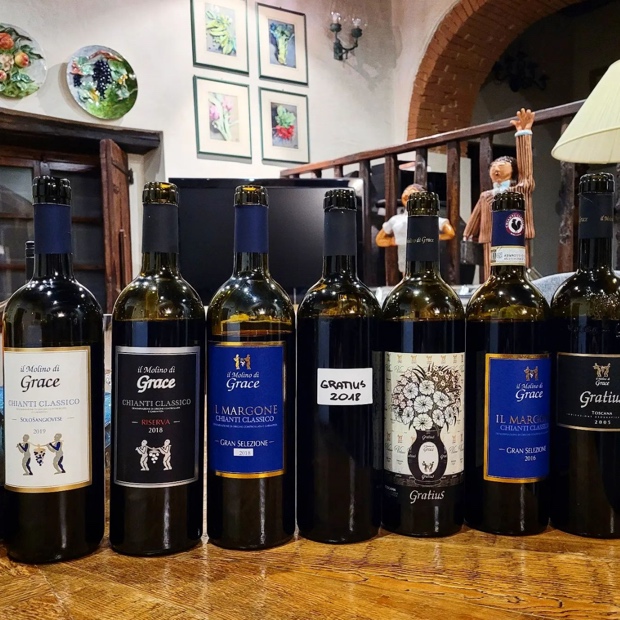
Il Molino Di Grace Chianti Classico DOCG 2018
Panzano
Great freshness in abundance and despite some critical vintage theory there is so much to find in a Panzano Annata like this from Il Molino di Grace. Piquancy and an open door policy, classicism for the UGA in an ideal snapshot and Chianti Classico profile. Memory recalls the violet perfume and purity of fruit when tasting this 48 hours after it left the vine. Nothing has been lost or sacrificed to virtue or clarity in solo sangiovese that begs to be seen, heard and tasted. Will require less time than some vintages, to ready itself for piacevolezza e gustosità. Drink 2022-2026. Tasted October 2021
Le Cinciole Chianti Classico DOCG 2018
Panzano
Le Cinciole’s 2018 benefits from two things: Less than heavy vintage result and one extra year in bottle to soften the Panzano-Galestro tannins notably present in this chalky wine. Red schisty-clay-limestone consistency, texture and presentation with high toned, lifted and red citrus behaviour. Quite a vintage snapshot mouthful in emotion but never heaviness. Still a bit oak dominant which should pass in another year or so. Drink 2023-2026. Tasted February 2022
Le Fonti Di Panzano Chianti Classico DOCG 2018
Panzano
Every time I taste a Le Fonti sangiovese there is instant recognition of Panzano but even more so the north and northeast oriented vineyards of Vicky and Guido’s fine, fine estate. This from ’18 is purely, expressly and unequivocally Le Fonti. Cooler, more linear, precise, focused and intentional than broader Panzano and surely a child of craft, the chase and chaos. Bravo Guido, brava Vicky, thank you for this honest act of Chianti Classico humility and humanity. Drink this every day. Last tasted March 2022
In Vicky’s world “a very alcoholic year,” hot and dry but an expected extreme. Came out at 15 per cent with great fruit to counteract and balance this out. Light chalkiness and long chains of tannins, full palate exposure and much pleasure to find. Picked between the 28th and 3rd of October so took all and full advantage of a late September Panzano 25-plus degree fluctuation of daytime heat spike to nighttime lowest lows Therefore not hard to know what to attribute the alcohol to, relating to evaporation, humidity or anything else that happens when grapes flash develop that late in the season. Drink 2022-2026. Tasted October 2021
Lornano Chianti Classico DOCG 2018
Castellina
The year is 2022. The vintage of this Lornano Annata is 2018. Why is it in this glass and being assessed is anybody’s guess. “Sangiovese needs the bottle,” is said with a shrug and the simple utterance remains etched in mind forever. Nicolò Pozzoli said this five years ago, well before this wine was even a twinkle in his Lornano eye. The vinous, herbal essence and essential oils have yet to integrate. The tannins have to assimilate and the wine knows not yet where it will go. Or perhaps it does and has chosen to stay quiet, in slumber and protected. When it emerges there will be the same classic Castellina cool and savoury sweetness as ever. The vintage will offer this gift of Lornano. Drink 2024-2028. Tasted March 2022
Nardi Viticoltori Chianti Classico DOCG 2018
Castellina
Nardi’s 2018 is purely and confidently Castellina sangiovese, richly glycerin, sweetly herbal and parochially viscous. This is Castellina red fruit incarnate, croccante, seamlessly woven with fine if understood acidity and gentle, equally getable tannins. An Annata meant for putting in your glass, anytime, anywhere. Last tasted March 2022
Nardi in Castellina in Chianti is found below Lilliano and Macìe covering an area of forty hectares of property. Ten are vineyards and the rest is divided between olive groves, various crops and the farm for breeding Chianina cattle and Cinta Senese pigs. The work of Angelo and Giacomo, sons of Enrico. Their striking ’18 Annata scintillant is 90 per cent sangiovese plus five each canaiolo and colorino. It is truly Classico marl-Galestro Castellina, bleeding cherry red fruit, acids that travel up and down the sides and then further serve to circulate the succulent and juicy fruit as it moves around the mouth. It’s the full sangiovese from a specific commune allowed to shine experience. Dictionary entry, spot on and satisfying. Drink 2021-2026. Tasted January 2021

Podere Capaccia, Radda
Podere Capaccia Chianti Classico DOCG 2018
Radda
Winemaker Alyson Morgan uses only large format cask to age her Annata and like the previous 2017 this 2018 comes from an arid and very warm vintage though not quite as extreme. That ’17 is still so fresh and this ’18 is outrageously youthful, not closed but vinoso, cinnamon dusty and giving this feeling of sangiovese scorrevole. In other words it clings to but also slides as if tethered to the inside of the mouth. Acid level is still strong and yet supportive with thanks to how and when the grapes are chosen to be picked. If ’17 is chewy then ’18 brings the crunch, easy to say when you know that ’19 will fall harmoniously in between. Drink 2022-2025. Tasted March 2022
Podere Castellinuzza Chianti Classico DOCG 2018
Lamole
Lamole with an extra year’s settling is always a wonderful plan especially when executed with precision to a cumulative point of no return. Castellinuzza’s Annata is at exactly that place and is that place, a perfumed frazione sangiovese of well-ripened and judged fruit, floral tones both under and over. Succulent and textured if just a bit green, not unusual and in fact concurrent, at least at times here and there, with the UGA’s way. Drink 2022-2026. Tasted March 2022
Quercia Al Poggio Chianti Classico DOCG 2018
San Donato in Poggio
Youngest vineyards are 15-20 years old so they are all able to defend themselves in dry or challenging vintages. An average year really and not all the grapes are picked to be bottled, making sure to always maintain quality. All the vineyards contribute to the Annata, even some from Vigna Le Cataste, the 1997 planted vineyard, two sides over two valleys, argiloso on north side and Galestro to the south. Mostly 500L tonneaux with new 28 hL botti installed two years ago. “Organic with biodynamic undertones.” All five wines smell so completely different. Up to 20 per cent are mixed endemic grapes, including 10 of ciliegiolo, plus canaiolo, colorino and malvasia nera. Adds up to a multi-national and savoury blend, a parochial gathering that layers a true sense of place, dusty, plum peppery and a true sense of forest airs in this wine. Good weight, balance and length. Drink 2022-2026. Tasted November 2021
Renzo Marinai Chianti Classico DOCG 2018
Panzano
Marinai’s Panzano is one of the richest, most fruit cumulate sangiovese of the UGA’s lot. From 2018 there is warmth, development, spice and Amaro viscosity. Viscidity too, rightfully tacky while also full of gems and precious metals. Such a Panzano delight, full and ropey, resistant to sheer forces and ready for the main course. Drink 2022-2025. Tasted March 2022
Tenuta Casenuove Chianti Classico DOCG 2018
Panzano
Crunchy Panzano Annata here from Tenuta Casenuove, peppered as opposed to peppery, as if with freckles or micro-sized bits of earth. Plenty of salt and pepper seasoning but again nothing sharp or spicy about it and fruit so very berry red. Last tasted March 2022
From the southwest corner of Greve in Chianti, southwest of Montefioralle and close to Panzano. Modish and modern for 21st century sangiovese is just this, stylish, chic and highly motivated. Quite fully developed and felt red fruit of glycerin, pectin and mouthfeel but you want more and more. Impressive magnitude in bringing so much fruit into the mix. Not overtly high in acid or tannin so use this early and often. Drink 2020-2022. Tasted twice, February 2020

Val Delle Corti Chianti Classico DOCG 2018
Radda
Picked at the end of September and into the first week of October after a stretch of time from which humidity rose at night. There were some problems with mould and insects. And so the early picking (for Radda) lent finesse and Radda acidity for some of the Classico’s light and direct wines. Yet another moment of diversification from UGA to UGA and vintage to vintage. This is not a massive sangiovese of alcohol and grosso attitude. This is exactly the opposite, while 10 minutes drive away in Panzano some wines are big and bullish, pushing and exceeding 15 per cent alcohol. Last Tasted October 2021
Roberto Bianchi’s steep hillside slope is where he farms a quietly dramatic terroir to conjoin or congiungere with Radda’s many high elevation localizzazione. These once not long ago too cool for ripening sangiovese vineyards are now the place to be and Bianchi takes full account, responsibility and risk to make the most of his new world Chianti Classico possibilities. Long macerations are often over 45 days, even longer for Riserva, though in this easy and lighter vintage perhaps not quite so long. Still there is a development of texture, glycerol and the finest tannins in his glistening sangiovese. The inescapable Raddese acidity shines just as bright, carries the light and infuses the pure compound cherry genere with a hyper real sense of varietal and location. As they say, posizione è tutto. If Chianti Classico is the future, the man who might be dubbed double B has delivered an Annata già arrivato. Drink 2022-2027. Tasted September 2021
Villa Di Geggiano Chianti Classico DOCG 2018
Vagliagli
Geggiano’s Vagliagli Annata is just a baby, like the faces of the brothers Bianchi-Bandinelli, charismatic, timeless and chiseled. The forces of Galestro and Alberese nature conspire to equip this linear and focused wine with the necessary attributes for an impressive run through sangiovese life. As for now focus on the seamlessness of the structural ascension and a fruit quality so pure it can only plan to be there every step of the way. The ten year Annata run is special and that is this Geggiano’s plan. Drink 2024-2030. Tasted March 2022
Villa Trasqua Chianti Classico DOCG 2018
Castellina
Here in the year of her majesty 2022 a look at the 2018 vintage for this Trasqua Annata is so early. And yet here it is in this glass and so here goes nothing. The Castellina company knows its terroir and understands that sangiovese must take it slow, ease into grace and away from structural pain. Trasqua’s is like the curious case of Castellina, born as an old soul then transversing through life into middle age, adulthood and finally youth. An inverse Classico relationship with time, crisp, crunchy and crusted now, so very tannic and four years away from settling into comfort. Drink 2025-2030. Tasted March 2022

An American and six Canadians at La Sala, San Casciano
Chianti Classico DOCG (older vintages)
Cantalici Chianti Classico DOCG 2017
Gaiole
Sangiovese blended with 15 (merlot and cabernet sauvignon) and the “international” one, less aggressive and pure than the varietal Baruffo. As Chianti Classico the character augmented by Cassis, smoke and bell pepper changes the approach and then the result. Smooth, round and creamy while truth be told there is still a Gaiole sentiment running through. Drink 2022-2024. Tasted February 2022
Carpineta Fontalpino Chianti Classico DOCG Dofana 2017
Vagliagli
The Dofana stone is sandy, more Arenaria then Macigno, with Alberese and clay. Faces southeast at 350m, planted to new clones of sangiovese, as opposed to Montaperto. All adds up to a sangiovese cru of musculature, great if slightly austere tannins, fleshier, cherries of deeper maceration and profound tang. All parts are raised, elevated, punchy and there is an intensity that really makes one think and feel. The vineyard was acquired in 2004, now at the point of Gioia Cresti having come to really understand the make-up, to claim the future of the wine, for what is going to happen. The classicism of needing to give sangiovese time is entrenched into Dofana, around which “the corners in this wine are personality,” tells Filippo Cresti. A wine to watch what happens with 12 bottles over the years. Even 30 years. Dofana’s tannins are that tight and compacted, even from arid 2017. Drink 2025-2037. Tasted November 2021
Carpineta Fontalpino Chianti Classico DOCG Montaperto 2017
Vagliagli
A grey to light yellow calcareous plot, mainly Alberese facing northeast at 420m. Even in 2017 it will not get much more elemental and linear, balanced, fresh and the definition of an elegant cru-designate Chianti Classico. The oldest vines are 40 years and the vineyard is re-planted in stages, slowly, Bordeaux style. All sangiovese, remarkably bright, getable and cool. Hard to find more of this ilk from the aridity that 2017 gave to the territory’s vines. Drink 2022-2027. Tasted November 2021
Le Fonti Di Panzano Chianti Classico DOCG 2017
Panzano
More or less picked at the same time as 2018 (18th to 28th of September), give or take a few days and while the alcohol is felt more than in 2018 there is also a dry extract elevation and less grip as a consequence. More peppery spice and wood sensation, here in an Annata of tightly wound impression. Drink 2022-2025. Tasted October 2021
Podere Capaccia Chianti Classico DOCG 2017
Radda
Only sees Grandi Botti, allowing the wine to breathe and expresses the appellation’s purest form. Has kept its fruit and energy without a moment of change since last tasted 25 months ago. Seriously no evolution, acting fresh as the day it was first popped. Represents top structure in Annata. Last tasted March 2022
Things turn brighter in a sangiovese like this from Radda, not so much lighter as one from which fruit can shine. Light in terms of tannin but sneaky enough to elevate and extend. More chew than crunch in a pressed fruit roll-up carnival of the heart ’17. Drink 2020-2024. Tasted February 2020
Villa Di Geggiano Chianti Classico DOCG 2017
Vagliagli
Spiced to the hilt which is neither shock nor surprise from a pair of Castelnuovo brothers and their newly minted Vagliagli UGA. Men who allows allow and encourage their terroir to speak in clarity, regardless of vintage and no matter the circumstance. Warm and luxe, deep and profound, an exegesis of structure delivered by grapes of local, traditional and serious concern. Last tasted February 2022
Truth be told this 2017 from Geggiano persists as a youthful and too early to call Annata. The particular Galestro and Alberese in these micro-climate championed western wing of Castelnuovo vineyards make for some of the communes’ most charming meets structured sangiovese. Why should the heat and the challenge effect anything otherwise. So much here, so many levels of Chianti Classico to unfurl. Drink 2022-2030. Tasted February 2020

Alberese, Il Palagio di Panzano
Il Palagio Di Panzano Chianti Classico DOCG 2016
Panzano
Includes fruit from the San Martino Vineyard, composed of Galestro, rich in iron, morphologically very different to the soils around the winery. Spends 12 months in large format casks, followed by 12 months in bottle. As an Annata Palagio’s is released late, certainly as compared to most in the territory. Still firm with notable tannins and yet to be resolved structural elements. There is a dryness on the upper palate, a case of clones and soils, still a closed door to the grace and possibility of this wine. There are grapes coming from the oldest (late 1980s planting) part of the vineyard and beginning in 2017 these grapes will all move to the old vines Rosato. This will mark a profound change in not only style but accessibility, especially for the Annata. Last tasted October 2021
Upon further consideration, thoughts drill down and clarity comes into more micro view, six months after last tasting and 14 months after first tasting PdP’s 2016. It took some time but now the perfume is pure Panzano and in this case, right at the heart of the village. The essence of a northeastern corner of Conca d’Oro sweet savour, a purity and a concentration of sangiovese that carries the culture and tradition of its fruit, safely and securely. The tannins here are sneaky, creeping in, aiding and abetting, for longevity. This should become one of the longer lived Annata of the vintage. Last tasted November 2020
Only sangiovese as is the plan for the entire estate. That Panzano perfume and glycerin though there is some more weight and bones than others. Reminds of the style that’s constant from Fontodi to be honest. These are some of Chianti Classico’s finest acids, sweet and refined, They compliment and support. Drink 2021-2027. Tasted September 2019 and May 2020
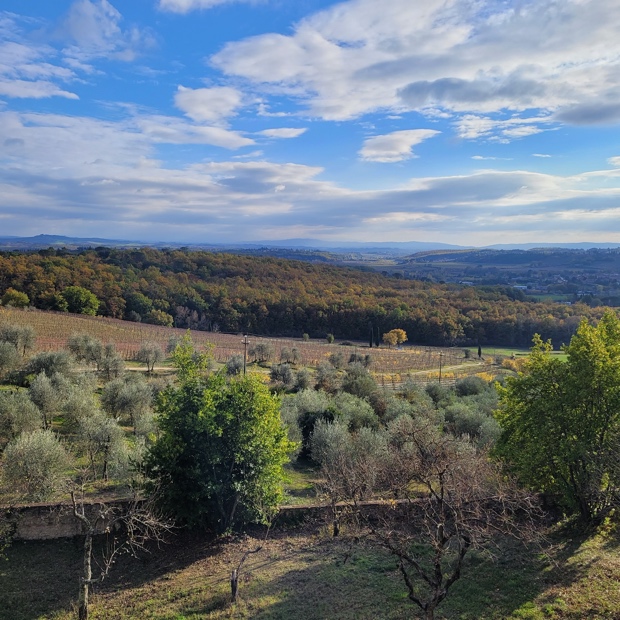
Looking south towards Castelnuovo Berardenga from San Giusto a Rentennano, Gaiole
San Giusto A Rentennano Chianti Classico DOCG 2016
Gaiole
For Luca 2016 is a true sangiovese vintage, equanimous from start to vintage and one from which the terroir and territory take control of the grape. Indeed this is Chianti in ideal if not the purest perfection of Classico form, deeply transparent and matched by an honest to greatness inner mineral wave in full command. There is a sense of blood orange but also red currant and ripe cherry. A classic year in which the ample but amenable tannins allow for early access but also plenty of time ahead. Drink 2022-2032. Tasted February 2022
I Fabbri Olinto Chianti Classico DOCG 2014
Lamole
Even back in 2018 ands 2019 there was already something intuited for the beautiful, ulterior and even ethereal if much maligned 2014s and more than anything a sense of wonder to see how well they could age. Now in 2022 enough time has passed to take deeper judgement and if I Fabbri’s Olinto is any indication then the vintage will deliver many quality wines for many more years to come. The Lamole perfume is front, open, lifted and centre. The sangiovese has only moved forward to a place where the classicism of Greve’s amphitheatric frazione stands right before us. Susanna Grassi has done it again, as she always does, filling her wines with realism and grace. This Olinto is in a really great place. Drink 2022-2026. Tasted February 2022

Full tasting of San Giusto a Rentennano, Gaiole
San Giusto A Rentennano Chianti Classico DOCG 2013
Gaiole
Not an easy harvest with recurring rain, on repeat from what happened during the spring. In a way like 2014 but the weather was much more fortuitous in between. The liveliness and grippy acidity wrapped up in persistent tannin keeps this a bit closed and two years further should really open things up. Incredibly fresh sangiovese and that specific San Giusto blood, part orange and part sanguinity. Will be just right around the corner. Drink 2023-2029. Tasted February 2022
San Giusto A Rentennano Chianti Classico DOCG 2012
Gaiole
At the outset there is some animale, a cooked rabbit per se, a smaller animal, not bovine or porcine. such a curious and complex aromatic swell. In the vintage a big rain arrived at the beginning of September but not all of the vineyards were able to recuperate from the long dry spell and as such the tannins are a bit dry. That said they are settling now and it has taken this much time to get to this point. The fruit shines, the wine is just now in its window and while hydric stress clearly played a role there is much to gain at this time. Drink 2022-2027. Tasted November 2021

Cantalici Baruffo 2011
Cantalici Chianti Classico DOCG Baruffo 2011
Gaiole
Holding the fort and going strong for a 10-11 year old sangiovese, same vineyard and specs as the ’18 tasted side by side. This was the third vintage labeled Baruffo, though the present day Cantalici dates back to 2002. Yes, still in very good form, notes surely secondary, tannins almost fully softened, some tartufo just emerging now. Far from oxidative, acids really quite sweet and true blue cool savour fully in charge and control. The finish is truly enjoyable, neither drying nor cloying, but with frutta seco and long, menthol cool. Drink 2022-2025. Tasted February 2022
I Fabbri Chianti Classico DOCG Terra Di Lamole 2010
Lamole
A blend of sangiovese and canaiolo, acid and pH in cohorts for a Lamole of true timeless terroir and of a time when the naked transparency of the frazione could never be denied. Not that hiding Lamole in 2022 is a thing but the linearity, stark reality and absolute transparency of the day is on full display from Susanna Grassi’s 2010. That and the barrel she would have augmented Terra di Lamole with to create a kind of Selezione for the time. Now in the waning stages with thanks to a warm vintage when such a thing was not the average or contiguous norm. Drink 2022-2023. Tasted February 2022

With Winemaker Manfred Ing, Querciabella, Greve
Querciabella Chianti Classico DOCG 2010
Greve
Immediate waft of frutta di bosco from what was Manfred Ing’s first vintage at Querciabella, having arrived on the 3rd of May. An auspicious start because it rained the entire month. The heat never came and even in retrospect the team will say it was the worst vintage ever. Guido di Santi was in charge of winemaking (and in a way still is). The season continued despite the rains and lingered well into the fall. Was also the year new cement tanks and wood vats arrived for fermentation, plus the inaugural one as a 100 per cent sangiovese. Only four months into his tenure Ing urged the team to wait longer before picking. The fact is that’s all sangiovese needed and usually needs. Time. So now 11 years forward the cured salumi style of Chianti Classico is just what this is pleased to be. A vanishing point of previous stylistic expression for a future that began with the advent of a new unfolding story. Not much fruit to talk about but plenty of Ruffoli and gastronomic pleasure in many ways. Well matched to Fuoripiazza Ristorante Enoteca in Greve. Drink 2021-2024. Tasted November 2021
Conti Capponi/Villa Calcinaia Chianti Classico DOCG 2009
Montefioralle
Holding firm and quite well for an 11-plus year old Annata from a vintage not too dissimilar to what is coming from 2019. Bodes well for Capponi’s ’19 and so many kin. This retrospective look feels so very Montefioralle with the addition of down by the river Greve alluvial silt and clay deposit generosity. Airy yet grounded, high-toned yet also able to go baritone. Linear yet well-rounded, freshness in acidity persistent while never getting too high. A wine to sit down with, learn some history and stay in the present. Drink 2022-2024. Tasted February 2022

I Fabbri, Lamole
I Fabbri Olinto Chianti Classico DOCG 2009
Lamole
Full disclosure: This bottle has been open for 20 hours and by every logical sense of reality and the imagination should be lost to the nether world of sangiovese days gone by, but alas no! Susanna Grassi’s 2009 is glorious and texturally rounded, not to mention aromatically lifted and sound. The secondary elements are gracious, delicious and firmly entrenched in next level structure. There is no sense of demise or decline and as a vintage the overall sensation is one of climb, ascension and incline. Brava e grande Susanna. Drink 2022-2025. Tasted February 2022
I Fabbri Chianti Classico DOCG Lamole Olinto Grassie E Figlio 2009
Lamole
The Lamole label is a different animal than the Olinto when it comes to a retrospective look side by side with the Olinto 2009. More wood, evolution and secondary bleeding into tertiary character but most of all this cinghiale-animale note that can’t be denied. Earthy and hematic, a tale of brush, porcini and the sauce reduced after slow cooking the shoulder, hours later and complex. Lamole herbal, perfumed and fine. Past prime but a window into the recent past. Drink 2022-2023. Tasted February 2022
A vintage from which the tannins seemed very hard and needed a long time to improve. Actually shocked at how this has yet to truly evolve, with almost no oxidation or dried components. No frutta secco or bosco but yes glycol and Amaro. Silken and mineral, as Luca’s sangiovese (with varying percentages of canaiolo and colorino always are). Will still drink beautifully for six to 10 years further. Drink 2022-2028. Tasted February 2022

Villa Calcinaia 1975, Montefioralle
Conti Capponi/Villa Calcinaia Chianti Classico 1975
Montefioralle
Tasted as part of “Il Chianti Classico in 9 Decadi” led by Filippo Bartolotta with Giovanni Manetti at Stazione Leopolda in Florence at the Chianti Classico Collection. TCA. A matter of clay and limestone and in Calcinaia’s vineyard the type of stone is Colombino, not rare but highly specific to certain Chianti Classico vineyards. Looking past the TCA there is a wild strawberry sense of fruit that while stymied and suppressed there is a persistence and longevity in this forty-seven year old wine. Truly sangiovese with mineral scents and an unkempt wildness about its disposition. Tasted March 2022

Barone Ricasoli Castello Di Brolio Chianti Classico 1949
Gaiole
Tasted as part of “Il Chianti Classico in 9 Decadi” led by Filippo Bartolotta with Giovanni Manetti at Stazione Leopolda in Florence at the Chianti Classico Collection. The oldest wine in the flight. apropos and just when you consider the Ricasoli heritage and lineage. A mineral layering which instinctively mimics the compaction of argiloso, macigno and calcari from Brolio’s soils, no longer feeling the separation or mille-feuille effect but now just all morphed into one and the same. There were surely some white wines in this mix, as per the formula written decades earlier by Bettino Ricasoli. Probably helped keep the freshness for some time and while this is now all earth and stone the wine is very much alive. There’s even some sweetness and citrus showing, indicative of blood orange some 73 years later, finishing with a trebbiano and malvasia Vinsanto tang. Tasted March 2022
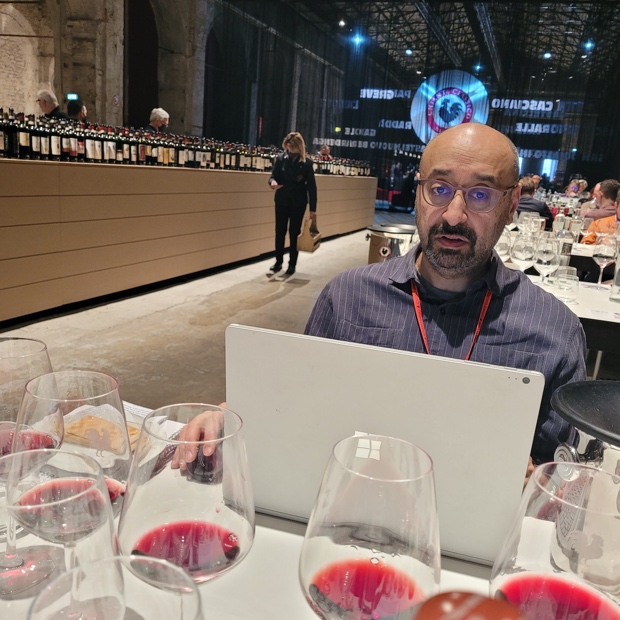
Gurvinder Bhatia, Chianti Classico Collection 2022
Chianti Classico Riserva DOCG 2019
Bibbiano Chianti Classico Riserva DOCG 2019
Castellina
My or should I say man is Bibbiano’s Riserva’s ’19 the most naturally sweet sensation of Castellina fruit that Tommaso Marrocchesi Marzi has ever produced. A well of sangiovese liqueur and liquidity of seasonings, fine spices, Mediterranean and even a bit exotique. I imagine he is most proud of this wine, traditionally Riserva but so above ground, out there and capable of running with his single-vineyard, one side of the estate or other, Gran Selezione wines. Drink 2023-2029. Tasted March 2022
Buondonno Chianti Classico Riserva DOCG Casavecchia Alla Piazza 2019
Castellina
Hard not to appreciate the double entendre in Gabriele Buondonno’s wines, at once big and boisterous with well developed alcohol but then high elevation salty, airy and expansive. They are what they are what they need to be, from his place in Castellina, nearly Panzano in temperament, substantiality and fully equipped with measure. The ’19 is a bit more than tannic so let it rest another couple of years. Drink 2024-2029. Tasted March 2022
Castello Di Albola Chianti Classico Riserva DOCG 2019
Radda
Castello di Albola’s Radda at elevation Riserva is quite tight and compact, especially this early in its assessment. Clearly a wine of Galestro with plenty of Calcari influence, glycol liquidity and just that classic sense of regional liqueur. Quite viscous and generous, tart at this stage with a hint of balsamica. Will settle in and drink with Riserva pride. Drink 2023-2027. Tasted March 2022
Castello Di Ama Chianti Classico Riserva DOCG Montebuoni 2019
Gaiole
“Direct descendant of Castello di Ama Riserva in a return to the appellation with this being the second such vintage. Falling somewhere between the Ama Annata and San Lorenzo Gran Selezione, Ama’s Montebuomi is so very Calcari, regardless of the level of appellation, intensely woven, idealized and structured. Such mineral virtuosity at the Riserva level captured however, linear, vertical and compact. A compression exists by dint of those vineyard soils and also the living and breathing Gaiole terroir. Drying for now, fleshing to come, settling in later. Drink 2024-2029. Tasted March 2022.
Castello Di Volpaia Chianti lassico Riserva DOCG 2019
Radda
Tank sample but a finished wine. Phenomenal poly-phenolics and sensory gifting from a sangiovese 100 per cent in delivery of the Volpaia sweetness of fruit, cool sensibility, silky texture and equally tactile tannins. If a hole or an unresolved moment exists it would be impossible to unearth and in some ways, at this stage, Riserva is almost readier than Annata. But that shouldn’t really be possible with the grapes coming from the same vineyard, here in the upper part. The winemaking is exceptional and the vineyard’s voice is perfectly heard. Drink 2023-2029. Tasted October 2021
Fèlsina Berardenga Rancia Chianti Classico Riserva DOCG 2019
Castelnuovo Berardenga
A bright, lightning red fruit and herbal oil Rancia Riserva here in ’19, working through pine and cedar, rosemary, sage and elderberry, fennel too. All the resins are here in their youth, circulating and formulating an exit strategy. At this point the fruit, sweet as it is, is wrapped up in the bramble, impossible to reach without getting bitten by the thorny tannins of this wine. Just wait, and wait some more because there is so much happening and still to come. Drink 2024-2032. Tasted March 2022
Gagliole Chianti Classico Riserva DOCG 2019
Panzano
Nothing scents like a Gagliole and nowhere in Castellina does this sense of fruit compaction, timed and tidy acidity and then fineness of sweet, evolved and intelligent tannins co-exist. Herbal yet delicately so, dripping and oozing of terroir, spice infiltrate of every zone, pocket and pore. Not sure there can be recalled a Riserva with this much personality and oomph but here it is in all glory. Also not sure there has been an example that needs as much aging time as this generously structure ’19. Don’t touch and return five years forward. Drink 2026-2033. Tasted March 2022
Le Miccine Chianti Classico Riserva DOCG 2019
Gaiole
Le Miccine 2019 is intrinsically Gaiole but also very personal. It feels like and comes with a sensation you will intuit whether or not you taste this wine alongside winemaker (and Québecoise) Paula Cook, or not. What amazing and exceptional fruit from ’19, building and building, fleshing and fleshing in a most beautiful glass of sangiovese Riserva wine. And you can access sooner than many, as you wish. Grande Paula. Veramente. Drink 2023-2029. Tasted March 2022

Diego Finnocchi, L’Erta di Radda
L’Erta Di Radda Chianti Classico Riserva DOCG 2019
Radda
Also a campione da botte, cask sample of 100 per cent sangiovese from a cru, of a very specific terrain. A parcel of Galestro and Alberese on a hillside though here a red earth and where two specific clones of sangiovese are grown. F9 and R4 to be specific, both producing very small bunches. So reminds of Montalcino’s Lorenzo Magnelli and Le Chiuse, in methodology and also result for which an intensely fine acidity defines and directs but here a Raddese variety to which there is no compare. Hard to find Chianti Classico sangiovese more profumato that does not come from Lamole and perhaps its a matter of the in-land, off-shore breezes that blow here and through this vineyard called La Casina. Another cask sample that is so expressive and so close to being ready, in fact they are drawn from their final resting vessel just waiting to be bottled. Drink 2022-2026. Tasted March 2022
Luiano Chianti Classico Riserva DOCG 2019
San Casciano
Luiano’s tannins are variegated in 2019, specific to Alessandro Palombo’s San Casciano terroir, layering sweet, tart, savoury, salty, verdant and even umami notability. The fact that fruit is at the top of the local pyramid and spectrum will ensure a long and slow integration, without angst or difficulty. There will be no stops and starts but only forward movement and development. The overall succulence and incremental oscillations between acid and tannin confirm the plan. Drink 2024-2030. Tasted March 2022
Riecine Chianti Classico Riserva DOCG 2019
Gaiole
Crisp and crunchy like the Annata of same vintage yet less high toned and volatile. Also missing the swarthiness but what it lacks in wild revolution is gains in clarity and purifying resolution. Riecine is in fact a place of resolute and cool wines coming from and speaking the vernacular of mainly old vines’ vineyard ways. Will drink this way for five more and with great complexity on display for a further five. Drink 2024-2029. Tasted February 2022

Sergio Zingarelli, Rocca delle Macìe, Castellina
Rocca Delle Macìe Famiglia Zingarelli Chianti Classico Riserva DOCG 2019
Castellina
Brighter if also possibly lighter than the previous vintage and in such regard a more accessible and amenable Riserva. As with the 2018 the complimentary grapes are five per cent each colorino and cabernet sauvignon, both bringing colour and the latter some black fruit sweetness. Drink this ’19 of lower acidity, lees brood, depth and easier feeling for now while the ’18 continues to settle in. Drink 2022-2026. Tasted February 2022
Rocca Delle Macìe Chianti Classico Riserva DOCG Sergioveto 2019
Castellina
Rocca delle Macìe delivers the most substantial fruit to texture compendium that can be recalled from recent and even further back then recent memory. The fact that there is this iron-mineral swell and hematic underbelly being so strongly involved with the fruit means so much more than before. A magnanimous Rocca delle Macìe in the present that will surely become a Castellina of vim, relish and layered attraction in the future. Drink 2022-2025. Tasted March 2022
San Felice Chianti Classico Riserva DOCG Il Grigio 2019
Castelnuovo Berardenga
Still the current climate and execution for juicy freshness, of fruit on the berry, pomegranate and plum scale but also Castelnuovo dried herbs running amok. More chew, of liquorice namely and then the juiciness returns, persists and delineates the direction of the wine. No shock this is a very good Riserva vintage, one that will age well, not more than 10 years mind you and best between four and seven from vintage. Drink 2023-2026. Tasted February 2022
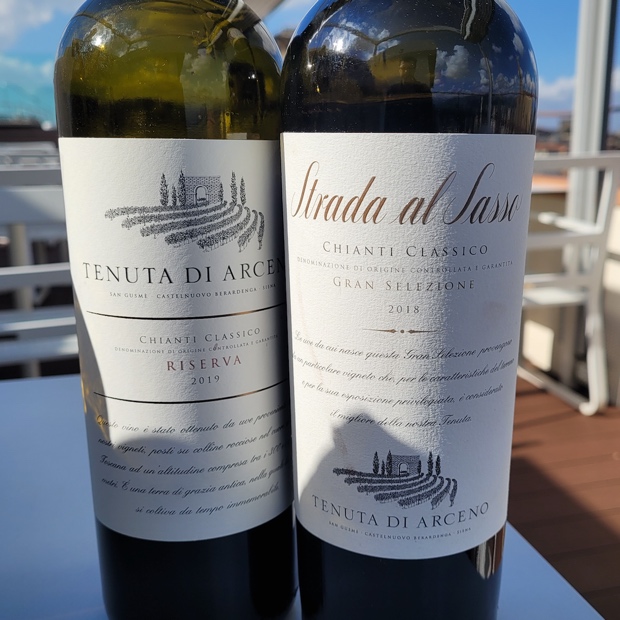
Tenuta di Arceno, Castelnuovo Berardenga
Tenuta di Arceno is located in San Gusmé, a hamlet of 250 people in the far eastern part of the eastern butterfly wing of Castelnuovo Berardenga. It is a Jackson Family Estates property with Lawrence Cronin was hired as the Winemaker in 2002. Here we are 17 years later with an Annata to perfectly represent this part of the territory with dark and compressed fruit, full on Berardenga savour and a sandy-stony-clay composite feeling. Not a sentimental sangiovese but one entrenched in realism and depth. Drink 2023-2027. Tasted February 2022

Enoteca Fuori Piazza, Greve
Chianti Classico Riserva DOCG 2018
Ambrogio E Giovanni Folonari Chianti Classico Riserva DOCG Nozzole 2018
Greve
From Greve in Chianti and a representative sangiovese not just for commune but also for the appellation. Truly Riserva in capture, rich and luxurious, fully complete in texture and for mouthfeel, concentrated and strong. Carries an estate and greater authority credibility in consistency throughout the years and were you to close your eyes you could guess 1998, 2008 and then 2018. Actually big for the vintage which indicates a late September pick inclusive of a hot spell during which nighttime temperatures did well to preserve acidity. Listed at 14 per cent though feels higher. Drink 2022-2026. Tasted November 2021
Bibbiano Chianti Classico Riserva DOCG 2018
Castellina
Next step, level and terraced sangiovese appreciation comes from Bibbiano’s Riserva, a wine of high tones, lightning fruit along with well versed and rehearsed Riserva lines. Linear that is, vertical and promising, not a promiscuous sangiovese but one that considers its time, place and future with profound regard. Juicy to be sure and also grippy for to see seven years forward and a softer time arranged. Drink 2024-2028. Tasted February 2022

Mocenni, Bindi Sergardi, Vagliagli
Bindi Sergardi Chianti Classico Riserva Calidonia DOCG 2018
Vagliagli
Calidonia is surely the more structured of the Bindi Sergardi Riservas, weighted in fruit, lifted by the succulence of Alberese drawn acidity and showing what this Mocenni sector of Vagliagli is capable of demonstrating. The 2018 is Bindi Sergardi’s Riserva of fortitude, not just in opposition to brothers and sisters but also as compared to several recent vintages. It requires time and will live for 10 years or more. Last tasted March 2022
Calidonia’s is like I Colli’s power though not in strength but rather in depth. Immense depth, a gathering of all the vineyard’s stone mineral wealth, of Alberese, Galestro and Macigno at the confluence of Mocenni’s amphitheatric crossroads, with Radda and Castellina so near by. The beauty of fruit and exquisiteness of tannins are so evident, no matter how youthful this wine may be and so the future exists in a manner quite the matter of already knowable guarantee. Drink 2023-2029. Tasted October 2021
Bindi Sergardi I Colli Chianti Classico Riserva DOCG 2018
Vagliagli
A solo I Colli Estate Riserva, from vineyards in the UGA zone of Vagliagli at the western edge of Castelnuovo Berardenga commune. The vines are planted 10 kilometres away from Bindi Sergardi’s Mocenni Estate and like the home vineyard counterpart this mimics if extends from Annata but with elevated acidity and also power. This bottle could not have been in Ontario more than a week or so and so it seems a bit closed, unwilling and perhaps in a minor state of shock. The previous one tasted at the winery took off where Annata left off but truthfully Riserva is higher in acidity and power but without hitting one hard, more about strength of character. Once again the sweet flowers as in Annata but of course . Drink 2021-2024. Tasted October 2021.Never the matter because Vagliagli’s florals, sweet scented and candied fruit, high tonality and grippy sub-structure are all locked in tight. Captures the late September pick but just before alcohol levels would have risen, here for a harmonious and graceful turn of Riserva phrasing. Drink 2022-2027. Tasted October and November 2021
Brancaia Chianti Classico Riserva DOCG 2018
Radda
Brancaia’s munificent and substantial ’18 Riserva grabs texture by the scruff of its neck and introduces it to that fruit which can only be described as ripe. Hard to recall recent vintages that do Radda this way, with grip, strength and power. Dark orange to red orange fruit, more blood than naturally orange, big, bouncy and intense. A notably heeded and competitve Raddese wine at the present moment capable of becoming a beautifully attractive Brancaia before too long. Drink 2023-2028. Tasted March 2022
Carpineto Chianti Classico Riserva DOCG 2018
Greve
Classic, distinct and ideal as Carpineto’s Greve Classico, full of brush and local flora, from wild fennel through rosemary and into sage all over the palate. And then the textural composition sets in, running the sangiovese sap of ointment and viscosity through and through the body corporeal of Carpineto’s Riserva wine. This is neither thick nor jammy, shows the land with idealism and while drying at the back end there is plenty of stretched and elastic stuffing to see this age five-plus years. Drink 2023-2027. Tasted February 2022

With Paolo Paffi, Casa Emma, San Donato in Poggio
Casa Emma Chianti Classico Riserva DOCG Vignalparco 2018
San Donato in Poggio
Expectation dictates that a Casa Emma Riserva will deliver true and substantial San Donato in Poggio fruit but double what the Annata chooses to give. That is exactly the point in the ’18 Vignalparco, a blood orange smoothie with minerals running straight on through. Taut, tart, intense, fulsome and ranging in so many ways. Impressive ’18 to be sure. Drink 2023-2027. Tasted March 2022
Castagnoli Chianti Classico Riserva DOCG Terrazze 2018
Castellina
To be honest Terrazze is not like Castagnoli’s Annata, if not because of appellative level then surely a matter of vintage. Riserva is deep, brooding and profound, a sangiovese of acid intensity and fruit compression. More dried and leathery than fresh with plenty of wood spice but also that which is derived from the fruit source, namely the skins themselves. No lack of imagination, drive nor trenchant desire neither. Hard to know exactly where this will go. Drink 2024-2028. Tasted February 2022
Castelli Del Grevepesa Chianti Classico Riserva DOCG Clemente VII 2018
San Casciano
A 100 per cent San Casciano in Val di Pesa sangiovese from schists and limestone, mainly Galestro at 250-350m. Sees 24 months in Slavonian oak and French barriques. A Riserva of concentration and notably healthy pH for sapid texture mixed with dark fruit. Picked late into October so thereby gainful of a mini late September heat wave and converse diurnal nighttime temperature dips for healthy ripeness well foiled by sweetly kept acidity. Moments of verdancy in between swaths of sapid texture and dark chocolate make for a Riserva of diversity and variegation of an overall expression true to San Casciano and also vintage. Drink 2022-2025. Tasted December 2021
Castello Della Paneretta Chianti Classico Riserva DOCG 2018
San Donato in Poggio
As with the upcoming thorough and thoughtful 2019 Annata there is a next level depth of craft and understanding intuited by way of Riserva 2018. The fruit seems so well timed, picked late in the season, developed and yet braced in the moment, frozen in time. Feels cured and dried by cellar air, the vintage captured and preserved. This will live a long life, that much is sure and always drink up on the ridge, with the image of San Donato in Poggio demure in the distance. Drink 2024-2029. Tasted February 2022
Castello Di Albola Chianti Classico Riserva DOCG 2018
Radda
Great fruit Scott or rather great Scott what fruit! Here Albola captures 2018 in Riserva form with great, sheer and utter distinction. Hyperbole of red tree fruit, chew like liquorice and bokser too. Well positioned, proportioned and perfectly suited to all. A five year wine if ever there was. Last tasted February 2022
The ’18 Riserva continues a thread of Radda-Classico consistency for Albola, stringing great wines from 2015 on through. This next Riserva shows excellent linearity and quality, namely at the hands of fine tannins, ripe and thriving, adding pulse and drive to already buzzing acidity. The fruit is well equipped to hang, participate, contribute and collaborate. Warming at the finish suggest spice and an Albola ability to age. Drink 2022-2027. Tasted October 2021
Castello Di Bossi Berardo Chianti Classico Riserva DOCG 2018
Castelnuovo Berardenga
Youthful, high-toned, crisp and crunchy Riserva 2018 here from Bossi. Big Berardenga bones, Classico castello vibes. pomegranate and currants on high alert. Hematic as well, herbal to a degree and full of wood-fruit-acid swirls. Drink 2023-2026. Tasted March 2022
Castello Di Gabbiano Chianti Classico Riserva DOCG 2018
San Casciano
Kind of surprised at how apposite this next bottle is showing. Young and nearly untouchable. not the accessible and easy drinking Gabbiano of last month’s bottle and recent vintages past, here dripping with tonics and concentrated fruit essence tinctures. More herbs too, a swell of minerality and wave after wave of acid-tannin breakers. Wait two years. Last tasted March 2022
Sweet fruit and acids are compelling together in their Galestro-infused succulence and style. Here a Riserva of easy attitude and gratitude, well stretched and showing off the understated Cerelli style. Riserva of humility and humanity, cool and gelid, fine and harmonious. Drink 2023-2026. Tasted February 2022

Castello di Meleto, San Casciano
Castello Di Meleto Chianti Classico Riserva DOCG 2018
Gaiole
So informative to taste Meleto’s Riserva sandwiched between their Annata and Grand Selezione but also as 2018 between ’19 and ‘17. As if on cue Riserva acts, exacts and reacts right up the middle of that Gaiole road, equally rich and parochial, accessible and yet capable of aging, progressing and emerging with potpourri fully captured and kept. Riserva is a perfect compromise and offers the best of both worlds. Drink 2023-2027. Tasted February 2022
Castello Di Monsanto Chianti Classico Riserva DOCG 2018
San Donato in Poggio
A “thanks God cooler vintage” tells Laura Bianchi with an appreciative smile, in which not only the wines but also the San Donato in Poggio vines were able to re-balance. Laura believes it’s not only a vintage of great freshness and acidity but also one that can age well. Classic Monsanto grip as well, though style, flavour and sophistication of ripeness, plus an energy inherent as a factor of brightness and vitality. A great educative study involving a sangiovese of both incandescence and longevity, two things seemingly apposite but binary by definition. Knowing what Bianchi’s Monsanto can do there is no question about the possibilities that lay ahead. Drink 2022-2029. Tasted October 2021 and February 2022
Castello Di Querceto Chianti Classico Riserva DOCG 2018
Greve
Something about Greve’s Dudda Valley brings a distinct and higher level of aromatic concentration to sangiovese, especially in Chianti Classico Riserva form. This from 2018 is one of the the lighter, effusive and more lyrical ones with so much emanation of perfume. Still a savoury character with knowable rattle, tone and hum. Plenty of desire and hope with a good six to eight year run ahead, making this a perfect little mid-term cellar dweller at an attractive price. Drink 2023-2028. Tasted January 2022
Castello Vicchiomaggio Chianti Classico Riserva DOCG Agostino Petri 2018
Greve
Everything about the Matta family’s 2018 Riserva screams late picked fruit in early October. After the late September day heat and nighttime lows, there’s just so much of all parts set to full in this wine. Wild and exotic perfume, fruit fleshy and so bloody ripe, body more muscular than this Riserva sometimes shows and alcohol well-developed. All are in synch, balance and complimentary condition. Crazy delicious Agostino Petri this time around with classic values and traditional character kept in a true Greve style. Drink 2023-2026. Tasted January 2022

A Count in his natural habitat – Sebastiano Capponi, Villa Calcinaia, Montefioralle
Conti Capponi/Villa Calcinaia Chianti Classico Riserva DOCG 2018
Montefioralle
Not all Riserva are created equal and if nothing else Sebastiano Capponi’s could only be his from Montefioralle at Calcinaia. Not exactly sweet natural fruit endowed but surely herbal and the kind of Riserva that takes stock of your senses, sticks to your tongue, leaving behind an impression that will not dissipate. Even if you never take a second sip you are left with a Greve left bank, over the hills and far away into Montefioralle impression. “Maybe more than enough.” Nearly fulsome and yet wound quite tight, tannins not so much drying as compounding by land and zeppelin temper for a ride off into the proverbial sunset. Get the led out with this one. Drink 2024-2029. Tasted February 2022
Dievole Chianti Classico Riserva DOCG Novecento 2018
Vagliagli
Dievole is located within the newly minted Chianti Classico UGA Vagliagli and is in fact situated as close to the village as just about any estate. Clay, marlstone and limestone in Alberese soil holds the fort for a 95 per cent sangiovese with small amounts of equally endemic canaiolo and colorino. Spends time in no toast 41 hL French casks for upwards of 18 months and in bottle for the remaining six. Hard to match the depth of the great Novecento ’16 but this 2018 is no small Riserva. It is pure Vagliagli of a specific fruit and acid sweetness with breadth, girth and structure. Drink 2024-2028. Tasted February 2022
Fattoria Della Aiola Chianti Classico Riserva DOCG 2018
Vagliagli
Far more aromatic output as compared to the Annata but also less reduction from a Riserva that spends 24 months in second to fifth and six usage French and Slovenian wood. Not a single vineyard wine but “a blend of botti,” and the percentage is the same, 90 sangiovese plus some merlot and canaiolo. The barrels are in charge and will be for at least another 12 months, if not 24. Laden with chocolate and espresso and time is really the essence and the operative. Recent track record indicates that Riserva will open for business in its third year after release so look at this in 2024 and beyond. Drink 2024-2028. Tasted February 2022
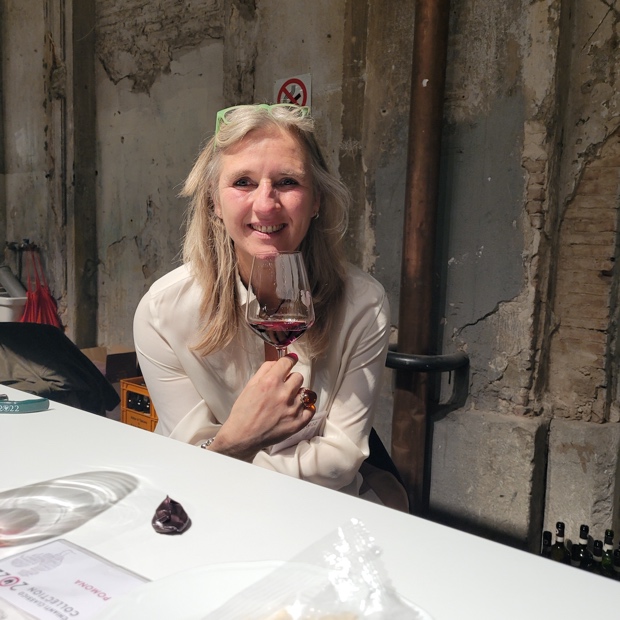
Monica Raspi, Fattoria Pomona, Castellina
Fattoria Pomona Chianti Classico Riserva DOCG Bandini 2018
Castellina
Monica Raspi’s Riserva 2018 was only bottled five months ago so don’t come expecting immediate gratification or revelation. Do come knowing this is sangiovese from a special place, that being the west Siena facing Castellina vineyard in front of the villa called Uomino, “the little man.” Only Pomona produces Riserva that scents and tastes like this and only Monica Raspi’s deliver peak wine experience moments that nearly always occur in repose, never connected with work. Such is the ease of her ’18 Riserva, big and focused, light and understanding. Given time it will also act charming, gracious and nurturing. Drink 2024-2030. Tasted March 2022
Gagliole Chianti Classico Riserva DOCG 2018
Panzano
A famous Panzano (in the commune of Greve) estate and a manuscript in the State Archives in Siena reveals that the son of the Langobard King Berengarius, who had fallen in love with the Tuscan countryside, bequeathed the Gagliole Estate to his wife in 994 A.D. This Riserva comes to us from a most curious vintage 1,024 years later and just two years earlier Riserva was called Gallule, but that ancient terraces reference is now reserved for Gagliole’s Gran Selezione. Riserva ’18 was picked on the 10th of October and this is significant because a late September heat spike nearing 30 degrees with opposite nighttime lows near zero meant more fruit ripeness and kept acidity for bigger but also balanced 100 per cent Panzanese sangiovese. These Galestro and Alberese vineyards at 450m picked well after the extreme climate moment, followed by 10 months in small, used French oak barrels has resulted in the most precise and focused Riserva imaginable. The acidity travels up the sides inside the mouth all the way to the eyes, or so it is imagined and then sends shivers down the spine. Warm, inviting, luxurious and so very real. This is exceptional Chianti Classico, intimating everything now yet with the knowledge that the best showing is still years away. Drink 2024-2030. Tasted December 2021
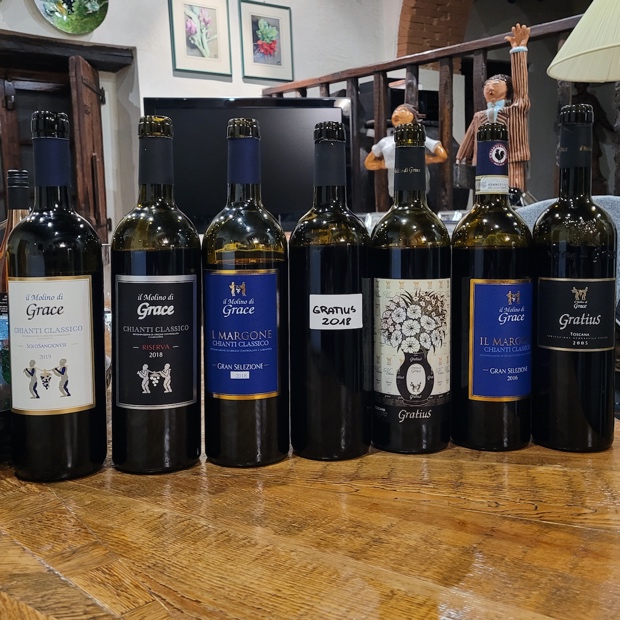
Tasting Il Molino di Grace, Panzano
Il Molino Di Grace Chianti Classico Riserva DOCG 2018
Panzano
I will personally implore you to look and think past anything you have heard about 2018, just as it would have been prudent to do so with both 1998 and 2008. The sneak of structure and linger in the name of longevity will conspire for a slow release of emotion, something seemingly absent in the wines’ early days of life. A bit high in acid and also drying, from knives cutting through tannin and this is is the essence of naked sangiovese. Not as supple and succulent as 2019 but will almost certainly last longer. Was bottled just ahead of harvest in September 2021. Last tasted February 2022
Despite the great diversion and division between vintages that came before and will follow, the consistency of Il Molino di Grace’s Riservas are a testament to changes made and promises kept. The team has allowed these wines to crawl from barrel and into the light. The heat and drought of ’17 was followed by a lithe freshness from ’18 though sangiovese chosen to hang well into September and even the first days of October have come about and into some heady wines. Begin with Riserva’s perfume in a Panzano bottle, Galestro and Pietraforte bled, red berry made flinty by stone. Focus and expression are right on point and while both Panzano and proximate Radda are the additional geographic thought, Il Molino di Grace is the pinpointed place. Still emitting early life freshness and vigour, lovely for ’18, forward and structured to travel onwards. Drink 2023-2028. Tasted October 2021
Istine Chianti Classico Riserva DOCG Levigne 2018
Radda and Gaiole
Angla Fronti’s mix of vineyards results in one of the most generous and layered Chianti Classico of any and all in the oh so generous 2019 vintage. Not sure whether fruit or structure are more up front and in charge but either way the compound effects of Galestro and Alberese meeting Istine’s multiple vineyard greatness puts this in a class all of its own. Drink 2024-2031. Tasted February 2022

Stefano di Blasi at La Sala, San Casciano
La Sala Chianti Classico Riserva DOCG 2018
San Casciano
Made with 10 per cent cabernet sauvignon. Some estates thread consistency and replicative DNA through their wines and one nose into this ’18 Riserva confirms La Sala’s situation within this ideal. Not that Riserva conforms to any sort of norm but the plush, soft and handsome beauty in such a wine can’t help but stay connected to the Annata, regardless of vintage. The aromas express more or shall we say a different sort of saltiness, more potassium graded through Galestro soil structure, from the same vineyard source yet imparted in hyperbole when it comes to Riserva. Flavours deliver more berries and balsamic, higher pH helps to soften the tannins and along with the location make them sweeter, softer and melted into the plush sofa. A gorgeous Riserva, succulent in fruit and acids, fineness of tannin and so very inviting. Ex-cellar price is 7.8 euro. Drink 2022-2026. Tasted February 2022

L’Erta di Radda
L’Erta Di Radda Chianti Classico Riserva DOCG 2018
Radda
In Diego’s mind 2018 was quite the perfect little vintage, one of piaggio e giusto, flattery and truth. Not that it was easy but it was transparent and real. That said it was a stop and go one, with changes in weather, temperature and demand. A vintage to keep agriculturalists on their toes and make them earn their pay. L’Erta di Radda’s Riserva has now entered a great place, just now beginning to show its charm and also breadth. It’s chewy and also croccante, chiseled and generous. Freshness is encouraged by this vineyard abutting a small river giving breath to the sangiovese. Last tasted March 2022
Riserva is of a cru in the hills più basso, in poor red soils, very rich in iron, planted in 2009 to two clones suitable to this cru, but with rootstock worth its salt in vigour. Clones that offer lower quantities, in one hectare, which produces only 25 quintali per hectare. or 2,500 hL per hectare and the average in Chianti Classico is easily at 40. Five or six small bunches per plant, tiny bunches, “molto spargolo.” Picked in the first week of October also because it’s only sangiovese with higher pH (at 3.1 or 3.2), 35 days of time on skins, ages two years, first in 2000L grandi botti, 2nd in barriques and tonneaux. Diego Finocchi likes the micro-oxygenation, but in the second year. There is a liquid peppery note but also the smoothest body and caress with grace across the palate. You simply do not feel the wood on this Riserva and that tells you everything you need to know about the winemaking and the way this represents the cru. Drink 2021-2027. Tasted November 2021.
Maurizio Brogioni Chianti Classico Riserva DOCG 2018
Greve
Very young and even reductive Riserva here from Greve with good fruit substance behind and in waiting. Needs air and time to blow off yet not having enough of that, at least not yet. A linear, high acid and even crunchy, sangiovese, especially in Riserva form. Drink 2024-2029. Tasted February 2022
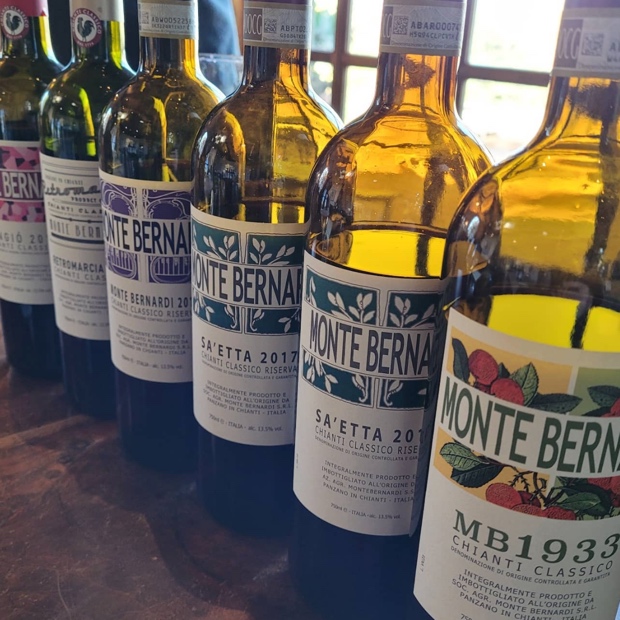
Monte Bernardi, Panzano
Monte Bernardi Chianti Classico Riserva DOCG 2018
Panzano
“In ten years this is going to look like magic.” To thank are stems (60 per cent) and the post-macerative consciousness at a time when the catalyst manifests itself in youthful aggressiveness, to see a softening that now becomes something easier to understand. “We bring out the generosity sooner without sacrificing longevity,” is how Michael Schmelzer looks at and explains the situation. The slow release of complex aromas and also flavours is extended by the long maceration, post maceration and aging in concrete plus botti grandi. Has already entered the first stage of grace, grip surely present though not overtly or overly demanding and even if a bit shy. There is a roll off the tongue, a scorrevole in this sangiovese. Smooth, sliding and scaled for slow release. Drink 2023-2033. Tasted November 2021
Monte Bernardi Chianti Classico Riserva DOCG MB1933 2018
Panzano
One hectare of “traditional field blend” at over 500m, high (7,000 plants per hectare) density plantation, co-fermented and it makes 3,000 bottles aged in used tonneaux for 18 months. Obviously sangiovese with what could very well be canaiolo, colorino, malvasia nera, calabrese, ciliegiolo and uva di ragnana (locally named). The freshness and salinity plus what must be named as mixed pH created sapidity surely speaks to white varieties as well, including malvasia and trebbiano. The label depicts a corbezzola, delicate of fruit, high in seeds, a great representation of this traditional wine. Will express equal freshness 10 years forward and without any sacrifice to acidity. No stems here, again wanting to understand the wine before going into that kind of catalyst meets polymerization intendment. More graceful brilliance with some drying tannin this time from Monte Bernardi. The lens is completely different so wait till Michael Schmelzer really gets a handle on this one. Drink 2023-2033. Tasted November 2021

Winemaker Tim Manning, Montecalvi, Greve
Montecalvi Chianti Classico Riserva DOCG 2018
Greve
Riserva is 100 per cent sangiovese from what is called the Montecalvi alto block (one of seven on the farm). From a particular tonneaux that winemaker Tim Manning just liked how it was so decided to keep it back extra time and bottle the estate’s first Riserva. While you feel the extra time (26 months in used wood) it is anything but a barrel driven wine. It seems it just accentuates the texture tactility and makes you feel more, including emotion. There is a suave sensibility here, silken and structured but never precious. It does feel like Riserva though the volatile acidity is just a touch elevated, not problematic and if anything reaching for another level of complexity. Drink 2023-2028. Tasted March 2022
Montefioralle Chianti Classico Riserva DOCG 2018
Montefioralle
Imagine a vintage where cool, sometimes wet and not exactly ideal summer weather is followed by a lovely if again not exactly sunshine drenching September. Keep the reverie going and see a heat spike by day, followed by low nighttime temperatures, eventuating in late-picked, fully reasoned and ripened Montefioralle fruit. This is Lorenzo Sieni’s Riserva, liquid chalky, low and slow cooked spice threading through every stitch of sangiovese fibre. Pragmatic Riserva that also incites emotion makes for a great and winning combination. Drink 2023-2029. Tasted February 2022
Nittardi Chianti Classico Riserva DOCG 2018
Castellina
Firm, tannic, swarthy and grippy Riserva with thickness and deeply profound fruit here from Nittardi. Chalky and edgy into handsome volatility with many unresolved parts. A big Riserva constructed for the long haul that will aim to please with ropey red Castellina fruit as impressive as any in the UGA. Drink 2024-2028. Tasted February 2022

Podere Capaccia, Radda
Podere Capaccia Chianti Classico Riserva DOCG 2018
Radda
Capaccia farms four hectares of vineyards at 500-550m on a spectacular promontory quite proximate to Castello di Volpaia. Of the four vineyards (Il Cortaccio, Il Prato, Lo Scopiccio and Le Capanelle) it is the latter’s 2007 planted sangiovese that is used for Riserva. From 2018 the Riserva shows more wood harmony with the handsome fruit and a settled feel, complimentary while also so bloody fresh, exceptional even for the UGA and appellation. Chewy this ’18, liquorice leathery but also like persimmon hung to a dried and toothsome consistency. Some dustiness but not the vinous aspect of 2017 and really quite calming otherwise. Tannins are gritty but not coarse and very close to settling into what would be called fine. Wait another year. Drink 2023-2029. Tasted March 2022
Podere La Cappella Querciolo Chianti Classico Riserva DOCG Unfiltered 2018
San Donato in Poggio
In Riserva form Podere La Cappella really sees a long developed through late picking sangiovese come to full fruition. Beautiful flesh and texture, fulsome fruit and sweetening acidity. Very fortifying with that blood orange to limestone bleed in great hyperbole. Drink 2025-2029. Tasted February 2022
Fattoria Poggerino Chianti Classico Riserva DOCG Bugialla 2018
Radda
Piero Lanza has not made a small wine in Riserva from Radda for 2018. The ripest rows or rather the vines that grow in rows that find the highest level of phenolic development are chosen for a sangiovese of cool warmth, dripping grape resin and grippy tannin. Big, sumptuous, gangly at present, layered and so far from acceding to time and your palate. Wait seven years, trust the science and see this Riserva come out as bountiful and beautiful as they make them. Drink 2025-2032. Tasted February 2022

Querciabella, Greve
Querciabella Chianti Classico Riserva DOCG 2018
Greve
Not a shock that Riserva is so very young, “and for us even as Riserva it’s still about fruit expression,” tells Manfred Ing, with only 20-25 per cent having spent time in new wood. Plenty of Botti Grandi usage but again it’s about best vineyard fruit selection. The choices are made all the way along, even if the team really knows going in what the best vineyard sections really are. Sees 18 months in barrel. The depth of fruit also shows breadth and width, a three-dimensionality for sangiovese that reaches past aromas and onto the entirety of the surface area on the palate. Aided and abetted by picking that spreads across an entire month, only adding to the layers, especially in the tannins which are not simply of one ilk or another. There lies the crux of a Querciabella Riserva, when happened upon there comes about a squad of tannic complexities that cause a raciness and early tasting chaos. It’s wildly stimulating. Stupendo. Drink 2024-2037. Tasted November 2021
Ruffino Chianti Classico Riserva DOCG Riserva Ducale 2018
Greve
Ever since the Riserva Ducale Oro showed up in Ontario as a Gran Selezione it seems this appellative level of similar distinction as fallen by the release schedule wayside. Which really is too bad because the original Riserva is eerily similar and drinks with closely resembling distinction as the Gran Selezione. Like looking in the mirror and seeing a reflection of your father, so to speak. Good fruit from 2018, on the lithe and easy side, ripe and medium bodied. Quite middle road taken all the way through and simply classic in design. Drink 2022-2025. Tasted February 2022
Santo Stefano Chianti Classico Riserva DOCG Drugo 2018
Greve
Quiet, even stoic Riserva, surely designed for slow release so patience and even aeration can only serve this well. Quite a compliment of barrel converges and smothers the fruit in this earliest of stages, only adding to the idea of time being a friend, not an enemy. Chewy Riserva, laden with liquorice, welling with macerations, cherries and herbals swirling in the limboed abyss. Save it for later. Drink 2024-2028. Tasted February 2022

Greve in Chianti
Tenuta Poggio Al Mandorli Chianti Classico Riserva DOCG 2018
Greve
Traditional, rustic, old school beauty. Riserva as imagined passed on through generations taken to a present day level and situation. Riserva as Greve, of sand and clay, alluvial deposits and sunshine. Cool and slightly wet as well, a vintage ever-changing and if misunderstood then simply exercise some patience. This will reward in two to three years time once the austerity of the necessary tannin settles in. Drink 2024-2027. Tasted February 2022
Triacca La Madonnina Chianti Classico Riserva DOCG 2018
Greve
Big punch and high acid crunch from sangiovese with deep cherry fruit and not much more than a modicum of Riserva density. An elastic one, of juicy tang and quite readily available at this early stage in time. Get at this before many others and feel the love. Drink 2022-2025. Tasted February 2022
Villa Le Corti Principe Corsini Chianti Classico Riserva DOCG Cortevecchia 2018
San Casciano
Same cépage as Le Corti and here aged in 27hL casks. A selection in the first weeks after fermentation, tank by tank, vineyard by vineyard. The “final” decision is made after the “spezzaturra.” There is always a grounding and an earthiness (carnale as opposed to animale) to Cortavecchia that separates it from the Annata and has it move into singular territory and 2018 is a Riserva vintage indeed. Higher in acidity, vim and vigour. More elegance, elastics and elongation. Even if there was no showiness before there is now. “There is a time to taste wine and every wine has its time.” Today is a good time to taste. Drink 2022-2028. Tasted October 2021

With Winemaker Leonardo Bellacini, San Felice, Castelnuovo Berardenga
San Felice Chianti Classico Riserva DOCG Il Grigio 2018
Castelnuovo Berardenga
Classic Leo Bellaccini styling, hung long on the vine, maximized phenolic ripenesses equal to sugars and developed berries for full on competition. Alcohol and wood move at a balanced if heavy set pace and all the necessary parts keep up with head high, esteem and quiet swagger. All in control through every stage, full on the palate, silky feel, concentrated, sophisticated, up to the minute. Resides at the top of this game, genre and idiom in Castelnuovo Berardenga. Drink 2021-2026. Tasted October 2021
San Giusto A Rentennano Chianti Classico Riserva DOCG Le Baròncole 2018
Gaiole
San Giusto A Rentennano’s singular corner of Gaiole’s climate of 2018 was a carbon copy of 2016 (in summer) but in September the sugar ripeness was happening way too fast. Luca Martini di Cigala knew to wait. Three passages were made and in 2018 this began on September 22, concluding on October 16th. Results in a higher alcohol at 15 per cent and a really, really ripe sangiovese. Big in every respect and yet totally in balance, a San Giusto wine exactly representative of time and place. Fine tannins, really fine, no drying to speak of and the kind that will take this wine well into the next decade. True blue Riserva, stylistically as per the conceptual idiom but also for the tufo and clay of this once volcanic place. Drink 2024-2032. Tasted November 2021 and February 2022
Tenuta Orsumella Chianti Classico Riserva DOCG Corte Rinieiri 2018
San Casciano
A true blue Riserva of San Casciano grip, wit, charisma and style, cool and savoury, granita of texture, sip-able yet age-able. Black cherry flesh and pit, amaro biters and a pinch of sangiovese’s austerity from place, vintage and ways set in eras gone by. Settle for two or three years and drink for two or three after that. Drink 2024-2027. Tasted February 2022
Villa A Sesta Chianti Classico Riserva DOCG 2018
Castelnuovo Berardenga
Expands on the sand and clay richness found in the 2016 Castelnuovo Berardenga Riserva while finding more fruut-acid balance in this regaling example for 2018. Villa a Sesta’s is always warming, caring and silky smooth so that luxe and and piqued spice activity are always driving the Riserva style. Matters of the heart, purity and savoury intensity gather for great Riserva promise. Drink 2023-2028. Tasted February 2022

Gnudi, Le Panzanelle, Lucarelli, Radda
Chianti Classico Riserva DOCG 2017
Cantalici Chianti Classico Riserva DOCG Baruffo 2017
Gaiole
Like much of the territory it was dry and hot, the vines shut down in August but one day of rain in the late part of the month reignited the maturation process. Here a saturated and concentrated, smouldering and spicy sangiovese, implosive and tightly wound.High tannic vintage, picked mid-September, alcohol warm and all together needing time to settle down. At least two more years. Drink 2024-2028. Last tasted February 2022
Casa Emma Chianti Classico Riserva DOCG Vignalparco 2017
San Donato in Poggio
Despite the vintage of no rain there was very little hydric stress with thanks to the soils, heavy in Alberese, blue argiloso and northern facing slopes. Also the sub-zone San Donato in Poggio and three to four degrees cooler than most others. Similar fermentation in concrete and stainless steel but 26 days on skins and then two years in tonneaux. TA is 5.90, an impressive number for 2017 and yet the wine is muscular, big-boned and structured with no way to fully get out the vintage way. “What you see is what you get,” tells Paolo Paffi, a 100 per cent sangiovese of firm grip and forest proximate savour; of sage, rosemary and underbrush. Really shows in the herbal and spice masala at the finish. A definitive expression of vineyard. Cru as Riserva and Riserva as Cru. Drink 2024-2033. Tasted October 2021
Fattoria Pomona Chianti Classico Riserva DOCG Bandini 2017
Castellina
Riserva comes from what can be called the “little man vineyard or il omino,” vines at Villa Pomona of 20 years where a true mix of all the rocks litter the decomposed soil. Almost unlike anywhere else where Chianti Classico is raised; Galestro, Alberese, Piteraforte, calcium carbonate and quartz. All there, all infiltrating vines, grapes and wines. In some cases all these parts are integrated into one fist sized stone. The unity is remarkable and makes Monica Raspi’s Riserva so bloody special. She has quite a bit to do with that too while her soils’ nutrients and vines’ absorption of elements allows her to nurture as only she can do. There goes that Pomona perfume in a stylish sangiovese of palate essence, succulence and an emulsification with acidity sliding into tannic fluidity. Such a lovely Riserva for ’17. Truly. Drink 2022-2028. Tasted October 2021

Iacopo Moranti, Il Molino di Grace, Panzano
Il Molino Di Grace Chianti Classico Riserva DOCG 2017
Panzano
Fulness, richness, full throttle savour, all captured and assembled. A wien picked so late in September the rear-view mirror was filled with Chianti Classicos jammy and green. Here phenolic ripeness and swelling fruit reigns in wood, with all cracks and crevices filled. Clarity and precision prevail which can only bode well for the future. Last tasted October 2021
Only from the upper vineyards closest to the cellar, one of the more pristine Riservas, of freshness, purity and clarity that Molino di Grace sangiovese did not used to show, but changes have led to this. You don’t think about the transitions or the structure because they just present themselves effortlessly and seamlessly. A remarkably fresh ’17 that was picked late, on time and best decisions were made in the cellar. Last tasted February 2020
Wow ’17 Riserva could handle waiting until 2021 to be released. So grippy, such acidity, so much concentration and while quality is exceptional still the vintage quantities are so low. A number in and around 40 per cent of normal. Wooly tannins, so in control and very fine. Remember there was also a frost in May that decimated the vines, followed by three months of intense heat. Vineyard management and the most pragmatic, accepting and realistic team in place made sure to do everything right. “Corretta” to the nth degree. As is this organic and biodynamic Riserva. Drink 2021-2029. Tasted September 2019

La Squadra Canadese at Istine, Radda
Istine Chianti Classico Riserva DOCG Levigne 2017
Radda and Gaiole
The driest and hottest of vintages, as will happen in 2021 but this year some cold weather arrived in late September. The mix of the three in Riserva form takes all the best grapes and in 2017 a great portion comes from the Istine Vineyard, “because of freshness.” This with great thanks to the forest surrounding the steep vines, something essential and very real in especially Radda and also to a solid extent in Gaiole. Istine faces north and this is the trump card in Radda, for Angela Fronti and many others. Drink 2022-2028. Tasted October 2021
Levigne from Angela Fronti delivers a duality that talks in a vernacular made of more than a commune. The concept is Gaiole meets Radda and each has its say though their mingle and intersectionality layering clouds the distinction in the way you’d hope they would. There’s a softness and a brut strength behind the exterior that tells something conceptual and educational is happening. Forget light, bright and easy. Bring on the ambition, the execution and the swagger. Drink 2023-2032. Tasted February 2020
Le Fonti Di Panzano Chianti Classico Riserva DOCG 2017
Panzano
Riserva 2017 is so very similar to Annata in that the extract feels heightened and the wine is just now settled after one year in bottle. The peppery spice is lessened as compared to the Annata while the density on the palate is increased. Dusty espresso and chocolate surround the classicism of Le Fonti’s particular Panzano red fruit. This is quite ready to go. Drink 2022-2026. Tasted October 2021
Monte Bernardi Chianti Classico Riserva DOCG Sa’Etta 2017
Panzano
“I don’t think of it as a problem year. I had bigger problems in 2011 and 2015. Complaints about heat stress are all about the wrong rootstock,” insists Michael Schmelzer. “I didn’t see any hydric stress in 2017. Comparably speaking it was a walk in the park.” OK, not quite a classic vintage of coolness, cloud cover and in fact it ranks low on the challenging pole. Therce was a loss of Retromarcia (50 per cent) but the Riserva was untouched by frost in 2017. Sa’Etta is a hyperbole of transparency and also concentration as compared with the normale Riserva. What really separates these from Classico Annata is age of vines and Monte Bernardi is from Galestro while Sa’Etta is from Pietraforte. Thus the grip, circumstance, higher tonality and concentration of perfumes. Tannins are a little austere but that too is a matter of conglomerate rock co-efficient fact. Morbido is for some, Sa’Etta for others and true to a sense of place. Drink 2023-2033. Tasted November 2021
Podere Capaccia Chianti Classico Riserva DOCG 2017
Radda
Podere Capaccia in Località Capaccia is owned by Belgian Herman de Bode with American Alyson Morgan as winemaker. The ’17 Riserva is seriously aromatic, yet unreleased and a good thing in more than one way. The herbals are powerful, vinous as with all of Capaccia’s wines, wood very much at the head, high acid as always, never lacking, the true component in charge. If ’17 Annata is chewy then Riserva is the opposite, crunchy, tart and grippy. Such a composed wine, very Riserva, seriously Radda. The mix of botti and 300L French barrel need to melt, dissipate and integrate before this really hits its stride. Drink 2024-2028. Tasted March 2022

Val delle Corti, Radda
Val Delle Corti Chianti Classico Riserva DOCG 2017
Radda
There was a section every September night when the plants could breath, helped by the woods, Radda’s “lung,” and “so we waited and waited while September and October were refreshing,” explains Roberto Bianchi. Keep exhaling after each sip to feel the freshness. Last tasted October 2021
The 2017 was a scorcher in Tuscany, no less demanding in the Chianti Classico territory and yet Val delle Corti’s Radda was one of the cool spots to be. No rain from January to the end of the first week of September and yet desiccation in these vineyards were not like some other low lying areas. Lower yields yes but really high quality fruit. Roberto Bianchi’s use of long macerations, as much stainless steel as oak and older (and larger) wood at that makes for one of the coolest and freshest Riserva one is ever likely to find. Indeed this may be the most openly fragrant, unencumbered and blessedly humanistic 2017 in the entirety of the Chianti Classico lot. Hyperbole perhaps but nature and nurture conjoin for breathtaking results. Taste, consider and exhale. Drink 2023-2032. Tasted September 2021
Villa A Sesta Chianti Classico Riserva DOCG 2017
Castelnuovo Berardenga
Producers who got it right in the hot 2017 are Chianti Classico heroes and Villa a Sesta is one of that ilk. Dry conditions through adversarial times there is a will and a way with sangiovese hung well into September, even in the sun radiant wide open spaces of Castelnuovo Berardenga. Strong and dry sangiovese gets fruit-filled centre help from seven per cent cabernet sauvignon, all grown on steep slopes at good (450m) elevation for the commune. This Villa a Sesta Riserva ages for two years in Slavonian and French oak of 500L and 40 hL. Acid crunch and pH sapidity are perfectly in balance with fine grains of tannin following in ideal suit. The winemaking is on point. Five to seven year wine beginning right now. Drink 2021-2027. Tasted November 2021
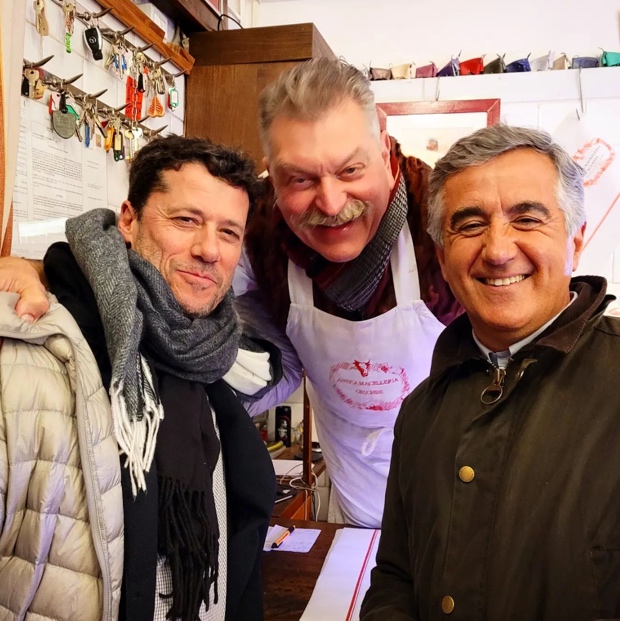
With Dario Cecchini and Fontodi’s Giovanni Manetti ar Antica Maccelleria Cecchini, Panzano
Chianti Classico Riserva DOCG 2016 (and older)
Bindi Sergardi Chianti Classico Riserva DOCG I Colli 2016
Vagliagli
Quite a ripe vintage with well-developed fruit in causation of so many days of warm but not hot and humid weather. This ’16 also carries a high level of lift and acidity working the real room of many red and blue fruit. Yes, the sensation of a blue fruit vintage, cool, salt-mineral licked and sweetly savoury. Long and linear, swirling through fruit with Vagliagli savour. Last tasted October 2021
The second of two Riserva from Bindi Sergardi, one coming from the Mocenni estate and this from I Colli, both in Castelnuovo Berardenga. Not just the name of the estate but also the old “borgo,” the family hamlet going back 23 generations. As with Mocenni there is ample Alberese limestone in this soil and I don’t know if any other producer in the commune can craft silkier or more glycerin sangiovese from this soil type. While Mocenni may gift more textural presence it is I Colli that lifts, elevates, rises and shines. Not that lightness of being is the dominant character trait but there is an emanating radiance. Blood orange coming across the palate speaks to the estate’s location and geological mix, that and persimmon, summer savoury and rosemary. Not herbal per se but more so than Mocenni. The two worlds collide and yet stay so apart. That is the beauty of having two singular Castelnuovo Berardenga vineyards from which to develop two dissimilar and diverse Riserva. Drink 2022-2030. Tasted April 2021
Brancaia Chianti Classico Riserva DOCG 2016
Radda
Coming upon nearly four years since first tasting Barbara Widmer’s classic and that is said in the most complimentary of ways with respect to Chianti Classico. Now as a sangiovese with bottle time under its belt this Riserva has had emerged as the kind of wine it was meant to become. Right there and right now. A great timing for local release and a terrific red for the upcoming holidays at an affordable high end price. Last tasted November 2021
The vintage is the succulent one for Brancaia’s Riserva, an (80 per cent) sangiovese, (20) merlot Radda in Chianti beauty that saw 16 months in a combination of barriques and tonneaux. Here we feel the point where 2013 and 2014 intercede, propagate and deliver a child that is observed to grow up so fast. While so tart, it’s primary concern is to deliver pleasure with a substantive and toothsome payoff. The wood is still a bit heavy but necessary to carry the ecumenical fruit forward three to five years. Drink 2019-2023. Tasted February 2018

Castell’In Villa, Castelnuovo Berardenga
Castell’in Villa Chianti Classico Riserva DOCG 2016
Castelnuovo Berardenga
Poured in two different glasses, one in the classic Chianti Classico consortium glass and the second in a hand-blown Grassl Liberté of Balkan origin. The aromatic launch in the latter is hyperbolic but also precise. Yes the land above is in this glass but also the iron mineral sottosuolo below. While 2016 Riserva is equipped with all the body, texture and depth anyone could be looking for (including the Principessa Coralia Leonini Pignatelli), there is more to this wine than just oomph but more to the profound point the intangible that sangiovese can deliver. “I never wanted to be a wine merchant,” so well describes the plan, ideal and what the Principesa wanted to get out of Castell’In Villa sangiovese. Complexity is the matter, some things already spoken and so many more to eventually become revealed. This 2016 has found it. “It’s nearly to what I consider very good and I don’t think I will produce anything like it anymore.” This a comment about one’s mortality and especially the climate. “You don’t know what you are going to get anymore.” Each time you taste this wine over the next 15 years something new will emerge. It will always change. Drink 2024-2036. Tasted March 2022
Castello Di Radda Chianti Classico Riserva DOCG 2016
Radda
Riserva sees 24 months in Grandi Botti and also second passage Tonneaux, very much exactly halfway between the elévage of the Annata and the Gran Selezione. Again a professional and pragmatic methodology and by extension, result. Harmony is the ideal, to bring fruit, acidity and structure into a linear and extrapolative oeuvre. Hard not to see 2016 as a perfect example of an executed plan. There is a depth to this vintage and in its sixth year this sangiovese has entered its finest years of life. Won’t get any better than now to take full advantage of this wine. Drink 2022-2025. Tasted March 2022

Il Palagio di Panzano
Il Palagio Di Panzano Chianti Classico Riserva DOCG 2016
Panzano
More refinement and sangiovese liqueur while maintaining a dryness and unresolved structure as found in the Annata that is caused by the older vines and their variegated fruit. Older clones that deliver a more rustic and grippy sensation in the wine. Like the Annata only bigger casks are used, no tonneaux. Chewy Riserva, gripped by real Panzano stage presence, pietraforte and arenaria soils with just a streak of calcari. Wait two more years in this. Last tasted October 2021
A warm and fuzzy Panzano feeling felt straight away, humid, spicy, Galestro instructed. Some pretty serious tannin, weight, magnitude and a considerably deep impression. Quality with high acid notes acting as a foil to the formidable thing of it all. Bigger that ’15 in so many respects. Drink 2021-2026. Tasted February 2020
Istine Chianti Classico Riserva DOCG Levigne 2016
Radda and Gaiole
The vintage while very good was not high in production for the Frontis due to more rain than wanted. And yet there is a fulsome sensation and really tannic thrush to ’16, far from resolved, deep and profound. A real liqueur that does not always happen in Fronti’s wines but beauty and power can co-exist. Feels like a good portion of Cavarchione from Gaiole, nearly as much as Istine with some bit parts of Casanova. Last tasted October 2021
Losi Querciavalle Chianti Classico Riserva DOCG 2016
Vagliagli
Sangiovese from Vagliagli with five per cent canaiolo, ideal for raising the pH just enough to tame and balance the wild acidity in sangiovese’s crazy heart. Though it’s a 2016 it is yet to be released because tells Valeria Losi, “we believe it will still improve in the bottle.” Hard to argue with the logic because the tannins are not just UGA focused but so very Losi in temperament. And yet they are also sweet and suave in spite of being so forceful. Finally there is the persistence and length, qualities embraced by ’16 and especially through Riserva appellative form. Drink 2023-2029. Tasted March 2022
Piemaggio Chianti Classico Riserva DOCG Le Fioraie 2016
Castellina
A certain and specific kind of Riserva concentration here from the Castellina rossa, direction Poggibonsi. Some beauty in tradition and rusticity, full on complement of acids and impart by the dusty track. A good interaction and integration overall where parts intersect and compliment in spite of the dry and high-toned character. Very Castellina Riserva in that regard and from an identifiable place within a place. Drink 2023-2026. Tasted February 2022
Podere Capaccia Chianti Classico Riserva DOCG 2016
Radda
Fruit comes from the “vineyard down below,” the flysch, sandstone, marl, shale and clay 0.92 hectare old (2007 planted) vines of sangiovese block known as Le Capanelle. Not only was 2016 a vintage of promise and growth it also allowed for lengthy hang time and fully kept acidity. The ’16 has actually fleshed out since last tasted 25 months prior and yet the tannins have barely broken stride. Less new oak then ’15 (after no Riserva made in ’14) led to ’16 being a more balanced elévage (at 30 per cent). Radda is here in all its awe-inspiring vista glory, at 500m elevation, on a steep southern slope, breezy and making for seriously vinous wines. Last tasted March 2022
The bright light and fresh face of Capaccia is something exceptional, exciting and new. So much fruit and rose petal emits from the nose and while comparing sangiovese to other important grape varieties is neither necessary or my style I have to say that the Premier Cru (Nuits-Saint-Georges) feeling of this fruit can be imagined in pinot noir terms. Rarely do I feel the need to do this but this Riserva takes me there and then comes home. Huge stride forward for the estate. Drink 2022-2032. Tasted February 2020

Quercia al Poggio’s Michela and Vittorio Rossi, San Donato in Poggio
Quercia Al Poggio Chianti Classico Riserva DOCG 2016
San Donato in Poggio
Though 2016 is not equipped with the fruit set that 2015 surely owns there is no shortage of substance to match Quercia al Pogggio’s packed house of herbs, savour, long-chained tannins and slow release from structure. Like the difference between Annata from 2018 to 2019 there is a similar change from Riserva 2015 to 2016. Night and day in a way, from perfume to a wine of finer compaction of tannins that will take even longer to release. You can really see the refinement in the Riservas, especially in the 2016. This will live longer than the 2015, that much is clear. Tasted November 2021
Surprising or not the ’16 Riserva from small batch Quercia al Poggio is a pretty heady and serious wine, reductive, rich and a tough nut to crack. Plenty of wood sheathing at this very stage brings texture, silken and quite creamy. A whole lot of everything that will require time. Drink 2022-2028. Tasted February 2020
Bindi Sergard Chianti Classico Riserva DOCG I Colli 2015
Vagliagli
Holding strong and from 2015 a complexity emerging, of the I Colli earth and more elemental punch than noted in either ’16 or ’18. This is where Alessandra Casini Bindi Sergardi was born and grew up. Built in the 1400s for the family, lower in elevation (350m) as compared to Mocenni (500m), still rich in Alberese but also high in iron content as across the road in the Chianti Colli Senesi. The wood and its fortifying spice are quite notable in this glass. Perhaps a vintage push or perhaps time related. Either way Riserva ’15 is more than ready and also willing to linger for five years further. Drink 2021-2024. Tasted October 2021
Cantalici Messer Ridolfo Chianti Classico Riserva DOCG 2015
Gaiole
A single vineyard sangiovese Riserva, from 45 year-old vines, aged two years in 20 hL barrels. Next level concentration but also movement, here from 2015 showing almost as much development as both ’11 Annata and ’10 Riserva. That is surely a matter of wood and vineyard, a soft, creamy and evolved sangiovese, chocolate and dried fruits throughout. Last tasted February 2022
Apposite to Barrufo in that Messer Ridolfo sees 18 months in 70 per cent small 20hL French oak and the rest in stainless steel. Also 100 per cent sangiovese from soils of Alberese and Galestro though slightly lower down on the Gaiole slopes, near the 300m mark. Richness, coniferous forest resin and wood accents in tobacco and dark chocolate make for a deeper, more resonant and even barbarous Chianti Classico Riserva. One of balsamico, tartufo and a certain era’s chic islands in the stream style. This will really take you back. Drink 2020-2025. Tasted November 2020
Castell’in Villa Chianti Classico Riserva DOCG 2015
Castelnuovo Berardenga
That sweet Castell’In Villa Castelnuovo Berardenga volatility is elevated and exceptional in 2015 Riserva, as is the fruit substance, overall extract and concentration. That feeling of growing sangiovese amongst 200 hectares of woods is palpable, like herbs, forest nuts and shrubs injected into the DNA of this singular wine. As if sun and savour were threaded through plants, vines, trees and grapes, things trampled underfoot and spices by wood making for a full and credible sangiovese. True local liqueur and years to young to even consider where this will go, or to think about current exceptionalities. Drink 2023-2029. Tasted October 2021

Castello di Radda Riserva
Castello Di Radda Chianti Classico Riserva DOCG 2015
Radda
Riserva sees 24 months in Grandi Botti and also second passage Tonneaux, very much exactly halfway between the elévage of Annata and Gran Selezione. A bit more acetic acidity in 2015 which seems counterintuitive to the vintage but such is the singularity of the sangiovese that grows on the vines in this and neighbouring località. Dusty, plum and currant fruit, not unlike 2018 Annata, less “Riserva” than ’16 in sentiment though will age quite well. There is an affinity here with Castelnuovo Berardenga, in a way like Villa a Sesta and even Castel’InVilla. Wholly unique Chianti Classico Riserva (Radda) expression. Drink 2022-2025. Tasted March 2022
Quercia Al Poggio Chianti Classico Riserva DOCG 2015
San Donato in Poggio
A selection of all the vineyards around al Poggio but also a true factor of all the different soils and their vines needing many passes, for picking across 25 days. Aged in tonnaeux like the Annata, longer of course and the secret lies in the custom made sorting table, slanted, vibrating and allowing to find the most perfect fruit. The wine opens incrementally with each and every moment and with these passages of time the perfume really blooms. Time and timing is everything. Drink 2022-2027. Tasted November 2021
Castello Di Radda Chianti Classico Riserva DOCG 2014
Radda
Talk about a strange and challenging vintage. In many parts wet and cold, even here but by using more grapes from Il Corno and allowing them to hang longer, well into October, the ripeness just about made the grade. A “balsamic” vintage, really fresh and with sneaky structure. Showing well, really savoury, no departure from the Castello di Radda style and with dusty, musky and dusky tannins that still bear their teeth. Just a little crunchy. Drink 2022-2026. Tasted March 2022

Fattoria Poggerino Chianti Classico Riserva Bugaialla 2014, Radda
Fattoria Poggerino Chianti Classico Riserva DOCG Bugialla 2014
Radda
Tasted as part of “Il Chianti Classico in 9 Decadi” led by Filippo Bartolotta with Giovanni Manetti at Stazione Leopolda in Florence at the Chianti Classico Collection. A wine as a child of cappello sommerso, stylistically Piedmontazine in origin, long maceration and from a really wet and cool vintage. Always elegant, always a matter of vineyard rows that ripen just bit earlier, better and with phenolic completion as compared to the rest of Piero Lanza’s fruit. Chewy, especially for the vintage but also layered and palate caressing. This has the no lo so of Chianti Classico, the umami found in just certain wines of understanding and humility. Lanza gets it and that’s important. It means he cares. Bravo Piero. Tasted March 2022
Monte Bernardi Chianti Classico Riserva DOCG Sa’Etta 2014
Panzano
It was my request to look back at an older version of Sa’Etta, to see how the earlier lift, animale and swarthy behaviour has either settled down or remained an integral part of a wine steeped in character as place. Things can be circumstantial and sometimes they simply are not. Now, 2014 has indeed settled but we are very aware of some beautifully feral character looking back. The newer vintages of 2017 through 2019 surely speak in more graceful tones or rather those edgy notes slide and integrate with greater subtleties. What has really come about is how the fruit and acid intertwine roll with tidal bio-endo-dynamism across the palate. That is because the extra few years of polymerized tannins have served to sweeten the once shy Pietraforte raised sangiovese. As it is said, timing is everything. Drink 2021-2023. Tasted November 2021

With Angela Fronti, Istine, Radda
Istine Chianti Classico Riserva DOCG Levigne 2014
Radda and Gaiole
Made from the three Istine vineyards and the best grapes from each though the percentage changes each vintage because the vineyards have strong identities and show differently from year to year. “It was 2014 that made me stronger so it is my favourite vintage,” tells Angela Fronti. Rained so much, disease pressure and botrytis were in effect and so the soil needed to be repeatedly cleaned, the grapes thinned and the harvest pass three times over. Talk about the passion and the ability to age Riserva into what is now a timeless exposition and impression, a liquidity now viscous and fluid like a cold stream of fresh water you so desire to drink. Savour captured, Raddese acidity set to the future, Gaiole threaded through and time so very much on this Riserva’s side. Drink 2022-2027. Tasted February 2022
San Giusto A Rentennano Chianti Classico Riserva DOCG Le Baròncole 2014
Gaiole
All together a different vintage for the Classico, cool, salt-licked, mineral, linear and ethereal. Not an orange or cherry one and quite frankly not one of fruit at all. “In our case the base Chianti Classico suffered a bit, but the ones picked later in October for Riserva were high quality.” Work with this 2014 in the glass for 10-15 minutes and it will flesh, silken and lengthen. No jam or concentration but elegance personified. Last tasted February 2022
In 1957 San Giusto A Rentennano was inherited by Enrico Martini di Cigala and in 1992, by his nine children. Today Anna, Lucia, Elisabetta, Francesco, Alessandro and Luca are partners in the estate company. Riserva le Baròncole 2014 is composed from 97 per cent sangiovese plus canaiolo, the 14th Baròncole of a Riserva that was first bottled in 1975. The rains of summer did not deter this determined Chianti Classico, thanks to great farming practices, favourable weather conditions at harvest and under the circumstances, the strictest grapes selection possible. A beautiful liqueur wells in this rich and aromatic, spiced and spicy CC, quite exceptional for 2014. The top of the quality pyramid is reached with its rich constitution and age conscious ability. Chalky in fine grain and sweet tannins, no green notes, good acidity and properly rendered (20 per cent new) barriques and big (5 hl) barrels. Get with the baron. It’s a prime “esempio” for Gaiole in Chianti. Drink 2018-2024. Tasted September 2017

Le Vigne, Istine, Radda
Istine Chianti Classico Riserva DOCG Levigne 2013
Radda and Gaiole
As for 2013 it shows so much more evolution and the blood orange juicing simply can’t be missed. Here the lovely hint of oxidation creeps in, a feeling of warmth eight years later and yet there are some refreshing moments too. The tannins persist even while the fruit is on the wane and the end of the best years is nigh. Drink this for two three more years with confidence and pleasure. Last tasted February 2022
Levigne is considered the top wine of the estate and it is one of two assemblage-forged sangiovese. Angela Fronti produces three single-vineyard Chianti Classico, a CC that combines all three vineyards and this Riserva. Since the 2012 harvest Fronti has opted for separate vinifications of sangiovese according to each vineyard of origin. Through different wines the characteristics of each specific vineyard, as in exposure, soil and altitude, are exploited. Fronti notes “we tell our reality through the best sangiovese harvested in the Vigna Istine (between Radda and Castellina), the one collected in the Vigna Casanova dell’Aia (near Radda) and the one in the Vigna Cavarchione (in Vertine, Gaiole). Riserva is a story of assemblage and it seems to me, not the wine of Angela’s greatest passion. This CCR is chosen from her best fruit and spent 18 months in large botti. The fruit is raisin chewy and a bit stewed to be sure but with good acidity and tart, tight tannins to keep the faith. It’s disjointed and I would bet the single-vineyard CCs are more precise and focused. Should SV Riservas be the wave of Istine’s future? Only Fronti can answer that question, if adding more diversity to the portfolio is even a possibility. All that said this high quality blend will turn and morph for a more than interesting secondary CCR display of personality. Drink 2017-2022. Tasted September 2017
Istine Chianti Classico Riserva DOCG Levigne 2012
Radda and Gaiole
Angela’s first vintage, a very dry one (similar to what would come out of 2017) and also the first from fully organic vineyards. Also a warm one (just as ’17 would also be) and the evolution is upon this very moment. The feeling of wood wells into a chocolate melt from 2012, something neither ’13 nor ’14 seem to possess or process. Full and satisfying, acidity intact and keeping the ripeness alive. Drink 2022-2025. Tasted February 2022
Cantalici Chianti Classico Riserva DOCG Baruffo 2010
Gaiole
In Riserva form and from a year earlier as compared to the ’11 Baruffo Annata it is this 2010 that has fully and completely entered its secondary stage of development. All umami, in porcini and tartufo but also plum pudding and tells Giovanni, “the evolution we want.” This is a very handsome wine, in a calm and relaxed state, but with acids very much intact. The wood has melted and integrated so beautifully and while its excess is a concept of time, there is no doubting how well it was used. Drink 2022-2025. Tasted February 2022
Castell’in Villa Chianti Classico Riserva DOCG 2010
Castelnuovo Berardenga
A look back 12 years and the memories are mostly in notes for a vintage of strength but not necessarily the body of some others immediately before and also after. Expediently secondary and holding that way now for a few years, not yet truffled but plenty of wood and woods, oak and bosco, nuts mostly, with layers of chocolate. Residing in between, not a wine of real age but well past its youth. There is nothing earthy about this whatsoever, rather it’s cheery and almost sweet. Good fruit vintage and generous oak are obvious and that is why the wine has survived so well though the latter plays a starring role. Still some unresolved yet resolute tannin for a few more years. Drink 2022-2026. Tasted March 2022
The bright perfume is elevated out of 2010 and brought to present day prominent, scintillant life. A sangiovese out of which the Principessa “feels the sense of the earth.” You somehow still feel the sweet naïveté of maceration, from a very promising now realized vintage of both fruit wealth and structure. Just a moment’s porcini breath characterizes the present, coming through to speak of a turning point and the next aromatic phase. Just a baby really. Drink 2018-2024. Tasted November 2018
Castell’in Villa Chianti Classico Riserva DOCG Poggio delle Rose 2010
Castelnuovo Berardenga
A nearly two hectare single vineyard or if you like the Castell’In Villa cru and really just a fraction of what is made in the “other” Riserva. Similar aging profile but with more depth and also complexity, here in the 15th vintage (first in 1996) from a vineyard created by the cuttings of the best vines identified around the estate. Getting the the iron mineral in addition to the brush and herbs which make this feel younger and more alive. These tannins are impressively resolute and trenchant, trading blows with your palate but en route to their soft moment in the sun. Extraordinary really, a wine about a place within a place within a place. The proverbial enigma, wrapped, shrouded, etc., etc. Last tasted March 2022
From the hill parcel planted in 1990 to the old selezoine massale clones, from the original property, not the current “Chianti Classico” clones. “And there is a difference,” insists Principessa Coralia. Three or four years in grandi botti and older tonneaux so no, it’s not even close to ready. Yet the fcat that you don’t explicitly notice the tonneaux is its magic. A big and complex vintage with variability in temperature and precipitation but at the crucial moments it gave what was needed. There is a special presence about this sangiovese, because of the source but also how alive, bright-eyed and expressive it is. This pulses, vibrates and reverberates with ancient seabed salinity. No loss to finesse but more time will be required, to turn back time and back pages, for the true clarity and calm disposition to settle in. Extraordinary wine of restrained power and exceptional sangiovese. Has always been Riserva and “will never be Gran Selezione.” Drink 2021-2035. Tasted November 2018 and February 2019
San Giusto A Rentennano Chianti Classico Riserva DOCG Le Baròncole 2010
Gaiole
The 2010 is a big and concentrated wine for San Giusto, acidity running high, tannins still ruminating and spice all over the proverbial tufo map. A highly seasoned sangiovese with drying notes and sensations. This seems like a Riserva vintage that hit its stride at the 10 year mark as opposed to others where 15 is the bench. At least in terms of fruit that is. Drink 2022-2024. Tasted February 2022

Villa Pomona Bandini 2009, Castellina
Fattoria (Villa) Pomona Chianti Classico Riserva DOCG Bandini 2009
Castellina
Tasted as part of “Il Chianti Classico in 9 Decadi” led by Filippo Bartolotta with Giovanni Manetti at Stazione Leopolda in Florence at the Chianti Classico Collection. Just a baby in many ways, especially with Pomona’s particular Castellina character and specificity of acidity acting as backbone for this gently tannic wine. There is some tropical fruit on the nose, almost guava but more so persimmon and pomegranate, still very Italian but surely exotic. The wood has melted and it lingers in soft tones, not earthy but woodsy. Chocolate finish, not surprising and not overpowering. Tasted March 2022

Val delle Cort’s Roberto Bianchi in the wilds of Radda
Val Delle Corti Chianti Classico Riserva DOCG 2009
Radda
From the upper Riserva block and now at 11-12 years of age, a wine of perfume and such porcini, tartufo and umami it is really quite amazing. From another time in Radda history and a vintage able to withstand the test of time. The acidity persists but truth is a fat year and yes, conceptualized Raddese will always be there. Lovely drop at this stage and with thanks to place. Posizione. Sempre. Always. Drink 2021-2024. Tasted October 2021
Conti Capponi/Villa Calcinaia Chianti Classico Riserva DOCG 2008
Montefioralle
Tasted alongside the 2018 and like the 9s there is also great affinity between these 8s, if a bit less so. This previous decade gave a vintage cool and elongated if perhaps a former one as well. The once commanding tannins are done working the room and glass while the grippy acids persist and dominate the dusty plum fruit. There is some acetic meandering behaviour here and also some soy, balsamic and deep baritone notes. Imagined as once reductive the 2008 now sees its best days in the rear-view mirror. Drink 2022. Tasted February 2022
Conte Capponi/Villa Calcinaia Chianti Classico Riserva DOCG Vigna Bastignano 2008
Montefioralle
Sebastiano Capponi’s Vigna Bastignano was the single vineyard Riserva back in 2008, now one of three Gran Selezione wines bottled at Calcinaia. The structure and grip back then must have been something formidable because while these elements of architecture and control have relented and mostly subsided the sangiovese stands like a Florentine edifice with the Capponi crest up top, front and centre. Clearly a wine of drive and design, calculated and restored each and every time. The balsamic and earthy brewed notes are most noted while fruit wanes and hangs as if in a Baroque still life painting. Drink this with confit, preferably sauced and accompanied by a side of cavolo nero and white beans. Drink 2022-2023. Tasted February 2022
San Felice Chianti Classico Riserva DOCG Poggiorosso 2008
Castelnuovo Berardenga
Expectation dictates a much more advanced character for Poggiorosso (which predated the Gran Selezione at that time) but it is in fact a fresh and youthful example of a right and proper single vineyard wine. The tannins persist but reside in the arena of fine design with wood seasoning piquing the persistent fruit. Finishes with a meal ending shot of dusty espresso. Remarkable longevity. Should drink well easily for five more years. Drink 2022-2027. Tasted February 2022
San Giusto A Rentennano Chianti Classico Riserva DOCG Le Baròncole 2007
Gaiole
Though the secondary notes are just now fully in emerging form the fruit quality and persistence is just a bit more in linger than the three years younger 2010. This 2007 has held up remarkably well for a wine that for all rights and purposes should have begun to wane and fade away. Some good quality tannin also persists and while more wood effect comes through in chocolate there is a lovely balance and swimmingly beautiful character in true Riserva style. Drink 2022-2025. Tasted February 2022
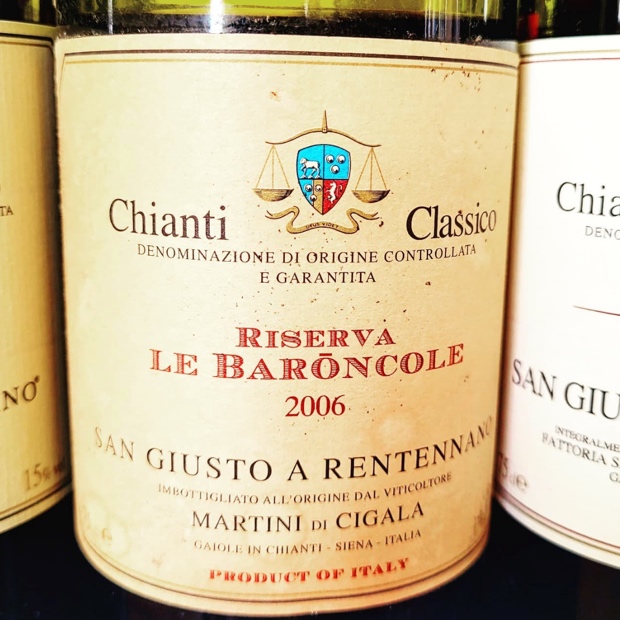
Riserva Le Barōncole 2006, San Giusto a Rentennano, Gaiole
San Giusto A Rentennano Chianti Classico Riserva DOCG Le Baròncole 2006
Gaiole
2006 was a very good vintage. People were worried at the end of August but in the middle of September there was a rain of 100mm and then for the last two weeks high temperatures (27 degrees) by day and cool (10) at night. Finished harvest on the 9th of October. Like 2012 there is a faint scent of cooking animal but here the tannins are really sweet and oh so fine. This is almost perfect Chianti Classico at 15 years old, exactly secondary, industrially complex and opening up the world of possibility, imagination and mostly emotion. Wildly aromatic and a bottle that represents Le Barôncole, Riserva and the vineyards of San Giusto in the best way. Could hardly be better. Drink 2021-2027. Tasted November 2021

Il Poggio, Castello di Monsanto, San Donato in Poggio
Castello Di Monsanto Chianti Classico Riserva DOCG Il Poggio 2004
San Donato in Poggio
Ideal vintage, not too hot or cold and aged in tonneaux. Clearly a sangiovese from a time when extraction and oak aging conspired not necessarily for huge wines but those of full-body, flesh and creamy flavours. If there is some chocolate and café so be it because the graceful rusticity, waning blood orange and traditional ambience are all more important than anything the wood (two thirds new) might have eventually wanted to say. A seasoned linger thanks the Galestro and acids for the drift. Drink 2022-2025. Tasted February 2022
Castell’in Villa Chianti Classico Riserva DOCG 2000
Castelnuovo Berardenga
“With sangiovese I never get bored. I drink it in all its versions. It gives you full satisfaction.” The words are those of Principessa Coralia Leonini Pignatelli. This from 2000 is one of those unique iterations, a cool vintage as they come, especially at that time. There is a sweetness to the fruit, matched with an equal and opposing savour, the polar opposite to the 1994 tasted last night. Almost blood orange but not quite, certainly not the iron-mineral notes of that ’94 or especially 2010. There is delicacy and grace from 2000, a fineness and a precision but nothing gangly or powerful at all. Drink 2022-2025. Tasted March 2022

Monsanto, Castell’In Villa e Brolio, I 9 Decadi
Castell’in Villa Chianti Classico Riserva DOCG 1995
Castelnuovo Berardenga
Tasted as part of “Il Chianti Classico in 9 Decadi” led by Filippo Bartolotta with Giovanni Manetti at Stazione Leopolda in Florence at the Chianti Classico Collection. Quite excited to taste this ’95 Riserva from Principessa Coralia because the last time it was slightly tainted by TCA. This bottle is in much better condition, vibrant and bright, full of fruit. Full on Castelnouvo savour, brush and vineyard dirt. An older Castell’In Villa that so reminds of some older, oxidative and terrifically characterful Greek reds. Especially xinomavro from Naoussa. Yet the acids are higher and the texture more salve viscous. Last tasted March 2022
Every memory of the summer that was 1995 in Chianti Classico is important, not the least of which are 17 days spent there and the terrible weather that followed the communes all summer long. Perhaps that is why this 23-plus year-old sangiovese has lingered into the most finessed and pleasure gathered state of grace. It’s an older bird to be sure and even not the cleanest example there is or was but its tertiary place is still marked by fine acidity and grippy tannin. Classic Castelnuovo sangiovese with dried porcini scattered amongst the leaves of autumn. Drink 2019-2020. Tasted February 2019. (The slight TCA in this example really means the wine is not rated)

Castell’in Villa Chianti Classico Riserva DOCG 1994
Castell’in Villa Chianti Classico Riserva DOCG 1994
Castelnuovo Berardenga
Looking back the style shows as a wood directed vintage and so not entirely aromatic at this 28 year point. Notable at the fore are soy, balsamic, tar and iodine. Acidity and structure are holding the fort though this really does feel like a sangiovese of a particular oak regime time. Mid-nineties IGT-ism if you will and yet the wine is showing really well. Full and having aged slowly to this point and degree, pitchy as it gets and really quite a heady wine. Pairs beautifully with cervo (deer) loin. Truly. After 30 minutes everything changes. The wood integrates and fades to the background, now spice up front and a sweetness emerges. Finally it is Castell-In Villa, intrinsic, automatic, for real. Drink 2022-2024. Tasted March 2022. Drink 2022-2024. Tasted March 2022

Lamole di Lamole 1993
Lamole Di Lamole Chianti Classico Riserva DOCG 1993
Lamole
Tasted as part of “Il Chianti Classico in 9 Decadi” led by Filippo Bartolotta with Giovanni Manetti at Stazione Leopolda in Florence at the Chianti Classico Collection. Curious to assess this with the ’93 Annata in mind from September 2018, a wine that sat in quite good standing. Both are from Andrea Daldin’s first vintage at Lamole di Lamole. The Riserva is impressive with kept freshness and spirit of life in a 1993 filled with Lamole’s profumi in pocket and more so brushy herbs, especially sage noted on the nose. The wine is in terrific shape, easily hanging in as compared to tasting the 1993 Annata three and a half years ago. Tasted March 2022
Castello Di Monsanto Chianti Classico Riserva DOCG Il Poggio 1986
San Donato in Poggio
A forgotten or passed over vintage 1986, right after 1985 and vintage of the century, like 1997, but not. Cool and equipped with great longevity, of bokser pod, fennonchiona, all leading to liquorice. But most of all a very pronounced San Donato in Poggio blood orange and sanguinity, with classic Monsanto tannins that likely fully resolved about 10 years ago. In fantastic condition, drinking with love and precision, generous and comforting. Drink 2021-2024. Tasted October 2021

Antinori 1985, San Casciano
Marchese Antinori Chianti Classico Riserva DOCG Marchese Antinori 1985
San Casciano
Tasted as part of “Il Chianti Classico in 9 Decadi” led by Filippo Bartolotta with Giovanni Manetti at Stazione Leopolda in Florence at the Chianti Classico Collection. Only the second year in DOCG (Chianti) status. Fully completely tertiary Chianti Classico and quite charming at that. Really scents and tastes like chestnuts, lightly roasted, also hazelnuts, gently toasted. A wine of barriques and San Casciano herbology, of mandarin orange, vanilla and baking spice. Chocolate is all over the finish with a sense of drying tannin still very a part of the mix. As much an older expression of Toscana as it could be Chianti Classico. Tasted March 2022

Sangioveto and Il Poggio, Castello di Monsanto, San Donato in Poggio
Castello Di Monsanto Chianti Classico Riserva Il Poggio 1969
San Donato in Poggio
From a bottle that was re-corked in 2005 and no surprise to be found in pristine condition. As much akin to a Sangioveto as to the 1968 Il Poggio due to a level of mulch and forest underfoot but also the blood orange fruit, dried nuts and high acid. You can feel the malic acid in the bottle, creamy and even more so like aged pecorino. Would have been very tight and closed for likely two decades and the three years in chestnut cask has also served to increase the longevity of this 1969. Not a big vintage, light on its 50-plus year old frame and with flavours that repeat over and over again. Drink 2021-2027. Tasted February and March 2022

I 9 Decadi di Chianti Classico, Stazione Leopolda, Firenze
Badia A Coltibuono Chianti Classico Riserva 1958
Gaiole
Tasted as part of “Il Chianti Classico in 9 Decadi” led by Filippo Bartolotta with Giovanni Manetti at Stazione Leopolda in Florence at the Chianti Classico Collection. A unique expression of a time in Chianti Classico’s history, removed from the war and yet still well ahead of the abolishment of the Mezzadrie. A deeply plum-earthy sangiovese, connected to oenologist Maurizo Castelli. The most profound and dominant sensation derived is that of toasted nuts and dried fruit, two Classico characteristics that work so well alongside antipasti of salumi in all its Tuscan iterations. No citrus or white grape feelings are gained, only fruit in a fully dehydrated, raisin stage. The finish lingers and tells much about the 60-plus years of this special wine. Tasted March 2022

Officina Bistecca, Antica Maccelleria Cecchini, Panzano
Chianti Classico Gran Selezione DOCG 2019
Rocca Delle Macìe Gran Selezione Chianti Classico DOCG Riserva Di Fizzano Single Vineyard 2019
Castellina
Take the 2018 Riserva di Fizzano and move ahead with forward and current conditions acumen to open a new door, that being Tenuta di Fizzano. Makes great sense and so ideal to use this round, beautiful and amenable vintage for the change to make even greater sense. Sweetly concentrated fruit, good quality ’19 acids that never sear nor steal the spotlight all fall into a round and soft structural line. Even better value if not the vintage to cellar too long. Drink 2023-2026. Tasted February 2022

With Camilla Bellini and Nadia Fournier, Enoteca Bellini, Firenze
Chianti Classico Gran Selezione DOCG 2018
Antinori Badia A Passignano Gran Selezione Chianti Classico DOCG 2018
San Casciano
From 2018 and San Casciano the Antinori winemaking team has looked to fill this bottle with great concentration and all the vintage was capable of completing. As such there is some very late picked fruit and it shows through the mature development of those grapes. Also some variegation in that fresh, dried, chewy, crisp and toasty notes are all layered through this Gran Selezione. It comes from the Passignano vines but it all blends and blurs into a smouldering example of top level Chianti Classico. Drink 2023-2027. Tasted February 2022
Barone Ricasoli Chianti Classico Gran Selezione DOCG Colledilà 2018
Gaiole
Tasted in Rome with Francesco Ricasoli, a Colledilà picked just ante the final moments of September, ahead of the last days of heat and cold nights. And so a freshness that defines that very specific part of the vintage dictates how this Gaiole Gran Selezione will express what it means to be of itself. “For me one of the most creative times in the last ten years,” tells the Barone, “sharing decisions with the team.” Ricasoli refers to Covid-era collaboration, when members of the viticultural and vinicultural staff had more time. So perfumed, of roses and of course cherries but most of all a natural sweetness that pervades, prepares and readies the palate. Elegant, balanced and really as good as it gets for Colledilà, mimicking “the elegance of the Chianti landscape, its hills dotted with strongholds.” Drink 2022-2029. Tasted October 2021
Casale Dello Sparviero Chianti Classico Gran Selezione DOCG Paronza 2018
Castellina
Paronza is a buoyant and almost weightless, gravity defying Gran Selezione, easy of mind, body and alcohol. Aromatically reticent and a wine so young you really have to play, swirl and agitate to get any kind of emotive response. Perfume, red fruit and fresh sanguinity do emerge, followed by a sappy, almost syrupy texture dominated by liquid Galestro-willed tannins. Very Castellina, wholly vintage related and will drink well beginning two years or so from now. Drink 2024-2028. Tasted February 2022
Podere Castellinuzza Chianti Classico Gran Selezione DOCG Vecchie Vigne 2018
Lamole
Vines that are quite old accentuate and concentrate the Lamole perfume, that much must be obvious but it also serves to emulsify and thicken the fruit wrapped in savoury bacon for a true roasted nightshade and meaty experience. This may not be for the vegetarians in the crowd but it packs a punch of high caste complexity and takes Castellinuzza’s work to an entirely new level. Full flavoured and throttled bottle with all the herbs, wood spices and florals fully in the mix. Drink 2023-2028. Tasted February 2022
Castello Di Bossi Chianti Classico Gran Selezione DOCG 2018
Castelnuovo Berardenga
Tasted as part of “Operatori Canadese,” in a tasting of Castelnuovo Berardenga wines for “La Squadra” from Canada. Bossi’s is knowable, highly effective and teachable Gran Selezione. The sangiovese right at the heart of the appellation and crux of the matter. Wide open, air filled, breezy, sunny and blue sky dreamy. Depth of fruit, smart, creamy and juicy as Classico summer Berardenga fruit. Concentration finds balance alongside structure. Ideal 10 year wine. Drink 2023-2028. Tasted February 2022
Castello Di Fonterutoli Chianti Classico Gran Selezione DOCG 2018
Castellina
A blend of more than 90 per cent sangiovese, with colorino and malvasia nera on predominantly Alberese plus Galestro soils aged for 20 months in small French barrels (225 and 500L, 60 per cent of them new). Finished for four months in concrete tanks to stabilize and capture that last moment of preserving freshness. A wily and exotically wild Gran Selezione, perfumed, high acid and stimulative. Attacks the buds and the senses with ferocity and with wholly operational spice piques due to the wood. Needs four years. Drink 2025-2030. Tasted February 2022
Castello di Vicchiomaggio Chianti Classico Gran Selezione DOCG La Prima 2018
Greve
Vicchiomaggio’s La Prima is singular and distinctive out of the potentially adverse and yet available for capture 2018 vintage. The fruit acts like sangiovese et al hung long on the vine, well-developed while in contact with roots, legumes, herbs and brush. From the savoury Greve, fully intact and in tact for a Gran Selezione that is linear, upright and long. Needs time, a whole lot of precious time. Drink 2024-2029. Tasted February 2022
Conti Capponi/Villa Calcinaia Chianti Classico Gran Selezione DOCG La Fornace 2018
Montefioralle
The Furnace made friends with 2018, heating up just enough but keeping its emotions in check to make this suave, emulsified and tempered Gran Selezione. Feeling the fully developed ripenesses is not a difficult task, nor is there any impediment to accessing what silky texture and even silkier tannin are available in full regale and display. Perhaps the least austere, demanding and grippy La Fornace ever produced at the hands of Sebastiano Capponi but the structure is indeed sneaky and built for a haul both stretched and long. Drink 2023-2029. Tasted February 2022
Conti Capponi/Villa Calcinaia Chianti Classico Gran Selezione DOCG Vigna Contessa Luisa 2018
Montefioralle
There is little doubt that of the three Calcinaia Gran Selezione it is Vigna Luisa Contessa that exhibits the most elastic, lithe and calm character. Not that it lacks in concentration and in fact it exudes the feeling of long fermentation time with great quality sangiovese skins. Despite the high and haute tripling levels of fruit substance, sweet acidities and finest tannins there is just something single and stony vineyard stretched about how all parts react to and interact with one another. Luisa is both luxe and elongated, lush and forever. A Contessa’s vintage this 2018. Drink 2024-2032. Tasted February 2022
Fattoria Pomona Chianti Classico Gran Selezione DOCG Il Omini Vineyard 2018
Castellina
The little man was planted in 1998 and this is the first Gran Selezione for Monica Raspi. Based on the solo sangiovese and single-vineyard ideal with fruit that had previously only been sent to Riserva. As with all of Raspi’s wines there is this excitement of risk-reward, of living on the edge but with a controlled calm. They set out on their own, flying free from the nest, but always seem to find their way home. And so Gran Selezione is both rebellious and edgy in youth. Some time will be needed to clean up, dress for success, act all charming and elegant. This is surely an auspicious GS beginning, fruit picked in October, preemptive in postscript of the vintage, late arriving, playing “forza e equilibrio,” acidity running high and tannins low. Not small or simple tannins but baritone, “grave e robusto,” in other words, austere. A low and slow sangiovese braise, developing, far from ready. Drink 2024-2030. Tasted October 2021
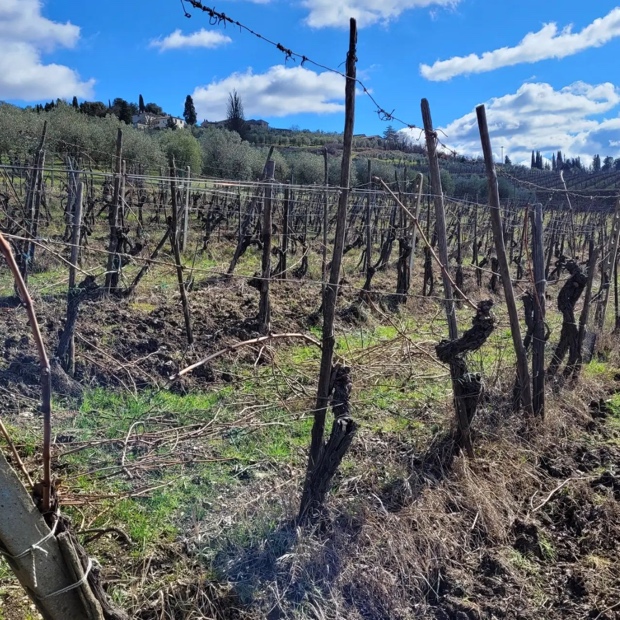
Vigna del Sorbo, Conca d’Oro, Fontodi, Panzano
Fontodi Chianti Classico Gran Selezione DOCG Vigna Del Sorbo 2018
Panzano
Showed a bit astringent and tannic grippy at the 20-25 day mark during fermentation, but bold and concentrated. Very thick-skinned vintage and those grains of tannin are very fine. Bottled in February and not yet closed in but that will likely follow soon. The dry extract and concentration are off the charts. More than that the alcohol (15.5) and acidity (6.5) are so elevated because at the end of September the temperature rose to 30 degrees, down to 1 at night and then back up the next day. “Something I have never seen in my life,” tells Giovanni Manetti. And so Vigna del Sorbo (and many of the top wines) that were picked later and in this case after that crazy 48 hours are no shrinking violets. If one thinks 2018s are soft and easy wines, think again. Even at this level of largesse there is balance and as always, the old vines of Vigna del Sorbo. Drink 2023-2032. Tasted October 2021

Gran Selezione Il Margone, Il Molino di Grace, Panzano
Il Molino Di Grace Chianti Classico Gran Selezione DOCG Il Margone 2018
Panzano
Bottled in May of 2021 so for Gran Selezione a very young wine. “It’s difficult to make a wine that is so very different, between Riserva and Gran Selezione.” You simply must take fruit from the best vineyard and keep the quantity at a consistent (approximately 6,000 bottles) level. Mainly Al Sole and Jack vineyards with a small portion from Raphaela. Actually too young, guarded and unavailable but see the forest for the trees and imagine the concentration meeting at the place where structure and balance collide, or get together. This will happen in three or four years. Last tasted February 2022
“Everyone knows it depends on when you harvest,” chimes estate director Iacopo Morganti, echoed immediately by Daniel Grace. “That is when you make the wine.” And so picking started in October, after the late September heat and crazy isolated intervals of day to night temperature fluctuations. Picking in October is essential to making Il Margone what it is. A Gran Selezione made whole and knowing where to be. Il Margone regulates itself as time passes by, of temperature and pulse. A Gran Selezione of regular heartbeat, non-plussed, vigorous and fine. Given the word, changing the scene, getting better all the time. Who could not already drink 2018 all the time? If anyone knows, remembers and appreciates the relish and longevity of 1998, they will be able to imagine this 2018 and its similar qualities. They will begin with soon to act on haste and with experience in pocket, know to keep drinking this wine for two decades time. Drink 2024-2034. Tasted October 2021
Lamole Di Lamole Chianti Classico Gran Selezione DOCG Vigna Grospoli 2018
Lamole
Vigna Grospoli is an old vineyard and one of Chianti Classico’s true cru where Lamole’s favourite son Paolo Socci also has also produced a Gran Selezione under his Fattoria di Lamole name. So yes, vineyard specific, offering a sense of sand in Macigno del Chianti form but so much more so a matter of intensity and austerity interned or in turned by the hard limestone effect of Alberese. The Lamole perfume hides in the wings while wood seasoning and stone grip take centre stage. Here a sangiovese caught between a rock and a hard place, working through the grains and fissures to eventuate a clean break and openness of generosity. Forget about it, it’s Gran Selezione. Drink 2025-2031. Tasted February 2022

La Sala, San Casciano
La Sala Chianti Classico Gran Selezione DOCG Il Torriano 2018
San Casciano
Il Torriano, “the tower,” enemy lookout likely destroyed during WW2. The thread and the lineage continues, here with Gran Selezione that takes all the purity of fruit, saltiness from the soils and plushness of sweet tannins to an entirely top level. A single vineyard of 1.5 hectares, tiny by any standards. Now the salinity is liquid, dissolved in water and the resulting solution is a drink well suited to receive fine acids and sweet tannins. Large non toasted casks help to stabilize the colour and further soften the tannins but virtually nothing else. The GS is the wine that truly incorporates all three soil types; Alberese, Galestro and Macigno del Chianti. The artist painted Casablanca and the sketch for this label, the four roosters and the importance speaks for itself. Just a touch unresolved so wait two years. Drink 2024-2032. Ex-cellar cost is 13.2 euro. Tasted February 2022
Le Miccine Chianti Classico Gran Selezione DOCG 2018
Gaiole
Le Miccine is perhaps the most perfumed of all the 2018 Gaiole Gran Selezione. The aromas include those of the forest and the herb garden but they reach florals more in bloom and quite frankly they that are profound. Violets in the way of sangiovese but also roses and exotics so radiant you’d have trouble separating from nebbiolo were this poured blind. An explosive display and also a grace, integration and style that sets this so readily apart. Will eventually flesh, depart from the current state of conflagration, slowly deflate and yet always emanate with that perfume. Drink 2024-2031. Tasted February 2022
Piccini 1882 Valiano Chianti Classico Gran Selezione DOCG “6.38” 2018
Vagliagli
By now Piccini’s Valiano in Castellina style is so consistently obvious and the hallmark red chalky flavours uncanny in their replicated design. The 6.38 Gran Selezione oeuvre is one of aromatic hyperbole mixed with textural charm. There is density and also weight but more so breadth in this volumetric appellative example. It is a sangiovese force to be reckoned with and earlier estimates wholly undervalued the structure. Wait two more years. Last tasted February 2022
Bottled in December of 2020, expressive and knowable as a Vagliagli sangiovese, ripe and spicy on the nose. A child of late-picked, full phenolic development and very generous wood. The new label reflects the organic movement and future of the Gran Selezione category, not to mention the additional geographic unit (UGA) of Vagliagli (in the western section of Castelnuovo Berardenga) that will almost surely grace the 2019 release. High level quality, well made, full on and in, deep and long. Drink 2022-2027. Tasted October 2021

Principe Corsini – Villa Le Corti, San Casciano
Principe Corsini Villa Le Corti Chianti Classico Gran Selezione DOCG Don Tommaso 2018
San Casciano
“Thomas” was Duccio Corsini’s grandfather, and his before him. The first vintage labeled as Don Tommaso was 2013, here in 2018 bottled under natural cork. Gran Selezione is 30 months with a few at the end in bottle before release. Like with Riserva the vintage is a boon for GS, not bust due to the acidity, amenability and vigour sensibilities. A drink earlier Selezione to be sure, accessible and saline delicious. Dark fruit yes and more wood to be sure but also the 20 per cent merlot that softens, texturizes and accentuates with the best grapes available. Shows this part of the territory in spite of or despite the amount of merlot. Drink 2022-2028. Tasted October 2021

Zac, Principe Corsini – Villa Le Corti, San Casciano
Principe Corsini Villa Le Corti Chianti Classico Gran Selezione DOCG ZAC 2018
San Casciano
The top of the pyramid in all respects, second vintage after the inaugural 2016 with no production (across the board) in 2017, though it was first made in 2008. Varietal sangiovese from the eastern section of a Pliocene river stones vineyard just down right from the winery, away from the village of San Casciano. Labeled as San Casciano in Val di Pesa, a precursor to the new UGA initiative with sub-zones now allowed on the labels of Gran Selezione Chianti Classico. A biodynamic as well as organic vineyard split into three plots. More seasoning and spice, chalky, fine-grained texture (with thanks to the barriques) and yes more structure. Wood is a big factor but the acidity and freshness can handle it. Let this rest three years. Drink 2024-2031. Tasted October 2021

Jacopo di Battista, Querceto di Castellina
Querceto Di Castellina Chianti Classico Gran Selezione DOCG Sei 2018
Castellina
Iacopo di Battista began this journey in 1997 with a unique high elevation vineyard at the triangular geographic confluence of three UGAs; Panzano, Radda and his Castellina. He planted new vineyards in 2003 and 2008, including cabernet franc and a small plot of viognier and marsanne on a terraced hill above the house and cantina. Sei is a selection of two sections of the main (450-510m) vineyard and they form a cru. Two parcels that shine and excel in their commonality and also complimentary sangiovese desire. From 2018 Sei doubles down on the laser Alberese cut and balsamic front. There is no mistaking the searing intensity and full throttle, high acid limestone lead. Time is a must to give these tannins their due and to request they settle down. Not sure Iacopo has fully figured out his vineyard but when he does look out. As a reminder Sei is 6.6 hectares of 6,666 plants and Iac’s mama Laura was born on June 6, 1946. Not to mention 100 litres makes 666.666 bottles. Whaaat!?! Drink 2025-2032. Tasted February 2022
Rocca Delle Macìe Gran Selezione Chianti Classico DOCG Riserva Di Fizzano Single Vineyard 2018
Castellina
The addendum of 10 per cent colorino brings hue and sweet freshness to sangiovese that takes a clear and knowable step forward with not just concentration but also depth and open knit generosity. Constantly the most accessible and value to price winning Gran Selezione sangiovese on the market and here from a vintage that offers plenty of fullness, plush tannin and bang for the buck. Last tasted February 2022
Hard to imagine more amenability and immediate gratification from sangiovese at the Gran Selezione level than from this single estate/vineyard Fizzano out of Castellina in Chianti. A sangiovese deeply hued with aid and abetting by 10 per cent colorino, all raised off of this (of four) Rocca delle Macìe estates on Miocene deposits with a sandy-loamy texture, deep and calcareous. Good if not obtuse elevation at 280-300m and a classic Macìe elévage of 20 months in French barrels of 30-35 hl, while a small proportion (10 per cent) is aged in 225L barriques. What is most striking is this push-pull, see-saw integration between open-knit and approachable fruit but also a sapid mouth-filling glycerol with thanks to a healthy pH versus acidity symbiosis. Can’t beat the price to offer customers an open window into the Gran Selezione category. Drink 2021-2025. Tasted December 2021
Rocca Delle Macìe Chianti Classico Gran Selezione DOCG Sergio Zingarelli 2018
Castellina
The team at Rocca delle Macìe surely heeded the vintage call and did nothing to press the situation. The pedal is not laid down to the metal and a slow travelling grace does indeed fill the glass from this 100 per cent sangiovese. Sweet berry and plum fruit in season, ripe and juicy lead to an easy glide and these are the softest Gran Selezione tannins from any Sergio Zingarelli made so far. Drink these young while the bigger and more demanding ’16 and ’17 take their time. Drink 2023-2027. Tasted February 2022
Tenuta Di Arceno Chianti Classico Gran Selezione DOCG Strada Al Sasso 2018
Castelnuovo Berardenga
Tenuta di Arceno may be Castelnuovo and Siena is the closest city in the province but it exists as a world of its own, despite being referred to as “the most Senese Chianti Classico.” Strada al Sasso wholly and expectedly represents the remarkable diversity of soils including clay, sandstone, basalt and hard schist. They range from sediment-based near the riverbanks to extremely rocky in the higher elevations. Here drives but also drifts a deeply resonant and yet carefree Gran Selezione, if it may be said almost as if like Napa mountain fruit stylistically speaking. Where depth and air collide, from roots digging deep into the strata and fruit coming up for air. All parts walk the road. Drink 2023-2027. Tasted February 2022
Tolaini Chianti Classico Gran Selezione DOCG Montebello Sette 2018
Castelnuovo Berardenga
While there is some merlot in Annata, Gran Selezione is single vineyard and 100 per cent sangiovese. Lots of sun, facing south and the ability to develop wines of high everything: ripeness, acidity, alcohol and tannin. Not far from Monti within Gaiole and also the clay and tufo terroir of San Giusto a Rentennano. All in all a place where powerful wines are also made but also so well balanced. The amphitheatre-shaped vineyard is at Montebello and Francesco Rossi is the winemaker. Even more transparent, grippy, dusty and linear than previous vintages with great climbing ability. Expressly yet rung upon rung rising tannic presence and persistently traditional to represent sangiovese in the most classico way. Wait eight years from vintage to take full advantage. Drink 2026-2032. Tasted February 2022

Coltassala and Il Puro, Volpaia, Radda
Volpaia Chianti Classico Gran Selezione DOCG Coltassala 2018
Radda
Less openly fragrant and giving then 2017, only serving to show that some ‘18s are bigger and grander than too many people think, or have given them credit for. Regardless of a year having passed or not there is no doubt about the backbone in Coltasalla 2018, in Volpaia’s highly specific Raddese acidity and a tannic structure as long as a Radda autumn. In fact this was picked on October 22nd, a full month after 2017. The chains of command run deep and the connectivity remains unbroken for a Coltasalla that will undoubtedly stand the test of time, stay relevant and stay within secondary elements well into the next decade or more. Drink 2024-2036. Tasted October 2021

Godello and Zebarth, San Felice, Castelnuovo Berardenga
Chianti Classico Gran Selezione DOCG 2017
Barone Ricasoli Castello Di Brolio Chianti Classico Gran Selezione DOCG 2019
Gaiole
As a reminder Ricasoli makes several iterations of Gran Selezione, including Colledilà, Ceniprimo and Roncicone. That would make this Castello di Brolio the most rounded, deliverable and marketable of the four. Less profound and precise perhaps but surely the one to teach about and express the multifarious aspects of Ricasoli’s five distinctive soils. Take a little trip around the property and you will see there is in fact more earth than sea. Deposits of clay, limestone, shale, schist and silt all contribute to this fulsome, composed and concentrated example of Gran Selezione. Finding understanding and if also compromise it is simply a matter of many soil voices, hands and personalities heard and combined for great Gaiole diplomacy. Drink 2023-2027. Tasted February 2022

Casa Emma, San Donato in Poggio
Casa Emma Chianti Classico Gran Selezione DOCG 2017
San Donato in Poggio
Casa Emma farms 25 hectares in the San Donato in Poggio UGA (unità geografiche aggiuntive) at 430-500m, with plenty of north facing vineyards. Organic practices began in 2015, certified in 2017. There was a 35 per cent loss in 2021 due to the April frosts, a vintage when even some of the higher reaches were affected. You would have to go back to 1995 to find another vintage where this happened. Gran Selezione is 100 per cent sangiovese, not of a cru but best bunches from the best places in the vineyards. Fermented in open top barrels and then spends three years in 1000L Austrian barrels, starting from 2015. First vintage was 2010, not made in ’11 and ’14 and only “when there is sense to make it.” More lightness of being, elegance and elasticizing than the single-vineyard “cru” Vignalparco. This is the persistent, complex, refined and elongated one, the Casa Emma version of Gran Selezione, a made wine and turning the appellative category on its head. Drink 2024-2033. Tasted at Tasted October 2021
Castello Di Meleto Chianti Classico Gran Selezione DOCG 2017
Gaiole
Meleto 1256 from 2017 is a pure, openly fragrant and transparent snapshot of the vintage, especially in the context of Gaiole. Quite bright and very lifted, a veritable potpourri of reds and greens, perfumes and herbs, tart fruits, nuts and brush. If light then also balanced within the context of what was possible out of hot, arid and unpredictable 2017. Meleto made good if best work with the product available. Drink 2024-2027. Tasted February 2022

Castello di Monsanto, San Donato in Poggio
Castello Di Monsanto Chianti Classico Gran Selezione DOCG Vigneto Il Poggio 2017
San Donato in Poggio
Two harvests for Il Poggio, one for Riserva and one for this Gran Selezione. There is a different and specific clone aboard Il Poggio, planted to two thirds of the hill, a larger type, a sangiovese grosso kind and so in drier vintages it really helps a lot. Great freshness, like it was just bottled, fruit on the darker red spectrum and savour equal, sidling, unloosing and so supportive. The defining marker of Il Poggio for Laura Bianchi is the Galestro, “terra bagnata,” wet stone and arancia. On the palate it is the grain of Il Poggio, difficult to describe but you know “grana diversa,” a tannic grain and saltiness, then a long aftertaste. Brilliant Il Poggio at the pinnacle for 2017. Drink 2023-2034. Tasted October 2021 and February 2022
Castello di Volpaia Chianti Classico Gran Selezione DOCG Coltassala 2017
Radda
No need to go on about the challenge of the vintage with the plants dropping much of their flowers early on and the stresses continuing throughout. Small bunches with small grapes was the result and in the end the stress was quite incredible on the vines. And yet Volpaia made this Coltasalla because the quality was very high and ecco, here is the result. An openly fragrant vintage, at least at this moment, fruit well strewn across a purple spectrum, spice cupboard open with vials emitting their sweetly pungent smells and tannins upright, vocal, accounted for. Teaching moment in Gran Selezione from a challenge and coming out as roses. Drink this fully in the first 15 years after vintage. Last tasted October 2021
Volpaia’s Coltassala is a really concentrated Gran Selezione and one of the vintage’s early risers. That tells us it will go to bed equally early and slumber for quite some time. The architectural wonders of Radda heights are acclimatizing as we speak but will not open up the shutters and the doors for years it seems. A full compliment of ready and willing fruit is there but kept and suppressed. The emergence will be a vintage exceptionality and live that way for longer than the average ’17. Drink 2023-2032. Tasted February 2020
Castello di Volpaia Chianti Classico Gran Selezione DOCG Il Puro 2017
Radda
From the vineyard (Casanova) next to Coltasalla at almost similar elevation (between 400 and 450m), here more east facing but also essentially south. A much younger vineyard, planted in 2001 and here showing more exuberance if less skeletal elements than Coltassala. Like a teenager with boundless energy and passion for life, Il Puro makes one’s nose tingle and then comes the liquid peppery pique. A wine of purity in sangiovese with a joie de vivre, zest for life and honesty. Drink 2022-2028. Tasted October 2021
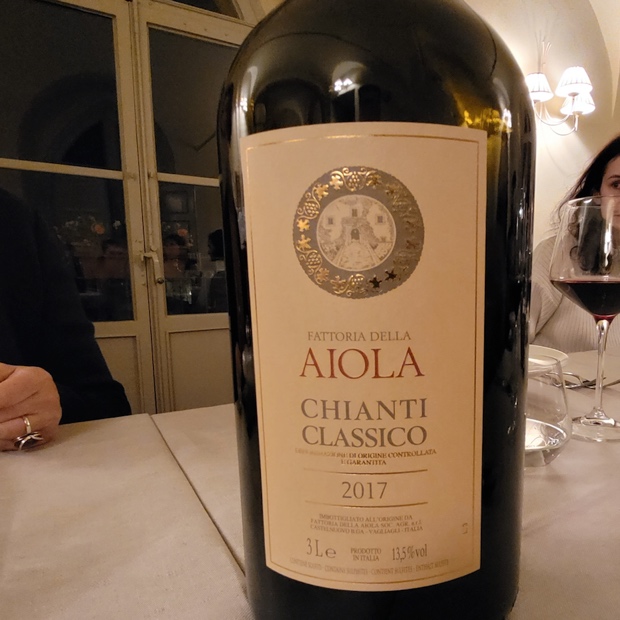
Fattoria Dell’aiola Cancello Rosso Chianti Classico Gran Selezione DOCG 2017
Vagliagli
The single vineyard of vines aged 17 years clearly put the best fruit in the bottle. Every sip offers a new challenge, tempered now and then by more pleasant distractions, namely rich sepulchral scents of raw earth. Last tasted February 2022
Adding Gran Selezione to the mix was an easy decision for Fattoria di Aiola, first because they are a property that has gone through many changes in the 620-plus years history. Second because their Castelnuovo Berardenga terroir is some of that commune’s finest with its mix of Alberese, Galestro and Arenaria soils. One whiff of this perfume and taste of concentrated Castelnuovo fruit is all it takes to be wooed, hypnotized and captivated by what sangiovese can be. As a Gran Selezione this hits all the right buttons while dotting I’s and crossing T’s. “The red gate” shows how those who got it right are well aware that Gran Selezione holds the greatest advantage over Riserva in 2017. The concentration of fruit and acidity never allows the tannins to dry or lash out. Here they remain sweet, integrated and helpful. Cancello Rosso is indeed one of the vintage’s finer efforts. Drink 2023-2030. Tasted July 2020

With Guido Vitali and Vicky Schmitt-Vitali, Le Fonti di Panzano
Le Fonti Di Panzano Chianti Classico Gran Selezione DOCG 2017
Panzano
Feels like Annata multiplied by Riserva and coming out as this Gran Selezione. A happy Gran Selezione at this stage even if it takes longer (being sangiovese), though has already come to near fruition. Fruit, acids and tannins drinking as they are, who they are and who they will be for the next three, possibly five years. After that the wane caused by vintage acceleration will be quicker than somewhere between a few and many. Drink 2022-2027. Tasted October 2021
Querciabella Chianti Classico Gran Selezione DOCG 2017
Greve
Bottled two years ago, a high elevation Ruffoli interpretation of Gran Selezione. The genesis is in experimentation going back to 2010, ever since single high altitude Greve (essentially Ruffoli) wines have been aged and bottled as themselves. Radda and Gaiole as well but let’s face it Greve is the core. Along the way a textural component was noted, fruit associated at its inner sentiment and then in 2017 it was found and assessed to be something really exceptional. Not a wine of wood (and this was aged in old Grandi Botti), but a Gran Selezione about transparency. The soil is Arenaria sandstone and Galestro which can’t help at this elevation to gift a hint of orange rind and an uncanny flintiness. Only Ruffoli smells like this and with tannins so tightly wound mixed with the intense liveliness of that 2017 acidity. The vintage was warm and dry from the beginning but plant adaptation meant no true suffering and these are vines at peace. Vibrancy at peak mixed with pure fruit emotion makes this Gran Selezione a true force of place and nature. Drink 2025-2038. Tasted November 2021
Rocca Delle Macìe Chianti Classio Gran Selezione DOCG Sergio Zingarelli 2017
Castellina
As far as Gran Selezione is concerned and especially in 100 per cent sangiovese form there are few Chianti Classico wines that show such consistency from 2016 to 2017 as this RdM Sergio Zingarelli. This from the challenge of a warm and extremely dry vintage but all three parts remain virtually the same; fruit, acids and tannin. While they work in tandem there is much work to be done. Wait two to three years for the integration to begin. Drink 2024-2028. Tasted February 2022

Rocca di Montegrossi, Gaiole
Rocca Di Montegrossi Chianti Classico Gran Selezione DOCG Vigneto San Marcellino 2017
Gaiole
San Marcellino has been in bottle three years but is still not yet released. “It’s an example of what we can do with a warm vintage,” explains Marco Ricasoli. Fruit is very much alive, hanging casually with freshness and acidity, nary a tired moment making waves or causing distress. Even now the combined fruit of 51 plus 25 year-old vineyards of mainly sangiovese with a few points of pugnitello equip this Gran Selezione with purity and also armour. San Marcellino can withstand the new era of aridity and hot demands. Good temperament is key with help to some bunches that were removed so as not to over-stress the vines. Spent 25 months in barrique (40 per cent) and tonneaux (60). Remarkably cool, rich and a fine juggle (giocoliere) between natural sweetness and Monti savour, salt and sour, tart and smooth. Drink 2025-2032. Tasted March 2022
San Felice Il Grigio Gran Selezione Chianti Classico DOCG 2017
Castelnuovo Berardenga
While the thread clearly runs from Annata through Il Grigio Riserva and into Gran Selezione there is the early feeling of some new (30 per cent actually) tonneaux still swirling through the consistency of this rich and creamy sangiovese. A confected citrus in a way, like pomegranate syrup or the centre of a cherry blossom. Lots of barrel feel, fine tannins and as a quotient there is a really really good potential by result. Plenty of chew in 2017. Drink 2024-2029. Tasted February 2022
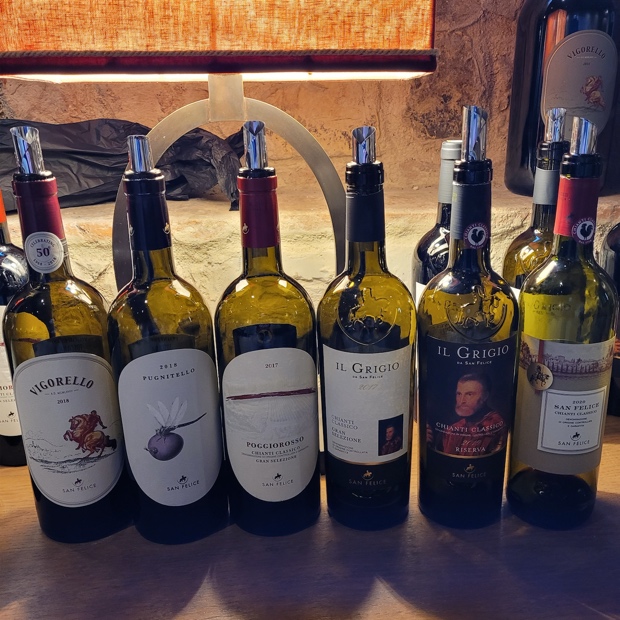
San Felice, Castelnuovo Berardenga
San Felice Il Grigio Gran Selezione Chianti Classico DOCG Poggiorosso 2017
Castelnuovo Berardenga
In the single vineyard Poggio Rosso Gran Selezione (which used to be Riserva) the inclusion of other endemic varieties (in this case pugnitello, abrusco, malvasia nera, etc.) really changes the imagery, drama and vivid personality of this ulterior wine. More depth, complexity and a vinous grapey-ness, surely a result of the inclusion of especially the pugnitello. Deep purple, rich, luxe and volupté. Nothing rustic about it and a completely different way for which the wood is used, felt and exposed. More excitement and intensity to be sure, if perhaps less structure. Drink 2023-2028. Tasted February 2022

The Chiannna of Fontodi, Panzano
Chianti Classico Gran Selezione DOCG (older vintages)
Bindi Sergardi Chianti Classico Gran Selezione DOCG Mocenni ’89 2016
Vagliagli
A Gran Selezione from the Mocenni Estate in a wonderful state of equilibrium and almost calm suspension, of fruit at the pinnacle of vineyard selection with only two passages whereby the “lesser” grapes are taken out and the finest fruit is left until the first week of October to fully mature. Two years in large Gamba oak vats, Was an IGT from 2006, first GS vintage 2010. Sure these grapes from this vintage were some of the most consistent and non-variable of any recent vintage but the uniformity makes for a string and true set of wines, especially from Mocenni and up to this appellative level. Last tasted October 2021
Mocenni takes all the advantage that 2016 can possibly pass its way and runs carefree into the wind. The fruit is pretty much as ripe as there can ever be in sangiovese struck by silver acidity and gold tannins, so you can imagine the result. This needs 10 years to fully unfurl, unwind and unfold. Please give it at least half that much time. Drink 2024-2034. Tasted February 2020
Cantalici Chianti Classico Gran Selezione DOCG 2016
Gaiole
A vineyard selection, from the best vines in what is considered the best sections of Cantialici’s vineyards. Longer fermentation and stabilization to maximize the concentrated and structural effects, done up in all sorts of medium and large format casks, up to 600L for 27 months. Refined further in bottle and so 2016 is the current vintage. Big yet balanced, surely a peak vintage performance, a noble sangiovese no matter how you look at it. Freshness from fine acids and less chocolate though a few shots of espresso reign in the finish. 38 euro at the winery. Drink 2024-2029. Tasted February 2022

Il Becco, Castello di Radda
Castello Di Radda Chianti Classico Gran Selezione Il Corno DOCG 2016
Radda
From the single vineyard just above the cantina facing the village of Radda and Vertine. Aged in tonneaux but not new, 30 months and while the expression is from one vineyard there is a real connection with Riserva, in a brother and sister way, not surprising since most of the Riserva’s fruit is Il Corno in 2016. Harmonious and agreeable Selezione is just this and this wine is just a baby. Great Raddese acidity, fine and long chained tannins, taut and yet to unfurl. The wine is far from ready and it is now easy to understand why this is the current vintage just now being released to the market. Drink 2024-2028. Tasted March 2022
Il Molino Di Grace Chianti Classico Gran Selezione DOCG Il Margone 2016
Panzano
Pure balance. I love this wine. Not just a compromise between two bookending vintages but for all vintages. Here you feel the great grip but not brut strength or power. You really do feel the venosity and the sangiovese purity. Good but lessened acidity and austerity. You can keep this for 15 years but not 30. As mentioned, a compromise. Last tasted February 2022
The first “true” vintage from which freshness reigns, marking a change in farming and winemaking. Evolution to focus, incisions to precision, a succulence noted as never before. Fragrant and flavourful, an intensity of spice, all coming together and into harmony. Last tasted October 2021
Extremely youthful ’16 but the clarity of that vintage’s fruit can’t help but be up front and present. The accountability begins right here, with 2016s out of which fruit was allowed to stay fresh and yet in Gran Selezione form there has to be time. Allow for development and the accumulation of flesh, but also succulence. This sumptuous Margone comes replete without the old style of hammer on head mentality. It’s the new and elegant one. Tasting this offers a clear picture into how Iacopo Morganti has impressed his talents and his will onto the wines of this estate. Sip one here and there over the next 15 years and it will be as close as one gets to standing in these Panzano vineyards in a pair of the Grace’s shoes. Drink 2023-2036. Tasted February 2020

With Monia Piccini, Il Palagio di Panzano
Il Palagio Di Panzano Chianti Classico Gran Selezione DOCG Le Bambole 2016
“I’m not an oenologist but I have to be critical,” tells Monia Piccini. “We are lucky to have an oenologist who is humble and took us by the hand.” Monia’s husband Franco is also from Panzano and knows every inch of this (Conca d’Oro) land. Aged in tonneaux and a smaller production than 2015. The combination of clone and soil type make for small berries that produce cimmerian ink with the most intensity of sangiovese concentration. A very argiloso and calcari block with the presence of Galestro which translates to a depth and breadth of grace but also structure. You can immediately tell that the grittiness of the old vines are not here but more importantly you feel the salinity, sapidity, minerailty and most of all the feeling of the land. It’s sand and limestone, phosphorous and magnesium, focus, precision and clarity. A true expression of place at the pinnacle for the Gran Selezione appellative category. Palagio and Panzanese. Drink 2023-2028. Tasted October 2021

Isole e Olena, San Donato in Poggio
Isole E Olena Chianti Classico Gran Selezione DOCG 2016
San Donato in Poggio
“I did not like Gran Selezione, I did not have anything against Gran Selezione but the discussion about UGA (sub-zones) was already underway so why not wait for this next change to the appellation?” The thinking for Paolo de Marchi was more about the wines that did not qualify for the appellation becoming wines that now qualified, the issue being a new rule could not apply to only 30 or so producers. So what is needed for that to happen? “All grapes born here should be able to travel with a passport.” If it is more complicated than that then there is much more to discuss. A Chianti Classico from a long, linear and fortifying vintage delivers equally appropriate and extending tannins, gripping the composition while proposing to become elegant and fine. The seamlessness and never wavering focus keeps on keeping on, in the ways of emotion in motion. Will remain in bottle one year more before being released to the market. Drink 2023-2027. Tasted February 2022
La Sala Chianti Classico Gran Selezione DOCG Il Torriano 2016
San Casciano
Those two years of needed resolution are on such open display in this generous and gifting 2016 Gran Selezione from the thoughtful, organic and considerate team at La Sala. Il Torrione as a reminder is from the word torre, “the tower,” a garrison/fortress term so common for the area. Great Galestro saltiness if missing an identity that has achieved a level of cult status but perhaps this team is eight years into a plan that will come to full fruition in another seven. Perhaps less or more but the incense, perfect linearity and true identity is developing and approaching the profound. “I think we are between the river crossing,” says oenologist Stefano di Blasi, somewhere between the UGA of San Casciano and the new emotion of La Sala. This ’16 may be a launching point but it’s also just one rung on the ladder. Still a bit tight and the Alberese holds firm so the best is yet to come. Drink 2023-2033. Ex-cellar cost is 19.8 euro. Tasted February 2022

Valeria Viganò, Le Cinciole, Panzano
Le Cinciole Chianti Classico Gran Selezione DOCG Aluigi Campo Ai Peri 2016
Panzano
A first, meaning Aluigi used to be Riserva and out of 2016 becomes a Gran Selezione. The name refers to the trees that grow around the Panzano vineyard, a two hectare block for a wine that is a 100 per cent sangiovese. A selection of an already identified selected area of Le Cinciole’s vines. Valeria Viganò and Luca Orsini made the decision to bottle by choosing a small section and with no distraction by international varieties. Rich and youthful, even a bit Galestro dusty and salty, savoury overall yet with flavours that recall or will soon express as Cassis. A grand beginning for Le Cinciole’s commitment to the appellation, with great fruit and acidity, linearity, verticality and oh so very Classico. Not just another GS but one authentic and real. Veramente. Drink 2024-2032. Tasted March 2022

Le Fonti Di Panzano
Le Fonti Di Panzano Chianti Classico Gran Selezione DOCG 2016
Panzano
Still behind, not as on a schedule but as compared to 2017 holding firm, taking control of your palate, senses and general world. A beautiful wine with grip, structure, sensory domination and circumstance. Last tasted October 2021
Begins at a point just exactly where the Riserva ’16 takes its leave and carries the torch of purity and delicacy. Efficacy too, efficiency for sure and an effusive level of strength that belies its lightness of being. Yes it takes richness in sangiovese from Panzano and this estate to another level but never forgets the heeded understatement it demands to pay forward. Another outstanding effort and worthy of 20 plus years in the cellar. Drink 2023-2035. Tasted February 2020
Quercia Al Poggio Chianti Classico Gran Selezione DOCG Vigna Le Cataste 2016
San Donato in Poggio
Gran Selezione comes from the small 1997 planted two hectare vineyard on argiloso soils, called Vigna Le Cataste that is the Quercia al Poggio cru. The name actually means a pile of wood, an old expression at a time when all things were given a name. A cool and savoury Gran Selezione that is clearly years away from showing the fleshiness that only the clay vineyard gives to this northern side of the estate’s promontory. Wood is a factor, mostly due time and three years will be needed to let this truly begin to breath. The first vintage was 2012 and regardless of what came before the idea here is surely not about making the biggest and most dramatic wine but one that represents a very specific sense of place, done so with confidence and for all the correct reasons. Really it’s all about the fineness of the tannins which Le Cataste surely shows. Drink 2023-2030. Tasted November 2021
Rocca Delle Macìe Chianti Classio Gran Selezione DOCG Sergio Zingarelli 2016
Castellina
Settling in with distinction, crisp and croccante, tannins still smiling their wry smile knowing two more years are needed to get this SZ to where it wants to be. Feeling the classic liquorice chew to match and mix with the crunchy bits. Last tasted February 2022
Sergio Zingarelli the Grand Selezione is the rock, the gentle giant, the patriarch of the company’s wines. As a Grand Selezione it allows its actions to speak for the rest of the portfolio to follow. It leads the estates; Macìe, Sant’Alphonso, Fizzano and La Tavelelle. In 2016 the sangiovese is so different and yet so Castellina in that red cherry fruit core teased by spice. Smells like roses and the feel in the mouth is swelling, rising like a tide increasing as it barrels in. In the scheme of timing it would be prudent to allow those waves in years to go out several times before looking for that window of Grand Selezione opportunity to begin. Drink 2024-2034. Tasted February 2020
Rocca Di Castagnoli Chianti Classico Gran Selezione DOCG Stielle 2016
Gaiole
Stielle is Gaiole and Gaiole is the heart, savour, savoire-faire and soul of this Gran Selezione. Rocca di Castagnoli has captured the essence of their elevation, vintage elongated freshness and full aged in vessel personality through the appellative oeuvre and into the beyond. A tightly composed and well-structured sangiovese here but also one that is fruitful, generous and so very, very long. The real deal and idealism incarnate from a vintage that truly marks a transition to greater things for the territory. Drink 2024-2029. Tasted January 2022
Rocca Di Montegrossi Chianti Classico Gran Selezione DOCG Vigneto San Marcellino 2016
Gaiole
From the classic to Montegrossi blend of 92 per cent sangiovese with eight per cent pugnitello, bottled in December of 2018 so now nearly three full years settled. A Gran Selezione at the peak of vintage accumulation and the longest imaginable tethering of tannin to substantial fruit. Also an acid vintage though to be honest the tannic wind and compactness of Marcellino’s power makes this wine easily two years away from the earliest stages of its softening. Drink 2024-2032. Tasted November 2021

Castello di Radda
Castello Di Radda Chianti Classico Gran Selezione Il Corno DOCG 2015
Radda
A very different vintage for the Gran Selezione, much further along than the 2016 though still less so than many other estates. Connectable to ’15 Riserva in that (in GS) it really is a balsamic year but there is more concentration and gritty tannins in the GS. Lightning red fruit here, of currants and pomegranate with true Arenaria sandstone expressiveness. Also a liquorice tone with more texture and bite than the 2016. And yet the advancement is noted in spite of the high acidity and those grippy tannins. In the window of opportunity and again despite what strong feelings there are in this unique wine. Last tasted March 2022
Deep toned and lifted together, fruit of many layered splendour and full throttle acidity. Big and bigger components working separately at present. Give this five years for the weight of the early ferment to aerate, re-coagulate and tie il all together. Drink 2021-2028. Tasted September 2019

Paolo de Marchi, Isole e Olena, San Donato in Poggio
Isole E Olena Chianti Classico Gran Selezione DOCG 2015
San Donato in Poggio
Bigger and broader vintage, a bit unpredictable, perhaps a temperamental teenager, in and out of emotion but equipped with the necessary tools, ideas and nurtured parts to find balance throughout its life. Now a bit clumsy, high in tone like the flagship Cepparello, herbal and tart citrus edgy. Not a closed phase per se but also not an openly gregarious one either. Last tasted February 2022
“Chianti is not a territory that gives minerality in wines. The low pH and high acidity are the factors that matter most. Here the back palate has bite, but it’s not salinity.” So says Paolo de Marchi as he introduces a series of Gran Selezione. In 2015 the difference between this GS and the Cepparello is not an enigmatic one, nor is it a mystery that de Marchi was not in favour of creating a new category. Still he foresaw and excepted the outcome, so decided to make something special. “In time, after me, it will be a single-vineyard.” Barrel selected from the Cepparello selection, this is not a 100 per cent sangiovese but rather something still in transit, even moving. So tight and tannic, fine-grained, with a new fineness of acidity, but just missing something. Like cabernet franc it is quipped, but no, it wouldn’t have worked anyway. So what then? Time, that is all. Drink 2020-2029. Tasted February 2018
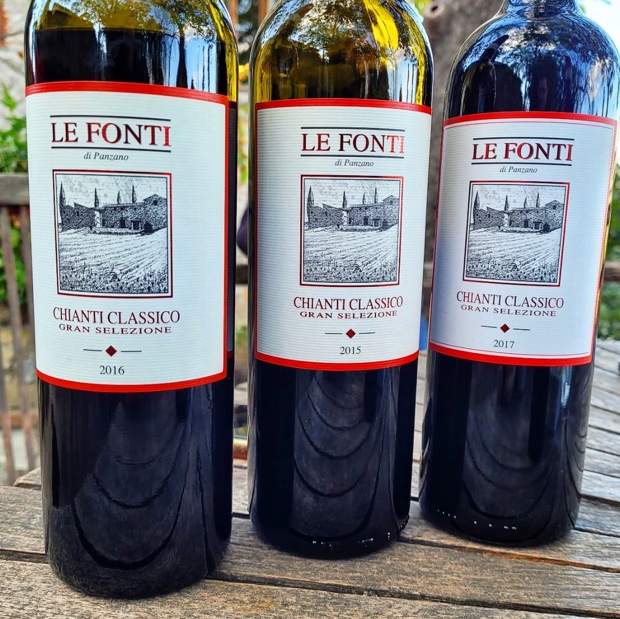
Gran Selezione, Le Fonti di Panzano
Le Fonti Di Panzano Chianti Classico Gran Selezione DOCG 2015
Gaiole
The 2015 Gran Selezione is ahead of both 2016 and 2017 yet behind 2014, a big fat, far from lean sangiovese, muscular puffed up chest and square shouldered. Showing some oxidative notes, tartufo, fungi and chocolate. Way ahead of projected schedule. Drink up. Last tasted October 2021
Thirty months in wood and a year in bottle later, this top estate wine is the pinnacle of the Le Fonti aromatic certainty. A big vintage to be sure and one that extrapolates in every which way but loose. Taut, tight, firm, grippy and every other subset of structure you can imagine. The 100 per cent sangiovese ideal is acquiesced and believe it or not it failed DOCG designation on the first try. Who might see this as light, atypical or not ready for international prime time is surely missing the point. Drink 2021-2028. Tasted February 2019
Losi Querciavalle Chianti Classico Gran Selezione DOCG 2015
Vagliagli
“I like ’15 more because of equilibrium in the aromatics and the structure,” tells Valeria Losi and note that she’s in part comparing to ’16 Riserva and in part to ’15 Gran Selezione not yet released. The 2016s may be more aromatic but the ’15s in Vagliagli and at Querciavalle shows great balance between all its parts. The GS is found to be fuller and if not weightier its fruit surely oozes, swirls and swells. More spice as well, tart but never gratuitously sour and a liquid chalky expression just now beginning to hit stride. An Alberese to sangiovese expression like no other. Drink 2023-2030. Tasted March 2022

Querceto di Castellina, Castellina in Chianti
Querceto Di Castellina Chianti Classico Gran Selezione DOCG Sei 2015
Castellina
Sei ’15 is still showing those sweet balsam wood notes and searing Alberese behaviour so it’s definitely still two or three years away from its opening salvo. Not a shock when you consider the character and structure of both ’17 and ’18 tasted over the last two years. Tannins still show a level of austerity, growl and bared teeth. Despite this rigidity the fruit substance swells, persists and remains the dream of the future. Wait for it. Drink 2024-2029. Tasted February 2022

Fontodi, Panzano
Fontodi Chianti Classico Gran Selezione DOCG Vigna Del Sorbo 2014
Panzano
Vigna del Sorbo from 2014 is showing some perfectly secondary character and while that may seem forward the truth is that seven or eight years is spot on for this type of evolution. Just arriving now at this next stage, something sanguine fruity merging into salty and floral concentration. Last tasted February 2022
As a racer the ’14 Vigna del Sorbo might as well be Giuseppe (Beppe) Saronni, winner in 1978 of three stages in the Giro d’Italia, 24 overall and champion in 1979 and 1983. In 1982 he won the world cup with Paolo Rossi. Sorbo is a global sangiovese, the people’s “campione,” beloved sprinter, collaborator and legacy definer. Today the sangiovese from Fontodi’s Conca d’Oro vineyard smells like rabarbaro (rhubarb), black cherry and cut grass. Beautiful combination.
Tasted September 2018
The older vines are between 52 and 54 years old, the first vintage being 1985 and until 2011, contained some cabernet sauvignon, vines that have since been pulled out. The now site-specific, 100 per cent sangiovese Vigna del Sorbo may have been muscular in 2012 but no such hyperbole exists in 2014. The vintage determined this and despite the deep black cherry chalkiness the true spirit and stripped down honesty of sangiovese is in display. Purity has returned, floral like an artistically-rendered natural, realist and perpetual field of flowers in bloom, in installation, of violet light and rose-scented glass. I can imagine drinking this for decades, with its albarese-galestro saltiness and effortless concentration. Sometimes sangiovese never relents and at the same time never tires. Meraviglioso. Drink 2020-2038. Tasted September 2017
Cantalici Chianti Classico Gran Selezione DOCG 2013
Gaiole
Not a shocker considering the vintage but three years further (as compared to the current Gran Selezione release) shows quite a next level development with greater expediency. Dried fruits, woody notes, mild baking spice and plenty of chocolate, much closer to the Messer Ridolfo than the future iterations of Gran Selezione. Drink 2022-2023. Tasted February 2022
Isole E Olena Chianti Classico Gran Selezione DOCG 2010
San Donato in Poggio
The 2010 has indeed entered a new of next phase, now into the underbrush and what vegetal magic grows underfoot. Chewy and still a matter of great blended intensity, 10 per cent other grapes bringing the fruit and the spice. Could vey well be argued that 2010 is a syrah vintage. Last tasted February 2022
According to Paolo de Marchi Gran Selezione “has to be a wine of Super Tuscan roots, set in a Chianti Classico setting.” Just a little bit more than 80 per cent sangiovese with cabernet sauvignon and syrah. The acidity and transparency is Chianti Classico while the gentler touch is in a way, not. This turns the entire Gran Selezione idea on its head. It’s the antithetical one, in opposition to what or where the category seems to be going but at the same time fully entrenched within the ideal and the rules. It’s a rich and complex liqueur, truly red cherry and new leather, truly high-toned and truly a matter made by a master of assemblage. Truly Gran Selezione. From and for a moving target, out of vineyards and through the cellar. At least in terms of today. The enigma, the past and the future. Puts the question before the answer. Tasted November 2018
Isole E Olena Gran Selezione 2010 graces a factor in which “the blend lifts up the quality,” a noble venture or undertaking that balances the angles and trips into light. The reductive one is, as per the firm and grippy vintage, tannic and taut, wound still in the present, with the carob and the savour. The minty one, in a way, and with graphite and creosote. Very sapid, tight and intense. The most brooding of the four (’15, ’13 this and ’06). Drink 2021-2030. Tasted February 2018

Vinsantaia, Vin Santo del Chianti Classico, San Giusto a Rentennano, Gaiole
Vin Santo Del Chianti Classico
Castello Di Radda Vin Santo Del Chianti Classico DOCG Occhio Di Pernice 2015
Radda
Occhio di Pernice is made from red grapes, here having rested in caratelli for five years. Mainly sangiovese with 10 per cent canaiolo, keeping the pH up with acidity by slightly early picked fruit in Vin Santo terms. Only 1,000 bottles are made of the first vintage, the “lavorato do amore,” labour of love. A savoury one, built on Radda herbs and brush, Raddese acidity, with toasted nuts and roasted chestnut. Even a mild olive brininess. The flavours are centred on wild strawberry in a Vin Santo that is clearly balanced and elegant. Drink 2022-2028. Tasted March 2022
Castello Di Volpaia Vin Santo Del Chianti Classico DOCG 2015
Radda
A warm vintage for Vin Santo, from trebbiano and malvasia, hung for three months and a definite cheese wine. Far from a thick and syrupy example, a snapshot of the vintage, warming, caressing, more than full enough to fill up and coat the palate. Once again the diversity of the appellation (even more so than the Chianti Classico reds) is evident with Volpaia’s finessed and generational wine. Like glazed nuts meeting praline halfway, as if the nuts are braised, softened and made into a gelée or curd. One of the most unique aromatic profiles and textures in Vinsanto. Drink 2021-2035. Tasted October 2021
San Giusto A Rentennano Vin Santo Del Chianti Classico DOCG 2013
Gaiole
Very youthful, only in bottle now 18 months. A classic trebbiano and malvasia blend with just a few percentage points of sangiovese and canaiolo. A Vin Santo of 400 g/L residual sugar which is nothing short of remarkable. A glass of treacle, with just enough acidity for buoyancy. Right in the wheelhouse at 5.8-5.9 TA but truth is (confirmed by Luca Martini di Cigala) is the volatile acidity number at 1.9, more than high enough and the one that matters most. A most fragrant VS as a result and one from which the complexities are truly experienced. No chance of decline for 20 more years. Drink 2025-2042. Tasted November 2021

In Lamole, with Michaela Morris and Giovanni Manetti
Fontodi Vin Santo Del Chianti Classico DOCG 2012
Panzano
At the top of the concentration and full throttle sweetness pyramid is this from Fontodi and the vintage does bring super purposed acidity, thanks God. Not sure it can fully keep up with the sugars but the lemon, rooibos and orange marmalata do the yeoman work to bring flavour complexity and texture to this traditional dessert wine. Poached pear in trebbiano and malvasia, caramelized and levelling in brushstroke across a creamy palette. Our palate is thankful for the finale alongside Margarita’s tiramisu. Drink 2023-2027. Tasted February 2022
Rocca Di Montegrossi Vin Santo Del Chianti Classico DOCG 2011
Gaiole
At just about nine years of age this is Vin Santo in its infancy, likely around 320 g/L and let’s say 4.5-5.0 of total acidity, but it is so very young. Everything about it is primary, aromas of fresh fruit, just a hint of dried apricot and fig, maple syrup and not really caramelized at all. Orange fleshiness and lemon meringue, biscotti with almonds and just a hint of fennel. Great length. Drink 2024-2039. Tasted November 2021
San Giusto A Rentennano Vin Santo Del Chianti Classico DOCG 2001
Gaiole
So resolved and yet so fresh, exciting and of acidity seemingly perched at an all time high. “The aging of Vin Santo is ten times longer than the sangiovese,” explains Luca Martini di Cigala. That means 20 years for Chianti Classico DOCG is like two for VinSanto, which puts this 2001 into infancy, one still emitting primary aromas and flavours. Orange skin, caramel, fig and dried caci (persimmon), not yet into the molasses, brown butter nor toasted nuts. Not really showing much dried fruit complexities as of yet. Hard to fathom but it can be done. Consider the lack of botrytis and caratelli that carry the wisdom of Vin Santos of Chianti Classico past. Drink 2021-2039. Tasted November 2021
San Giusto A Rentennano Vin Santo Del Chianti Classico DOCG 1998
Gaiole
All the necessary ingredients swim engrossingly and energized together; sweet, sour, salty, nutty and tart. The acidity runs high right in the face of the honeyed and caramelized flavours of great reserve matched by intensity. The volatility is wholly in check, the maple aspect uncanny and the spice cupboard truly infiltrated throughout, within and beyond. Magnificent Vin Santo. Drink 2022-2035. Tasted February 2022

With Michaela Morris and Sean Il Guercio O’Callaghan, Tenuta di Carleone, Radda
Sparkling, White and Rosé IGTs
Castell’in Villa Rosato Gazzara 2021, IGT Toscana
From the vineyard where the agriturismo is located and a sangiovese of a few hours of skin contact, no saignée. Grapes are picked early to preserve acidity, the wine is laden with citrus and they are many; lemon, orange and grapefruit namely and a saltiness urged on by the shells found in this vineyard. So much flavour, positive sweetness, not too dry and very complex. “The secret of this wine is that you want it again,” palate cleansing, pleasing and long. Drink 2022-2024. Tasted March 2022
Rocca Di Montegrossi Rosato 2021, IGT Toscana
A tender Rosato, salty, dry and über fresh. Beautifully run from Monti fruit in a vintage out of which an April frost could have spelled disaster but Marco Ricasoli’s sangiovese, canaiolo, colorino and pugnitello did prevail. The Marchi di Monti, brand name varietal signatures that fashion some of the Chianti Classico territory’s most crushable Rosato. If this 2021 is any harbinger for what’s to come in the Annata and Gran Selezione of Rocca Di Montegrossi then great things are on the way. Drink 2022-2024. Tasted March 2022
Cantalici Petali Rosato Toscana IGT 2020
Purposed grown sangiovese for Rosato and just the free-run juice as witnessed by the pale hue and subtle floral aroma. Richer and creamier to taste but suitably salty and refreshingly satisfying. High acids keep the sugars down below and freshness is never compromised. Most excellent Rosato. 11 euro at the winery. Drink 2022-2024. Tasted February 2022
Fattoria Le Masse Camporella 2020, IGT Toscana Bianco
A blend of all the trebbiano available in a year ravaged by hail (grandine) and raised in amphora (from Impruneta). Skin-contact through to January (so approximately three plus months) and a wine of ease, not to mention comfort. When you go in Camporella you take wine, a blanket and food (…”and a girl”…) into a field. Purely amphora, a wine in the end calm, restorative and elegant. Drink 2021-2024. Tasted October 2021
Forasacco, a wild rye or cereal very dangerous when dried, especially to a dog. From the word Forare, “to make a whole” and how the grain might poke a whole in a sac. The three figures on the label represent three girls from Florence who came to help with the harvest. From the 1986 planted vineyard to pinot gris (25 per cent), chardonnay and oddly two or three rows of gewürztraminer. Natural ferment, a stack of fermentation, 2,000-3,000 bottles made depending on the vintage and just now coming into its happy place, even if the white is sold out. Bloody delicious and again, a calming and restorative wine. Distinct citrus, living, breathing, of blue sky clarity and changing. Spigoloso. Drink 2021-2023. Tasted October 2021

Luca Martini di Cigala, San Giusto a Rentennano, Gaiole
Fattoria San Giusto A Rentennano Ruori Misura Rosato 2020, IGT Toscana
“My idea is to make Rosato by not throwing away any grapes” tells Luca Martini di Cigala. A white vinification is created to establish an acid base and then mixed with a wine of salas, for a bigger room of freshness mixed with acidity. In a sense a white sangiovese base wine meeting the last green harvest in September for really spirited and sapid Rosato. Dotato di arguzia vivace, in Renoir Rosé as The Thinker, poised and determined to seek and find the truth. Drink 2021-2024. Tasted November 2021 and February 2022
Fontodi Meriggio 2020, IGT Colli Toscana Centrale
The blend is 90 per cent sauvignon blanc with trebbiano done up in a small percentage of wood for the one the Tuscans would refer to as the one meaning “it’s time to lay down under a tree and have a siesta in the afternoon.” A rich and sunshine dripping vintage for this singular Panzano white, aromatically nutty, of pine nut and then a pour of tropical fruit. Sweet herbal finish wraps up the package in a fine savoury bow. Drink 2022-2025. Tasted February 2022
Principe Corsini Sparkling Rosé 2020, Vino Spumante Rosato
Sangiovese 100 per cent, a green harvest done one week later than most Rosé though even that’s changing. A project with Bisol in Valdobiaddene, base wines sent up there to undergo second fermentation, 12 weeks in tank (much longer than Prosecco). Good salt and pepper seasoning, just a touch elevated in sugar but certainly within a proper threshold (8 g/L) so easily Brut in style. If only they had these San Casciano in Val di Pesa pliocenic hills rich of river stones raised grapes in Prosecco. Drink 2021-2024. Tasted October 2021
Principe Corsini Villa Le Corti Rosato Venusio 2020, IGT Toscana
Juicy, fruity, simple Rosé, well made, could use more seasoning but yes a saltiness comes through at the end. The label is designed by Duccio Corsini’s sister. Drink 2021-2022. Tasted October 2021
Monte Bernardi Trebbiano, IGT Toscana
A varietal trebbiano, now basically two years since harvest, fermented in barrel, zero sulphites and connected with the must of 2020. Brut sauvage essentially. The hope is to see this reach 2 g/L or less, so essentially dry and it’s likely now in a five to six g/L number at this stage. Very pear and mint, wild fennocchio, really complex and good though surely not searing or striking acidity. White peppery finish on a really fascinating wine and yes Michael Schmelzer, surely a better use of trebbiano than accenting sangiovese for Rosato. It’s like sparkling chenin in so many ways, with that washed cheese rind notation. Approximately 600 bottles and 60 magnums produced. Drink 2021-2026. Tasted November 2021
Tenuta Marsiliana Vermentino 2020, IGT Costa Toscana
“A vermentino without contamination,” explains Villa Le Corti in San Casciano owner Duccio Corsini, meaning no chardonnay, no pinot bianco, no nothing other. No wood, only stainless and straight to bottle after approximately five months. Straightforward, salty, well seasoned and thirst quenching. Essential coastal vermentino. Drink 2021-2023. Tasted October 2021

Castello di Monsanto, San Donato in Poggio
Castello Di Monsanto Chardonnay Collezione Dai Vigneti Di Monsanto 2020, IGT Toscana
A painting by the Tuscan impressionist Andrea Borella from the 1800s was found in the house and so Laura Bianchi’s father Fabrizio decided to use it for the chardonnay. The first vintage of the Monsanto Collezione was 1990. A full malo, nearly half in barrel, fleshy and reductively creamy chardonnay. There is a linearity however in 2020 that surely makes this a chardonnay vintage. Quite tight, taut and making demands on the mind, body and soul. Plenty of fruit to back up the attitude and confidence. Drink 2023-2027. Tasted February 2022
Castello Di Monsanto Chardonnay Collezione Dai Vigneti Di Monsanto 2019, IGT Toscana
Reminds of chardonnay that once was, used to be and here one of comfort from a happy vintage for 30 per cent to be aged in tonneaux. The rest in stainless and then a year of further bottle aging. The vines were first planted in 1976, then again in the 1990s and finally in 2020, bringing the total hectarage up from four and a half to seven. Laura Bianchi’s father once made a traditional method sparkling wine from this fruit called Bianco di Bianchi. Yes, a happy vintage this 2019, equal, balanced, rich and vigorous, smooth and salubrious. Monsanto wants to make chardonnay that will age and to do so must be picked at precisely the right moment. As here. Drink 2021-2026. Tasted October 2021
Querciabella Batàr 2019, IGT Toscana
Bottled at the beginning of May and to be released around Christmas time or early January. A true anteprima tasting of this chardonnay and pinot bianco joint with some but still a real decreased amount of bâtonnage. The bungs are made of silicon but also threaded so that when they are secured the seal is just about perfect, less oxygen gets in and also maintains the sulphur level. They expand as they are inserted and what this effects is a decrease for sulphur usage and so it’s a white wine easy to certify organic and keeps the natural component through the use of a tool for fine tuning. Batàr 2019 shows as much fruit substance and creamed texture as ever before while also a chiselling that’s at the top of its very special game. Fine tuning always on the move and so focus, precision and finesse are unparalleled for white wine made from this land. Drink 2023-2032. Tasted November 2021
Cantalici Cantavento 2018, IGT Toscana
A varietal malvasia bianca, saline, green olive briny yet in tapenade, preserved lime in sherbet and avocado. Smooth and seductively metallic, crisp enough yet also creamy and even oily, with a good level of glück. Ages for six months in older French wood, Approximately a 5,000 bottles per year production. 14 euro at the winery. Drink 2022-2024. Tasted February 2022
Villa Calcinaia Mauvais Chapon Rosato Metodo Classico 2016
Sebastiano Capponi’s traditional method sparkling wine receives a tirage of VinSanto, almost Canadian in a way and three-ish years on the lees. The name is a funny riff, literally the “bad capon,” a gallo nero/Capponi family dualistic pun made in reference to the French siege of Florence in 494. An offer was made, refused and the trumpets sounded. Ancestor to Sebastiano named Piero led the revolt. France is the connection, family the conduit and toasty, gingered and oxidative bubbles the modern day result. Crisp citrus, herbal tonic and a rounder, luxe and fuller wine comes from the long and generous vintage. Good fun, pleasure, times and stories shared will be had by all. Drink 2022-2025. Tasted February 2022
Castello Di Radda Vermouth
Made from a Rosé base wine with 36 herbs for a 5,000 bottle production, “to do something different during Covid.” Mainly rosemary, sage, lavender and elderflower, typical of the area in Chianti Classico. Really quite elegant, sweet and perfumed Vermouth, pretty and floral, just mildly bitter. Getting some citrus, verbena almost into lemongrass, orange peel and even fresh peach. Really expressive and blessed with glycerin texture. Would take a Negroni to the next level. Tasted March 2022

Fontodi’s Giovanni Manetti with Michaela Miha Morris, Lamole
Solo Sangiovese IGTs
Casa Emma Harenae 2019, IGT Colli Della Toscane Centrale
Harenae as in sand (Arenaria) and the material used to make the terra cotta from Impruneta. A 100 per cent sangiovese, vinified entirely in (three) 1000L amphora, one year spent there, stirred twice daily, around 45 says capello sommerso. This is the second vintage and total production of 2,500 bottles per year. Changes face in different vessel, now a pure syrupy distillate, glycerin and the fruit heads into the tropical, white peach perhaps but always the blood orange, especially in this vintage. Could contain five per cent malvasia nera coming soon. A wine of great presence and truth be told almost too easy to enjoy. Faboloso. Drink 2021-2024. Tasted October 2021

Sampling 2021 tank samples with Giovanni Manetti, Fontodi, Panzano
Fontodi Dino 2019, IGT Colli Toscana Centrale
Dino is natural sangiovese aged four months in Manetti amphora, textural like no other Fontodi wines spilling over the rounded brimming edges with blood orange and liquid peppery piques of pure, unadulterated joy. Moves easily and effortlessly through pools of Amaro liqueur before exiting at cured salumi savour. Drink 2023-2027. Tasted February 2022
Montecalvi V.V. 2019, IGT Toscana
Just bottled a few weeks ago and from the 1932 planted vineyard. Essentially sangiovese though having been planted then it’s surely a field blend with a few plants of canaiolo, trebbiano, etc., The aromas are so different, lifted aromatics that sing while the volatility remains really low. Won’t be released for years with 2016 being the current vintage available. Talk about the texture and the passion (55 euro retail so 100-120 Canadian). Incredulous wine from a very specific old vineyard. Drink 2024-2031. Tasted March 2022
Principe Corsini Villa Le Corti Figo Sangiovese 2019, IGT Toscana
Sometimes the opposite of expectation happens between sets of wines contrasted against vintages and thus the look at Per Filo and Figo from 2018 and 2019. A matter of emotional randomness, “but what happens doesn’t really matter.” You may compare to Gren Selezione Zac if you must because it a steadier and more consistent trajectory. That is due to more control, direction and hands on actionability. There is some meatiness to Figo in ’19, a minor gaminess, “selvatica,” raw and uncultured but that’s just early fresh bleeding happening. It may disappear next year. That will become the future because of the perfume, the sweetness of the palate and also the acidity. Takes your breath away at the finish. Calls out for a second glass and bottle. 115 euro retail. Drink 2024-2029. Tasted October 2021
Principe Corsini Villa Le Corti Per Filo 2019, IGT Toscana
Immediately less reduction than 2018 and a fresher, more forthright expression of the single Guliae vineyard. Lifted perfume, a bouquet of florals, somewhere between violet and rose. A sweetness and a layering of fruit flavours and textures somehow obstructed in 2018. It would seem very quickly that 2019 was special for Per Filo and Figo, and therefore will also be for (Gran Selezione) Zac. 50 euro retail. Drink 2022-2026. Tasted October 2021

Il Guercio, Tenuta di Carleone, Radda
Tenuta Di Carleone Il Guercio 2019, IGT Toscana Rosso
Il Guercio means bastard, essentially, a name given to oenologist Séan O’Callaghan by a chef friend, kind of like the one-eyed Notre Dame reference. O’Callaghan was born with only one and so his brand shares the story of his life. Like Uno the wine is 100 per cent sangiovese but here from the Mello vineyard in Gaiole in Chianti at 700m. That alone will make it different, fresher than most Classico and then there is the five months of Piedmontazine maceration. Then pressed off in February, “the wine we go to the border with,” of no oak, just cement, possibly an egg, or both. Only sangiovese and the wine that is asked to take the greatest risk. The pH is raised which is something Séan does not want, the colour drops (which he does not care about), but most important is the great polymerization of the tannins. It’s a complex weave of freshness and greens swimming in their pool of the finest bloody tannin. Even though the maceration is higher the integration and the aforementioned complex weave declares that volatility negligible, at most. A toss up between Il Guercio and Uno as to which offers the most appeal but here is not a place for splitting hairs, or putting on heirs. The world holds room for both. Drink 2024-2033. Tasted March 2022

Sean “Il Guercio” O’Callaghan, Tenuta di Carleone, Radda
Tenuta Di Carleone Uno 2019, IGT Toscana Rosso
Uno must be put into context with three sets of ingredients contributing to the final account. First is sangiovese, raised in Radda. Second is the maker, Il Guercio himself Séan O’Callaghan, the man who carries in pocket three decades of making wine in this area. Third is the concept that if pinot noir and nebbiolo had a baby it would be sangiovese. Methodology sees to minimal extraction over a very long period with one or two pump-overs early on, for just five minutes and then you basically wait. First things first. Uno has some lift and volatility but conveniently, snugly and completely held in check. “The lighter the wine the more oak you can put on it,” explains Il Guercio. And so with the lift and volatility you get spiciness, not chocolate and coffee. That’s today’s epiphany. A 100 per cent sangiovese and the lightest wine of the lot put to a small amount of new oak. “The soul of sangiovese,” one grape, one love. Sure there is a litheness of being but there is an organza fabric sheathing of barrel and such spice one may have never come across in this territory. When Bourgogne is at its best the lightest, most transparent and infinite pinot noir is elevated and lifted by just a modicum of wood. But sangiovese? It’s never done this way. Séan’s Chianti Classico may tend to nebbiolo (if a comparison needs to be made) and so Uno looks at Burgundy. But really, what is this? Drink it or age it? Which is it? Flavour and texture. Umami and Zen. Reality and freedom. What else is there? Drink 2024-2033. Tasted March 2022
Fontodi Flaccianello Della Pieve 2018, IGT Toscana Centrale
Once again hear this. The vintage 2018 is not a small, light and easy one. If Vigna del Sorbo proved this point then Flaccianello drives it home. This is the first vintage in which some younger vineyard fruit lower down in the Conca d’Oro near Giovanni Manetti’s house was used to regulate, make fluid and more succinctly “scoverrole” the grip of this wine’s tannins. Like a river’s flow, the fruit insertion causes the grippy juice to flow across the palate in a more caressing way. The 2018 is a serious wine and needs time, plenty of precious time and you must heed this call. To understand the breadth and depth this is completely necessary. Drink 2024-2033. Tasted October 2021
Isole E Olena Cepparello 2018, IGT Toscana
Running like the eponymous stream through Isole under a September shower. In the words of Paolo de Marchi. “I like ’18 because I’m not looking for the biggest power in this wine. It’s also a matter of balance in the extraction and I expect this is a vintage that will age very well.” Showing with that expected revelry four months later, well short of that six to eight year premonition. Last tasted February 2022
A different and great vintage, so apposite for Chianti Classico, here bigger, 100 per cent sangiovese benevolent, as always from the friable schisty marl, grey to blue Galestro soils at the top of the Olena hill, facing southwest. Much of the fruit is from the oldest vines where they foster a naturally low yielding premonition. In 2018 the fruit darkens and of an incombustible inhalant that instead moves with perfumed rhythm. Big, beautiful, charitable, altruistic and in another six to eight years will morph into something almost completely other. That’s the window to catch and taste what will be. Wait for it, don’t miss out and revel in the glory. Drink 2024-2029. Tasted October 2021
Principe Corsini Villa Le Corti Figo Sangiovese 2018, IGT Toscana
Figo comes from the central part of the three-sectioned single vineyard, again organic and biodynamic, non sulphured and in line with Zac Gran Selezione and more so Per Filo. Figo makes reference to a fig tree and a “nickname” dedicated to Duccio’s son Filippo, also like Per Filo. These are wines conceptualized by Duccio though his hands are off of them, “until I become intimate with them.” There is sweetness to this fruit, an absence of earthiness and “carnale,” certainly no “animale.” A gorgeous and alone wine, singular, spirited, lifted, emotional and really fine. Only 800 bottles made from three barrels. 115 euro retail. Drink 2023-2028. Tasted October 2021
Principe Corsini Villa Le Corti Per Filo 2018, IGT Toscana
From the same vineyard as Gran Selezione “Zac,” hand-picked and a selection of one of three plots, this from the western section, raised in tonneaux. No added sulphites, a natural expression of place, one hundred per cent sangiovese, reductive, needing air time. “Natural wines are like the sunset, the heat and situation changes and the process of evolution in the glass is greater than other wines.” Here the blood orange and sanguine notes are readily apparent, the post spezzatura in full aromatic and sensory swing. There is a sweetness and a transparency to the fruit that appears in ways only these wines from this vineyard are want to show. 50 euro retail. Drink 2022-2026. Tasted October 2021
San Giusto A Rentennano Percarlo 2018, IGT Toscana
“The season was a copy of 2016, but the wines are not the same,” explains Luca Martini di Cigala. Mid-September was the difference. In Dylan’s words, “a change in the weather was said to be extreme,” high temperatures flew in by day and the ripeness came hard and fast. “But what’s the sense in changing horses in mid-stream” and so Luca did not react but sat back and let things happen because in his words, “what can you do about it?” And yet this elegant, satiny and harmonious sangiovese elicits a swoon, of scents misty and the grace lays sapid with succulence. Feels like a glass liquid of candied roses and violets. Tannins are there but they slide and glide along. Plenty of Percarlo sangiovese blood on the tracks. Drink 2025-2032. Tasted February 2022

Riecine, Gaiole
Riecine Di Riecine 2017, IGT Rosso Di Toscana
Clearly combs the warm and arid vintage with a 100 per cent Gaiole sangiovese made by winemaker Alessandro Campatelli. A wine taken from barrel in September 2018 yet even still (and also the well-developed vintage) so far from steadying, readying and opening for business. Spices are omnipresent, depth of fruit, acidity and earth all pervasive. The freshness is more implosive inward then outward in expression. Almost takes your breath away. Time will offer reward. Drink 2023-2028. Tasted October 2021
San Giusto A Rentennano Percarlo 2017, IGT Toscana
A Percarlo of 100 per cent sangiovese and in Luca’s opinion an arid vintage that shows much greater acidity than previous warm and similar near equivalents like 2011 and 2012. The ability in necessity to sort and eliminate sun-burnt berries makes this 2017 fresher and also enables it to age much longer. Freshness yes but also 2017’s solar accumulation and intensity of concentration. The acids are in fact raging and sweet, the tannins pretty fine and just at that drying edge. But the wine is very long and will indeed age very well. Drink 2023-2029. Tasted November 2021
Castello Di Monsanto Sangioveto 2016, IGT Toscana
From a single vineyard called Scanni, planted by Fabrizio Bianchi to 100 per cent sangiovese vines in 1968, well before the concept was allowed. First harvested in 1974, calling the wine sangiovese grosso because the berries were larger and the bunches as well. Bianchi wrote it on the label really big to show people that the sangiovese grown in Chianti Classico was equal at the very least to that which was growing in Montalcino. Also bottled in Bourgogne shape to equate sangioivese to pinot noir. Aged in tonneaux, one-third new. Earthier and more of a gathering by hunters and foragers; alla campania, frutta di bosco, frutta secco, gariga and game. Not so ferric or hematic but perhaps a guinea fowl or pigeon note. Works so perfectly well with Pollo alla cacciatore. A revised drinking window: Drink 2023-2030. Last tasted February 2022
Scanni Vineyard, not labeled as such (absurdity of Italian law for IGT wines) but a wine that has been vinified this way since 1974. Made from the larger berry clone found in Il Poggio but here 100 per cent sangiovese whereas the Chianti Classico have five per cent canaiolo. Darker fruit, a south-southwest facing vineyard with Galestro and calcari-argiloso content. Smooth grain of tannin so different than Il Poggio. A real curious and cool study in proximate space sangiovese contrast. Drink earlier and often. Drink 2021-2025. Tasted October 2021

Working farm, Val delle Corti, Radda
Val Delle Corti Extra Vino Rosso 2016, IGT Toscana
The same experiment in 2016, old clones, a selection of fruit from the Riserva block. Four years in large barrel and honestly this could very well be labeled Gran Selezione as a 100 per cent sangiovese. Also fermented in open top wood fermenters with some oxidation and in this case only three weeks on skins capello sommerso style. So really a classic Chianti Classico fermentation though no, not there (yet) but a Vino Rosso. Reasoned glycerin and softly seasoned, elegant as much as that word can mean to sangiovese or rather how it may be used to describe a luxe and silky wine. Extra, extra, read all about it. A phenom of Radda acidity and extrapolation. Drink 2022-2027. Tasted October 2021
Isole E Olena Cepparello 2011, IGT Toscana
No it’s not Côte-Rotie, nor is there any over abundance because a little bit of creativity makes Cepparello 2018 go pop. Also hard to believe this wine is 10-plus years old because the freshness rules and reigns. Will live in infamy. Last tasted February 2022
“Molto parfumato,” binds an aromatic agreement between myself and Paolo de Marchi upon sniffing this ’11 found on Locanda Pietracupa’s wine list. “Cepparello needs time,” says Paolo, understatement of the obvious for the evening, year, decade and history with respect to sangiovese grown in the Chianti Classico territory. Also truth succinctly spoken, roses and violets exhaling and a 100 per cent varietal (or so it seems) profile of succulence and one to fully draw you in. Mint to conifers, multiplicity by complexity value, not to mention vigorous acidity sent straight to a mouth with a full compliment of wisdoms able to think about the situation. A linear Cepparello seeing its wide open window at the 10 year mark. And now a Paolo de Marchi story. “One side of the vine’s grapes were burnt and so I called up (Consorzio Direttore Giuseppe) Liberatore and asked are we changing the name of the appellation? Liberatore said what? To Chianti Amarone replied de Marchi, or sangiovese Port? Joking aside, a stringent selection and a five per cent inclusion of trebbiano did for this ’11 Cepparello what viognier might do for syrah. Not a Chianti Classico so perfectly kosher. A secret until now but all above board. Totally cool. Drink 2021-2026. Tasted October 2021
San Giusto A Rentennano Percarlo 2007, IGT Toscana
Also a warm summer but without extreme temperatures. Not just early budding in March but also so quick to grow and spread. A September of escursione, diurnal shifts in temperature fluctuation to preserve acidity and keep freshness in the sangiovese. Now fully into secondary territory and more advanced than 2006 but close enough in showing persistent vitality. More balsamico, soy and developing character, bigger than 2006, less elegant. Drink 2021-2024. Tasted November 2021
Isole E Olena Cepparello 2006, IGT Toscana
Since 2005 Paolo de Marchi started bottling Cepparello as 100 per cent sangiovese and without sulphites. The 2006 surely shows evolution while maintaining precision and purity, all without the need for heavy sulphites inside. Plenitude of fruit in more ways than one, some fresh and others dried like plum and persimmon hung on strings in a cold cellar. A rare Cepparello of liquorice and 15 year-old acidity that sings, spits and shines. Clearly kept under perfect cork, almost no oxidation which means true micro-incremental development. Dangerously high toned in the most beneficial way. Drink 2022-2026. Tasted February 2022

Flaccianello della Pieve, Fontodi, Panzano
Fontodi Flaccianello Della Pieve 2001, IGT Toscana Centrale
Youthful is the proverbial understatement, zesty and full of Panzano life the other. A sangiovese in strike of ideal accord, freshness captured in bottle and development low, easy and slow accrued. Just like the season, stress-free, never too hot, never too wet. Stellar autumn of warm days and retentive cool nights. A late harvest and full phenolic character. It all shows in this 20-plus year-old Flaccianello, singing a ballad, verse after verse, refrain post refrain. After 20 minutes a sweet porcini perfume emits and one wishes for a 50 day dry-aged Chianina Fiorentina. What fortune! Along with the special effects of smoky rosmarino and wild fennochio. Drink 2022-2029. Tasted February 2022
Fontodi Flaccianello Della Pieve 1993, IGT Toscana Centrale
A bottle with the most subtle amount of TCA but also one that should never be sent away. Acidity and freshness are far from peak performance, waning like a gibbous moon. Accessible and ostensibly intact, a matter of integrated tactile function, a massaging of south facing Conca d’Oro vines messaging through the auspices of mighty fine evolutionary powers. Offers up a way to talk about 1993 and recall the turbulent mid-1990s in general. To say this is a sangiovese from a time when anything and everything might happen helps to soften the Brettanomyces effect and to allow microbial bygones to be bygones. Just enjoy the silk textured ride. Drink 2021-2023. Tasted October 2021
Castello Di Monsanto Sangioveto 1986, IGT Toscana
From the 1974 planted sangiovese grosso Scanni Vineyard and at the 12 year mark this 100 per cent sangiovese would have just been hitting its territorial stride. In fact at 35-plus years it should be said that Sangioveto only hit the top of its own aged hill perhaps six to eight years ago. The fruit is in tact, the acids sharp as a tack and the tannins just recently solved and resolved. And this is the original cork. Blessed. Earthiness and dried fruit plus nuts for what Sangioveto always shows and side by side with 2016 you could hardly tell more than a decade’s worth of distance. Happy birthday, buon compleanno and auguri to all you 1986s. Drink 2022-2026. Tasted February 2022
E buono I say to Bernardo Manetti. “Of course it’s good” he answers, eyes rolled northwards, as if he’s responding to Dad Giovanni. Flaccianello 1983 was Manetti’s third vintage, a beneficial one with great potential and 38-plus years onwards the confirmation is indeed il budino. That and the hallmark of a wine aged, developed and inveterato by a Panzano and al tempo Chianti Classico freshness on the finish. Not to mention a parochial acidity still present, accounting for the super capacity to love and age. Truth be told more wood effect comes from ’83, even if the emotion is only now a matter of shadows. This truly does scent like dry aged beef and there is no doubt 2001 will access a similar funk but with even more succulenza. Here yet another Manetti sangiovese that slides with scorrevole ease across the nerves. Drink 2022-2024. Tasted February 2022

Morino, San Casciano
After six years of trials this (red) malvasia from Massimo Becattelli has come to light and my oh my what an introspective introduction. Hard to imagine why more producers do not plant and champion this endemic variety with greater love and emotion. There are only 8,400 bottles made of this varietal Chianti wine in the Classico area, a succulent red of music and tannin, heart, headiness and soul. Drink 2023-2026. Tasted March 2022
Sri Lankan born and Brit oenologist slash winemaker Séan O’Callaghan worked for years at Riecine with founder and Englishman John Dunkley, along with Carlo Ferrini. Riecine was sold in 1996 to American Gary Bowman and in 2012 to Russian interests, which is when O’Callaghan parted ways. That was 2016, when he created Il Guercio, with the first vintage being 2015 while also working with Austrian Karl Egger, owner of Tenuta di Carleone. For Randagio long macerations are up to five months and while it varies, here the usage is approximately 40 per cent whole bunch. Fascinating, hold your breath and cross your fingers stuff it would seem but this cat has nine lives. The blend is 50 per cent cabernet franc, (40) merlot and (10) sangiovese. “For me this tastes like gamay,” tells Séan. Randagio is a mixed up dog and a mash-up of French varieties. It should be Meticcio but instead it’s Randagio, i.e. “the stray.” Meticcio 2018 was the first, Randagio the second and life is mimicked, the wine laid back, really just about fun. The adage holds true that you can make a funky label and still make nice wine. Fruit-centric, perfectly leathery and swarthy. Drink 2022-2026. Tasted March 2022

Timeo, Fattoria Le Masse, San Donato in Poggio
Fattoria Le Masse Timeo 2019, IGT Toscana Rosso
Timeo, the 100 per cent canaiolo from 60 year-old vines (1961) and 2,300 bottles made. Claudio feels that (based on their grapes) that 2019 is the best vintage of the last six. Picked in late September but before the hottest final days and so there is a relaxed and balanced feel, purity of red fruits and truly fine acid backbone. Linear wine but without angles, certainly not round and simply seamless. More so a matter of pH waving over the palate. A blood orange moment though not sanguine, really just a fine, lightly tannic and particularly expressive canaiolo. Drink 2022-2026. Tasted October 2021
Dedicated to Santo Spirito, the church and the artistic centre of Florence. 6,600 bottles made. Absolutely! Sacred spirit alive, an old Chianti recipe, of sangiovese (80 per cent), with canaiolo, colorino, malvasia nera, malvasia bianca and trebbiano. Was and could still be a Chianti but thankfully not. The wine is simply too good and too fine, Clarity, fruit purity, freshness and drink-ability off the charts. Glug glug, back up the truck. Drink 2021-2025. Tasted October 2021

L’Erta di Radda, November 2021, 2021
L’Erta Di Radda 2 E 2 2019, IGT Toscana Rosso
A most amazing four-poster blend of two red plus two white varieties, first with sangiovese and canaiolo, then trebbiano and malvasia, two plus two. An ark of Chianti Classico endemic varietal covenant, walking in two by two, 70 per cent reds and 30 whites. The dominance is of course sangiovese at 60 per cent in the co-fermentation but the “traditional” 10 per cent white inclusion is tripled while also gauged in an apposite methodology, with Diego Fennochi using the Governo method on only those white grapes. Makes for an intensely aromatic wine, floral of course, though in the freshest of bouquet. Concentrating the white contributors doubles or perhaps even triples down on the effect and creates the most lifted regional experience. The first vintage was 2014, back then having employed the 10 per cent white grapes in the first two vintages, after which Diego decided to go all in. Comes out at 13.5 per cent and the wine simply pops, with rocks and minerals, elements and stones. It’s really quite beautiful. Drink 2022-2026. Tasted March 2022
Bottled just before the Chianti Classico 2019, so just three weeks ago. A blend of sangiovese with canaiolo and colorino, as it’s its nature and privilege. The sangiovese is taken from the vineyard on top of San Francesco’s hill, adjacent the canaiolo and colorino vineyards. A limited (3-5,000 bottle) production, a wine that’s all about selection (from two vineyards) and elevating craft to the highest of Il Molino di Grace levels. Still sees some barriques but going forward the plan should be to age only in large casks. The chewiest and most textural of the wines, with sapidity and colour matching salinity, acidity and savour. Drama but one in complete control, that is Gratius. Drink 2023-2030. Tasted February 2022
As a solo artist pugnitello is extremely vinous, so very grape juicy and pitchy as a clear Castelnuovo night. Tons of flavour, depth and charisma, uniquely varietal and you can really see why Leonardo Bellacini and San Felice have invested so much experimental time and effort in to the grape. Gains richness and fleshes as it airs. Drink 2023-2026. Tasted February 2022
San Felice Vigorello 2018, IGT Toscana
Vigorello comes from a time when Chianti Classico producers wanted to step up and away from disciplinare restrictions and make wines of freedom and artistic expression. It was a sangiovese and cabernet blend, then fully Bordeaux styled and finally From 2011 the pugnitello became the biggest (35-40 per cent) part of the blend. The 2018 comes away cimmerian dark and balsamic luxe with dark soy, high acidity and real international styling. Nothing Classico about Vigorello, only a kinship with Poggiorosso because of the pugnitello. For lovers of rich and luxurious Tuscan wines. Drink 2024-2028. Tasted February 2022
Il Molino Di Grace Gratius 2017, IGT Toscana
It seems to be a repeated story ad nauseum but 2017 saw a small amount of rain after the frost and then none for three months, with some 40 degree days and 30 degree nights. The lack of diurnal fluctuation might have been an issue for many but allowing grapes to fully mature right through September, downgrade their sugar and alcohol and ultimately find balance was the key to success. Gratius found it and delivers a punch of fruit, kept acidity and a swath of chocolate ganache. More wood is felt from 2017 but that was unavoidable. The only adjustment would have been to put water into the wine. And so it goes that 2017 is what it is. Last tasted February 2022
Gratius is actually a 90 per cent sangiovese blend with (10) canaiolo and colorino. A grand Gratius, finely chalky, with the additional grapes adding sublime complexities. The wine is an authentic expression of the Classico trinity of endemic varieties. Unaggressive yet knowable and powerful. Lots of ganache at the finish, the first of which incidentally is shed of distraction and excess baggage. The new label (and all of IMdG’s) were designed by the late sommelier Valentino Monticello, this ’17 to celebrate the 20th vintage he’d been apart of the winery’s work. Frank Grace met him at Harry’s in London. Tasted October 2021
Gratius expresses the vineyard in ways the Annata, Riserva and Gran Selezione appellative sangiovese do not. This 100 per cent sangiovese reeks of the vineyard; fennel. rosemary and gariga. From the part of the vineyard at the peak of the hill where San Francesco’s hulking sculpture towers and watches over the sangiovese. Grip, intensity, signs, wealth of fruit, knowledge and portents. So fine. Drink 2025-2038. Last tasted September 2019
A varietal cabernet sauvignon, “a slow burner” as winemaker Tim Manning calls it and so a wine that stays in bottle for a good long time. Yet it scents directly of cabernet sauvignon but just as much Toscana and I’d go so far as to say Greve in Chianti. Youthful is the understatement, complexity the operative over and actually quite the traditional wine. Surely some volatility and Brett but with this much going on there can be many hats worn and hung up to rest. Such a rich and chalky wine that tastes like nothing else but still just seems to be from here. Drink 2023-2028. Tasted March 2022
Castell’in Villa Santa Croce Di Castell’In Villa 2009, IGT Toscana
“Our little bastard this one,” says the Principesa, a combination of sangiovese and cabernet sauvignon, more or less. Remarkable longevity from this “little” IGT blend, not really so little and after all an important wine for the estate. Expecting more evolution is normal and so imagine the surprise when you find out how little this has actually evolved. Sees barriques (as opposed to the grandi botti for the solo sangiovese) and while chocolate is everywhere, so is freshness and energy. Good vintage, great grapes and attentive winemaking work. Drink 2022-2024. Tasted March 2022
San Felice Vigorello 2008, IGT Toscana
At the time Vigorello was a super tuscan blend of sangiovese and cabernet sauvignon. Vigorello does not go through the same kind of transformation as is witnessed in a Poggiorosso with the same soy, balsamic and pitchy depth showing in this 2008 as would emit by a recent vintage. Also less juicy freshness and more oxidation than the sangiovese yet plenty of lush, rich and hedonistic character. Drink 2022-2024. Tasted February 2022
Il Molino Di Grace Gratius 2005, IGT Toscana
“I don’t think it’s 100 per cent sangiovese and I do know the wine has held up very well,’ tells Iacopo Morganti. Freshness persists with porcini and plum pudding, orange zest and balsamic. Many shades of chocolate and acidity not yet (maybe never will) abating. Keeps its groove and 17 year-old dance moves gliding across the palate. A very good older vintage for Il Molino di Grace, perhaps the best of its mini era. Last tasted February 2022.
A next look nine months later confirms what Iacopo insists. “The acidity’s finished for me. It’s ready to drink now.” At this juncture Gratius 2005 has abandoned its fantasy in concession to a drink now reality. Tasted February 2017
The Gratius 2005 shares DNA with 2009 aromatically speaking but in texture and expression the litheness is pinot noir like, with a bit of bretty volatility as an impression that is vineyard funk derived. Just now beginning a drinking window in performance for the art of perfect timing but why not imagine the installation persisting for 10-12 more years? Here the Montefili Galestro vineyard is clearly iterated in a funk-soil-chalk-liquid rubies way. A brilliant peek back because the tart is just so right. Ask the question, “what was the old wine like?” The answer is “it was like old wine, that is to say, like all old wines.” Drink 2016-2022. Tasted May 2016

Isole e Olena IGTs
Do ut des brings cabernet sauvignon, merlot and petit verdot into mix, darker of fruit, herbal and full of both currants and roasted nightshades. A veritable caponata in a glass, Mediterranean, with black olive garnish. These are grapes that had an easier time in the dryness of the vintage and so the wine is soft but full, so very ripe and really gastronomic. Merlot pick started on the 21st of August, which is incredible, and yet it is soft and ripe. This wine is delicious now, won’t last like the sangiovese, but so ideal for restaurant pours. Drink 2022-2027. Tasted November 2021
Castello Di Volpaia Balifico 2018, IGT Toscana
A field blend of sangiovese and cabernet sauvignon, roughly two thirds to one third and yet the showy expatriate variety acts like it runs the roost. A bigger wine on the nose but soft enough on the palate. A wine of pomp and pleasure, plenty of sweet wood fluidity and made since 1985. “To make something different, for a different palate.” Balifico grows up close to Coltasalla but it truly is the cabernet that takes it down a different path. For whatever anything is worth this is a truly proficient, beautiful and special red with confidence, purpose and style. Drink 2023-2029. Tasted October 2021
Istine Merlot 550 2018, IGT Toscana
Merlot is not used for any other wine because Angela Fronti chooses to keep her Chianti Classico as sangiovese, although some recent plantings of malvasia nera and canaiolo could change this in the future. Merlot is a small plot at lower elevation in the Radda Istine vineyard. Lots of oak here, as is the want to match merlot, allow it to flesh out and age with distinction. That it will though the lavender is extreme and the vanilla welling on through. Drink 2023-2025. Tasted October 2021
Isole E Olena Collezione Privata Syrah 2018, IGT Toscana
According to Paolo de Marchi “this is the most elegant syrah I have made.” He attributes the success directly to the vintage. It is in fact silk tethered, smooth textured, naturally sweet and just the easiest syrah. Seductive and again sweetly endowed in phenolic terms, a perfume of calm and beauty. So yes this is an elegant varietal wine, less structured, peppery and demanding than most. Drink 2021-2025. Tasted October 2021
Spice, chocolate, dark fruit with nominative verdancy, wood control and big, bad tannins. A wine in total control, yet relenting, made full by a late September heat thrush matched by cool acidity preserving nights. A rare instance where merlot needs as much bottle time as sangiovese to integrate, settle and play fair. Drink 2022-2027. Tasted October 2021
Capaccia Toscana IGT 2017
Capaccia is just that, the IGT that is this place, the name of the borgo that was and will always be here. A 50 cabernet sauvignon plus 25 each franc and sangiovese. Brings in fruit from Lo Scopiccio Vineyard on the southeast facing side of the hill. The sangiovese from the other blocks is kept separate while the cabs are fermented together. Distinctly Tuscan and also Radda, here from the driest and warmest of vintages. Black fruit, warmth, texture and spice from 300L French wood, some austerity in the tannins but mostly Raddese acidity. “Vinoso” like the sangiovese but also very much a child of sandy, Macigno del Chianti soils. Well structured and will live into a balsamic and truffled future. Drink 2023-2029. Tasted March 2022
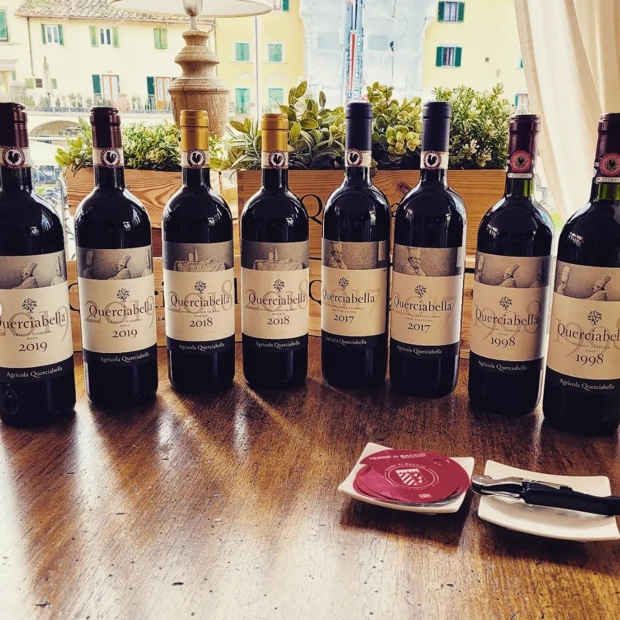
Querciabella Camartina 2017, IGT Toscana
The most consistent Querciabella IGT, at 70 per cent cabernet sauvignon with (30) sangiovese from the Ruffoli hillside, since 2003. Ages approximately 18 months and to be honest the cabernet suffered more in this hot dry vintage. Paying attention to avoiding over extraction, dropping temperature during fermentation and tannin management were key. A wine to handle with kid gloves and looking at it now there is no loss of liveliness, nor are the tannins hard to handle. Au contraire, there is grace and there are pleasantries in round abound with a red cherry to berry fruit compendium ready and willing to receive the structural parts. Surely a beneficial location for 2017 fruit, replete with that season’s acidity and so well managed fermentative activities bring about a really age-able Camartina. Drink 2024-2036. Tasted November 2021
Querciabella Palafreno 2017, IGT Toscana
As always (since 2004) a one hundred per cent merlot, from Ruffoli facing west, thankfully not due south and lucky because this vineyard has a higher density and compaction to retain water. Much freshness retained and perhaps a slight hyperbole in merlot’s verdancy but also if you close your eyes, “I see something blue,” notes Manfred Ing, and yes as if a petit verdot blue fruit notation, with the soil idea coming through as a compact set of tannins in dense grains. A big vintage, very different vintage than 2016. Drink 2024-2035. Tasted November 2021
Querciabella Turpino 2017, IGT Toscana
Has emerged from its hard shell, albeit incrementally with much further to go. A first stage of rounding out, fruit happier, and still this Mediterranean feel of all the Querciabella wines. A wilder component and a marine streak, a bit rugged and a sense of the Maremma very much indeed. No it’s still quite primary, the tannins at least, so wait another 18 months or so. Last tasted November 2021
First commercial vintage was 2010 when at the time it was 50-50 Maremma and Greve. Since 2015 it identifies as 100 per cent Tuscan coast with more barrel exercise and power than Mongrana, now a cuvée of approximately 12,000 bottles. “Turpino,” as in a character from Sebastiano Cossia Castiglioni’s favourite poem, like his son Orlando (and also for the names Mongrana and Palafreno). Frost was a major problem in 2017, followed by heat, no rain and vines that just went crazy. Small pickings were done in the first week of September and then the rain came. The vines dropped in alcohol potential by a degree but the vines were tired and so the fruit could not hang in there like it could (better so) in Ruffoli. A blend of 40 per cent each cabernet franc and syrah with (20) merlot. Spiciness but not in a traditionally Tuscan syrah (Cortona) way and so the franc is to thank for the pique, sharpness and pointed directive of this ripe wine agitative of pricks and sway. In the end this is truly Tuscan coast, carrying the dried and bushy herbs but with an extended olive branch, muscular arm and structured savour. Only 10,000 bottles were made of this succulent, strange bedfellows (for Tuscany) red wine. House wine, Querciabella style. Drink 2023-2028. Tasted May 2021
Rocca Di Montegrossi Geremia 2017, IGT Toscana
A blend of 82 per cent merlot and 18 cabernet sauvignon from the most arid and hot vintage though with grapes that can handle the extreme truth and consequence, at least relative to sangiovese. But it also makes for a much bigger expression, heady and weighty and yet the Montegrossi terroir can’t be removed from the DNA of this wine. Extremely youthful with rigorous and grippy structure, deep purple fruit hanging in the balance and a consistency of localized acidity always on side and in sight. Big wine made bigger by the vintage. Drink 2024-2029. Tasted November 2021
Isole E Olena Collezione De Marchi Cabernet Sauvignon 2016, IGT Toscana
Though 2017 was just released here we are tasting what is a quintessential cabernet vintage for Isole e Olena. Truth be told it is a very difficult wine to make according to Paolo de Marchi because maintaining both sugar and phenolic ripeness is a never-ending challenge. Blended in 2016 with cabernet franc (eight per cent), plus two each of petit verdot and merlot. Pure Cassis, black forest cake and waves of both black current and cherry. All the dark fruits, silken and reminiscent of Napa Valley mountain cabernet, perhaps even specifically Atlas Peak. Drink 2024-2029. Tasted October 2021
Rocca Di Montegrossi Ridolfo 2015, IGT Toscana
A 50-50 split between cabernet sauvignon and pugnitello, the first vintage of its kind, 25 months in barriques and three years in bottle. Also the first of its ilk and newly minted idiom, not so much because the two grapes are bedfellows of another mother but because they’ve never aligned in this manner. After fermentation Marco decided, perhaps as a joke, to mix the two grapes in his glass and the best percentage was half and half. Less than 2,000 bottles are produced of a wine with no real reference point. So what to make of it? The wood is very much in the mix, the aromas are in the vanilla, lavender and graphite vein. Stylish, obviously so well put together and yet one of those polished wines that will become much more interesting after five to seven more years time. Drink 2025-2030. Tasted November 2021
San Giusto A Rentennano La Ricolma 2018, IGT Merlot Di Toscana
The vineyards are in six different parcels, the first having been planted in 1991. Followed by 2006 and so forth. The original idea was to plant and mix small percentages into the Chianti Classico but they didn’t like the results. Now make five to six thousand bottles. First vintage was 1993 and up until 2004 the vineyards were managed like sangiovese, but this was not right and so changes were made. Used to be a more vegetal wine and by slowing down ripening through pruning the wines improved dramatically. Six buds were left and when the buds opened they cut again to delay the vine by 7-10 days. Also more turning of the soil and for green harvest this has to be when the grapes are completely red. Not the best climate here because the expediency of ripening is in such a short window. Fine and silky tannins meet dark fruit full of berries and especially raspberry. Great merlot and an ideal vintage for it to work out right. Labeled 15 per cent but could be more. Drink 2024-2030. Tasted November 2021
Le Fonti Di Panzano Fontissimo 2017, IGT Toscana
Also high wood influence but here a glycerin IGT with finer grain of tannin and sweeter glycerin slash pectin fruit substance. You need to work and hang out with this wine for some quality time to gain intel and a feeling of its potential grace and charm. Really quite fine and without some of the drying tendencies found in the more particular tannic vein of the Chianti Classicos. Drink 2023-2027. Tasted October 2021
Bindi Sergardi Chianti Classico 91 Cabernet Sauvignon 2016, IGT Toscana
Rich and welling with Cassis, fulsome, so beautifully ripe and of exquisitely fine, sweeter tannins. Drink 2023-2029. Tasted October 2021
Bindi Sergardi Chianti Classico 91 Cabernet Sauvignon 2015, IGT Toscana
Sharper, higher in acidity, once offering you a slap in the face but now settling ins though the tannins are grand and nearly grainy. The tannins are present for for 2015 and 2016 so discussing structural longevity is like discussing comparative mythologies. Drink 2022-2028. Tasted October 2021
San Giusto A Rentennano La Ricolma 2015, IGT Merlot Di Toscana
Probably as easy a vintage as it gets for merlot and Luca prefers this, as opposed to ’16 being the preferred one for sangiovese. Still a big wine and unavoidable as merlot in this San Giusto’s very specific micro-climate and location. These are really fine, sweet and elastic tannins stretching out for a lunga camminata in what really is quite a beautiful merlot. Drink 2022-2028. Tasted November 2021 and February 2022
Capaccia 2011, IGT Toscana
The 2011 Capaccia IGT cabernet sauvignon is in a terrific place, full of energy and fruit swells, almost no drying of that fruit or tannins, acids as always in charge. Lots of wood of course but it is that swell of fennel, rosemary, lavender and elderflower that dominates, permeates and seems to propagate through this warm and strong vintage wine. Really feels like an 11 year-old wine and one from the time. Also place so that is really what Capaccia is all about. Drink 2022-2025. Tasted March 2022
Good to go!
Godello

Gallo Nero at the Chianti Classico Collection 2022, Stazione Leopolda, Firenze
Twitter:
Instagram: mgodello
WineAlign



















